MENU
The Electronic Scholarly Publishing Project: Providing access to classic scientific papers and other scholarly materials, since 1993. More About: ESP | OUR CONTENT | THIS WEBSITE | WHAT'S NEW | WHAT'S HOT
Comparative Timelines
The ESP Timeline (one of the site's most popular features) has been completely updated to allow the user to select (using the timeline controls above each column) different topics for the left and right sides of the display.
Select:
New Left Column
New Left Column
Dates
Decade
New Right Column
New Right Column
(no entry for this year)
1470
(no entry for this year)
(no entry for this year)
1471
After having secured much of what today is central and northern Peru, the Inca have expanded their empire into Ecuador. With a new king, Tupac Inca, they begin to expand southward into Chile, Bolivia and Argentina.
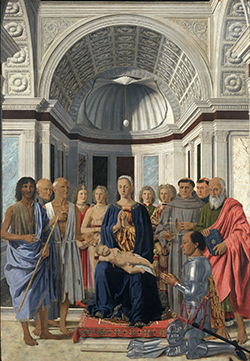 Painting by Piero della Francesca: The Brera Madonna, (also known as the Pala di Brera, the Montefeltro Altarpiece or Brera Altarpiece), executed in 1472–1474. It is housed in the Pinacoteca di Brera of Milan, where it was deposited by Napoleon. The work, of a type known as a sacra conversazione, was commissioned by Federico III da Montefeltro, Duke of Urbino, to celebrate the birth of Federico's son, Guidobaldo. According to other sources, it would celebrate his conquest of several castles in the Maremma.
Painting by Piero della Francesca: The Brera Madonna, (also known as the Pala di Brera, the Montefeltro Altarpiece or Brera Altarpiece), executed in 1472–1474. It is housed in the Pinacoteca di Brera of Milan, where it was deposited by Napoleon. The work, of a type known as a sacra conversazione, was commissioned by Federico III da Montefeltro, Duke of Urbino, to celebrate the birth of Federico's son, Guidobaldo. According to other sources, it would celebrate his conquest of several castles in the Maremma.
1472
(no entry for this year)
(no entry for this year)
1473
(no entry for this year)
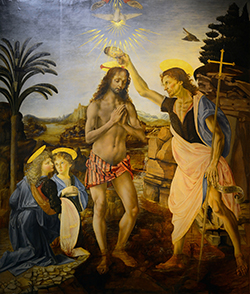 Painting by Andrea del Verrocchio and Leonardo da Vinci: The Baptism of Christ, an oil-on-panel painting finished around 1475 in the studio of the Italian Renaissance painter Andrea del Verrocchio and generally ascribed to him and his pupil Leonardo da Vinci. Some art historians discern the hands of other members of Verrocchio's workshop in the painting as well. The picture depicts the Baptism of Jesus by John the Baptist as recorded in the Biblical Gospels of Matthew, Mark and Luke. The angel to the left is recorded as having been painted by the youthful Leonardo, a fact which has excited so much special comment and mythology, that the importance and value of the picture as a whole and within the oeuvre of Verrocchio is often overlooked. Modern critics also attribute much of the landscape in the background to Leonardo as well. The painting is housed in the Uffizi Gallery in Florence.
Painting by Andrea del Verrocchio and Leonardo da Vinci: The Baptism of Christ, an oil-on-panel painting finished around 1475 in the studio of the Italian Renaissance painter Andrea del Verrocchio and generally ascribed to him and his pupil Leonardo da Vinci. Some art historians discern the hands of other members of Verrocchio's workshop in the painting as well. The picture depicts the Baptism of Jesus by John the Baptist as recorded in the Biblical Gospels of Matthew, Mark and Luke. The angel to the left is recorded as having been painted by the youthful Leonardo, a fact which has excited so much special comment and mythology, that the importance and value of the picture as a whole and within the oeuvre of Verrocchio is often overlooked. Modern critics also attribute much of the landscape in the background to Leonardo as well. The painting is housed in the Uffizi Gallery in Florence.
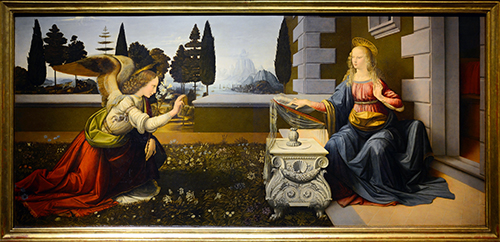 Painting by Leonardo da Vinci: The Annunciation, painted c. 1472–1476. This is Leonardo's earliest extant major work, completed in Florence while he was an apprentice in the studio of Andrea del Verrocchio. The painting was made using oil and tempera on a large poplar panel and depicts the Annunciation, a popular biblical subject in 15th-century Florence. Since 1867 it has been housed in the Uffizi in Florence, the city where it was created. Though the work has been criticized for inaccuracies in its composition, it is among the best-known portrayals of the Annunciation in Christian art.
Painting by Leonardo da Vinci: The Annunciation, painted c. 1472–1476. This is Leonardo's earliest extant major work, completed in Florence while he was an apprentice in the studio of Andrea del Verrocchio. The painting was made using oil and tempera on a large poplar panel and depicts the Annunciation, a popular biblical subject in 15th-century Florence. Since 1867 it has been housed in the Uffizi in Florence, the city where it was created. Though the work has been criticized for inaccuracies in its composition, it is among the best-known portrayals of the Annunciation in Christian art.
1474
(no entry for this year)
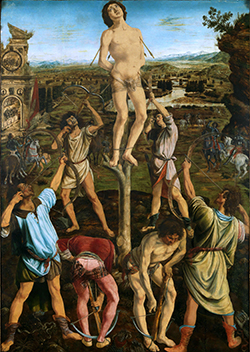 Painting by Antonio and Piero del Pollaiuolo: Martyrdom of Saint Sebastian, a large altarpiece by the brothers Antonio and Piero del Pollaiuolo, commissioned by the Florentine Pucci family and now in the National Gallery, London. The painting is considered Antonio's masterpiece, with a more rigid geometric control on the composition than in his previous works, without giving up his usual naturalness of poses and movement — the four archers in the foreground form two symmetrical poses, with the two central ones reloading and the two on the edges firing, in perfect equilibrium either side of the central post to which Sebastian is tied.
Painting by Antonio and Piero del Pollaiuolo: Martyrdom of Saint Sebastian, a large altarpiece by the brothers Antonio and Piero del Pollaiuolo, commissioned by the Florentine Pucci family and now in the National Gallery, London. The painting is considered Antonio's masterpiece, with a more rigid geometric control on the composition than in his previous works, without giving up his usual naturalness of poses and movement — the four archers in the foreground form two symmetrical poses, with the two central ones reloading and the two on the edges firing, in perfect equilibrium either side of the central post to which Sebastian is tied.
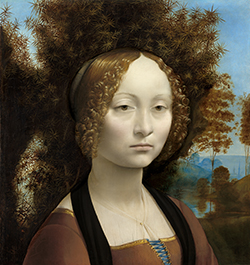 Painting by Leonardo da Vinci: Ginevra de' Benci, a portrait painting of the 15th-century Florentine aristocrat Ginevra de' Benci (born c. 1458). It was acquired by the National Gallery of Art in Washington, D.C. US from Franz Joseph II, Prince of Liechtenstein in February 1967 for a record price for a painting of between $5 and $6 million. It is the only painting by Leonardo on public view in the Americas. Ginevra de' Benci, a well-known young Florentine woman, is universally considered to be the portrait's sitter. Leonardo painted the portrait in Florence between 1474 and 1478, possibly to commemorate Ginevra's marriage to Luigi di Bernardo Niccolini at the age of 16. More likely, it commemorates the engagement. The juniper bush that surrounds Ginevra's head and fills much of the background, serves more than mere decorative purposes. In Renaissance Italy, the juniper was regarded a symbol of female virtue, while the Italian word for juniper, ginepro, also makes a play on Ginevra's name.
Painting by Leonardo da Vinci: Ginevra de' Benci, a portrait painting of the 15th-century Florentine aristocrat Ginevra de' Benci (born c. 1458). It was acquired by the National Gallery of Art in Washington, D.C. US from Franz Joseph II, Prince of Liechtenstein in February 1967 for a record price for a painting of between $5 and $6 million. It is the only painting by Leonardo on public view in the Americas. Ginevra de' Benci, a well-known young Florentine woman, is universally considered to be the portrait's sitter. Leonardo painted the portrait in Florence between 1474 and 1478, possibly to commemorate Ginevra's marriage to Luigi di Bernardo Niccolini at the age of 16. More likely, it commemorates the engagement. The juniper bush that surrounds Ginevra's head and fills much of the background, serves more than mere decorative purposes. In Renaissance Italy, the juniper was regarded a symbol of female virtue, while the Italian word for juniper, ginepro, also makes a play on Ginevra's name.
1475
(no entry for this year)
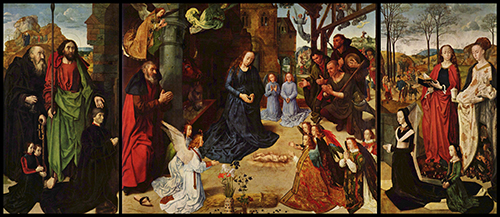 Painting by Hugo van der Goes: Portinari Altarpiece, an oil-on-wood triptych painting, commissioned by Tommaso Portinari, representing the Adoration of the Shepherds. It measures 253 × 304 cm, and is now in the Galleria degli Uffizi in Florence, Italy. This altarpiece is filled with figures and religious symbols. Of all the late-fifteenth-century Flemish artworks, this painting is said to be the most studied. The work was commissioned for the church inside of one of the largest hospitals in Florence, hospital of Santa Maria Nuova by the Italian banker Tommaso Portinari, a descendant of the hospital's founder. Portinari lived for more than forty years in Bruges as a representative for the Medici family's bank. Portinari himself is depicted on the left panel with his two sons Antonio and Pigello; his wife Maria di Francesco Baroncelli is shown on the right panel with their daughter Margarita. All, except Pigello, are accompanied by their patron saints: Saint Thomas (with the spear), Saint Anthony (with the bell), Mary Magdalen (with the pot of ointment) and Saint Margaret (with the book and the dragon). When the work arrived in Florence in 1483, it was installed in the Portinari family chapel where it was deeply admired by the Italian artists who saw it, many of whom sought to emulate it. The Altarpiece is considered to have some of the most complicated and hidden symbolism in any Nativity scene from the fifteenth century. The scenes of the Nativity and the Adoration of the Shepherds are seen in the central panels of the triptych, whereas in the background to the right side, is the scene of the Annunciation of the Shepherds.
Painting by Hugo van der Goes: Portinari Altarpiece, an oil-on-wood triptych painting, commissioned by Tommaso Portinari, representing the Adoration of the Shepherds. It measures 253 × 304 cm, and is now in the Galleria degli Uffizi in Florence, Italy. This altarpiece is filled with figures and religious symbols. Of all the late-fifteenth-century Flemish artworks, this painting is said to be the most studied. The work was commissioned for the church inside of one of the largest hospitals in Florence, hospital of Santa Maria Nuova by the Italian banker Tommaso Portinari, a descendant of the hospital's founder. Portinari lived for more than forty years in Bruges as a representative for the Medici family's bank. Portinari himself is depicted on the left panel with his two sons Antonio and Pigello; his wife Maria di Francesco Baroncelli is shown on the right panel with their daughter Margarita. All, except Pigello, are accompanied by their patron saints: Saint Thomas (with the spear), Saint Anthony (with the bell), Mary Magdalen (with the pot of ointment) and Saint Margaret (with the book and the dragon). When the work arrived in Florence in 1483, it was installed in the Portinari family chapel where it was deeply admired by the Italian artists who saw it, many of whom sought to emulate it. The Altarpiece is considered to have some of the most complicated and hidden symbolism in any Nativity scene from the fifteenth century. The scenes of the Nativity and the Adoration of the Shepherds are seen in the central panels of the triptych, whereas in the background to the right side, is the scene of the Annunciation of the Shepherds.
1476
(no entry for this year)
(no entry for this year)
1477
(no entry for this year)
(no entry for this year)
1478
A conspiracy, that includes the Archbishop of Pisa and has the support of Pope Sixtus IV, leads to an attack on the Medici while they are in church. The Archbishop and several others are hanged. Pope Sixtus puts Florence under the interdict and excommunicates the Medici leader of Florence, Lorenzo de Medici. The pope forms a military alliance with the King of Naples, and Lorenzo's diplomacy prevents an attack.
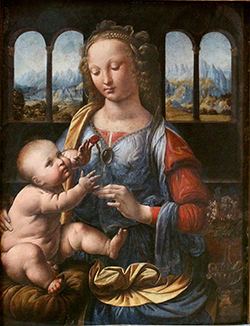 Painting by Leonardo da Vinci: The Madonna of the Carnation, also known as the Madonna with Vase, Madonna with Child or Virgin with Flower, is an oil painting created around 1478–1480. It is permanently displayed at the Alte Pinakothek gallery in Munich, Germany. The central and centered motif is the young Virgin Mary seated with Baby Jesus on her lap. Depicted in sumptuous clothes and jewellery, with her left hand Mary holds a carnation (red, suggesting blood and the Passion). The faces are put into light while all other objects are darker, e.g. the flower is covered by a shadow. The child is looking up and the mother looking down, with no eye contact. The setting of the portrait is a room with two windows on each side of the figures. Originally this painting was thought to have been created by Andrea del Verrocchio, but subsequent art historians agree that it is Leonardo's work, probably made during his apprenticeship to Verrocchio. The Virgin's hair, left hand, the drapery, and flowers are similar to elements of Leonardo's Annunciation.
Painting by Leonardo da Vinci: The Madonna of the Carnation, also known as the Madonna with Vase, Madonna with Child or Virgin with Flower, is an oil painting created around 1478–1480. It is permanently displayed at the Alte Pinakothek gallery in Munich, Germany. The central and centered motif is the young Virgin Mary seated with Baby Jesus on her lap. Depicted in sumptuous clothes and jewellery, with her left hand Mary holds a carnation (red, suggesting blood and the Passion). The faces are put into light while all other objects are darker, e.g. the flower is covered by a shadow. The child is looking up and the mother looking down, with no eye contact. The setting of the portrait is a room with two windows on each side of the figures. Originally this painting was thought to have been created by Andrea del Verrocchio, but subsequent art historians agree that it is Leonardo's work, probably made during his apprenticeship to Verrocchio. The Virgin's hair, left hand, the drapery, and flowers are similar to elements of Leonardo's Annunciation.
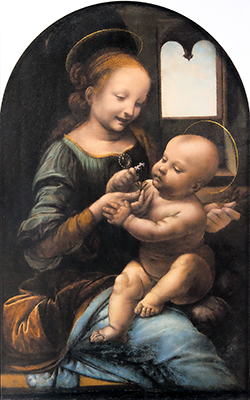 Painting by Leonardo da Vinci: The Benois Madonna, otherwise known as the Madonna and Child with Flowers, is a painting now in the Hermitage Museum, Saint Petersburg. One of two Madonnas begun by Leonardo in October 1478, it was completed c. 1478–1480; the other was the Madonna of the Carnation, now in the Alte Pinakothek, Munich. It is likely that the Benois Madonna was the first work painted by Leonardo independently from his master Andrea del Verrocchio. Two of Leonardo's preliminary sketches for this work are in the British Museum, although the painting was probably overpainted by other hands. The preliminary sketches and the painting itself suggest that Leonardo was concentrating on the idea of sight and perspective. The child is thought to be guiding his mother's hands into his central vision.
Painting by Leonardo da Vinci: The Benois Madonna, otherwise known as the Madonna and Child with Flowers, is a painting now in the Hermitage Museum, Saint Petersburg. One of two Madonnas begun by Leonardo in October 1478, it was completed c. 1478–1480; the other was the Madonna of the Carnation, now in the Alte Pinakothek, Munich. It is likely that the Benois Madonna was the first work painted by Leonardo independently from his master Andrea del Verrocchio. Two of Leonardo's preliminary sketches for this work are in the British Museum, although the painting was probably overpainted by other hands. The preliminary sketches and the painting itself suggest that Leonardo was concentrating on the idea of sight and perspective. The child is thought to be guiding his mother's hands into his central vision.
1479
(no entry for this year)
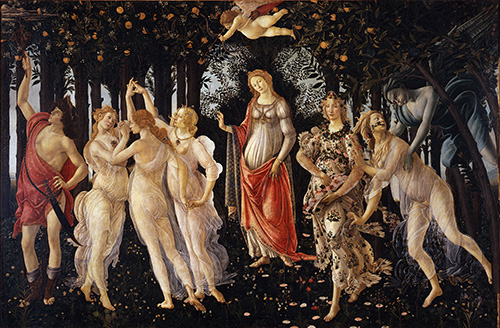 Painting by Sandro Botticelli: Primavera, a large panel painting made in the late 1470s or early 1480s (datings vary). It has been described as "one of the most written about, and most controversial paintings in the world", and also "one of the most popular paintings in Western art". The painting depicts a group of figures from classical mythology in a garden, but no story has been found that brings this particular group together. Most critics agree that the painting is an allegory based on the lush growth of Spring, but accounts of any precise meaning vary, though many involve the Renaissance Neoplatonism which then fascinated intellectual circles in Florence. The subject was first described as Primavera by the art historian Giorgio Vasari who saw it at Villa Castello, just outside Florence, by 1550. Although the two are now known not to be a pair, the painting is inevitably discussed with Botticelli's other very large mythological painting, The Birth of Venus, also in the Uffizi. They are among the most famous paintings in the world, and icons of the Italian Renaissance; of the two, the Birth is even better known than the Primavera. As depictions of subjects from classical mythology on a very large scale, they were virtually unprecedented in Western art since classical antiquity.
Painting by Sandro Botticelli: Primavera, a large panel painting made in the late 1470s or early 1480s (datings vary). It has been described as "one of the most written about, and most controversial paintings in the world", and also "one of the most popular paintings in Western art". The painting depicts a group of figures from classical mythology in a garden, but no story has been found that brings this particular group together. Most critics agree that the painting is an allegory based on the lush growth of Spring, but accounts of any precise meaning vary, though many involve the Renaissance Neoplatonism which then fascinated intellectual circles in Florence. The subject was first described as Primavera by the art historian Giorgio Vasari who saw it at Villa Castello, just outside Florence, by 1550. Although the two are now known not to be a pair, the painting is inevitably discussed with Botticelli's other very large mythological painting, The Birth of Venus, also in the Uffizi. They are among the most famous paintings in the world, and icons of the Italian Renaissance; of the two, the Birth is even better known than the Primavera. As depictions of subjects from classical mythology on a very large scale, they were virtually unprecedented in Western art since classical antiquity.
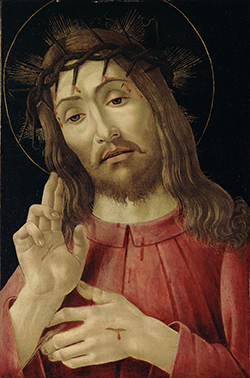 Painting by Sandro Botticelli: The Resurrected Christ. This painting is considered a defining masterpiece of Botticelli's later works. While the artist is known for his beautiful Madonnas and large allegorical paintings such as 'The Birth of Venus,' after political upheavals in the 1490s, his work became more somber. Here, Christ's head is surrounded by a halo of angels 'en grisaille' — in grey monotone. They hold 'Arma Christi,' the symbols of Christ's death and suffering while Christ himself is both sorrowful and serene.
Painting by Sandro Botticelli: The Resurrected Christ. This painting is considered a defining masterpiece of Botticelli's later works. While the artist is known for his beautiful Madonnas and large allegorical paintings such as 'The Birth of Venus,' after political upheavals in the 1490s, his work became more somber. Here, Christ's head is surrounded by a halo of angels 'en grisaille' — in grey monotone. They hold 'Arma Christi,' the symbols of Christ's death and suffering while Christ himself is both sorrowful and serene.
1480
Ferdinand and Isabella of Spain employ the Spanish Inquisition to investigate whether converted Jews are secretly clinging to Judaism.
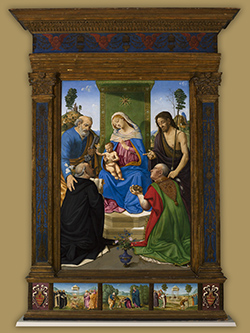 Painting by Piero di Cosimo: Madonna and Child Enthroned with Sts. Peter, John the Baptist, Dominic, and Nicholas of Bari. In a lifelike rendering, this large panel portrays a sacra conversazione (holy conversation) where saints surround the Madonna and Child in a unified pictorial space. Piero di Cosimo's approach is far removed from the compartmentalized divisions in Lorenzo di Nicolo's altarpiece elsewhere in this gallery. Here, Saint Peter presents the kneeling Saint Dominic (left) while Saint John the Baptist announces Christ's ministry, and Saint Nicholas kneels in devotion (right). The three smaller panels, called a predella, depict scenes from the lives of Saints Dominic, John, and Nicholas. The Pugliese coat of arms adorns the frame, identifying the Florentine family who commissioned the work for its private chapel.
Painting by Piero di Cosimo: Madonna and Child Enthroned with Sts. Peter, John the Baptist, Dominic, and Nicholas of Bari. In a lifelike rendering, this large panel portrays a sacra conversazione (holy conversation) where saints surround the Madonna and Child in a unified pictorial space. Piero di Cosimo's approach is far removed from the compartmentalized divisions in Lorenzo di Nicolo's altarpiece elsewhere in this gallery. Here, Saint Peter presents the kneeling Saint Dominic (left) while Saint John the Baptist announces Christ's ministry, and Saint Nicholas kneels in devotion (right). The three smaller panels, called a predella, depict scenes from the lives of Saints Dominic, John, and Nicholas. The Pugliese coat of arms adorns the frame, identifying the Florentine family who commissioned the work for its private chapel.
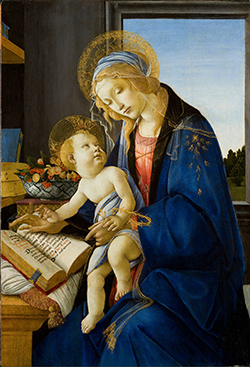 Painting by Sandro Botticelli: Madonna of the Book, a small painting preserved in the Poldi Pezzoli Museum in Milan. The painting is executed in tempera on panel. It dates from between 1480 and 1481. The Madonna of the Book is a soft and elegant work, in which Mary and the Child Jesus are seated by a window in the corner of a room. She holds a Book of Hours, the Horae Beatae Mariae Virginis, prayer books for laymen common in the thirteenth to sixteenth centuries. The infant is gazing at his mother whilst she is absorbed in reading the book. The hands of both mother and son are positioned similarly, with the right hands open as in a gesture of blessing, and left hands closed. Symbolizing the Passion of Jesus, the Christ Child is holding the three nails of the cross, and the crown of thorns. These are probably later additions, added to make the message more explicit.
Painting by Sandro Botticelli: Madonna of the Book, a small painting preserved in the Poldi Pezzoli Museum in Milan. The painting is executed in tempera on panel. It dates from between 1480 and 1481. The Madonna of the Book is a soft and elegant work, in which Mary and the Child Jesus are seated by a window in the corner of a room. She holds a Book of Hours, the Horae Beatae Mariae Virginis, prayer books for laymen common in the thirteenth to sixteenth centuries. The infant is gazing at his mother whilst she is absorbed in reading the book. The hands of both mother and son are positioned similarly, with the right hands open as in a gesture of blessing, and left hands closed. Symbolizing the Passion of Jesus, the Christ Child is holding the three nails of the cross, and the crown of thorns. These are probably later additions, added to make the message more explicit.
1481
(no entry for this year)
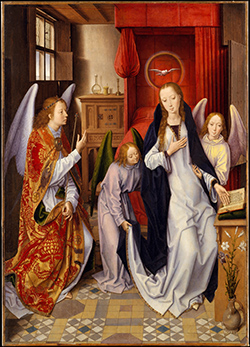 Painting by Hans Memling: The Annunciation, an oil painting depicting the archangel Gabriel's announcement to the Virgin Mary that she would conceive and become the mother of Jesus, described in the Gospel of Luke. The painting was executed in the 1480s and was transferred to canvas from its original oak panel sometime after 1928; it is today held in the Robert Lehman collection of the Metropolitan Museum of Art in New York. The panel shows Mary in a domestic interior with two attendant angels. Gabriel is dressed in ecclesiastical robes, while a dove hovers above Mary, representing the Holy Spirit.
Painting by Hans Memling: The Annunciation, an oil painting depicting the archangel Gabriel's announcement to the Virgin Mary that she would conceive and become the mother of Jesus, described in the Gospel of Luke. The painting was executed in the 1480s and was transferred to canvas from its original oak panel sometime after 1928; it is today held in the Robert Lehman collection of the Metropolitan Museum of Art in New York. The panel shows Mary in a domestic interior with two attendant angels. Gabriel is dressed in ecclesiastical robes, while a dove hovers above Mary, representing the Holy Spirit.
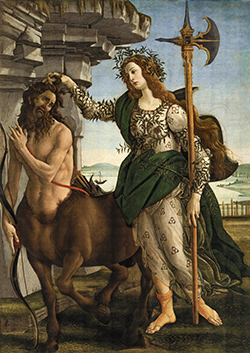 Painting by Sandro Botticelli: Pallas and the Centaur, now in the Uffizi Gallery in Florence. It has been proposed as a companion piece to his Primavera, though it is a different shape. The medium used is tempera paints on canvas and its size is 207 x 148 cm. The painting has been retouched in many places, and these retouchings have faded. The life-size figures are from classical mythology and probably form an allegory. There is a centaur on the left, and a female figure holding a very elaborate halberd on the right. She is clutching the hair of the centaur, who was evidently about to shoot from his bow. The female figure was called Camilla in the earliest record of the painting, an inventory of 1499, but in an inventory of 1516 she is called Minerva, the Roman equivalent of Pallas Athene; Pallas remains her usual modern identification, but Camilla has supporters. Arthur Frothingham suggested that she is Florencia, the personification of the city of Florence. The fine cloth of her dress is decorated with the Medici's three-ring insignia.
Painting by Sandro Botticelli: Pallas and the Centaur, now in the Uffizi Gallery in Florence. It has been proposed as a companion piece to his Primavera, though it is a different shape. The medium used is tempera paints on canvas and its size is 207 x 148 cm. The painting has been retouched in many places, and these retouchings have faded. The life-size figures are from classical mythology and probably form an allegory. There is a centaur on the left, and a female figure holding a very elaborate halberd on the right. She is clutching the hair of the centaur, who was evidently about to shoot from his bow. The female figure was called Camilla in the earliest record of the painting, an inventory of 1499, but in an inventory of 1516 she is called Minerva, the Roman equivalent of Pallas Athene; Pallas remains her usual modern identification, but Camilla has supporters. Arthur Frothingham suggested that she is Florencia, the personification of the city of Florence. The fine cloth of her dress is decorated with the Medici's three-ring insignia.
1482
Portuguese have founded new trading settlements on Africa's "Gold Coast." They are trading ironware, firearms, textiles and food for gold, ivory, food and slaves.
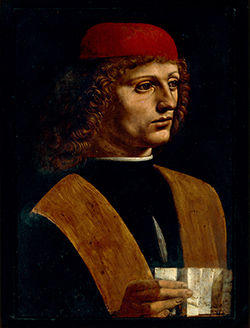 Painting by Leonardo da Vinci: Portrait of a Musician, an unfinished painting dated to c. 1483–1487. Produced while Leonardo was in Milan, the work is painted in oils, and perhaps tempera, on a small panel of walnut wood. It is his only known male portrait painting, and the identity of its sitter has been closely debated among scholars. Perhaps influenced by Antonello da Messina's introduction of the Early Netherlandish style of portrait painting to Italy, the work marks a dramatic shift from the profile portraiture that predominated in 15th-century Milan. It shares many similarities with other paintings Leonardo executed there, such as the Louvre Virgin of the Rocks and the Lady with an Ermine, but the Portrait of a Musician is his only panel painting remaining in the city, where it has been in the Pinacoteca Ambrosiana since at least 1672. One of Leonardo's best preserved paintings, there are no extant contemporary records of the commission. Based on stylistic resemblances to other works by Leonardo, virtually all current scholarship attributes at least the sitter's face to him.
Painting by Leonardo da Vinci: Portrait of a Musician, an unfinished painting dated to c. 1483–1487. Produced while Leonardo was in Milan, the work is painted in oils, and perhaps tempera, on a small panel of walnut wood. It is his only known male portrait painting, and the identity of its sitter has been closely debated among scholars. Perhaps influenced by Antonello da Messina's introduction of the Early Netherlandish style of portrait painting to Italy, the work marks a dramatic shift from the profile portraiture that predominated in 15th-century Milan. It shares many similarities with other paintings Leonardo executed there, such as the Louvre Virgin of the Rocks and the Lady with an Ermine, but the Portrait of a Musician is his only panel painting remaining in the city, where it has been in the Pinacoteca Ambrosiana since at least 1672. One of Leonardo's best preserved paintings, there are no extant contemporary records of the commission. Based on stylistic resemblances to other works by Leonardo, virtually all current scholarship attributes at least the sitter's face to him.
1483
Edward IV of England has died. His son succeeds him as Edward V, and he is murdered. The Duke of Gloucester, the youngest brother of Edward IV, usurps the throne and is crowned Richard III.
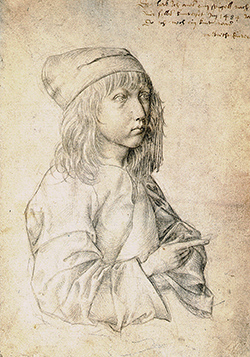 Drawing by Albrecht Dürer: Self-Portrait at the age of 13 (the title is modern) is a silverpoint drawing by Albrecht Dürer, dated 1484, when the artist was either twelve or thirteen years of age. It is now in the Albertina museum, Vienna, where it arrived, via the collections of the Imhoff family in Nuremberg and the Habsburg collections, from Dürer's own literary and remains. It is the artist's oldest known surviving drawing, one of the oldest extant self-portraits in European art, and one of the earliest child's drawings, as well. It was completed two years before Albrecht left his father's apprenticeship to study under Michael Wolgemut, whom (some modern authors speculate) he quickly realized was a valuable mentor but whom the younger man may have recognized was unequal to himself in his abilities. Throughout his life Dürer expressed resolute self-confidence. He celebrated himself in his drawings and writings.
Drawing by Albrecht Dürer: Self-Portrait at the age of 13 (the title is modern) is a silverpoint drawing by Albrecht Dürer, dated 1484, when the artist was either twelve or thirteen years of age. It is now in the Albertina museum, Vienna, where it arrived, via the collections of the Imhoff family in Nuremberg and the Habsburg collections, from Dürer's own literary and remains. It is the artist's oldest known surviving drawing, one of the oldest extant self-portraits in European art, and one of the earliest child's drawings, as well. It was completed two years before Albrecht left his father's apprenticeship to study under Michael Wolgemut, whom (some modern authors speculate) he quickly realized was a valuable mentor but whom the younger man may have recognized was unequal to himself in his abilities. Throughout his life Dürer expressed resolute self-confidence. He celebrated himself in his drawings and writings.
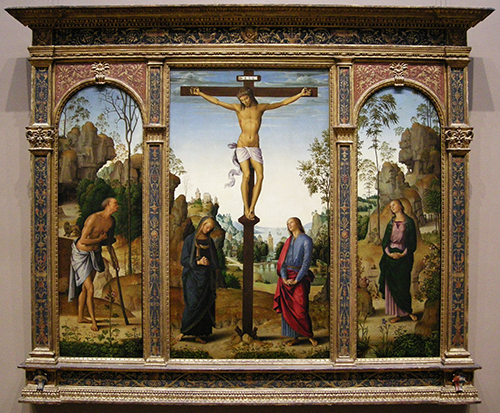 Painting by Pietro Perugino: Galitzin Triptych, also known as The Crucifixion with the Virgin, Saint John, Saint Jerome, and Saint Mary Magdalene, probably commissioned by Bartolommeo Bartoli, bishop of Cagli. It originated in a chapel of the Dominican monastic church of San Gimignano and when that was suppressed in 1796-97 it was confiscated by French troops. It was then sold to a certain 'Buzzi', who sold it as a work of Raphael to prince Alexander Mikhailovich Galitzin, the Imperial Russian ambassador to Rome. His nephew Mikhailovich Galitzin moved it to Moscow where, in 1865, it was exhibited at the Galitzin Museum of Western Art. It was sold again in 1886 with the rest of the Galitzin collection, this time to the Hermitage Museum. In April 1931 it was one of the artworks ceded by Stalin to Andrew Mellon, US Secretary of State. In 1937 the Mellon collection formed the core of the new National Gallery of Art.
Painting by Pietro Perugino: Galitzin Triptych, also known as The Crucifixion with the Virgin, Saint John, Saint Jerome, and Saint Mary Magdalene, probably commissioned by Bartolommeo Bartoli, bishop of Cagli. It originated in a chapel of the Dominican monastic church of San Gimignano and when that was suppressed in 1796-97 it was confiscated by French troops. It was then sold to a certain 'Buzzi', who sold it as a work of Raphael to prince Alexander Mikhailovich Galitzin, the Imperial Russian ambassador to Rome. His nephew Mikhailovich Galitzin moved it to Moscow where, in 1865, it was exhibited at the Galitzin Museum of Western Art. It was sold again in 1886 with the rest of the Galitzin collection, this time to the Hermitage Museum. In April 1931 it was one of the artworks ceded by Stalin to Andrew Mellon, US Secretary of State. In 1937 the Mellon collection formed the core of the new National Gallery of Art.
1484
(no entry for this year)
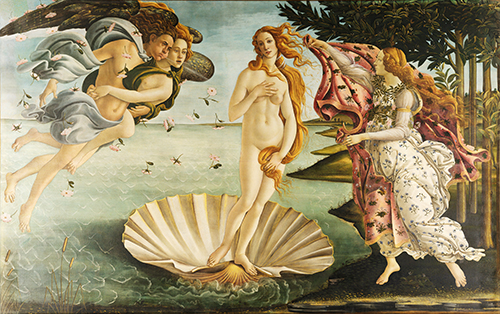 Painting by Sandro Botticelli: Birth of Venus, probably executed in the mid 1480s. It depicts the goddess Venus arriving at the shore after her birth, when she had emerged from the sea fully-grown (called Venus Anadyomene and often depicted in art). The painting is in the Uffizi Gallery in Florence, Italy. Although the two are not a pair, the painting is inevitably discussed with Botticelli's other very large mythological painting, the Primavera, also in the Uffizi. They are among the most famous paintings in the world, and icons of Italian Renaissance painting; of the two, the Birth is better known than the Primavera. As depictions of subjects from classical mythology on a very large scale they were virtually unprecedented in Western art since classical antiquity, as was the size and prominence of a nude female figure in the Birth. It used to be thought that they were both commissioned by the same member of the Medici family, but this is now uncertain. The Birth seems always to be surrounded by a large crowd, many involved in I was there photography or the production of glamorous selfies, even if the self is taken by someone else.
Painting by Sandro Botticelli: Birth of Venus, probably executed in the mid 1480s. It depicts the goddess Venus arriving at the shore after her birth, when she had emerged from the sea fully-grown (called Venus Anadyomene and often depicted in art). The painting is in the Uffizi Gallery in Florence, Italy. Although the two are not a pair, the painting is inevitably discussed with Botticelli's other very large mythological painting, the Primavera, also in the Uffizi. They are among the most famous paintings in the world, and icons of Italian Renaissance painting; of the two, the Birth is better known than the Primavera. As depictions of subjects from classical mythology on a very large scale they were virtually unprecedented in Western art since classical antiquity, as was the size and prominence of a nude female figure in the Birth. It used to be thought that they were both commissioned by the same member of the Medici family, but this is now uncertain. The Birth seems always to be surrounded by a large crowd, many involved in I was there photography or the production of glamorous selfies, even if the self is taken by someone else.
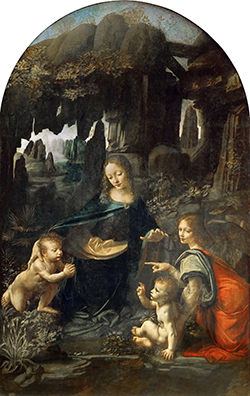 Painting by Leonardo da Vinci: The (Louvre) Virgin of the Rocks, sometimes the Madonna of the Rocks, is the name of two paintings by the Italian Renaissance artist Leonardo da Vinci, of the same subject, with a composition which is identical except for several significant details. The version generally considered the prime version, the earlier of the two, is unrestored and hangs in the Louvre in Paris. The other, which was restored between 2008 and 2010, hangs in the National Gallery, London. The works are often known as the Louvre Virgin of the Rocks and London Virgin of the Rocks respectively. The paintings are both nearly 2 meters (over 6 feet) high and are painted in oils. Both were originally painted on wooden panels, but the Louvre version has been transferred to canvas. Both paintings show the Virgin Mary and child Jesus with the infant John the Baptist and an angel Uriel, in a rocky setting which gives the paintings their usual name. The significant compositional differences are in the gaze and right hand of the angel. There are many minor ways in which the works differ, including the colors, the lighting, the flora, and the way in which sfumato has been used. Although the date of an associated commission is documented, the complete histories of the two paintings are unknown, leading to speculation about which of the two is earlier. The Virgin of the Rocks in the Louvre is considered by most art historians to be the earlier of the two and dates from around 1483–1486. Most authorities agree that the work is entirely by Leonardo. It is about 8 cm (3 in) taller than the London version. The first certain record of this picture dates from 1625, when it was in the French royal collection. It is generally accepted that this painting was produced to fulfill a commission of 1483 in Milan. This painting is regarded as a perfect example of Leonardo's "sfumato" technique.
Painting by Leonardo da Vinci: The (Louvre) Virgin of the Rocks, sometimes the Madonna of the Rocks, is the name of two paintings by the Italian Renaissance artist Leonardo da Vinci, of the same subject, with a composition which is identical except for several significant details. The version generally considered the prime version, the earlier of the two, is unrestored and hangs in the Louvre in Paris. The other, which was restored between 2008 and 2010, hangs in the National Gallery, London. The works are often known as the Louvre Virgin of the Rocks and London Virgin of the Rocks respectively. The paintings are both nearly 2 meters (over 6 feet) high and are painted in oils. Both were originally painted on wooden panels, but the Louvre version has been transferred to canvas. Both paintings show the Virgin Mary and child Jesus with the infant John the Baptist and an angel Uriel, in a rocky setting which gives the paintings their usual name. The significant compositional differences are in the gaze and right hand of the angel. There are many minor ways in which the works differ, including the colors, the lighting, the flora, and the way in which sfumato has been used. Although the date of an associated commission is documented, the complete histories of the two paintings are unknown, leading to speculation about which of the two is earlier. The Virgin of the Rocks in the Louvre is considered by most art historians to be the earlier of the two and dates from around 1483–1486. Most authorities agree that the work is entirely by Leonardo. It is about 8 cm (3 in) taller than the London version. The first certain record of this picture dates from 1625, when it was in the French royal collection. It is generally accepted that this painting was produced to fulfill a commission of 1483 in Milan. This painting is regarded as a perfect example of Leonardo's "sfumato" technique.
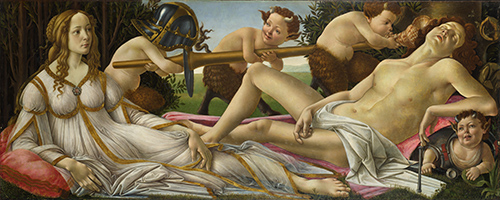 Painting by Sandro Botticelli: Venus and Mars a panel painting showing the Roman gods Venus, goddess of love, and Mars, god of war, in an allegory of beauty and valor. The youthful and voluptuous couple recline in a forest setting, surrounded by playful baby satyrs. The painting was probably intended to commemorate a wedding, set into panelling or a piece of furniture to adorn the bedroom of the bride and groom, possibly as part of a set of works. This is suggested by the wide format and the close view of the figures. It is widely seen as representation of an ideal view of sensuous love. It seems likely that Botticelli worked out the concept for the painting, with its learned allusions, with an advisor such as Poliziano, the Medici house poet and Renaissance Humanist scholar.
Painting by Sandro Botticelli: Venus and Mars a panel painting showing the Roman gods Venus, goddess of love, and Mars, god of war, in an allegory of beauty and valor. The youthful and voluptuous couple recline in a forest setting, surrounded by playful baby satyrs. The painting was probably intended to commemorate a wedding, set into panelling or a piece of furniture to adorn the bedroom of the bride and groom, possibly as part of a set of works. This is suggested by the wide format and the close view of the figures. It is widely seen as representation of an ideal view of sensuous love. It seems likely that Botticelli worked out the concept for the painting, with its learned allusions, with an advisor such as Poliziano, the Medici house poet and Renaissance Humanist scholar.
1485
Henry Tudor, a relative of the Lancaster family, defeats Richard III at the Battle of Bosworth. The Tudor family takes power and is crowned Henry VII.
Henry VII marries Elizabeth of York, uniting the Lancaster and York families. The War of Roses is over.
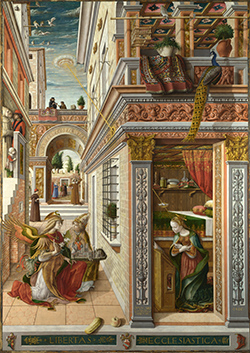 Painting by Carlo Crivelli: The Annunciation, with Saint Emidius, an altarpiece showing an artistic adaptation of the Annunciation It was painted for the Church of Santissima Annunziata in the Italian town of Ascoli Piceno, in the region of Marche, to celebrate the self-government granted to the town in 1482 by Pope Sixtus IV. The painting displays severely correct perspective. Persian rugs hang over balconies. When Mary protests (How shall this be, seeing I know not a man? Luke 1:34 KJV), the angel responds (The Holy Ghost shall come upon thee, and the power of the Highest shall overshadow thee: therefore also that holy thing which shall be born of thee shall be called the Son of God. Luke 1:35 KJV) and the Holy Ghost touches Mary with a close-encounters-style beam of light.
Painting by Carlo Crivelli: The Annunciation, with Saint Emidius, an altarpiece showing an artistic adaptation of the Annunciation It was painted for the Church of Santissima Annunziata in the Italian town of Ascoli Piceno, in the region of Marche, to celebrate the self-government granted to the town in 1482 by Pope Sixtus IV. The painting displays severely correct perspective. Persian rugs hang over balconies. When Mary protests (How shall this be, seeing I know not a man? Luke 1:34 KJV), the angel responds (The Holy Ghost shall come upon thee, and the power of the Highest shall overshadow thee: therefore also that holy thing which shall be born of thee shall be called the Son of God. Luke 1:35 KJV) and the Holy Ghost touches Mary with a close-encounters-style beam of light.
1486
(no entry for this year)
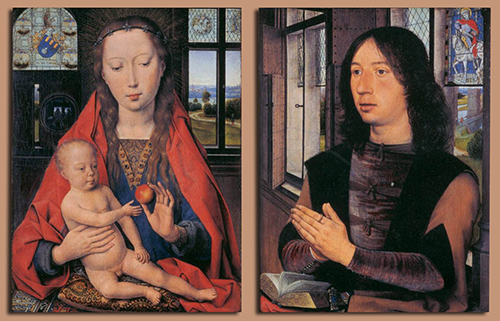 Painting by Hans Memling: The Diptych of Maarten van Nieuwenhove, showing on the left side the Virgin and Child, and on the right side Maarten van Nieuwenhove. It is now kept in the Old St. John's Hospital in Bruges. It is unsigned, but has invariably been attributed to Hans Memling since the middle of the 19th century. The painting is an early example of an Early Netherlandish devotional diptych, which still preserves the original frame and hinges. A new invention was showing the scene in a continuous room, instead of against a monochrome background.
Painting by Hans Memling: The Diptych of Maarten van Nieuwenhove, showing on the left side the Virgin and Child, and on the right side Maarten van Nieuwenhove. It is now kept in the Old St. John's Hospital in Bruges. It is unsigned, but has invariably been attributed to Hans Memling since the middle of the 19th century. The painting is an early example of an Early Netherlandish devotional diptych, which still preserves the original frame and hinges. A new invention was showing the scene in a continuous room, instead of against a monochrome background.
1487
(no entry for this year)
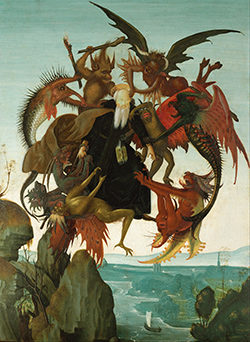 Painting by Michelangeo: The Torment of Saint Anthony (or The Temptation of Saint Anthony a painting believed to be done by Michelangelo, who painted this close copy of the famous engraving by Martin Schongauer when he was only 12 or 13 years old. Whether the painting is by Michelangelo is disputed. This painting is now in the Kimbell Art Museum in Fort Worth, Texas. It shows the common medieval subject, included in the Golden Legend and other sources, of Saint Anthony (AD 251 – 356) being assailed in the desert by demons, whose temptations he resisted; the Temptation of St Anthony (or "Trial") is the more common name of the subject. But this composition apparently shows a later episode where St Anthony, normally flown about the desert supported by angels, was ambushed in mid-air by devils.
Painting by Michelangeo: The Torment of Saint Anthony (or The Temptation of Saint Anthony a painting believed to be done by Michelangelo, who painted this close copy of the famous engraving by Martin Schongauer when he was only 12 or 13 years old. Whether the painting is by Michelangelo is disputed. This painting is now in the Kimbell Art Museum in Fort Worth, Texas. It shows the common medieval subject, included in the Golden Legend and other sources, of Saint Anthony (AD 251 – 356) being assailed in the desert by demons, whose temptations he resisted; the Temptation of St Anthony (or "Trial") is the more common name of the subject. But this composition apparently shows a later episode where St Anthony, normally flown about the desert supported by angels, was ambushed in mid-air by devils.
1488
(no entry for this year)
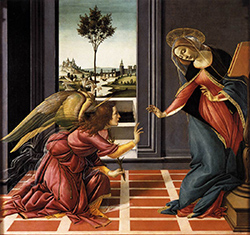 Painting by Sandro Botticcelli: The Cestello Annunciation, a tempera painting on panel. It was painted for the patron Benedetto di Ser Giovanni Guardi to adorn the church of the Florentine monastery of Cestello, which is now known as Santa Maria Maddalena de'Pazzi. The subject of the painting is the Annunciation, in which the Archangel Gabriel visits the Virgin Mary to 'announce' to her (hence 'Annunciation') that she has been chosen by God to bear the Christ child should she accept this invitation. Her 'fiat' (Let it be done to me) is the Annunciation. If She had said no, there would be no Redemption for mankind. Underneath the painting on its original frame are words in Latin from St. Luke's Gospel 1:35: "The Holy Ghost shall come upon thee, and the power of the Highest shall overshadow thee." The subject of the Annunciation is common in Christian art and has been depicted by many artists, in multiple formats, and in different time periods. In addition to the Cestello Annunciation, Botticelli also painted a 1485 Annunciation now in the Metropolitan Museum of Art and a 1495-1500 version now housed in the Kelvingrove Art Gallery and Museum.
Painting by Sandro Botticcelli: The Cestello Annunciation, a tempera painting on panel. It was painted for the patron Benedetto di Ser Giovanni Guardi to adorn the church of the Florentine monastery of Cestello, which is now known as Santa Maria Maddalena de'Pazzi. The subject of the painting is the Annunciation, in which the Archangel Gabriel visits the Virgin Mary to 'announce' to her (hence 'Annunciation') that she has been chosen by God to bear the Christ child should she accept this invitation. Her 'fiat' (Let it be done to me) is the Annunciation. If She had said no, there would be no Redemption for mankind. Underneath the painting on its original frame are words in Latin from St. Luke's Gospel 1:35: "The Holy Ghost shall come upon thee, and the power of the Highest shall overshadow thee." The subject of the Annunciation is common in Christian art and has been depicted by many artists, in multiple formats, and in different time periods. In addition to the Cestello Annunciation, Botticelli also painted a 1485 Annunciation now in the Metropolitan Museum of Art and a 1495-1500 version now housed in the Kelvingrove Art Gallery and Museum.
1489
(no entry for this year)
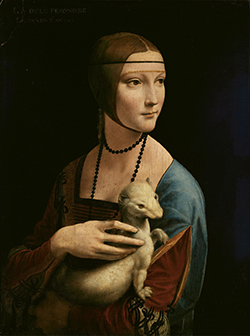 Painting by Leonardo da Vinci: Lady with an Ermine, a portrait painting, in oils on a panel of walnut wood. Its subject is Cecilia Gallerani, a mistress of Ludovico Sforza ("Il Moro"), Duke of Milan; Leonardo was painter to the Sforza court in Milan at the time of its execution. It is the second of only four surviving portraits of women painted by Leonardo, the others being Ginevra de' Benci, La Belle Ferronnière and the Mona Lisa. Lady with an Ermine is now housed at the Czartoryski Museum in Kraków, and is one of Poland's national treasures.
Painting by Leonardo da Vinci: Lady with an Ermine, a portrait painting, in oils on a panel of walnut wood. Its subject is Cecilia Gallerani, a mistress of Ludovico Sforza ("Il Moro"), Duke of Milan; Leonardo was painter to the Sforza court in Milan at the time of its execution. It is the second of only four surviving portraits of women painted by Leonardo, the others being Ginevra de' Benci, La Belle Ferronnière and the Mona Lisa. Lady with an Ermine is now housed at the Czartoryski Museum in Kraków, and is one of Poland's national treasures.
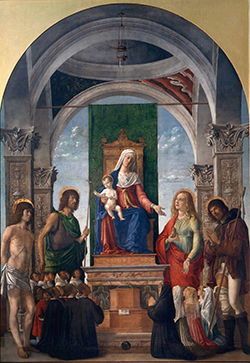 Painting by Cima da Conegliano: The Sacred Conversation
Painting by Cima da Conegliano: The Sacred Conversation
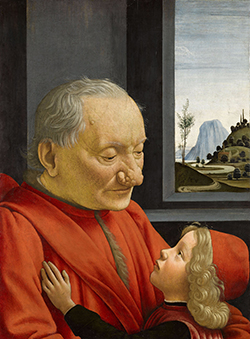 Painting by Domenico Ghirlandaio: An Old Man and his Grandson, a tempera painting. One of Ghirlandaio's best-known works, it is considered notable for its emotional poignancy. Its realism has been described as unique among the portraits of the Quattrocento. The picture portrays an older man in a red robe, embracing a young child who is also wearing red. They sit in an interior, illuminated against a darkened wall. Behind them at right is a window through which can be seen a generalized landscape, its uneven terrain and winding roads typical of Ghirlandaio's backgrounds. Although the man's fur-lined robe and cappuccio and the boy's elegant doublet and cap indicate a noble heritage, and despite the traditional assumption that the subjects are grandfather and grandson, their identities are unknown.
Painting by Domenico Ghirlandaio: An Old Man and his Grandson, a tempera painting. One of Ghirlandaio's best-known works, it is considered notable for its emotional poignancy. Its realism has been described as unique among the portraits of the Quattrocento. The picture portrays an older man in a red robe, embracing a young child who is also wearing red. They sit in an interior, illuminated against a darkened wall. Behind them at right is a window through which can be seen a generalized landscape, its uneven terrain and winding roads typical of Ghirlandaio's backgrounds. Although the man's fur-lined robe and cappuccio and the boy's elegant doublet and cap indicate a noble heritage, and despite the traditional assumption that the subjects are grandfather and grandson, their identities are unknown.
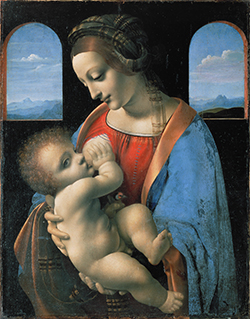 Painting by Leonardo da Vinci: Madonna Litta, a late 15th-century painting, by Leonardo da Vinci, in the Hermitage Museum, Saint Petersburg. It depicts the Virgin Mary breastfeeding the Christ child, a devotional subject known as the Madonna lactans. The figures are set in a dark interior with two arched openings, as in Leonardo's earlier Madonna of the Carnation, and a mountainous landscape in aerial perspective can be seen beyond. In his left hand Christ holds a goldfinch, which is symbolic of his future Passion. Scholarly opinion is divided on the work's attribution, with some believing it to be the work of a pupil of Leonardo such as Giovanni Antonio Boltraffio or Marco d'Oggiono; the Hermitage Museum, however, considers the painting to be an autograph work by Leonardo. The painting takes its name from the House of Litta, a Milanese noble family in whose collection it was for much of the nineteenth century.
Painting by Leonardo da Vinci: Madonna Litta, a late 15th-century painting, by Leonardo da Vinci, in the Hermitage Museum, Saint Petersburg. It depicts the Virgin Mary breastfeeding the Christ child, a devotional subject known as the Madonna lactans. The figures are set in a dark interior with two arched openings, as in Leonardo's earlier Madonna of the Carnation, and a mountainous landscape in aerial perspective can be seen beyond. In his left hand Christ holds a goldfinch, which is symbolic of his future Passion. Scholarly opinion is divided on the work's attribution, with some believing it to be the work of a pupil of Leonardo such as Giovanni Antonio Boltraffio or Marco d'Oggiono; the Hermitage Museum, however, considers the painting to be an autograph work by Leonardo. The painting takes its name from the House of Litta, a Milanese noble family in whose collection it was for much of the nineteenth century.
1490
(no entry for this year)
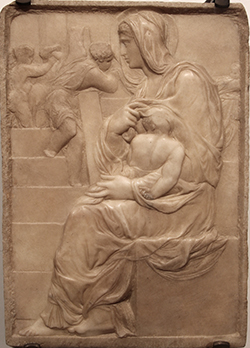 Sculpture by Michelangelo: Madonna of the Stairs, a relief sculpture in the Casa Buonarroti, Florence. It was sculpted around 1490–91, when Michelangelo was about fifteen. This and the Battle of the Centaurs were Michelangelo's first two sculptures. The first reference to the Madonna of the Stairs as a work by Michelangelo was in the 1568 edition of Giorgio Vasari's Lives of the Most Excellent Painters, Sculptors, and Architects. The sculpture is exhibited at the Casa Buonarroti in Florence, Italy.
Sculpture by Michelangelo: Madonna of the Stairs, a relief sculpture in the Casa Buonarroti, Florence. It was sculpted around 1490–91, when Michelangelo was about fifteen. This and the Battle of the Centaurs were Michelangelo's first two sculptures. The first reference to the Madonna of the Stairs as a work by Michelangelo was in the 1568 edition of Giorgio Vasari's Lives of the Most Excellent Painters, Sculptors, and Architects. The sculpture is exhibited at the Casa Buonarroti in Florence, Italy.
1491
King Charles VIII of France invades Brittany and forces 14-year-old Ann of Brittany to marry him, adding Brittany to French territory.
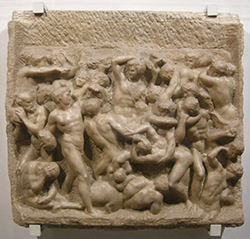 Sculpture by Michelangelo: Battle of the Centaurs, a relief created around 1492. It was the last work Michelangelo created while under the patronage of Lorenzo de' Medici, who died shortly after its completion. Inspired by a classical relief created by Bertoldo di Giovanni, the marble sculpture represents the mythic battle between the Lapiths and the Centaurs. A popular subject of art in ancient Greece, the story was suggested to Michelangelo by the classical scholar and poet Poliziano. The sculpture is exhibited in the Casa Buonarroti in Florence, Italy. Michelangelo, at 16, was working under the patronage of Lorenzo de' Medici when he sculpted the Battle of the Centaurs, although the work was not commissioned but created for himself. The work reflected what was then a current fashion for reproducing ancient themes.
Sculpture by Michelangelo: Battle of the Centaurs, a relief created around 1492. It was the last work Michelangelo created while under the patronage of Lorenzo de' Medici, who died shortly after its completion. Inspired by a classical relief created by Bertoldo di Giovanni, the marble sculpture represents the mythic battle between the Lapiths and the Centaurs. A popular subject of art in ancient Greece, the story was suggested to Michelangelo by the classical scholar and poet Poliziano. The sculpture is exhibited in the Casa Buonarroti in Florence, Italy. Michelangelo, at 16, was working under the patronage of Lorenzo de' Medici when he sculpted the Battle of the Centaurs, although the work was not commissioned but created for himself. The work reflected what was then a current fashion for reproducing ancient themes.
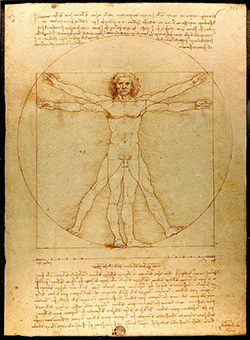 Drawing by Leonardo da Vinci: Vitruvian Man. Inspired by the writings of the ancient Roman architect Vitruvius, the drawing depicts a nude man in two superimposed positions with his arms and legs apart and inscribed in both a circle and square. It was described by the art historian Carmen C. Bambach as "justly ranked among the all-time iconic images of Western civilization". Although not the only known drawing of a man inspired by the writings of Vitruvius, the work is a unique synthesis of artistic and scientific ideals and often considered an archetypal representation of the High Renaissance. The drawing represents Leonardo's conception of ideal body proportions, originally derived from Vitruvius but influenced by his own measurements, the drawings of his contemporaries, and the De pictura treatise by Leon Battista Alberti. Leonardo produced the Vitruvian Man in Milan and the work was probably passed to his student Francesco Melzi.
Drawing by Leonardo da Vinci: Vitruvian Man. Inspired by the writings of the ancient Roman architect Vitruvius, the drawing depicts a nude man in two superimposed positions with his arms and legs apart and inscribed in both a circle and square. It was described by the art historian Carmen C. Bambach as "justly ranked among the all-time iconic images of Western civilization". Although not the only known drawing of a man inspired by the writings of Vitruvius, the work is a unique synthesis of artistic and scientific ideals and often considered an archetypal representation of the High Renaissance. The drawing represents Leonardo's conception of ideal body proportions, originally derived from Vitruvius but influenced by his own measurements, the drawings of his contemporaries, and the De pictura treatise by Leon Battista Alberti. Leonardo produced the Vitruvian Man in Milan and the work was probably passed to his student Francesco Melzi.
1492
Spain's monarchs, Ferdinand and Isabella, do their part in a war against Islam — they annex Granada. Also they give Jews three months to convert to Christianity if they are to avoid banishment from the country. And the voyage that the monarchy is paying for, led by Christopher Columbus, sets sail for China by going westward.
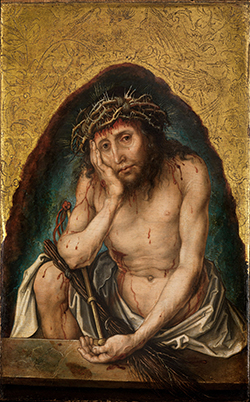 Painting by Albrecht Dürer: Christ as the Man of Sorrows. Bearing the marks of martyrdom and holding the instruments used to scourge him in his hands, a pensive, exhausted man crouches before us and looks straight at us, questioningly. This is an unusual mixture of a concrete moment in time and a summary of the entire Passion of Jesus. With the living figure of Christ and the expressive look on his face, this work testifies to the perceptiveness of the young Dürer. By inviting believers in a special way to immerse themselves compassionately in the man's suffering, the small format painting shows itself to be an exceptional devotional picture.
Painting by Albrecht Dürer: Christ as the Man of Sorrows. Bearing the marks of martyrdom and holding the instruments used to scourge him in his hands, a pensive, exhausted man crouches before us and looks straight at us, questioningly. This is an unusual mixture of a concrete moment in time and a summary of the entire Passion of Jesus. With the living figure of Christ and the expressive look on his face, this work testifies to the perceptiveness of the young Dürer. By inviting believers in a special way to immerse themselves compassionately in the man's suffering, the small format painting shows itself to be an exceptional devotional picture.
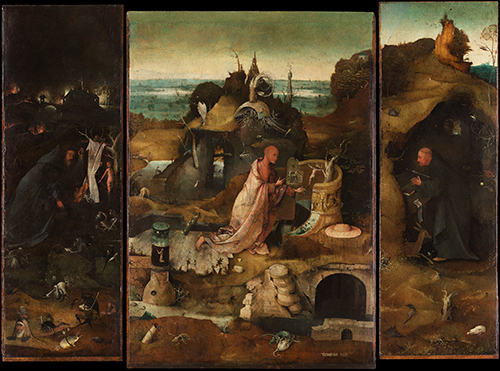 Painting by Hieronymus Bosch: The Hermit Saints, a religious oil on panel painting displayed as a triptych. The entirety of the triptych painting measures 86 by 60 centimetres (34 in × 24 in). This artwork is currently being housed at the Gallerie dell'Accademia, Venice. Saints are a common theme in Bosch's artwork; for him, they are a reference to the living and also to suffering against what was considered sinful. Likewise, there is often the portrayal of brutality and agony that far outweighs the beauty in Bosch's work since he uses saints as a moral paradigm of the artist's time. He represents them as those who are most faithful in their beliefs.
Painting by Hieronymus Bosch: The Hermit Saints, a religious oil on panel painting displayed as a triptych. The entirety of the triptych painting measures 86 by 60 centimetres (34 in × 24 in). This artwork is currently being housed at the Gallerie dell'Accademia, Venice. Saints are a common theme in Bosch's artwork; for him, they are a reference to the living and also to suffering against what was considered sinful. Likewise, there is often the portrayal of brutality and agony that far outweighs the beauty in Bosch's work since he uses saints as a moral paradigm of the artist's time. He represents them as those who are most faithful in their beliefs.
1493
(no entry for this year)
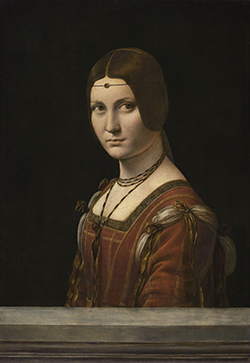 Painting by Leonardo da Vinci: La Belle Ferronnière,a portrait painting of a lady. It is also known as Portrait of an Unknown Woman. The painting's title, applied as early as the seventeenth century, identifying the sitter as the wife or daughter of an ironmonger (a ferronnier), was said to be discreetly alluding to a reputed mistress of Francis I of France, married to a certain Le Ferron. Later she was tentatively identified as Lucretia Crivelli, a married lady-in-waiting to Duchess Beatrice of Milan, who became another of the Duke's mistresses. Although the model of the painting La Belle Ferronnière is still shrouded in mystery, the landmark exhibition "Leonardo Da Vinci: Painter at the Court of Milan" (National Gallery, London, 9 Nov. 2011 – 5 Feb. 2012) listed the portrait as possibly depicting Beatrice d'Este, wife of Ludovico Sforza. This challenges an earlier identification of the sitter as Lucrezia Crivelli, a mistress of Ludovico. However, Ferronni&egrare could be a reference to Beatrice Sforza's birthplace, the Duchy of Ferrara.
Painting by Leonardo da Vinci: La Belle Ferronnière,a portrait painting of a lady. It is also known as Portrait of an Unknown Woman. The painting's title, applied as early as the seventeenth century, identifying the sitter as the wife or daughter of an ironmonger (a ferronnier), was said to be discreetly alluding to a reputed mistress of Francis I of France, married to a certain Le Ferron. Later she was tentatively identified as Lucretia Crivelli, a married lady-in-waiting to Duchess Beatrice of Milan, who became another of the Duke's mistresses. Although the model of the painting La Belle Ferronnière is still shrouded in mystery, the landmark exhibition "Leonardo Da Vinci: Painter at the Court of Milan" (National Gallery, London, 9 Nov. 2011 – 5 Feb. 2012) listed the portrait as possibly depicting Beatrice d'Este, wife of Ludovico Sforza. This challenges an earlier identification of the sitter as Lucrezia Crivelli, a mistress of Ludovico. However, Ferronni&egrare could be a reference to Beatrice Sforza's birthplace, the Duchy of Ferrara.
Following heavy snowfall in Florence, the Italian sculptor Michelangelo was commissioned by the Medicis to build a snowman.
1494
Piero de Medici has ruled since the death of his father, Lorenzo, in 1492. He makes peace with the French, who have invaded Tuscany (in which Florence is located). A political rising drives him into exile. Florence is in anarchy. A Dominican priest, Savonarola, is anti-Renaissance. He is opposed to popular music, art and other worldliness.
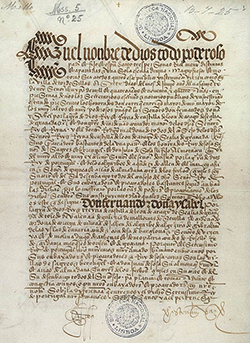 The Treaty of Tordesillas, signed in Tordesillas, Spain, on 7 June 1494, and ratified in Setúbal, Portugal, divided the newly discovered lands outside Europe between the Kingdom of Portugal and the Crown of Castile, along a meridian 370 leagues west of the Cape Verde islands, off the west coast of Africa. That line of demarcation was about halfway between Cape Verde (already Portuguese) and the islands visited by Christopher Columbus on his first voyage (claimed for Castile and León), named in the treaty as Cipangu and Antillia (Cuba and Hispaniola). The lands to the east would belong to Portugal and the lands to the west to Castile, modifying an earlier bull by Pope Alexander VI. The treaty was signed by Spain on 2 July 1494, and by Portugal on 5 September 1494. The other side of the world was divided a few decades later by the Treaty of Zaragoza, signed on 22 April 1529, which specified the antimeridian to the line of demarcation specified in the Treaty of Tordesillas. Portugal and Spain largely respected the treaties, while the indigenous peoples of the Americas did not acknowledge them.
The Treaty of Tordesillas, signed in Tordesillas, Spain, on 7 June 1494, and ratified in Setúbal, Portugal, divided the newly discovered lands outside Europe between the Kingdom of Portugal and the Crown of Castile, along a meridian 370 leagues west of the Cape Verde islands, off the west coast of Africa. That line of demarcation was about halfway between Cape Verde (already Portuguese) and the islands visited by Christopher Columbus on his first voyage (claimed for Castile and León), named in the treaty as Cipangu and Antillia (Cuba and Hispaniola). The lands to the east would belong to Portugal and the lands to the west to Castile, modifying an earlier bull by Pope Alexander VI. The treaty was signed by Spain on 2 July 1494, and by Portugal on 5 September 1494. The other side of the world was divided a few decades later by the Treaty of Zaragoza, signed on 22 April 1529, which specified the antimeridian to the line of demarcation specified in the Treaty of Tordesillas. Portugal and Spain largely respected the treaties, while the indigenous peoples of the Americas did not acknowledge them.
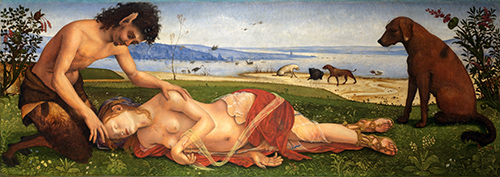 Painting by Piero di Cosimo: The Death of Procris, A Satyr mourning over a Nymph are names given to an unsigned, undated panel painting in the National Gallery in London, United Kingdom, securely attributed to Piero di Cosimo (who never signed his works). Its date is uncertain, and its subject has been a matter of dispute. The name The Death of Procris (Italian: Morte di Procri) has been used since the 19th century, and is supposed to have been inspired by Ovid's tale of the death of Procris at the hands of her husband Cephalus, in Metamorphoses VII. Despite the uncertainty surrounding the subject matter, the painting, which shows a satyr mourning over the body of a young woman, has been one of the most popular works by Piero di Cosimo. Erwin Panofsky was mesmerized by the "strange lure emanating from the picture", and other commentators have admired its "hazy atmosphere of a waking dream".
Painting by Piero di Cosimo: The Death of Procris, A Satyr mourning over a Nymph are names given to an unsigned, undated panel painting in the National Gallery in London, United Kingdom, securely attributed to Piero di Cosimo (who never signed his works). Its date is uncertain, and its subject has been a matter of dispute. The name The Death of Procris (Italian: Morte di Procri) has been used since the 19th century, and is supposed to have been inspired by Ovid's tale of the death of Procris at the hands of her husband Cephalus, in Metamorphoses VII. Despite the uncertainty surrounding the subject matter, the painting, which shows a satyr mourning over the body of a young woman, has been one of the most popular works by Piero di Cosimo. Erwin Panofsky was mesmerized by the "strange lure emanating from the picture", and other commentators have admired its "hazy atmosphere of a waking dream".
 Scroll by Sesshū Tōyō: Haboku sansui, Broken Ink Landscape, a splashed-ink landscape painting on a hanging scroll. The ink wash painting is classified as a National Treasure of Japan and currently held by the Tokyo National Museum. Sesshū Tōyō was a Zen Buddhist monk and painter. The work is a development of suibokuga paintings made with Chinese ink (sumi), using dark and light shades on a silk or paper medium. The monochromatic style can result in artworks similar to calligraphy. In spite of its title, the work is not one of "broken ink" (haboku) but rather one of "splashed ink" (hatsuboku). In this style, the painter avoids strongly defined outlines, with shapes indicated by color washes in lighter and darker tones. The work slowly reveals itself to the viewer. Emerging from the undefined forms is the suggestion of misty mountains in the background. In the foreground are cliffs and bushes, and the triangular roofline and a sloping banner for a wine shop with vertical lines forming a fence. Below is indicated the flat surface of a body of water, with two people to the right in a rowing boat. The scroll measures 148.6 by 32.7 centimetres (58.5 in × 12.9 in). It bears a dedicatory inscription by the artist, dating it to the middle of the third month in the fourth year of the Meiō era (that is, April or May 1495), when Sesshū was aged 76.
Scroll by Sesshū Tōyō: Haboku sansui, Broken Ink Landscape, a splashed-ink landscape painting on a hanging scroll. The ink wash painting is classified as a National Treasure of Japan and currently held by the Tokyo National Museum. Sesshū Tōyō was a Zen Buddhist monk and painter. The work is a development of suibokuga paintings made with Chinese ink (sumi), using dark and light shades on a silk or paper medium. The monochromatic style can result in artworks similar to calligraphy. In spite of its title, the work is not one of "broken ink" (haboku) but rather one of "splashed ink" (hatsuboku). In this style, the painter avoids strongly defined outlines, with shapes indicated by color washes in lighter and darker tones. The work slowly reveals itself to the viewer. Emerging from the undefined forms is the suggestion of misty mountains in the background. In the foreground are cliffs and bushes, and the triangular roofline and a sloping banner for a wine shop with vertical lines forming a fence. Below is indicated the flat surface of a body of water, with two people to the right in a rowing boat. The scroll measures 148.6 by 32.7 centimetres (58.5 in × 12.9 in). It bears a dedicatory inscription by the artist, dating it to the middle of the third month in the fourth year of the Meiō era (that is, April or May 1495), when Sesshū was aged 76.
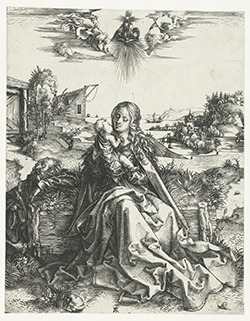 Engraving by Albrecht Dürer: The Holy Family with the Dragonfly, also known as The Holy Family with the Mayfly, The Holy Family with the Locust, and The Holy Family with the Butterfly. It depicts both the Holy Family and the Holy Trinity, as the Virgin Mary sits on a bench holding Jesus with Joseph beside them, while God the Father and the Holy Ghost in the form of a dove look down from the clouds. In the lower right corner is an insect frequently identified as a dragonfly. However, Dürer may have intended it as a butterfly, a creature whose dramatically transformative life-cycle makes it a perfect symbol of resurrection and redemption. The abundance of beautifully-rendered textures in the richly detailed landscape show how early Dürer mastered the art of engraving.
Engraving by Albrecht Dürer: The Holy Family with the Dragonfly, also known as The Holy Family with the Mayfly, The Holy Family with the Locust, and The Holy Family with the Butterfly. It depicts both the Holy Family and the Holy Trinity, as the Virgin Mary sits on a bench holding Jesus with Joseph beside them, while God the Father and the Holy Ghost in the form of a dove look down from the clouds. In the lower right corner is an insect frequently identified as a dragonfly. However, Dürer may have intended it as a butterfly, a creature whose dramatically transformative life-cycle makes it a perfect symbol of resurrection and redemption. The abundance of beautifully-rendered textures in the richly detailed landscape show how early Dürer mastered the art of engraving.
1495
(no entry for this year)
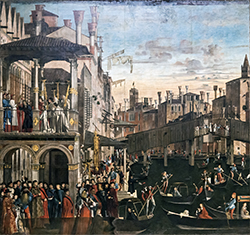 Painting by Vittore Carpaccio: Miracle of the Relic of the Cross at the Ponte di Rialto, also known as The Healing of the Madman, is a painting dating from c. 1496. It is now housed at the Gallerie dell'Accademia in Venice. The painting was commissioned for the Grand Hall of the Scuola Grande di San Giovanni Evangelista, the seat of the eponymous brotherhood in Venice. The subject of the paintings was to be the miracles of a fragment of the True Cross. The canvasses were all executed between 1496–1501. This painting shows the miracle of the healing of a madman through the relic of the Holy Cross, held by the Patriarch of Grado Francesco Querini, which took place in the Palazzo a San Silvestro on the Canal Grande, near the Rialto Bridge.
Painting by Vittore Carpaccio: Miracle of the Relic of the Cross at the Ponte di Rialto, also known as The Healing of the Madman, is a painting dating from c. 1496. It is now housed at the Gallerie dell'Accademia in Venice. The painting was commissioned for the Grand Hall of the Scuola Grande di San Giovanni Evangelista, the seat of the eponymous brotherhood in Venice. The subject of the paintings was to be the miracles of a fragment of the True Cross. The canvasses were all executed between 1496–1501. This painting shows the miracle of the healing of a madman through the relic of the Holy Cross, held by the Patriarch of Grado Francesco Querini, which took place in the Palazzo a San Silvestro on the Canal Grande, near the Rialto Bridge.
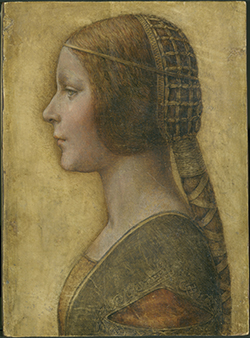 Painting by Leonardo da Vinci: La Bella Principessa,also known as Portrait of Bianca Sforza, Young Girl in Profile in Renaissance Dress and Portrait of a Young Fiancée, is a portrait in colored chalks and ink, on vellum, of a young lady in fashionable costume and hairstyle of a Milanese of the 1490s. Some scholars have attributed it to Leonardo da Vinci but the attribution and the work's authenticity have been disputed. Supporters of the theory that it was by Leonardo have propositioned that Bianca Maria Sforza is the woman depicted in the drawing. Some of those who disagree with the attribution to Leonardo believe the portrait is by an early 19th-century German artist imitating the style of the Italian Renaissance, although radiocarbon dating tests show a much earlier date for the vellum. It has also been denounced as a forgery. The white lead has been dated to be at least 225 years old. The work sold for just under $22,000 at auction in 1998, and was bought by its current owner Peter Silverman in 2007. He has championed the attribution to Leonardo, supported by the analysis of academics Martin Kemp and Pascal Cotte.
Painting by Leonardo da Vinci: La Bella Principessa,also known as Portrait of Bianca Sforza, Young Girl in Profile in Renaissance Dress and Portrait of a Young Fiancée, is a portrait in colored chalks and ink, on vellum, of a young lady in fashionable costume and hairstyle of a Milanese of the 1490s. Some scholars have attributed it to Leonardo da Vinci but the attribution and the work's authenticity have been disputed. Supporters of the theory that it was by Leonardo have propositioned that Bianca Maria Sforza is the woman depicted in the drawing. Some of those who disagree with the attribution to Leonardo believe the portrait is by an early 19th-century German artist imitating the style of the Italian Renaissance, although radiocarbon dating tests show a much earlier date for the vellum. It has also been denounced as a forgery. The white lead has been dated to be at least 225 years old. The work sold for just under $22,000 at auction in 1998, and was bought by its current owner Peter Silverman in 2007. He has championed the attribution to Leonardo, supported by the analysis of academics Martin Kemp and Pascal Cotte.
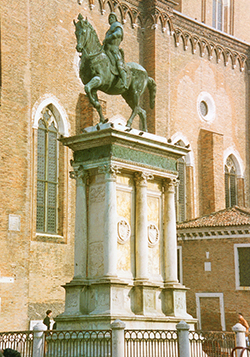 The bronze equestrian statue of Bartolomeo Colleoni designed by Andrea del Verrocchio and completed by Alessandro Leopardi is unveiled in Venice
The bronze equestrian statue of Bartolomeo Colleoni designed by Andrea del Verrocchio and completed by Alessandro Leopardi is unveiled in Venice
1496
(no entry for this year)
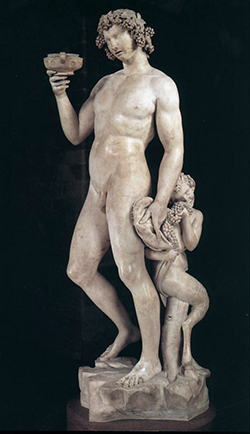 Sculpture by Michelangelo: Bacchus. The statue is somewhat over life-size and represents Bacchus, the Roman god of wine, in a reeling pose suggestive of drunkenness. Commissioned by Raffaele Riario, a high-ranking Cardinal and collector of antique sculpture, it was rejected by him and was bought instead by Jacopo Galli, Riario's banker and a friend to Michelangelo. Together with the Pietà, the Bacchus is one of only two surviving sculptures from the artist's first period in Rome.
Sculpture by Michelangelo: Bacchus. The statue is somewhat over life-size and represents Bacchus, the Roman god of wine, in a reeling pose suggestive of drunkenness. Commissioned by Raffaele Riario, a high-ranking Cardinal and collector of antique sculpture, it was rejected by him and was bought instead by Jacopo Galli, Riario's banker and a friend to Michelangelo. Together with the Pietà, the Bacchus is one of only two surviving sculptures from the artist's first period in Rome.
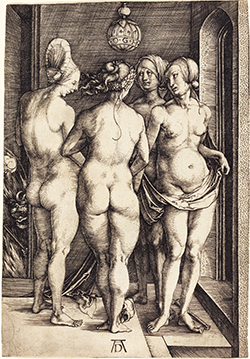 Engraving by Albrecht Dürer: The Four Naked Women, or The Four Witches. It is one of his earliest signed engravings and shows four exuberant nude women gathered conspiratorially in a circle in a confined interior setting, perhaps a bathhouse, which appears to have entrances from either side. Although the image is clearly erotic, a small horned demon in the left-hand portal, perhaps representing temptation, looks out and holds what may be a hunting object, engulfed in flames. The engraving has been subject to prolonged and significant scholarly analysis it remains enigmatic, and there is nothing in his writings to indicate his intent. There is no consensus as to its subject matter or its intended meaning, with art historians associating it with either witch hunting or figures from classical mythology. The women stand underneath a suspended globe or sphere and before an open stone window, which, given the human skull and thigh bone placed across from it, maybe a gateway to death, and that the women are engaged in some type of nefarious scheme, perhaps linked to the 1487 inquisition treatise Malleus Maleficarum. The alternative view is that the women represent Greek or Roman goddesses, perhaps Hecate, patroness of evil magic, poisonous plants, and ghosts, or her earthly counterpart Diana. Dürer's monogram "AD" appears on the centre of the floor. Numerous original prints exist, held at a number of major museums.
Engraving by Albrecht Dürer: The Four Naked Women, or The Four Witches. It is one of his earliest signed engravings and shows four exuberant nude women gathered conspiratorially in a circle in a confined interior setting, perhaps a bathhouse, which appears to have entrances from either side. Although the image is clearly erotic, a small horned demon in the left-hand portal, perhaps representing temptation, looks out and holds what may be a hunting object, engulfed in flames. The engraving has been subject to prolonged and significant scholarly analysis it remains enigmatic, and there is nothing in his writings to indicate his intent. There is no consensus as to its subject matter or its intended meaning, with art historians associating it with either witch hunting or figures from classical mythology. The women stand underneath a suspended globe or sphere and before an open stone window, which, given the human skull and thigh bone placed across from it, maybe a gateway to death, and that the women are engaged in some type of nefarious scheme, perhaps linked to the 1487 inquisition treatise Malleus Maleficarum. The alternative view is that the women represent Greek or Roman goddesses, perhaps Hecate, patroness of evil magic, poisonous plants, and ghosts, or her earthly counterpart Diana. Dürer's monogram "AD" appears on the centre of the floor. Numerous original prints exist, held at a number of major museums.
1497
Boys working under Savonarola collect from homes things associated with moral laxity: mirrors, cosmetics, pictures, books, fine dresses, the works of immoral poets. Savonarola has these burned. Renaissance art work is lost. Pope Alexander VI excommunicates Savonarola.
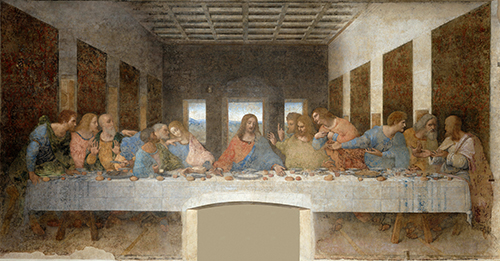 Painting by Leonardo da Vinci: The Last Supper, a mural painting, dated to c. 1495–1498, housed in the refectory of the Convent of Santa Maria delle Grazie in Milan, Italy. The painting represents the scene of the Last Supper of Jesus with the Twelve Apostles, as it is told in the Gospel of John — specifically the moment after Jesus announces that one of his apostles will betray him. Its handling of space, mastery of perspective, treatment of motion and complex display of human emotion has made it one of the Western world's most recognizable paintings and among Leonardo's most celebrated works. Some commentators consider it pivotal in inaugurating the transition into what is now termed the High Renaissance. The painting is huge (roughly 15 feet × 30 feet) and covers the end wall of the refectory. To appreciate the size, one must see it in person.
Painting by Leonardo da Vinci: The Last Supper, a mural painting, dated to c. 1495–1498, housed in the refectory of the Convent of Santa Maria delle Grazie in Milan, Italy. The painting represents the scene of the Last Supper of Jesus with the Twelve Apostles, as it is told in the Gospel of John — specifically the moment after Jesus announces that one of his apostles will betray him. Its handling of space, mastery of perspective, treatment of motion and complex display of human emotion has made it one of the Western world's most recognizable paintings and among Leonardo's most celebrated works. Some commentators consider it pivotal in inaugurating the transition into what is now termed the High Renaissance. The painting is huge (roughly 15 feet × 30 feet) and covers the end wall of the refectory. To appreciate the size, one must see it in person.
 Painting by Albrecht Dürer: Self Portrait, the second of Albrecht Dürer's three painted self-portraits and was executed in oil on wood panel, after his first trip to Italy. In the depiction, Dürer elevates himself to the social position he believed suited to an artist of his ability. He presents himself in half length, under an arch, turned towards the viewer. He bears an arrogant expression, betraying the assured self-confidence of a young artist at the height of his ability. His presence dominates the pictorial space, from his hat, which almost reaches the top of the canvas, to his arm positioned on the lower ledge, where he rests his fingers enclosed in fine, rich gloves. Dürer is depicted in front of an open window before a flat landscape containing a lake and distant snow-capped mountains. The landscape may represent either the memory of his recent travels abroad or his inner mental state. Light spills from the window, falling along his head to highlight both his delicate skin tones and long blond hair. Dürer is dressed with effeminate grace in flamboyant, extravagant clothes showing the influence of Italian fashion. His low-necked shirt or chemise is of fine linen, gathered and trimmed with a band of gold braid or embroidery, and worn under an open-fronted doublet and a cloak tied over one shoulder. His white jacket has black lining under a pleated white shirt, the verticals of which match the horizontals of his headdress. His fingers are crossed, hidden inside silk gloves, an unusual pose for Dürer's early career; he always paid close attention in detailing the hands of his sitters, who are usually holding an object; examples include a pillow, rosary, sheet of paper and flower. Dürer is presented as almost seductive, with a rakish patterned hat placed over long, almost girlishly curled blond locks of hair under a draped pointed hat with a tassel. He looks out at the viewer with a cool ironic stare.
Painting by Albrecht Dürer: Self Portrait, the second of Albrecht Dürer's three painted self-portraits and was executed in oil on wood panel, after his first trip to Italy. In the depiction, Dürer elevates himself to the social position he believed suited to an artist of his ability. He presents himself in half length, under an arch, turned towards the viewer. He bears an arrogant expression, betraying the assured self-confidence of a young artist at the height of his ability. His presence dominates the pictorial space, from his hat, which almost reaches the top of the canvas, to his arm positioned on the lower ledge, where he rests his fingers enclosed in fine, rich gloves. Dürer is depicted in front of an open window before a flat landscape containing a lake and distant snow-capped mountains. The landscape may represent either the memory of his recent travels abroad or his inner mental state. Light spills from the window, falling along his head to highlight both his delicate skin tones and long blond hair. Dürer is dressed with effeminate grace in flamboyant, extravagant clothes showing the influence of Italian fashion. His low-necked shirt or chemise is of fine linen, gathered and trimmed with a band of gold braid or embroidery, and worn under an open-fronted doublet and a cloak tied over one shoulder. His white jacket has black lining under a pleated white shirt, the verticals of which match the horizontals of his headdress. His fingers are crossed, hidden inside silk gloves, an unusual pose for Dürer's early career; he always paid close attention in detailing the hands of his sitters, who are usually holding an object; examples include a pillow, rosary, sheet of paper and flower. Dürer is presented as almost seductive, with a rakish patterned hat placed over long, almost girlishly curled blond locks of hair under a draped pointed hat with a tassel. He looks out at the viewer with a cool ironic stare.
1498
Savonarola is hanged. An enraged crowd burns Savonarola at the same spot where he ordered his bonfire.
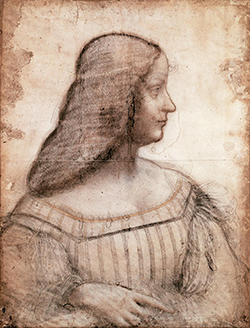 Drawing by Leonardo da Vinci: Portrait of Isabella d'Este,which was executed between 1499 and 1500. It depicts Isabella d'Este, Marchioness of Mantua. During the Italian Wars of 1499–1504, the French invaded Italy which caused Leonardo to flee from Milan to Mantua. There he had met Isabella, where she commissioned her portrait from him. Whether Leonardo completed the portrait is unknown. There is evidence through letters of the time that he held a fully completed painting of her, but they are vague in describing it. It is possible that the painting was lost to time or that it was, in fact, never completed at all. A version of the portrait in oils on canvas was found in a collection in Switzerland in 2015, but it has yet to be verified.
Drawing by Leonardo da Vinci: Portrait of Isabella d'Este,which was executed between 1499 and 1500. It depicts Isabella d'Este, Marchioness of Mantua. During the Italian Wars of 1499–1504, the French invaded Italy which caused Leonardo to flee from Milan to Mantua. There he had met Isabella, where she commissioned her portrait from him. Whether Leonardo completed the portrait is unknown. There is evidence through letters of the time that he held a fully completed painting of her, but they are vague in describing it. It is possible that the painting was lost to time or that it was, in fact, never completed at all. A version of the portrait in oils on canvas was found in a collection in Switzerland in 2015, but it has yet to be verified.
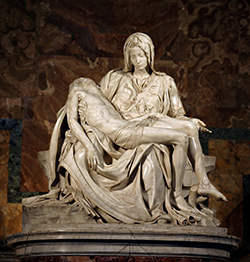 Sculpture by Michelangelo: the Pietà, a Carrara marble sculpture of Jesus and Mary at Mount Golgotha representing the "Sixth Sorrow" of the Virgin Mary by Michelangelo Buonarroti, in Saint Peter's Basilica, Vatican City, for which it was made . It is a key work of Italian Renaissance sculpture and often taken as the start of the High Renaissance. The sculpture captures the moment when Jesus, taken down from the cross, is given to his mother Mary.
Sculpture by Michelangelo: the Pietà, a Carrara marble sculpture of Jesus and Mary at Mount Golgotha representing the "Sixth Sorrow" of the Virgin Mary by Michelangelo Buonarroti, in Saint Peter's Basilica, Vatican City, for which it was made . It is a key work of Italian Renaissance sculpture and often taken as the start of the High Renaissance. The sculpture captures the moment when Jesus, taken down from the cross, is given to his mother Mary.
1499
(no entry for this year)
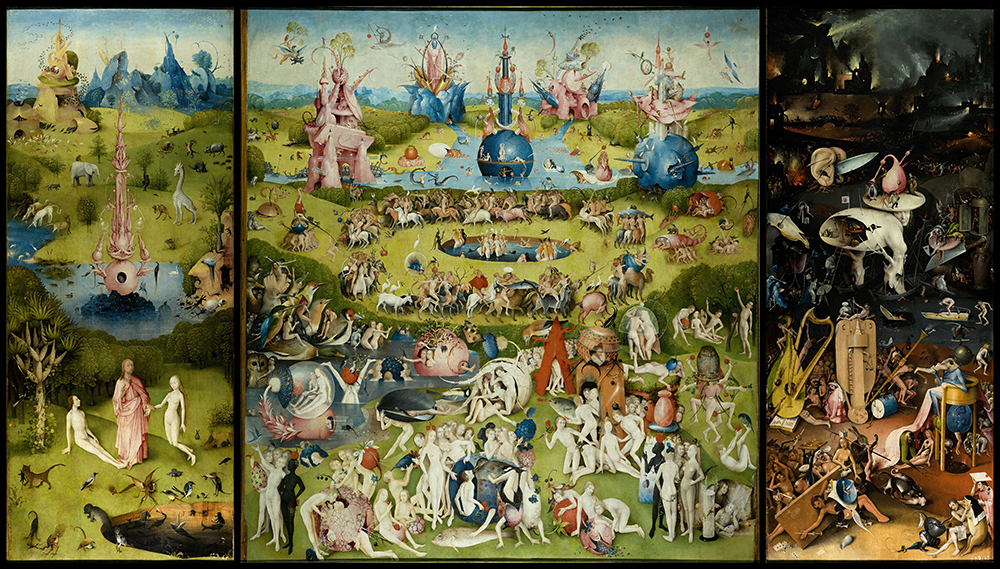 Painting by Hieronymous Bosch: The Garden of Earthly Delights the modern title given to a triptych oil painting on oak panel painted by the Early Netherlandish master Hieronymus Bosch, between 1490 and 1510, when Bosch was between 40 and 60 years old. Bosch's religious beliefs are unknown, but interpretations of the work typically assume it is a warning against the perils of temptation. The outer panels place the work on the Third Day of Creation. The intricacy of its symbolism, particularly that of the central panel, has led to a wide range of scholarly interpretations over the centuries. Twentieth-century art historians are divided as to whether the triptych's central panel is a moral warning or a panorama of the paradise lost. He painted three large triptychs (the others are The Last Judgment of c. 1482 and The Haywain Triptych of c. 1516) that can be read from left to right and in which each panel was essential to the meaning of the whole. Each of these three works presents distinct yet linked themes addressing history and faith. Triptychs from this period were generally intended to be read sequentially, the left and right panels often portraying Eden and the Last Judgment respectively, while the main subject was contained in the centerpiece. It is not known whether The Garden was intended as an altarpiece, but the general view is that the extreme subject matter of the inner center and right panels make it unlikely that it was planned for a church or monastery. It has been housed in the Museo del Prado in Madrid, Spain since 1939.
Painting by Hieronymous Bosch: The Garden of Earthly Delights the modern title given to a triptych oil painting on oak panel painted by the Early Netherlandish master Hieronymus Bosch, between 1490 and 1510, when Bosch was between 40 and 60 years old. Bosch's religious beliefs are unknown, but interpretations of the work typically assume it is a warning against the perils of temptation. The outer panels place the work on the Third Day of Creation. The intricacy of its symbolism, particularly that of the central panel, has led to a wide range of scholarly interpretations over the centuries. Twentieth-century art historians are divided as to whether the triptych's central panel is a moral warning or a panorama of the paradise lost. He painted three large triptychs (the others are The Last Judgment of c. 1482 and The Haywain Triptych of c. 1516) that can be read from left to right and in which each panel was essential to the meaning of the whole. Each of these three works presents distinct yet linked themes addressing history and faith. Triptychs from this period were generally intended to be read sequentially, the left and right panels often portraying Eden and the Last Judgment respectively, while the main subject was contained in the centerpiece. It is not known whether The Garden was intended as an altarpiece, but the general view is that the extreme subject matter of the inner center and right panels make it unlikely that it was planned for a church or monastery. It has been housed in the Museo del Prado in Madrid, Spain since 1939.
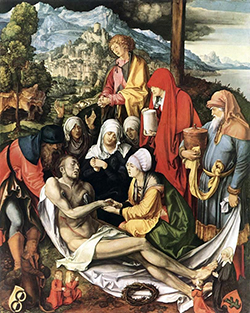 Painting by Albrecht Dürer:: Lamentation of Christ Lamentation of Christ (also known as Glimm Lamentation) is an oil-on-panel painting of the common subject of the Lamentation of Christ by the German Renaissance artist Albrecht Dürer, executed around 1500 and now in the Alte Pinakothek of Munich, Germany. The work was commissioned by goldsmith Jakob Glimm as a memorial of his first wife, Margaret Holzmann, who a died in 1500. The removal of later re-painting in 1924 showed the original figures of the donors (Glimm and his three sons) and of the dead woman, depicted in far smaller proportions than the religious characters.
Painting by Albrecht Dürer:: Lamentation of Christ Lamentation of Christ (also known as Glimm Lamentation) is an oil-on-panel painting of the common subject of the Lamentation of Christ by the German Renaissance artist Albrecht Dürer, executed around 1500 and now in the Alte Pinakothek of Munich, Germany. The work was commissioned by goldsmith Jakob Glimm as a memorial of his first wife, Margaret Holzmann, who a died in 1500. The removal of later re-painting in 1924 showed the original figures of the donors (Glimm and his three sons) and of the dead woman, depicted in far smaller proportions than the religious characters.
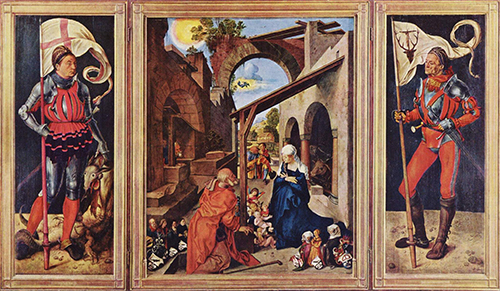 Painting by Albrecht Dürer: Paumgartner altarpiece,an early triptych painting by Albrecht Dürer, commissioned by the Paumgartner family of Nuremberg. The central panel depicts a nativity scene, while the wings depict Saint George (left) and Saint Eustace (right). The saint's faces are donor portraits of the brothers Stephan and Lukas Paumgartner, respectively. Other members of the Paumgartner family are depicted as small figures in the center panel. In 1616 the painting was bought by Maximilian I, Elector of Bavaria and taken to Munich. There it was altered to suit 17th century tastes. This entailed adding helmets, horses, and landscape backgrounds to the portraits of the saints and painting over the small donor figures in the center panel. These embellishments were removed by restorators in 1903. On 20 April 1988, the Paumgartner altarpiece was one of three paintings at the Alte Pinakothek that were attacked with concentrated sulfuric acid by the serial art vandal Hans-Joachim Bohlmann. It alone suffered at least $12 million worth of damage. After 21 years of restoration, it was returned to display in 2010.
Painting by Albrecht Dürer: Paumgartner altarpiece,an early triptych painting by Albrecht Dürer, commissioned by the Paumgartner family of Nuremberg. The central panel depicts a nativity scene, while the wings depict Saint George (left) and Saint Eustace (right). The saint's faces are donor portraits of the brothers Stephan and Lukas Paumgartner, respectively. Other members of the Paumgartner family are depicted as small figures in the center panel. In 1616 the painting was bought by Maximilian I, Elector of Bavaria and taken to Munich. There it was altered to suit 17th century tastes. This entailed adding helmets, horses, and landscape backgrounds to the portraits of the saints and painting over the small donor figures in the center panel. These embellishments were removed by restorators in 1903. On 20 April 1988, the Paumgartner altarpiece was one of three paintings at the Alte Pinakothek that were attacked with concentrated sulfuric acid by the serial art vandal Hans-Joachim Bohlmann. It alone suffered at least $12 million worth of damage. After 21 years of restoration, it was returned to display in 2010.
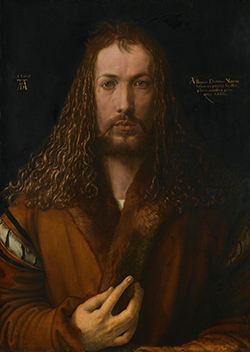 Painting by Albrecht Dürer: Self Portrait, a panel painting. Painted early in 1500, just before his 29th birthday, it is the last of his three painted self-portraits. Art historians consider it the most personal, iconic and complex of his self-portraits. The self-portrait is most remarkable because of its resemblance to many earlier representations of Christ. Art historians note the similarities with the conventions of religious painting, including its symmetry, dark tones and the manner in which the artist directly confronts the viewer and raises his hands to the middle of his chest as if in the act of blessing. Dürer's face has the inflexibility and impersonal dignity of a mask, hiding the restless turmoil of anguish and passion within. In its directness and apparent confrontation with the viewer, the self-portrait is unlike any that came before. It is half-length, frontal and highly symmetrical; its lack of a conventional background seemingly presents Dürer without regard to time or place. The placement of the inscriptions in the dark fields on either side of Dürer are presented as if floating in space, emphasizing that the portrait has a highly symbolic meaning. Its somber mood is achieved through the use of brown tones set against the plain black background. The lightness of touch and tone seen in his earlier two self-portraits has been replaced by a far more introverted and complex representation. In 1500, a frontal pose was exceptional for a secular portrait.
Painting by Albrecht Dürer: Self Portrait, a panel painting. Painted early in 1500, just before his 29th birthday, it is the last of his three painted self-portraits. Art historians consider it the most personal, iconic and complex of his self-portraits. The self-portrait is most remarkable because of its resemblance to many earlier representations of Christ. Art historians note the similarities with the conventions of religious painting, including its symmetry, dark tones and the manner in which the artist directly confronts the viewer and raises his hands to the middle of his chest as if in the act of blessing. Dürer's face has the inflexibility and impersonal dignity of a mask, hiding the restless turmoil of anguish and passion within. In its directness and apparent confrontation with the viewer, the self-portrait is unlike any that came before. It is half-length, frontal and highly symmetrical; its lack of a conventional background seemingly presents Dürer without regard to time or place. The placement of the inscriptions in the dark fields on either side of Dürer are presented as if floating in space, emphasizing that the portrait has a highly symbolic meaning. Its somber mood is achieved through the use of brown tones set against the plain black background. The lightness of touch and tone seen in his earlier two self-portraits has been replaced by a far more introverted and complex representation. In 1500, a frontal pose was exceptional for a secular portrait.
1500
(no entry for this year)
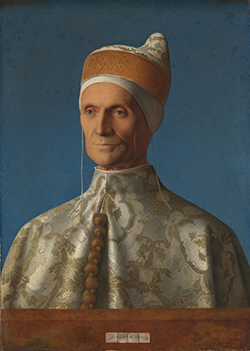 Painting by Giovanni Bellini: The Doge Leonardo Loredan portrays Leonardo Loredan, the Doge of Venice from 1501 to 1521, in his ceremonial garments with the corno ducale worn over a linen cap, and is signed IOANNES BELLINVS on a cartellino ("small paper"). It is on display in the National Gallery in London. The painting would initially have been in Venice and was probably looted when Napoleon conquered the city. It was bought in 1807 for thirteen guineas by William Thomas Beckford, who in 1844 sold it to the National Gallery for £630 (equivalent to £79,585 in 2023).
Painting by Giovanni Bellini: The Doge Leonardo Loredan portrays Leonardo Loredan, the Doge of Venice from 1501 to 1521, in his ceremonial garments with the corno ducale worn over a linen cap, and is signed IOANNES BELLINVS on a cartellino ("small paper"). It is on display in the National Gallery in London. The painting would initially have been in Venice and was probably looted when Napoleon conquered the city. It was bought in 1807 for thirteen guineas by William Thomas Beckford, who in 1844 sold it to the National Gallery for £630 (equivalent to £79,585 in 2023).
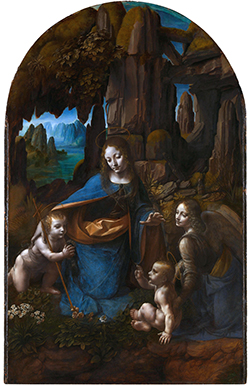 Painting by Leonardo da Vinci: The (London) Virgin of the Rocks, sometimes the Madonna of the Rocks, is the name of two paintings by the Italian Renaissance artist Leonardo da Vinci, of the same subject, with a composition which is identical except for several significant details. The version generally considered the prime version, the earlier of the two, is unrestored and hangs in the Louvre in Paris. The other, which was restored between 2008 and 2010, hangs in the National Gallery, London. The works are often known as the Louvre Virgin of the Rocks and London Virgin of the Rocks respectively. The paintings are both nearly 2 meters (over 6 feet) high and are painted in oils. Both were originally painted on wooden panels, but the Louvre version has been transferred to canvas. Both paintings show the Virgin Mary and child Jesus with the infant John the Baptist and an angel Uriel, in a rocky setting which gives the paintings their usual name. The significant compositional differences are in the gaze and right hand of the angel. There are many minor ways in which the works differ, including the colors, the lighting, the flora, and the way in which sfumato has been used. Although the date of an associated commission is documented, the complete histories of the two paintings are unknown, leading to speculation about which of the two is earlier. The London version is also ascribed to Leonardo da Vinci, and ascribed a date before 1508. Originally thought to have been partially painted by Leonardo's assistants, a close inspection of the painting during the recent restoration between 2008 and 2010 has led the conservators from the National Gallery to conclude that the greater part of the work is by the hand of Leonardo, but debate continues. Parts of the painting, the flowers in particular, indicate the collaboration and have led to speculation that the work is entirely by other hands, possibly Leonardo's assistant Giovanni Ambrogio de Predis and perhaps Evangelista.
Painting by Leonardo da Vinci: The (London) Virgin of the Rocks, sometimes the Madonna of the Rocks, is the name of two paintings by the Italian Renaissance artist Leonardo da Vinci, of the same subject, with a composition which is identical except for several significant details. The version generally considered the prime version, the earlier of the two, is unrestored and hangs in the Louvre in Paris. The other, which was restored between 2008 and 2010, hangs in the National Gallery, London. The works are often known as the Louvre Virgin of the Rocks and London Virgin of the Rocks respectively. The paintings are both nearly 2 meters (over 6 feet) high and are painted in oils. Both were originally painted on wooden panels, but the Louvre version has been transferred to canvas. Both paintings show the Virgin Mary and child Jesus with the infant John the Baptist and an angel Uriel, in a rocky setting which gives the paintings their usual name. The significant compositional differences are in the gaze and right hand of the angel. There are many minor ways in which the works differ, including the colors, the lighting, the flora, and the way in which sfumato has been used. Although the date of an associated commission is documented, the complete histories of the two paintings are unknown, leading to speculation about which of the two is earlier. The London version is also ascribed to Leonardo da Vinci, and ascribed a date before 1508. Originally thought to have been partially painted by Leonardo's assistants, a close inspection of the painting during the recent restoration between 2008 and 2010 has led the conservators from the National Gallery to conclude that the greater part of the work is by the hand of Leonardo, but debate continues. Parts of the painting, the flowers in particular, indicate the collaboration and have led to speculation that the work is entirely by other hands, possibly Leonardo's assistant Giovanni Ambrogio de Predis and perhaps Evangelista.
1501
African Slaves in the New World Spanish settlers bring slaves from Africa to Santo Domingo (now the capital of the Dominican Republic).
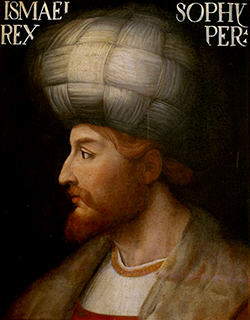 Ismail I, the founder and first shah of Safavid Iran, ruled from 1501 until his death in 1524. His reign is often considered the beginning of modern Iranian history, as well as one of the gunpowder empires. The rule of Ismail I is one of the most vital in the history of Iran. Before his accession in 1501, Iran, since its Islamic conquest eight-and-a-half centuries earlier, had not existed as a unified country under native Iranian rule. The dynasty founded by Ismail I would rule for over two centuries, being one of the greatest Iranian empires and at its height being amongst the most powerful empires of its time, ruling all of present-day Iran, the Republic of Azerbaijan, Armenia, most of Georgia, the North Caucasus, and Iraq, as well as parts of modern-day Turkey, Syria, Pakistan, Afghanistan, Uzbekistan, and Turkmenistan.
Ismail I, the founder and first shah of Safavid Iran, ruled from 1501 until his death in 1524. His reign is often considered the beginning of modern Iranian history, as well as one of the gunpowder empires. The rule of Ismail I is one of the most vital in the history of Iran. Before his accession in 1501, Iran, since its Islamic conquest eight-and-a-half centuries earlier, had not existed as a unified country under native Iranian rule. The dynasty founded by Ismail I would rule for over two centuries, being one of the greatest Iranian empires and at its height being amongst the most powerful empires of its time, ruling all of present-day Iran, the Republic of Azerbaijan, Armenia, most of Georgia, the North Caucasus, and Iraq, as well as parts of modern-day Turkey, Syria, Pakistan, Afghanistan, Uzbekistan, and Turkmenistan.
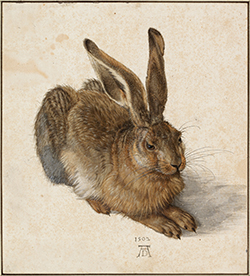 Painting by Albrecht Dürer: Young Hare (German: Feldhase), a 1502 watercolor and bodycolor painting. Painted in 1502 in his workshop, it is acknowledged as a masterpiece of observational art alongside his Great Piece of Turf from the following year. The subject is rendered with almost photographic accuracy, and although the piece is normally given the title Young Hare, the portrait is sufficiently detailed for the hare to be identified as a mature specimen — the German title translates as "Field Hare" and the work is often referred to in English as the Hare or Wild Hare. The subject was particularly challenging: the hare's fur lay in different directions and the animal was mottled with lighter and darker patches all over, Dürer had to adapt the standard conventions of shading to indicate the outline of the subject by the fall of light across the figure. Despite the technical challenges presented in rendering the appearance of light with a multi-colored, multi-textured subject, Dürer not only managed to create a detailed, almost scientific, study of the animal but also infuses the picture with a warm golden light that hits the hare from the left, highlighting the ears and the run of hair along the body, giving a spark of life to the eye, and casting a strange shadow to the right.
Painting by Albrecht Dürer: Young Hare (German: Feldhase), a 1502 watercolor and bodycolor painting. Painted in 1502 in his workshop, it is acknowledged as a masterpiece of observational art alongside his Great Piece of Turf from the following year. The subject is rendered with almost photographic accuracy, and although the piece is normally given the title Young Hare, the portrait is sufficiently detailed for the hare to be identified as a mature specimen — the German title translates as "Field Hare" and the work is often referred to in English as the Hare or Wild Hare. The subject was particularly challenging: the hare's fur lay in different directions and the animal was mottled with lighter and darker patches all over, Dürer had to adapt the standard conventions of shading to indicate the outline of the subject by the fall of light across the figure. Despite the technical challenges presented in rendering the appearance of light with a multi-colored, multi-textured subject, Dürer not only managed to create a detailed, almost scientific, study of the animal but also infuses the picture with a warm golden light that hits the hare from the left, highlighting the ears and the run of hair along the body, giving a spark of life to the eye, and casting a strange shadow to the right.
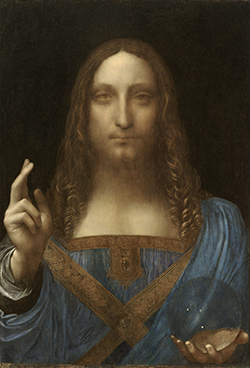 Painting by Leonardo da Vinci: Salvator Mundi, a painting attributed in whole or in part to the Italian High Renaissance artist Leonardo da Vinci, dated to c. 1499–1510. Long thought to be a copy of a lost original veiled with overpainting, it was rediscovered, restored, and included in an exhibition of Leonardo's work at the National Gallery, London, in 2011–2012. Christie's, which sold the work in 2017, stated that most leading scholars consider it an original work by Leonardo, but this attribution has been disputed by other leading specialists, some of whom propose that he only contributed certain elements; others believe that the extensive restoration prevents a definitive attribution. The painting depicts Jesus Christ in anachronistic blue Renaissance attire, making the sign of the cross with his right hand, while holding a transparent, non-refracting crystal orb in his left, signalling his role as Salvator Mundi and representing the 'celestial sphere' of the heavens. The painting was sold at auction for US$450.3 million on 15 November 2017 by Christie's in New York to Prince Badr bin Abdullah Al Saud, setting a new record for the most expensive painting ever sold at public auction.
Painting by Leonardo da Vinci: Salvator Mundi, a painting attributed in whole or in part to the Italian High Renaissance artist Leonardo da Vinci, dated to c. 1499–1510. Long thought to be a copy of a lost original veiled with overpainting, it was rediscovered, restored, and included in an exhibition of Leonardo's work at the National Gallery, London, in 2011–2012. Christie's, which sold the work in 2017, stated that most leading scholars consider it an original work by Leonardo, but this attribution has been disputed by other leading specialists, some of whom propose that he only contributed certain elements; others believe that the extensive restoration prevents a definitive attribution. The painting depicts Jesus Christ in anachronistic blue Renaissance attire, making the sign of the cross with his right hand, while holding a transparent, non-refracting crystal orb in his left, signalling his role as Salvator Mundi and representing the 'celestial sphere' of the heavens. The painting was sold at auction for US$450.3 million on 15 November 2017 by Christie's in New York to Prince Badr bin Abdullah Al Saud, setting a new record for the most expensive painting ever sold at public auction.
1502
(no entry for this year)
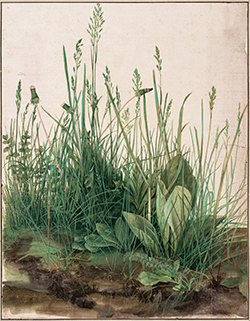 Painting by Albrecht Dürer: The Great Piece of Turf (German: Das grosse Rasenstück), a watercolor painting created at his Nuremberg workshop. It is a study of a seemingly unordered group of wild plants, including dandelion and greater plantain. The work is considered one of the masterpieces of Dürer's realistic nature studies. In 1495 Dürer returned from his Wanderjahre in Italy and settled in Nuremberg, where he opened a workshop. He was only twenty-four years old at the time, but the workshop soon gained a great reputation for the high quality of his work. In 1500 he produced what is perhaps his most famous work, his Christ-like Self-Portrait. At the same time he was also creating smaller-scale works that were more focused on the study of nature, such as the Great Piece of Turf, which he painted in 1503, and the Young Hare from the year before. Description The watercolor shows a large piece of turf and little else. The various plants can be identified as cock's-foot, creeping bent, smooth meadow-grass, daisy, dandelion, germander speedwell, greater plantain, hound's-tongue and yarrow. The painting shows a great level of realism in its portrayal of natural objects. Some of the roots have been stripped of earth to be displayed clearly to the spectator.
Painting by Albrecht Dürer: The Great Piece of Turf (German: Das grosse Rasenstück), a watercolor painting created at his Nuremberg workshop. It is a study of a seemingly unordered group of wild plants, including dandelion and greater plantain. The work is considered one of the masterpieces of Dürer's realistic nature studies. In 1495 Dürer returned from his Wanderjahre in Italy and settled in Nuremberg, where he opened a workshop. He was only twenty-four years old at the time, but the workshop soon gained a great reputation for the high quality of his work. In 1500 he produced what is perhaps his most famous work, his Christ-like Self-Portrait. At the same time he was also creating smaller-scale works that were more focused on the study of nature, such as the Great Piece of Turf, which he painted in 1503, and the Young Hare from the year before. Description The watercolor shows a large piece of turf and little else. The various plants can be identified as cock's-foot, creeping bent, smooth meadow-grass, daisy, dandelion, germander speedwell, greater plantain, hound's-tongue and yarrow. The painting shows a great level of realism in its portrayal of natural objects. Some of the roots have been stripped of earth to be displayed clearly to the spectator.
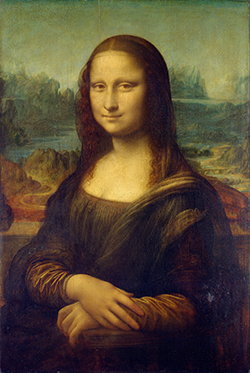 Painting by Leonardo a Vinci: The Mona Lisa. Considered an archetypal masterpiece of the Italian Renaissance, it has been described as "the best known, the most visited, the most written about, the most sung about, [and] the most parodied work of art in the world." The painting's novel qualities include the subject's enigmatic expression, monumentality of the composition, the subtle modelling of forms, and the atmospheric illusionism. The painting has been traditionally considered to depict the Italian noblewoman Lisa del Giocondo. It is painted in oil on a white poplar panel. Leonardo never gave the painting to the Giocondo family. It was believed to have been painted between 1503 and 1506; however, Leonardo may have continued working on it as late as 1517. King Francis I of France acquired the Mona Lisa after Leonardo's death in 1519, and it is now the property of the French Republic. It has normally been on display at the Louvre in Paris since 1797.
Painting by Leonardo a Vinci: The Mona Lisa. Considered an archetypal masterpiece of the Italian Renaissance, it has been described as "the best known, the most visited, the most written about, the most sung about, [and] the most parodied work of art in the world." The painting's novel qualities include the subject's enigmatic expression, monumentality of the composition, the subtle modelling of forms, and the atmospheric illusionism. The painting has been traditionally considered to depict the Italian noblewoman Lisa del Giocondo. It is painted in oil on a white poplar panel. Leonardo never gave the painting to the Giocondo family. It was believed to have been painted between 1503 and 1506; however, Leonardo may have continued working on it as late as 1517. King Francis I of France acquired the Mona Lisa after Leonardo's death in 1519, and it is now the property of the French Republic. It has normally been on display at the Louvre in Paris since 1797.
1503
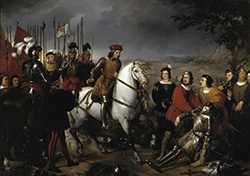 At the Battle of Cerignola Spanish forces defeat the French, considered the first battle in history won by gunpowder small arms.
At the Battle of Cerignola Spanish forces defeat the French, considered the first battle in history won by gunpowder small arms.
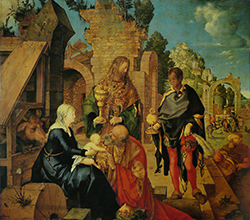 Painting by Albrecht Dürer: The Adoration of the Magi,a panel painting produced under commission by Frederick the Wise for the altar of the Schlosskirche in Wittenberg. It is considered one of Dürer's best and most important works from the period between his first and second trips to Italy (1494–1495 and 1505). The work is modest in size, just over a meter wide, however it is of great importance in Dürer's oeuvre and in the history of art. Before the production of this work, Dürer's achievements lay largely in his printmaking career, or with his self-portraiture. This work is especially crucial in its distinction of Dürer's difference as he combines a fine balance of northern and Italianate conventions in the work. Heinrich Wölfflin referred to the work as "the first completely lucid painting in the history of German art".
Painting by Albrecht Dürer: The Adoration of the Magi,a panel painting produced under commission by Frederick the Wise for the altar of the Schlosskirche in Wittenberg. It is considered one of Dürer's best and most important works from the period between his first and second trips to Italy (1494–1495 and 1505). The work is modest in size, just over a meter wide, however it is of great importance in Dürer's oeuvre and in the history of art. Before the production of this work, Dürer's achievements lay largely in his printmaking career, or with his self-portraiture. This work is especially crucial in its distinction of Dürer's difference as he combines a fine balance of northern and Italianate conventions in the work. Heinrich Wölfflin referred to the work as "the first completely lucid painting in the history of German art".
1504
(no entry for this year)
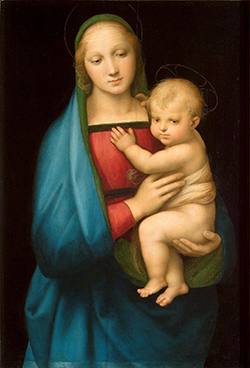 Painting by Raphael: Madonna del Granduca was probably painted in 1505, shortly after Raphael had arrived in Florence. The influence of Leonardo da Vinci, whose works he got to know there, can be seen in the use of sfumato. The painting belonged to Ferdinand III, Grand Duke of Tuscany, from whom it got its name.
Painting by Raphael: Madonna del Granduca was probably painted in 1505, shortly after Raphael had arrived in Florence. The influence of Leonardo da Vinci, whose works he got to know there, can be seen in the use of sfumato. The painting belonged to Ferdinand III, Grand Duke of Tuscany, from whom it got its name.
1505
(no entry for this year)
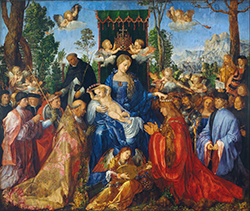 Painting by Albrecht Dürer: Feast of the Rosary, an oil painting by Albrecht Dürer, now in the National Gallery, Prague, Czech Republic. According to Czechoslovakian art historian Jaroslav Pesina, it is "probably the most superb painting that a German master has ever created." The work also relates to a series of artworks commissioned by Maximilian I, his Burgundian subjects or figures close to his family to commemorate the Duchess Mary of Burgundy, Maximilian's first wife and to provide the focus for a cult-like phenomenon that associated her with her name-saint, the Virgin Mary. The work was initially commissioned by Jakob Fugger, an intermediary between emperor Maximilian I and Pope Julius II, during the painter's stay as the banker's guest in Augsburg, though it was produced whilst the painter was in Venice.
Painting by Albrecht Dürer: Feast of the Rosary, an oil painting by Albrecht Dürer, now in the National Gallery, Prague, Czech Republic. According to Czechoslovakian art historian Jaroslav Pesina, it is "probably the most superb painting that a German master has ever created." The work also relates to a series of artworks commissioned by Maximilian I, his Burgundian subjects or figures close to his family to commemorate the Duchess Mary of Burgundy, Maximilian's first wife and to provide the focus for a cult-like phenomenon that associated her with her name-saint, the Virgin Mary. The work was initially commissioned by Jakob Fugger, an intermediary between emperor Maximilian I and Pope Julius II, during the painter's stay as the banker's guest in Augsburg, though it was produced whilst the painter was in Venice.
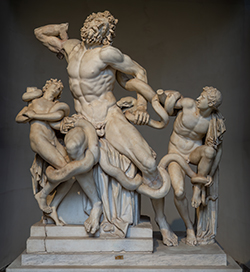 Ancient Sculpture: The Laocoön Group,a spectacular masterpiece of ancient art was discovered in a vineyard in Rome. This dramatic ancient marble shows the Trojan priest Laocoön and his sons being crushed to death by sea serpents. This work has been one of the most famous ancient sculptures since it was excavated in Rome in 1506 and put on public display in the Vatican Museums, where it remains today. The statue is very likely the same one that was praised in the highest terms by Pliny the Elder, the main Roman writer on art, who attributed it to Greek sculptors but did not say when it was created. The figures in the statue are nearly life-sized, with the entire group measuring just over 2 m (6 ft 7 in) in height. The sculpture depicts the Trojan priest Laocoön and his sons Antiphantes and Thymbraeus being attacked by sea serpents. The Laocoön Group has been called "the prototypical icon of human agony" in Western art. Unlike the agony often portrayed in Christian art depicting the Passion of Jesus and martyrs, the suffering shown in this statue offers no redemptive power or reward. The agony is conveyed through the contorted expressions on the faces, particularly Laocoön's bulging eyebrows, which were noted by Guillaume Duchenne de Boulogne as physiologically impossible. These expressions are mirrored in the struggling bodies, especially Laocoön's, with every part of his body shown straining. Pliny attributed the work, then in the palace of Emperor Titus, to three Greek sculptors from the island of Rhodes: Agesander, Athenodoros, and Polydorus, but he did not mention the date or patron. In style it is considered "one of the finest examples of the Hellenistic baroque" and certainly in the Greek tradition. However, its origin is uncertain, as it is not known if it is an original work or a copy of an earlier bronze sculpture.
Ancient Sculpture: The Laocoön Group,a spectacular masterpiece of ancient art was discovered in a vineyard in Rome. This dramatic ancient marble shows the Trojan priest Laocoön and his sons being crushed to death by sea serpents. This work has been one of the most famous ancient sculptures since it was excavated in Rome in 1506 and put on public display in the Vatican Museums, where it remains today. The statue is very likely the same one that was praised in the highest terms by Pliny the Elder, the main Roman writer on art, who attributed it to Greek sculptors but did not say when it was created. The figures in the statue are nearly life-sized, with the entire group measuring just over 2 m (6 ft 7 in) in height. The sculpture depicts the Trojan priest Laocoön and his sons Antiphantes and Thymbraeus being attacked by sea serpents. The Laocoön Group has been called "the prototypical icon of human agony" in Western art. Unlike the agony often portrayed in Christian art depicting the Passion of Jesus and martyrs, the suffering shown in this statue offers no redemptive power or reward. The agony is conveyed through the contorted expressions on the faces, particularly Laocoön's bulging eyebrows, which were noted by Guillaume Duchenne de Boulogne as physiologically impossible. These expressions are mirrored in the struggling bodies, especially Laocoön's, with every part of his body shown straining. Pliny attributed the work, then in the palace of Emperor Titus, to three Greek sculptors from the island of Rhodes: Agesander, Athenodoros, and Polydorus, but he did not mention the date or patron. In style it is considered "one of the finest examples of the Hellenistic baroque" and certainly in the Greek tradition. However, its origin is uncertain, as it is not known if it is an original work or a copy of an earlier bronze sculpture.
1506
(no entry for this year)
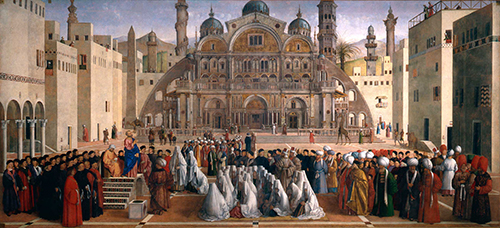 Painting by Gentile and Giovanni Bellini: St. Mark Preaching in Alexandria, an oil on canvas painting dated to 1504–1507, and held in the Pinacoteca di Brera, in Milan. The work is a huge canvas (3.47 m × 7.70 m (137 in × 303 in)) destined for the Scuola Grande di San Marco in Venice. It is 26 m2 in surface, and has rich narrative and iconographic features. The cycle of paintings with stories of the life of St Mark was completed around 60 years later by Giorgione and Tintoretto, and is today housed in the Pinacoteca di Brera and the Accademia in Venice. The scene is rich with exotic elements adapted from real-life that Gentile had the opportunity to study during his trip to Constantinople in 1479–1480. Decorative elements of Mamluk architecture, rather than Ottoman, suggest that the artist may also have reached Jerusalem. This painting combines two distinct moments in time, one ancient and one contemporary to Bellini's life, as well as three different places, Alexandria, Venice, and a mountainous landscape in the background.
Painting by Gentile and Giovanni Bellini: St. Mark Preaching in Alexandria, an oil on canvas painting dated to 1504–1507, and held in the Pinacoteca di Brera, in Milan. The work is a huge canvas (3.47 m × 7.70 m (137 in × 303 in)) destined for the Scuola Grande di San Marco in Venice. It is 26 m2 in surface, and has rich narrative and iconographic features. The cycle of paintings with stories of the life of St Mark was completed around 60 years later by Giorgione and Tintoretto, and is today housed in the Pinacoteca di Brera and the Accademia in Venice. The scene is rich with exotic elements adapted from real-life that Gentile had the opportunity to study during his trip to Constantinople in 1479–1480. Decorative elements of Mamluk architecture, rather than Ottoman, suggest that the artist may also have reached Jerusalem. This painting combines two distinct moments in time, one ancient and one contemporary to Bellini's life, as well as three different places, Alexandria, Venice, and a mountainous landscape in the background.
1507
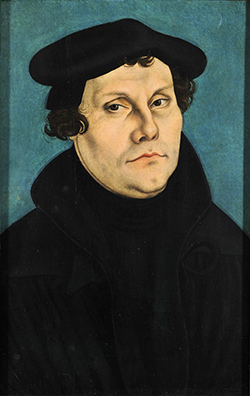 Martin Luther ordained to the priesthood. Luther was the seminal figure of the Protestant Reformation. He is widely regarded as one of the most influential figures in Western and Christian history. He came to reject several teachings and practices of the Roman Catholic Church; in particular, he disputed the view on indulgences. Luther attempted to resolve these differences amicably, first proposing an academic discussion of the practice and efficacy of indulgences in Ninety-five Theses, which he authored in 1517. In 1520, Pope Leo X demanded that Luther renounce all of his writings, and when Luther refused to do so, excommunicated him in January 1521. Later that year, Holy Roman Emperor Charles V condemned Luther as an outlaw at the Diet of Worms. When Luther died in 1546, Pope Leo X's excommunication was still in effect. Luther taught that salvation and, consequently, eternal life are not earned by good deeds; rather, they are received only as the free gift of God's grace through the believer's faith in Jesus Christ, who is the sole redeemer from sin. Luther's theology challenged the authority and office of the pope by teaching that the Bible is the only source of divinely revealed knowledge, and opposed sacerdotalism by considering all baptized Christians to be a holy priesthood. Attempts by the Catholic Church to suppress the new protestant movement led to more than 200 years of wars — the European wars of religion.
Martin Luther ordained to the priesthood. Luther was the seminal figure of the Protestant Reformation. He is widely regarded as one of the most influential figures in Western and Christian history. He came to reject several teachings and practices of the Roman Catholic Church; in particular, he disputed the view on indulgences. Luther attempted to resolve these differences amicably, first proposing an academic discussion of the practice and efficacy of indulgences in Ninety-five Theses, which he authored in 1517. In 1520, Pope Leo X demanded that Luther renounce all of his writings, and when Luther refused to do so, excommunicated him in January 1521. Later that year, Holy Roman Emperor Charles V condemned Luther as an outlaw at the Diet of Worms. When Luther died in 1546, Pope Leo X's excommunication was still in effect. Luther taught that salvation and, consequently, eternal life are not earned by good deeds; rather, they are received only as the free gift of God's grace through the believer's faith in Jesus Christ, who is the sole redeemer from sin. Luther's theology challenged the authority and office of the pope by teaching that the Bible is the only source of divinely revealed knowledge, and opposed sacerdotalism by considering all baptized Christians to be a holy priesthood. Attempts by the Catholic Church to suppress the new protestant movement led to more than 200 years of wars — the European wars of religion.
(no entry for this year)
1508
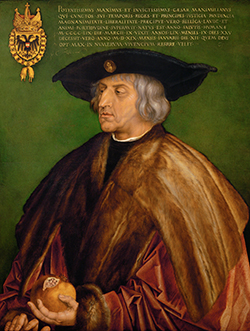 Maximilian I becomes Holy Roman Emperor, a role he held until his death in 1519. He was never crowned by the Pope, as the journey to Rome was blocked by the Venetians. He proclaimed himself elected emperor in 1508 (Pope Julius II later recognized this) at Trent, thus breaking the long tradition of requiring a papal coronation for the adoption of the Imperial title. Maximilian was the only surviving son of Frederick III, Holy Roman Emperor, and Eleanor of Portugal. Since his coronation as King of the Romans in 1486, he ran a double government, or Doppelregierung (with a separate court), with his father until Frederick's death in 1493. Maximilian expanded the influence of the House of Habsburg through war and his marriage in 1477 to Mary of Burgundy, the ruler of the Burgundian State, heiress of Charles the Bold, though he also lost his family's original lands in today's Switzerland to the Swiss Confederacy. Through the marriage of his son Philip the Handsome to eventual queen Joanna of Castile in 1496, Maximilian helped to establish the Habsburg dynasty in Spain, which allowed his grandson Charles to hold the thrones of both Castile and Aragon.
Maximilian I becomes Holy Roman Emperor, a role he held until his death in 1519. He was never crowned by the Pope, as the journey to Rome was blocked by the Venetians. He proclaimed himself elected emperor in 1508 (Pope Julius II later recognized this) at Trent, thus breaking the long tradition of requiring a papal coronation for the adoption of the Imperial title. Maximilian was the only surviving son of Frederick III, Holy Roman Emperor, and Eleanor of Portugal. Since his coronation as King of the Romans in 1486, he ran a double government, or Doppelregierung (with a separate court), with his father until Frederick's death in 1493. Maximilian expanded the influence of the House of Habsburg through war and his marriage in 1477 to Mary of Burgundy, the ruler of the Burgundian State, heiress of Charles the Bold, though he also lost his family's original lands in today's Switzerland to the Swiss Confederacy. Through the marriage of his son Philip the Handsome to eventual queen Joanna of Castile in 1496, Maximilian helped to establish the Habsburg dynasty in Spain, which allowed his grandson Charles to hold the thrones of both Castile and Aragon.
(no entry for this year)
1509
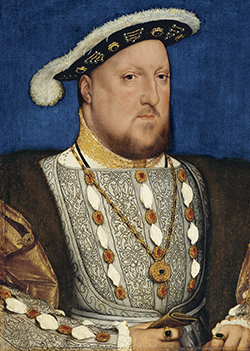 Henry VIII becomes King of England. Henry is known for his six marriages and his efforts to have his first marriage (to Catherine of Aragon) annulled. His disagreement with Pope Clement VII about such an annulment led Henry to initiate the English Reformation, separating the Church of England from papal authority. He appointed himself Supreme Head of the Church of England and dissolved convents and monasteries, for which he was excommunicated by the pope. Henry brought radical changes to the Constitution of England, expanding royal power and ushering in the theory of the divine right of kings in opposition to papal supremacy. He frequently used charges of treason and heresy to quell dissent, and those accused were often executed without a formal trial using bills of attainder. He achieved many of his political aims through his chief ministers, some of whom were banished or executed when they fell out of his favor. Thomas Wolsey, Thomas More, Thomas Cromwell, and Thomas Cranmer all figured prominently in his administration.
Henry VIII becomes King of England. Henry is known for his six marriages and his efforts to have his first marriage (to Catherine of Aragon) annulled. His disagreement with Pope Clement VII about such an annulment led Henry to initiate the English Reformation, separating the Church of England from papal authority. He appointed himself Supreme Head of the Church of England and dissolved convents and monasteries, for which he was excommunicated by the pope. Henry brought radical changes to the Constitution of England, expanding royal power and ushering in the theory of the divine right of kings in opposition to papal supremacy. He frequently used charges of treason and heresy to quell dissent, and those accused were often executed without a formal trial using bills of attainder. He achieved many of his political aims through his chief ministers, some of whom were banished or executed when they fell out of his favor. Thomas Wolsey, Thomas More, Thomas Cromwell, and Thomas Cranmer all figured prominently in his administration.
 Chalk Drawing by Leonardo da Vinci: The portrait of a man in red chalk in the Royal Library of Turin is widely, though not universally, accepted as a self-portrait of Leonardo da Vinci. It is thought that Leonardo da Vinci drew this self-portrait at about the age of 60. The portrait has been extensively reproduced and has become an iconic representation of Leonardo as a polymath or "Renaissance Man". Despite this, some historians and scholars disagree as to the true identity of the sitter. The portrait is drawn in red chalk on paper. It depicts the head of an elderly man in three-quarter view, his face turned towards the viewer. The subject is distinguished by his long hair and long waving beard which flow over the shoulders and chest. The length of the hair and beard is uncommon in Renaissance portraits and suggests, as now, a person of sagacity.
Chalk Drawing by Leonardo da Vinci: The portrait of a man in red chalk in the Royal Library of Turin is widely, though not universally, accepted as a self-portrait of Leonardo da Vinci. It is thought that Leonardo da Vinci drew this self-portrait at about the age of 60. The portrait has been extensively reproduced and has become an iconic representation of Leonardo as a polymath or "Renaissance Man". Despite this, some historians and scholars disagree as to the true identity of the sitter. The portrait is drawn in red chalk on paper. It depicts the head of an elderly man in three-quarter view, his face turned towards the viewer. The subject is distinguished by his long hair and long waving beard which flow over the shoulders and chest. The length of the hair and beard is uncommon in Renaissance portraits and suggests, as now, a person of sagacity.
1510
(no entry for this year)
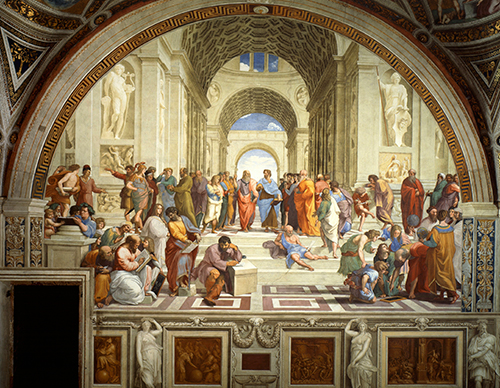 Painting by Raphael: The School of Athens, a fresco by the Italian Renaissance artist Raphael. It was painted between 1509 and 1511 as part of a commission by Pope Julius II to decorate the rooms now called the Stanze di Raffaello in the Apostolic Palace in Vatican City. The fresco depicts a congregation of ancient philosophers, mathematicians, and scientists, with Plato and Aristotle featured in the center. The identities of most figures are ambiguous or discernable only through subtle details or allusions; among those commonly identified are Socrates, Pythagoras, Archimedes, Heraclitus, Averroes, and Zarathustra. Additionally, Italian artists Leonardo da Vinci and Michelangelo are believed to be portrayed through Plato and Heraclitus, respectively. Raphael included a self-portrait beside Ptolemy. Raphael is the only character who is looking directly at the viewer in the artwork. The painting is notable for its use of accurate perspective projection, a defining characteristic of Renaissance art, which Raphael learned from Leonardo; likewise, the themes of the painting, such as the rebirth of Ancient Greek philosophy and culture in Europe were inspired by Leonardo's individual pursuits in theatre, engineering, optics, geometry, physiology, anatomy, history, architecture and art. The School of Athens is regarded as one of Raphael's best-known works and has been described as his "masterpiece and the perfect embodiment of the classical spirit of the Renaissance".
Painting by Raphael: The School of Athens, a fresco by the Italian Renaissance artist Raphael. It was painted between 1509 and 1511 as part of a commission by Pope Julius II to decorate the rooms now called the Stanze di Raffaello in the Apostolic Palace in Vatican City. The fresco depicts a congregation of ancient philosophers, mathematicians, and scientists, with Plato and Aristotle featured in the center. The identities of most figures are ambiguous or discernable only through subtle details or allusions; among those commonly identified are Socrates, Pythagoras, Archimedes, Heraclitus, Averroes, and Zarathustra. Additionally, Italian artists Leonardo da Vinci and Michelangelo are believed to be portrayed through Plato and Heraclitus, respectively. Raphael included a self-portrait beside Ptolemy. Raphael is the only character who is looking directly at the viewer in the artwork. The painting is notable for its use of accurate perspective projection, a defining characteristic of Renaissance art, which Raphael learned from Leonardo; likewise, the themes of the painting, such as the rebirth of Ancient Greek philosophy and culture in Europe were inspired by Leonardo's individual pursuits in theatre, engineering, optics, geometry, physiology, anatomy, history, architecture and art. The School of Athens is regarded as one of Raphael's best-known works and has been described as his "masterpiece and the perfect embodiment of the classical spirit of the Renaissance".
1511
(no entry for this year)
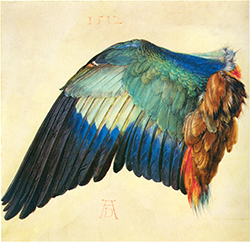 Painting by Albrecht Dürer: Wing of a European Roller, a nature-study watercolor painted from a dead specimen.
Painting by Albrecht Dürer: Wing of a European Roller, a nature-study watercolor painted from a dead specimen.
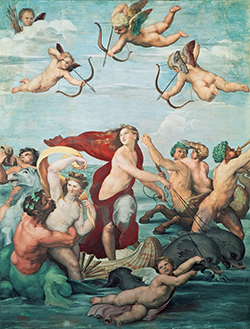 Painting by Raphael: The Triumph of Galatea, a fresco painted for the wealthy banker Agostino Chigi's Villa Farnensina
Painting by Raphael: The Triumph of Galatea, a fresco painted for the wealthy banker Agostino Chigi's Villa Farnensina
1512
(no entry for this year)
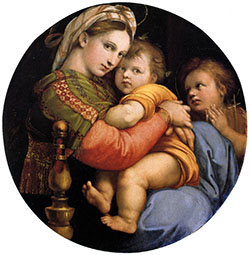 Painting by Raphael: Madonna della Seggiola, an oil on panel Madonna painting executed c. 1513–1514, and housed at the Palazzo Pitti Collection in Florence, Italy. Although there is documentation on its arrival to its current location, Palazzo Pitti, it is still unknown who commissioned the painting; however, it has been in the Medici family since the 16th century. It depicts Mary embracing the Christ child while sitting in a chair as the young John the Baptist devoutly watches. The Madonna della Sedia is one of the single most important of Raphael's Madonnas. The painting also showcases Raphael's use of the tondo form and his naturalistic approach to depicting the Madonna. The Madonna della Sedia is Raphael's most humanistic form of the Madonna. Throughout Raphael's life, this humanistic representation of the Madonna occupied his mind. The Madonna della Sedia is the incarnation of a realistic mother and child, representing human motherhood. Painted during his Roman period, this Madonna does not have the strict geometrical form and linear style of his earlier Florentine treatments of the same subject. The Madonna is portrayed subtly and naturalistically, including the drapery, her anatomy, and the movement of her body, as if it was a result of an immediate action.
Painting by Raphael: Madonna della Seggiola, an oil on panel Madonna painting executed c. 1513–1514, and housed at the Palazzo Pitti Collection in Florence, Italy. Although there is documentation on its arrival to its current location, Palazzo Pitti, it is still unknown who commissioned the painting; however, it has been in the Medici family since the 16th century. It depicts Mary embracing the Christ child while sitting in a chair as the young John the Baptist devoutly watches. The Madonna della Sedia is one of the single most important of Raphael's Madonnas. The painting also showcases Raphael's use of the tondo form and his naturalistic approach to depicting the Madonna. The Madonna della Sedia is Raphael's most humanistic form of the Madonna. Throughout Raphael's life, this humanistic representation of the Madonna occupied his mind. The Madonna della Sedia is the incarnation of a realistic mother and child, representing human motherhood. Painted during his Roman period, this Madonna does not have the strict geometrical form and linear style of his earlier Florentine treatments of the same subject. The Madonna is portrayed subtly and naturalistically, including the drapery, her anatomy, and the movement of her body, as if it was a result of an immediate action.
1513
(no entry for this year)
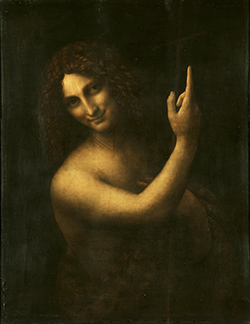 Painting by Leonardo da Vinci: Saint John the Baptist, an oil painting on walnut wood. Likely to have been completed between 1513 and 1516, it is believed to be his final painting. Its original size was 69 by 57 centimetres (27 in × 22 in). The painting is in the collection of the Louvre. In November 2022, it was loaned to Louvre Abu Dhabi for two years as part of the museum's fifth anniversary. The work depicts the figure of John the Baptist in isolation through the use of chiaroscuro, with the figure appearing to emerge from the shadowy background. The saint is dressed in furs, has long curly hair and is smiling in an enigmatic manner reminiscent of Leonardo's famous Mona Lisa. He holds a reed cross in his left hand, while his right hand points up toward heaven, similar to the figure of Saint Anne in Leonardo's Burlington House Cartoon. According to Frank Zöllner, Leonardo's use of sfumato "conveys the religious content of the picture", with the "gentle shadows [imbuing] the subject's skin tones with a very soft, delicate appearance, almost androgynous in its effect".
Painting by Leonardo da Vinci: Saint John the Baptist, an oil painting on walnut wood. Likely to have been completed between 1513 and 1516, it is believed to be his final painting. Its original size was 69 by 57 centimetres (27 in × 22 in). The painting is in the collection of the Louvre. In November 2022, it was loaned to Louvre Abu Dhabi for two years as part of the museum's fifth anniversary. The work depicts the figure of John the Baptist in isolation through the use of chiaroscuro, with the figure appearing to emerge from the shadowy background. The saint is dressed in furs, has long curly hair and is smiling in an enigmatic manner reminiscent of Leonardo's famous Mona Lisa. He holds a reed cross in his left hand, while his right hand points up toward heaven, similar to the figure of Saint Anne in Leonardo's Burlington House Cartoon. According to Frank Zöllner, Leonardo's use of sfumato "conveys the religious content of the picture", with the "gentle shadows [imbuing] the subject's skin tones with a very soft, delicate appearance, almost androgynous in its effect".
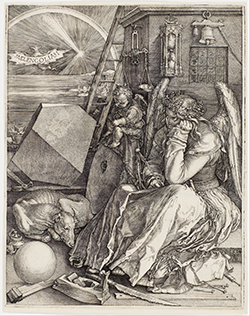 Engraving by Albrecht Dürer: Melancolia I a large 1514 engraving. Its central subject is an enigmatic and gloomy winged female figure thought to be a personification of melancholia — melancholy. Holding her head in her hand, she stares past the busy scene in front of her. The area is strewn with symbols and tools associated with craft and carpentry, including an hourglass, weighing scales, a hand plane, a claw hammer, and a saw. Other objects relate to alchemy, geometry or numerology. Behind the figure is a structure with an embedded magic square, and a ladder leading beyond the frame. The sky contains a rainbow, a comet or planet, and a bat-like creature bearing the text that has become the print's title. Dürer's engraving is one of the most well-known extant old master prints, but, despite a vast art-historical literature, it has resisted any definitive interpretation. Dürer may have associated melancholia with creative activity; the woman may be a representation of a Muse, awaiting inspiration but fearful that it will not return. As such, Dürer may have intended the print as a veiled self-portrait. Other art historians see the figure as pondering the nature of beauty or the value of artistic creativity in light of rationalism, or as a purposely obscure work that highlights the limitations of allegorical or symbolic art.
Engraving by Albrecht Dürer: Melancolia I a large 1514 engraving. Its central subject is an enigmatic and gloomy winged female figure thought to be a personification of melancholia — melancholy. Holding her head in her hand, she stares past the busy scene in front of her. The area is strewn with symbols and tools associated with craft and carpentry, including an hourglass, weighing scales, a hand plane, a claw hammer, and a saw. Other objects relate to alchemy, geometry or numerology. Behind the figure is a structure with an embedded magic square, and a ladder leading beyond the frame. The sky contains a rainbow, a comet or planet, and a bat-like creature bearing the text that has become the print's title. Dürer's engraving is one of the most well-known extant old master prints, but, despite a vast art-historical literature, it has resisted any definitive interpretation. Dürer may have associated melancholia with creative activity; the woman may be a representation of a Muse, awaiting inspiration but fearful that it will not return. As such, Dürer may have intended the print as a veiled self-portrait. Other art historians see the figure as pondering the nature of beauty or the value of artistic creativity in light of rationalism, or as a purposely obscure work that highlights the limitations of allegorical or symbolic art.
1514
Raphael's friend, courtier Giovanbattista Branconio dell'Aquila, becomes the personal keeper of Hanno, the white elephant brought to Rome in 1514, as a gift by King Manuel I of Portugal to Pope Leo X (born Giovanni de' Medici) at his coronation.
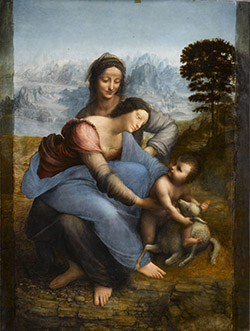 Painting by Leonardo da Vinci: The Virgin and Child with Saint Anne, an unfinished oil painting, dated to c. 1501–1519. It depicts Saint Anne, her daughter the Virgin Mary and the infant Jesus. Christ is shown grappling with a sacrificial lamb symbolizing his Passion as the Virgin tries to restrain him. The painting was commissioned as the high altarpiece for the Church of Santissima Annunziata in Florence and its theme had long preoccupied Leonardo. Leonardo's painting is at once both pleasing, calm yet confusing upon closer examination. The composition of the three figures is fairly tight, with the Virgin Mary clearly interacting with the infant Jesus. Upon closer examination of their positioning it is apparent that Mary is sitting on Saint Anne's lap. It is unclear what meaning this could have and what meaning Leonardo intended to project with that pose. There is no clear parallel in other works of art and women sitting in each other's lap are not a clear cultural or traditional reference that the viewer can relate to.
Painting by Leonardo da Vinci: The Virgin and Child with Saint Anne, an unfinished oil painting, dated to c. 1501–1519. It depicts Saint Anne, her daughter the Virgin Mary and the infant Jesus. Christ is shown grappling with a sacrificial lamb symbolizing his Passion as the Virgin tries to restrain him. The painting was commissioned as the high altarpiece for the Church of Santissima Annunziata in Florence and its theme had long preoccupied Leonardo. Leonardo's painting is at once both pleasing, calm yet confusing upon closer examination. The composition of the three figures is fairly tight, with the Virgin Mary clearly interacting with the infant Jesus. Upon closer examination of their positioning it is apparent that Mary is sitting on Saint Anne's lap. It is unclear what meaning this could have and what meaning Leonardo intended to project with that pose. There is no clear parallel in other works of art and women sitting in each other's lap are not a clear cultural or traditional reference that the viewer can relate to.
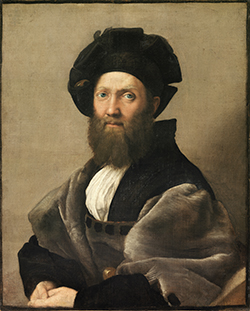 Painting by Raphael: Portrait of Baldassare Castiglione, Count of Casatico, an Italian courtier, diplomat, soldier and a prominent Renaissance author. Castiglione wrote Il Cortegiano or The Book of the Courtier, a courtesy book dealing with questions of the etiquette and morality of the courtier. It was very influential in 16th-century European court circles.
Painting by Raphael: Portrait of Baldassare Castiglione, Count of Casatico, an Italian courtier, diplomat, soldier and a prominent Renaissance author. Castiglione wrote Il Cortegiano or The Book of the Courtier, a courtesy book dealing with questions of the etiquette and morality of the courtier. It was very influential in 16th-century European court circles.
1515
(no entry for this year)
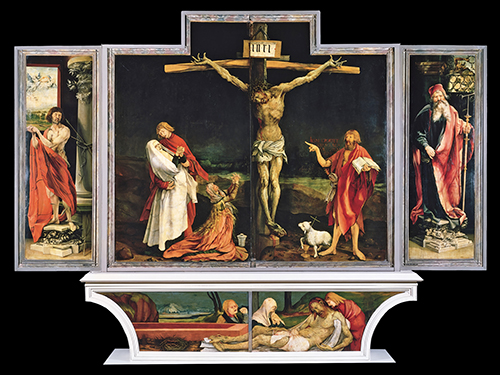 Alterpiece sculpted and painted by, respectively, the Germans Nikolaus of Haguenau and Matthias Grünewald: Isenheim Alterpiece painted for the Monastery of St. Anthony in Issenheim near Colmar, which specialized in hospital work. The Antonine monks of the monastery were noted for their care of plague sufferers as well as for their treatment of skin diseases, such as ergotism. The image of the crucified Christ is pitted with plague-type sores, showing patients that Jesus understood and shared their afflictions. The veracity of the work's depictions of medical conditions was unusual in the history of European art.
Alterpiece sculpted and painted by, respectively, the Germans Nikolaus of Haguenau and Matthias Grünewald: Isenheim Alterpiece painted for the Monastery of St. Anthony in Issenheim near Colmar, which specialized in hospital work. The Antonine monks of the monastery were noted for their care of plague sufferers as well as for their treatment of skin diseases, such as ergotism. The image of the crucified Christ is pitted with plague-type sores, showing patients that Jesus understood and shared their afflictions. The veracity of the work's depictions of medical conditions was unusual in the history of European art.
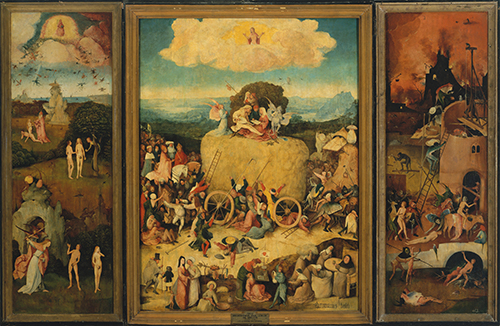 Painting by Hieronymus Bosch: The Haywain Triptych, a panel painting by the Early Netherlandish painter Hieronymus Bosch, now in the Museo del Prado, Madrid, Spain. A date of around 1516 has been established by means of dendrochronological research. The central panel, signed "Jheronimus Bosch", measures 135 cm × 200 cm (53 in × 79 in) and the wings measure 147 cm × 66 cm (58 in × 26 in). The outside shutters feature a version of Bosch's The Wayfarer. The painting was part of a group of six acquired by King Philip II of Spain in 1570, and shipped to El Escorial four years later. It was later sold to the Marquis of Salamanca, and divided into three paintings. In 1848, the central panel was bought by Isabella II of Spain and brought to Aranjuez, the right one was returned to Escorial and the left went to the Prado. The triptych was finally recomposed in 1914 in the latter museum.
Painting by Hieronymus Bosch: The Haywain Triptych, a panel painting by the Early Netherlandish painter Hieronymus Bosch, now in the Museo del Prado, Madrid, Spain. A date of around 1516 has been established by means of dendrochronological research. The central panel, signed "Jheronimus Bosch", measures 135 cm × 200 cm (53 in × 79 in) and the wings measure 147 cm × 66 cm (58 in × 26 in). The outside shutters feature a version of Bosch's The Wayfarer. The painting was part of a group of six acquired by King Philip II of Spain in 1570, and shipped to El Escorial four years later. It was later sold to the Marquis of Salamanca, and divided into three paintings. In 1848, the central panel was bought by Isabella II of Spain and brought to Aranjuez, the right one was returned to Escorial and the left went to the Prado. The triptych was finally recomposed in 1914 in the latter museum.
1516
(no entry for this year)
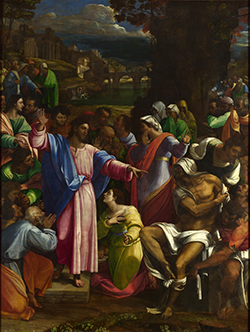 Painting by Sebastiano del Piombo: The Raising of Lazarus, a large altarpiece of 1517–1519 by the Italian High Renaissance artist Sebastiano del Piombo, for which Michelangelo supplied drawings for some figures. Intended for Narbonne Cathedral in France, it is now normally in Room 18 of the National Gallery in London, where it is "NG1", the first painting catalogued at the founding of the gallery in 1824. It was commissioned by Cardinal Giulio de' Medici, then Archbishop of Narbonne and later Pope Clement VII (r. 1523–24), in what was effectively a contest engineered by Michelangelo, using Sebastiano as "a kind of deputy", or "cat's paw", in a rivalry between the two and Raphael, whose Transfiguration (now in the Vatican Pinacoteca) is the same size of 381 cm × 299 cm (150 in × 118 in) and was commissioned for the same cathedral.
Painting by Sebastiano del Piombo: The Raising of Lazarus, a large altarpiece of 1517–1519 by the Italian High Renaissance artist Sebastiano del Piombo, for which Michelangelo supplied drawings for some figures. Intended for Narbonne Cathedral in France, it is now normally in Room 18 of the National Gallery in London, where it is "NG1", the first painting catalogued at the founding of the gallery in 1824. It was commissioned by Cardinal Giulio de' Medici, then Archbishop of Narbonne and later Pope Clement VII (r. 1523–24), in what was effectively a contest engineered by Michelangelo, using Sebastiano as "a kind of deputy", or "cat's paw", in a rivalry between the two and Raphael, whose Transfiguration (now in the Vatican Pinacoteca) is the same size of 381 cm × 299 cm (150 in × 118 in) and was commissioned for the same cathedral.
1517
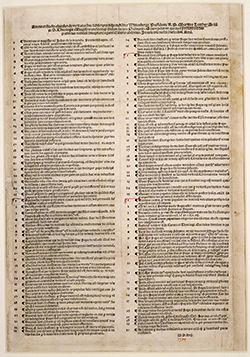 Martin Luther publishes his Ninety-five Theses or Disputation on the Power and Efficacy of Indulgences, a list of propositions for an academic disputation. This work is retrospectively considered to have launched the Protestant Reformation and the birth of Protestantism, despite various proto-Protestant groups having existed previously. It detailed Luther's opposition to what he saw as the Roman Catholic Church's abuse and corruption by Catholic clergy, who were selling plenary indulgences, which were certificates supposed to reduce the temporal punishment in purgatory for sins committed by the purchasers or their loved ones.
Martin Luther publishes his Ninety-five Theses or Disputation on the Power and Efficacy of Indulgences, a list of propositions for an academic disputation. This work is retrospectively considered to have launched the Protestant Reformation and the birth of Protestantism, despite various proto-Protestant groups having existed previously. It detailed Luther's opposition to what he saw as the Roman Catholic Church's abuse and corruption by Catholic clergy, who were selling plenary indulgences, which were certificates supposed to reduce the temporal punishment in purgatory for sins committed by the purchasers or their loved ones.
Ottoman Turks defeat the Mamluks of Egypt and take control of Egypt and the Arabian Peninsula.
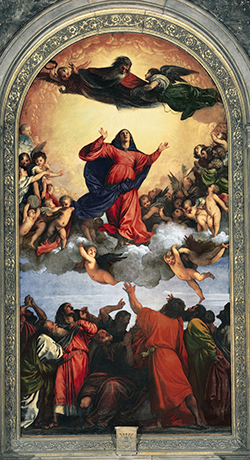 Painting by Titian: The Assumption of the Virgin or Frari Assumption, popularly known as the Assunta, is completed. It remains in the position it was designed for, on the high altar of the Basilica di Santa Maria Gloriosa dei Frari or Frari church in Venice. It is the largest altarpiece in the city, with the figures well over life-size, necessitated by the large church, with a considerable distance between the altar and the congregation. It marked a new direction in Titian's style, that reflected his awareness of the developments in High Renaissance painting further south, in Florence and Rome, by artists including Raphael and Michelangelo. The agitated figures of the Apostles marked a break with the usual meditative stillness of saints in Venetian painting, in the tradition of Giovanni Bellini and others. It was perhaps originally rather shocking for the Venetian public, but soon recognised as a masterpiece that confirmed Titian's position as the leading artist in Venice, and one of the most important in all Italy, a rival to Michelangelo and Raphael.
Painting by Titian: The Assumption of the Virgin or Frari Assumption, popularly known as the Assunta, is completed. It remains in the position it was designed for, on the high altar of the Basilica di Santa Maria Gloriosa dei Frari or Frari church in Venice. It is the largest altarpiece in the city, with the figures well over life-size, necessitated by the large church, with a considerable distance between the altar and the congregation. It marked a new direction in Titian's style, that reflected his awareness of the developments in High Renaissance painting further south, in Florence and Rome, by artists including Raphael and Michelangelo. The agitated figures of the Apostles marked a break with the usual meditative stillness of saints in Venetian painting, in the tradition of Giovanni Bellini and others. It was perhaps originally rather shocking for the Venetian public, but soon recognised as a masterpiece that confirmed Titian's position as the leading artist in Venice, and one of the most important in all Italy, a rival to Michelangelo and Raphael.
1518
(no entry for this year)
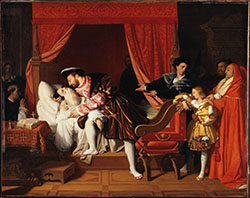 Leonardo da Vinci dies in Amboise, France, an event represented in (an 1818) painting by the French artist Jean-Auguste-Dominique Ingres, showing the Italian artist and inventor Leonardo da Vinci dying, with Francis I of France holding his head. It was commissioned by Pierre Louis Jean Casimir de Blacas, the French ambassador in Rome, and is now in the Petit Palais in Paris.
Leonardo da Vinci dies in Amboise, France, an event represented in (an 1818) painting by the French artist Jean-Auguste-Dominique Ingres, showing the Italian artist and inventor Leonardo da Vinci dying, with Francis I of France holding his head. It was commissioned by Pierre Louis Jean Casimir de Blacas, the French ambassador in Rome, and is now in the Petit Palais in Paris.
1519
Horses are brought to the New World by Hernán Cortéz.
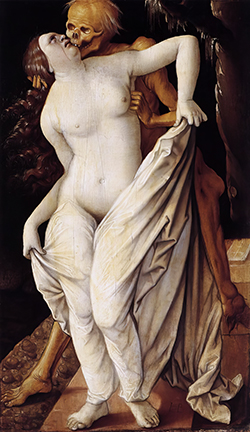 Painting by Hans Baldung Grien: Death and the Maiden. Baldung may have been a pupil of Dürer. His paintings and prints included a variety of subjects, but he is best known for macabre, erotic allegories involving witches or young women being embraced by death. The inevitability of death was a favorite theme among many North Renaissance artists.
Painting by Hans Baldung Grien: Death and the Maiden. Baldung may have been a pupil of Dürer. His paintings and prints included a variety of subjects, but he is best known for macabre, erotic allegories involving witches or young women being embraced by death. The inevitability of death was a favorite theme among many North Renaissance artists.
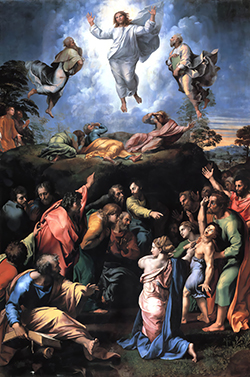 Painting by Raphael: The Transfiguration is the last painting by the Italian High Renaissance master Raphael. Cardinal Giulio de Medici — who later became Pope Clement VII (in office: 1523–1534) — commissioned the work, conceived as an altarpiece for Narbonne Cathedral in France; Raphael worked on it in the years preceding his death in 1520. The painting exemplifies Raphael's development as an artist and the culmination of his career. Unusually for a depiction of the Transfiguration of Jesus in Christian art, the subject is combined with the next episode from the Gospels (the healing of a possessed boy) in the lower part of the painting. The work is now in the Pinacoteca Vaticana in the Vatican City. From the late 16th century until the early 20th century, various commentators regarded it as the most famous oil painting in the world.
Painting by Raphael: The Transfiguration is the last painting by the Italian High Renaissance master Raphael. Cardinal Giulio de Medici — who later became Pope Clement VII (in office: 1523–1534) — commissioned the work, conceived as an altarpiece for Narbonne Cathedral in France; Raphael worked on it in the years preceding his death in 1520. The painting exemplifies Raphael's development as an artist and the culmination of his career. Unusually for a depiction of the Transfiguration of Jesus in Christian art, the subject is combined with the next episode from the Gospels (the healing of a possessed boy) in the lower part of the painting. The work is now in the Pinacoteca Vaticana in the Vatican City. From the late 16th century until the early 20th century, various commentators regarded it as the most famous oil painting in the world.
1520
Suleiman I, also known as Suleiman the Magnificent, became Sultan in 1520 and led the Ottoman Empire to its greatest height. He expanded the empire's territory, reformed its legal system, and oversaw a cultural and artistic flourishing known as the Ottoman Renaissance.
Beginning of anabaptist movement in Germany under Thomas Münzer.
Pope Leo X excommunicates Martin Luther.
(no entry for this year)
1521
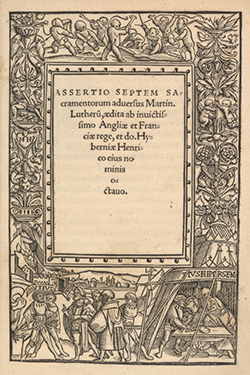 Pope Leo X confers title Defender of the Faith on King Henry VIII for his Assertio septem sacramentorum against Luther.
Pope Leo X confers title Defender of the Faith on King Henry VIII for his Assertio septem sacramentorum against Luther.
(no entry for this year)
1522
Slave Revolt: the Caribbean Slaves rebel on the Caribbean island of Hispaniola, which now comprises Haiti and the Dominican Republic.
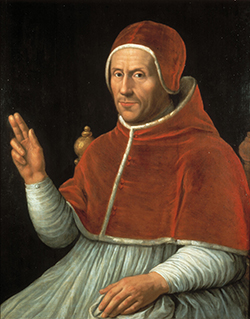 Adrian of Utrecht, Regent of Spain, elected Pope Adrian VI, the last non-Italian Pope for some time.
Adrian of Utrecht, Regent of Spain, elected Pope Adrian VI, the last non-Italian Pope for some time.
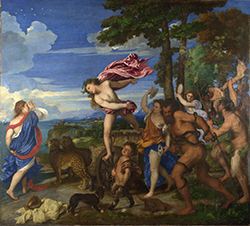 Painting by Titian: Bacchus and Ariadne, an oil painting that is one of a cycle of paintings on mythological subjects produced for Alfonso I d'Este, Duke of Ferrara, for the Camerino d'Alabastro — a private room in his palazzo in Ferrara decorated with paintings based on classical texts. An advance payment was given to Raphael, who originally held the commission for the subject of a Triumph of Bacchus. At the time of Raphael's death in 1520, only a preliminary drawing was completed. The commission was then handed to Titian. In the case of Bacchus and Ariadne, the subject matter was derived from the Roman poets Catullus and Ovid, and perhaps other classical authors. The painting, considered one of Titian's greatest works, is now in the National Gallery, London. The other major paintings in the cycle are The Feast of the Gods, mostly by Giovanni Bellini, now in the National Gallery of Art, Washington, D.C, and Titian's The Bacchanal of the Andrians and The Worship of Venus, both now in the Museo del Prado, Madrid. The series was a very early treatment of subjects from classical mythology on a heroic scale in painting, rather than in small decorative pieces, and very influential on later works.
Painting by Titian: Bacchus and Ariadne, an oil painting that is one of a cycle of paintings on mythological subjects produced for Alfonso I d'Este, Duke of Ferrara, for the Camerino d'Alabastro — a private room in his palazzo in Ferrara decorated with paintings based on classical texts. An advance payment was given to Raphael, who originally held the commission for the subject of a Triumph of Bacchus. At the time of Raphael's death in 1520, only a preliminary drawing was completed. The commission was then handed to Titian. In the case of Bacchus and Ariadne, the subject matter was derived from the Roman poets Catullus and Ovid, and perhaps other classical authors. The painting, considered one of Titian's greatest works, is now in the National Gallery, London. The other major paintings in the cycle are The Feast of the Gods, mostly by Giovanni Bellini, now in the National Gallery of Art, Washington, D.C, and Titian's The Bacchanal of the Andrians and The Worship of Venus, both now in the Museo del Prado, Madrid. The series was a very early treatment of subjects from classical mythology on a heroic scale in painting, rather than in small decorative pieces, and very influential on later works.
1523
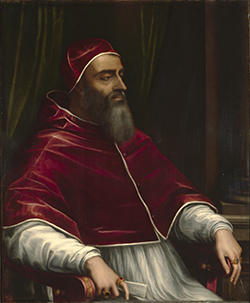 Pope Adrian VI dies, Giulio de' Medici becomes Pope Clement VII. Deemed the most unfortunate of the popes, Clement VII's reign was marked by a rapid succession of political, military, and religious struggles — many long in the making — which had far-reaching consequences for Christianity and world politics. Elected in 1524 at the end of the Italian Renaissance, Clement came to the papacy with a high reputation as a statesman. He had served with distinction as chief advisor to Pope Leo X (1513–1521, his cousin), Pope Adrian VI (1522–1523), and commendably as gran maestro of Florence (1519–1523). Assuming leadership at a time of crisis, with the Protestant Reformation spreading, the Church nearing bankruptcy, and large foreign armies invading Italy, Clement initially tried to unite Christendom by making peace among the many Christian leaders then at odds. He later attempted to liberate Italy from foreign occupation, believing that it threatened the Church's freedom. The complex political situation of the 1520s thwarted Clement's efforts.
Pope Adrian VI dies, Giulio de' Medici becomes Pope Clement VII. Deemed the most unfortunate of the popes, Clement VII's reign was marked by a rapid succession of political, military, and religious struggles — many long in the making — which had far-reaching consequences for Christianity and world politics. Elected in 1524 at the end of the Italian Renaissance, Clement came to the papacy with a high reputation as a statesman. He had served with distinction as chief advisor to Pope Leo X (1513–1521, his cousin), Pope Adrian VI (1522–1523), and commendably as gran maestro of Florence (1519–1523). Assuming leadership at a time of crisis, with the Protestant Reformation spreading, the Church nearing bankruptcy, and large foreign armies invading Italy, Clement initially tried to unite Christendom by making peace among the many Christian leaders then at odds. He later attempted to liberate Italy from foreign occupation, believing that it threatened the Church's freedom. The complex political situation of the 1520s thwarted Clement's efforts.
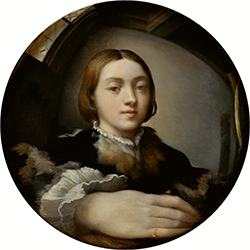 Painting by Parmigianino: Self-portrait in a Convex Mirror, a small painting, only 24.4 cm diameter (9.6 in). The work is mentioned by Late Renaissance art biographer Giorgio Vasari, who lists it as one of three small-size paintings that the artist brought to Rome with him in 1525. Vasari relays that the self-portrait was created by Parmigianino as an example to showcase his talent to potential customers. The painting depicts the young artist (then twenty one) in the middle of a room, distorted by the use of a convex mirror. The hand in the foreground is greatly elongated and distorted by the mirror. The work was painted on a specially-prepared convex panel in order to mimic the curve of the mirror used.
Painting by Parmigianino: Self-portrait in a Convex Mirror, a small painting, only 24.4 cm diameter (9.6 in). The work is mentioned by Late Renaissance art biographer Giorgio Vasari, who lists it as one of three small-size paintings that the artist brought to Rome with him in 1525. Vasari relays that the self-portrait was created by Parmigianino as an example to showcase his talent to potential customers. The painting depicts the young artist (then twenty one) in the middle of a room, distorted by the use of a convex mirror. The hand in the foreground is greatly elongated and distorted by the mirror. The work was painted on a specially-prepared convex panel in order to mimic the curve of the mirror used.
1524
(no entry for this year)
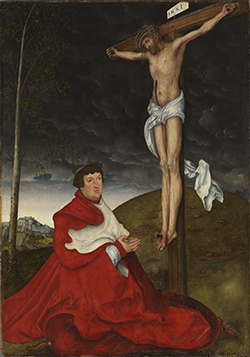 Painting by Lucas Cranach the Elder: Cardinal Albert of Brandenburg before Christ on the Cross, a painting executed with oil on firs and measures 158 cm in height and 112 cm in width. Originally belonging to the Collegiate Church of Aschaffenburg, it passed in 1829 to the Alte Pinakothek in Munich, where it is shown with the title Kardinal Albrecht von Brandenburg vor dem Gekreuzigten kniend.
Painting by Lucas Cranach the Elder: Cardinal Albert of Brandenburg before Christ on the Cross, a painting executed with oil on firs and measures 158 cm in height and 112 cm in width. Originally belonging to the Collegiate Church of Aschaffenburg, it passed in 1829 to the Alte Pinakothek in Munich, where it is shown with the title Kardinal Albrecht von Brandenburg vor dem Gekreuzigten kniend.
1525
(no entry for this year)
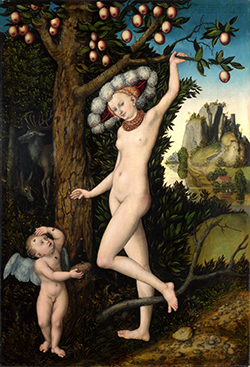 Painting by Lucas Cranach the Elder: Cupid Complaining to Venus is one of 20 similar works by Cranach and his workshop, with the figures in a variety of poses and differing in other details. The Metropolitan Museum of Art notes that the number of extant versions suggests that this was one of Cranach's most successful compositions. This version was acquired by the National Gallery, London in 1963 and is perhaps the earliest example. It depicts two classical gods of love, standing naked amid a verdant landscape under a blue sky. The work has been interpreted as an allegory of the pleasure and pains of love, and possibly also a warning of the risks of venereal disease. The winged infant Cupid stands the left of a tree which bears red apples. He is holding a honeycomb, possibly taken from a hole towards the bottom of the tree's trunk. He is being assailed by honeybees, infuriated by his theft of their sweet treasure. Venus is depicted as a voluptuous woman to the right of the tree. She is holding up a branch with her left hand, and rests her left foot on another. A stone below Venus's raised foot bears an inscription of a winged serpent with a ring in its mouth, a heraldic device granted to Cranach by Frederick the Wise in 1508. Venus is wearing only a hat of red and gold cloth decorated with a wide circle of ostrich plumes, and two necklaces: a gold chain and a jewelled choker. The pose of Venus, and the apples, allude to paintings of Eve by Cranach.
Painting by Lucas Cranach the Elder: Cupid Complaining to Venus is one of 20 similar works by Cranach and his workshop, with the figures in a variety of poses and differing in other details. The Metropolitan Museum of Art notes that the number of extant versions suggests that this was one of Cranach's most successful compositions. This version was acquired by the National Gallery, London in 1963 and is perhaps the earliest example. It depicts two classical gods of love, standing naked amid a verdant landscape under a blue sky. The work has been interpreted as an allegory of the pleasure and pains of love, and possibly also a warning of the risks of venereal disease. The winged infant Cupid stands the left of a tree which bears red apples. He is holding a honeycomb, possibly taken from a hole towards the bottom of the tree's trunk. He is being assailed by honeybees, infuriated by his theft of their sweet treasure. Venus is depicted as a voluptuous woman to the right of the tree. She is holding up a branch with her left hand, and rests her left foot on another. A stone below Venus's raised foot bears an inscription of a winged serpent with a ring in its mouth, a heraldic device granted to Cranach by Frederick the Wise in 1508. Venus is wearing only a hat of red and gold cloth decorated with a wide circle of ostrich plumes, and two necklaces: a gold chain and a jewelled choker. The pose of Venus, and the apples, allude to paintings of Eve by Cranach.
1526
(no entry for this year)
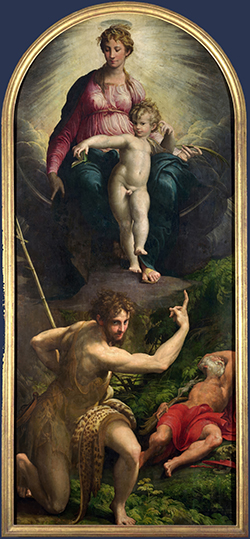 Painting by Parmigianino: Vision of Saint Jerome, was commissioned on 3 January 1526 in Rome, by Maria Bufalini, wife of Antonio Caccialupi, to decorate the family chapel in the church of San Salvatore in Lauro. The contract mentioned "Francesco Mazola de Parma" and one "Pietro" with the same name, perhaps Parmigianino's uncle Piero Ilario Mazzola. The elongated shape derives from its original destination as part of a triptych, whose sides (never painted) should represent the Immaculate Conception (to which the chapel was dedicated) and the saints Joachim and Anna. According to late Renaissance art biographer Giorgio Vasari, Parmigianino was working to this painting during the Sack of Rome, and he had to stop when the city was ravaged by the imperial troops. He was able to escape paying a ransom, while his uncle remained in Rome, being able to hide the painting in the refectory of Santa Maria della Pace. The painting is divided into two narrative sectors: a lower one, with Saint Jerome is sleeping near the crucifix (with his traditional symbol, the cardinal hat visible near a skull) and receives the vision of St. John the Baptist, identified by the long cross and the baptismal washbasin which is tied at his belt; St. John indicates the Child, represented in the upper sector between the legs of the Madonna, with a shining background behind them. Parmigianino's attention to detail is shown by the Baptist's reed cross, the speckled skin which covers him, the undergrowth near the sleeping Jerome, and the sheen on Mary's dress, the last perhaps inspired by classical sculptures seen by Parmigianino during his trips.
Painting by Parmigianino: Vision of Saint Jerome, was commissioned on 3 January 1526 in Rome, by Maria Bufalini, wife of Antonio Caccialupi, to decorate the family chapel in the church of San Salvatore in Lauro. The contract mentioned "Francesco Mazola de Parma" and one "Pietro" with the same name, perhaps Parmigianino's uncle Piero Ilario Mazzola. The elongated shape derives from its original destination as part of a triptych, whose sides (never painted) should represent the Immaculate Conception (to which the chapel was dedicated) and the saints Joachim and Anna. According to late Renaissance art biographer Giorgio Vasari, Parmigianino was working to this painting during the Sack of Rome, and he had to stop when the city was ravaged by the imperial troops. He was able to escape paying a ransom, while his uncle remained in Rome, being able to hide the painting in the refectory of Santa Maria della Pace. The painting is divided into two narrative sectors: a lower one, with Saint Jerome is sleeping near the crucifix (with his traditional symbol, the cardinal hat visible near a skull) and receives the vision of St. John the Baptist, identified by the long cross and the baptismal washbasin which is tied at his belt; St. John indicates the Child, represented in the upper sector between the legs of the Madonna, with a shining background behind them. Parmigianino's attention to detail is shown by the Baptist's reed cross, the speckled skin which covers him, the undergrowth near the sleeping Jerome, and the sheen on Mary's dress, the last perhaps inspired by classical sculptures seen by Parmigianino during his trips.
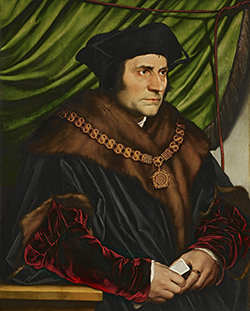 Painting by Hans Holbein, the younger: portrait of Sir Thomas More, an English lawyer, judge, social philosopher, author, statesman, amateur theologian, and noted Renaissance humanist. He also served Henry VIII as Lord High Chancellor of England from October 1529 to May 1532. He wrote Utopia, published in 1516, which describes the political system of an imaginary island state. More opposed the Protestant Reformation, directing polemics against the theology of Martin Luther, Huldrych Zwingli and William Tyndale. More also opposed Henry VIII's separation from the Catholic Church, refusing to acknowledge Henry as supreme head of the Church of England and the annulment of his marriage to Catherine of Aragon. After refusing to take the Oath of Supremacy, he was convicted of treason on what he stated was false evidence, and was executed. At his execution, he was reported to have said: "I die the King's good servant, and God's first." Pope Pius XI canonised More in 1935 as a martyr.
Painting by Hans Holbein, the younger: portrait of Sir Thomas More, an English lawyer, judge, social philosopher, author, statesman, amateur theologian, and noted Renaissance humanist. He also served Henry VIII as Lord High Chancellor of England from October 1529 to May 1532. He wrote Utopia, published in 1516, which describes the political system of an imaginary island state. More opposed the Protestant Reformation, directing polemics against the theology of Martin Luther, Huldrych Zwingli and William Tyndale. More also opposed Henry VIII's separation from the Catholic Church, refusing to acknowledge Henry as supreme head of the Church of England and the annulment of his marriage to Catherine of Aragon. After refusing to take the Oath of Supremacy, he was convicted of treason on what he stated was false evidence, and was executed. At his execution, he was reported to have said: "I die the King's good servant, and God's first." Pope Pius XI canonised More in 1935 as a martyr.
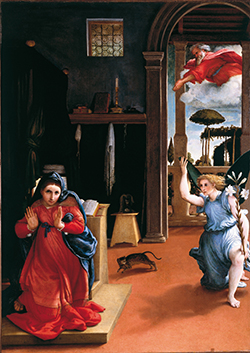 Painting by Lorenzo Lotto: The Annunciation, an oil-on-canvas painting by the Italian Renaissance painter Lorenzo Lotto, executed around somewhere between 1527 and 1534 and housed in the Civic Museum of Villa Colloredo Mels, Recanati, Italy. The painting depicts a bedroom where an Annunciation takes place following an unusual scheme: the angel is on the right, holding a white lily, and has got in from a loggia which opens to a garden (the hortus conclusus). His right arm is pointing at the Father God who has shown in a cloud and is blessing Mary from inside the loggia. Mary is portrayed in the left foreground, looking at the spectator and raising her hands in a surprised gesture. Stylistically, Lotto used expressive gestures and somewhat under-size heads. The number of carefully painted details show the influence of Northern European paintings: they include the baldachin bed, the small window with sealed glasses, the shelf with a small still life, the hatstand, the stool with an hourglass, the prie-dieu and a scared cat which is fleeing. The baldachin was inspired by a relief by Andrea Sansovino at Loreto.
Painting by Lorenzo Lotto: The Annunciation, an oil-on-canvas painting by the Italian Renaissance painter Lorenzo Lotto, executed around somewhere between 1527 and 1534 and housed in the Civic Museum of Villa Colloredo Mels, Recanati, Italy. The painting depicts a bedroom where an Annunciation takes place following an unusual scheme: the angel is on the right, holding a white lily, and has got in from a loggia which opens to a garden (the hortus conclusus). His right arm is pointing at the Father God who has shown in a cloud and is blessing Mary from inside the loggia. Mary is portrayed in the left foreground, looking at the spectator and raising her hands in a surprised gesture. Stylistically, Lotto used expressive gestures and somewhat under-size heads. The number of carefully painted details show the influence of Northern European paintings: they include the baldachin bed, the small window with sealed glasses, the shelf with a small still life, the hatstand, the stool with an hourglass, the prie-dieu and a scared cat which is fleeing. The baldachin was inspired by a relief by Andrea Sansovino at Loreto.
1527
(no entry for this year)
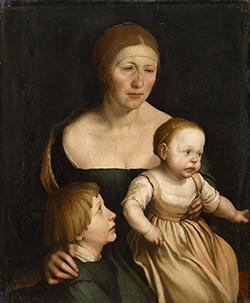 Painting by Hans Holbein the Younger: Portrait of the Artist's Family, a portrait of the family of the painter Hans Holbein the Younger by the artist himself. It depicts Holbein's wife Elsbeth Binzenstock, their son Philipp and their daughter Katharina. Holbein painted it during his stay in Basel after his return from England. It was painted, between 1528 and 1529, on paper and glued on wood.
Painting by Hans Holbein the Younger: Portrait of the Artist's Family, a portrait of the family of the painter Hans Holbein the Younger by the artist himself. It depicts Holbein's wife Elsbeth Binzenstock, their son Philipp and their daughter Katharina. Holbein painted it during his stay in Basel after his return from England. It was painted, between 1528 and 1529, on paper and glued on wood.
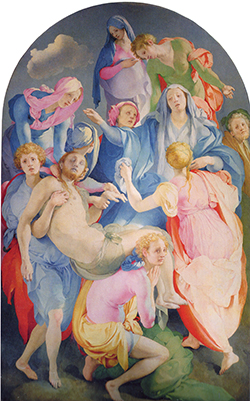 Painting by Jacopo Pontormo: The Deposition from the Cross is an altarpiece, completed in 1528, depicting the Deposition of Christ. It is broadly considered to be the artist's surviving masterpiece. Painted in tempera on wood, it is located above the altar of the Capponi Chapel of the church of Santa Felicita in Florence.
Painting by Jacopo Pontormo: The Deposition from the Cross is an altarpiece, completed in 1528, depicting the Deposition of Christ. It is broadly considered to be the artist's surviving masterpiece. Painted in tempera on wood, it is located above the altar of the Capponi Chapel of the church of Santa Felicita in Florence.
1528
(no entry for this year)
(no entry for this year)
1529
(no entry for this year)
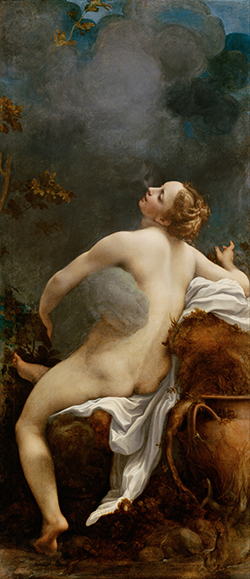 Painting by Antonio da Correggio: Jupiter and Io, an oil on canvas measuring 73.5 cm wide by 162 cm tall (29 in wide by 64 in tall). It depicts a sensuous seduction from Metamorphoses, an epic poem by the ancient Roman writer Ovid. In this particular scene the Roman god Jupiter, in the form of a misty cloud, approaches the beautiful Io who was a river nymph and a princess of Argos and/or a priestess to the goddess Juno. This mortal woman succumbs to her divine lover as the stormy dark mist kisses her rose-and-lily face and caresses her soft white flesh. Her head is thrown back in passionate ecstasy while her fingers and toes curl in orgasmic pleasure. This highly erotic scene displays extraordinary sensuality but with easy delicate tenderness. Correggio's masterpiece is probably the most famous painting depicting Jupiter's seduction of Io. It was commissioned by Federico II Gonzaga, Duke of Mantua, to join three other erotic paintings based upon Metamorphoses. The four-part series was originally intended as a gift for Charles V, Holy Roman Emperor, but Federico II Gonzaga loved them so much that he kept them for himself. He placed them in a large room, which he named the Room of Ovid, in his Palazzo del Te in Mantua. Ironically, the duke only enjoyed these amorous paintings for less than 10 years as he died in 1540 from syphilis.
Painting by Antonio da Correggio: Jupiter and Io, an oil on canvas measuring 73.5 cm wide by 162 cm tall (29 in wide by 64 in tall). It depicts a sensuous seduction from Metamorphoses, an epic poem by the ancient Roman writer Ovid. In this particular scene the Roman god Jupiter, in the form of a misty cloud, approaches the beautiful Io who was a river nymph and a princess of Argos and/or a priestess to the goddess Juno. This mortal woman succumbs to her divine lover as the stormy dark mist kisses her rose-and-lily face and caresses her soft white flesh. Her head is thrown back in passionate ecstasy while her fingers and toes curl in orgasmic pleasure. This highly erotic scene displays extraordinary sensuality but with easy delicate tenderness. Correggio's masterpiece is probably the most famous painting depicting Jupiter's seduction of Io. It was commissioned by Federico II Gonzaga, Duke of Mantua, to join three other erotic paintings based upon Metamorphoses. The four-part series was originally intended as a gift for Charles V, Holy Roman Emperor, but Federico II Gonzaga loved them so much that he kept them for himself. He placed them in a large room, which he named the Room of Ovid, in his Palazzo del Te in Mantua. Ironically, the duke only enjoyed these amorous paintings for less than 10 years as he died in 1540 from syphilis.
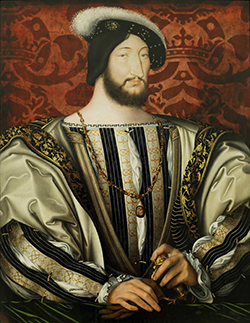 Painting by Jean Clouet: Portrait of Francis I, King of France.
Painting by Jean Clouet: Portrait of Francis I, King of France.
1530
(no entry for this year)
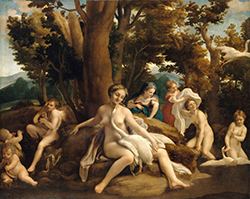 Painting by Antonio da Correggio: Leda and the Swan, an oil on canvas painting from 1530–31 by the Italian painter Correggio, now in the Gemäldegalerie in Berlin. It shows three scenes of Leda's seduction by Jupiter who has taken the form of a swan. Their first meeting is shown on the right hand side and their lovemaking in the center, where Leda sits with the swan between her thighs, guiding him with her left hand. They are accompanied to their left by Cupid with his bow and two cupids with flutes. The third scene (again on the right hand side) is the swan flying away whilst Leda gets dressed. Leda and the Swan was a common subject in 16th-century art.
Painting by Antonio da Correggio: Leda and the Swan, an oil on canvas painting from 1530–31 by the Italian painter Correggio, now in the Gemäldegalerie in Berlin. It shows three scenes of Leda's seduction by Jupiter who has taken the form of a swan. Their first meeting is shown on the right hand side and their lovemaking in the center, where Leda sits with the swan between her thighs, guiding him with her left hand. They are accompanied to their left by Cupid with his bow and two cupids with flutes. The third scene (again on the right hand side) is the swan flying away whilst Leda gets dressed. Leda and the Swan was a common subject in 16th-century art.
1531
(no entry for this year)
(no entry for this year)
1532
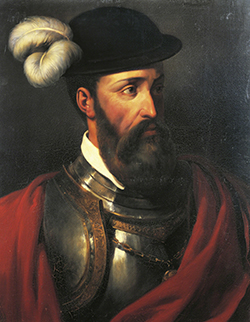 Francisco Pizarro leads the Spanish conquest of the Inca Empire.
Francisco Pizarro leads the Spanish conquest of the Inca Empire.
Sugarcane is first grown in Brazil.
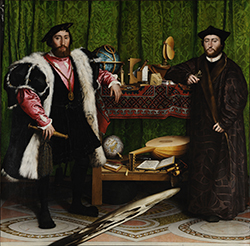 Painting by Hans Holbein (the Younger): The Ambassadors, also known as Jean de Dinteville and Georges de Selve, after the two people it portrays, it was created in the Tudor period, in the same year Elizabeth I was born. As well as being a double portrait, the painting contains a still life of meticulously rendered objects, the meaning of which is the cause of much debate. An array of expensive scientific objects, related to knowing the time and the cosmos are prominently displayed. Several refer to Rome, the seat of the Pope. A second shelf of objects shows a lute with a broken string, a symbol of discord, next to a hymnal composed by Martin Luther. It incorporates one of the best-known examples of anamorphosis in painting. While most scholars have taken the view that the painting should be viewed side on to see the skull, others believe a glass tube was used to see the skull head on. Either way, death is both prominent and obscured until discovered. Less easily spotted is a carving of Jesus on a crucifix, half hidden behind a curtain at the top left. The Ambassadors has been part of London's National Gallery collection since its purchase in 1890. It was extensively restored in 1997, leading to criticism, in particular that the skull's dimensions had been changed.
Painting by Hans Holbein (the Younger): The Ambassadors, also known as Jean de Dinteville and Georges de Selve, after the two people it portrays, it was created in the Tudor period, in the same year Elizabeth I was born. As well as being a double portrait, the painting contains a still life of meticulously rendered objects, the meaning of which is the cause of much debate. An array of expensive scientific objects, related to knowing the time and the cosmos are prominently displayed. Several refer to Rome, the seat of the Pope. A second shelf of objects shows a lute with a broken string, a symbol of discord, next to a hymnal composed by Martin Luther. It incorporates one of the best-known examples of anamorphosis in painting. While most scholars have taken the view that the painting should be viewed side on to see the skull, others believe a glass tube was used to see the skull head on. Either way, death is both prominent and obscured until discovered. Less easily spotted is a carving of Jesus on a crucifix, half hidden behind a curtain at the top left. The Ambassadors has been part of London's National Gallery collection since its purchase in 1890. It was extensively restored in 1997, leading to criticism, in particular that the skull's dimensions had been changed.
1533
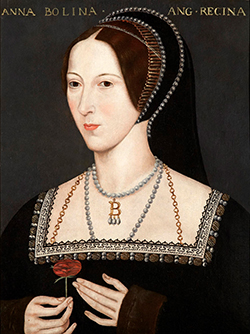 Anne Boleyn becomes Queen of England. Anne was the daughter of Thomas Boleyn (later Earl of Wiltshire), and his wife, Elizabeth Howard, and was educated in the Netherlands and France. Anne returned to England in early 1522, to marry her cousin James Butler, 9th Earl of Ormond; the marriage plans were broken off, and instead, she secured a post at court as maid of honor to Henry VIII's wife, Catherine of Aragon. Early in 1523, Anne was secretly betrothed to Henry Percy, son of Henry Percy, 5th Earl of Northumberland, but the betrothal was broken off when the Earl refused to support it. Cardinal Thomas Wolsey refused the match in January 1524. In February or March 1526, Henry VIII began his pursuit of Anne. She resisted his attempts to seduce her, refusing to become his mistress, as her sister Mary had previously been. Henry focused on annulling his marriage to Catherine, so he would be free to marry Anne. After Wolsey failed to obtain an annulment from Pope Clement VII, it became clear the marriage would not be annulled by the Catholic Church. As a result, Henry and his advisers, such as Thomas Cromwell, began breaking the Church's power in England and closing the monasteries. Henry and Anne formally married on 25 January 1533, after a secret wedding on 14 November 1532.
Anne Boleyn becomes Queen of England. Anne was the daughter of Thomas Boleyn (later Earl of Wiltshire), and his wife, Elizabeth Howard, and was educated in the Netherlands and France. Anne returned to England in early 1522, to marry her cousin James Butler, 9th Earl of Ormond; the marriage plans were broken off, and instead, she secured a post at court as maid of honor to Henry VIII's wife, Catherine of Aragon. Early in 1523, Anne was secretly betrothed to Henry Percy, son of Henry Percy, 5th Earl of Northumberland, but the betrothal was broken off when the Earl refused to support it. Cardinal Thomas Wolsey refused the match in January 1524. In February or March 1526, Henry VIII began his pursuit of Anne. She resisted his attempts to seduce her, refusing to become his mistress, as her sister Mary had previously been. Henry focused on annulling his marriage to Catherine, so he would be free to marry Anne. After Wolsey failed to obtain an annulment from Pope Clement VII, it became clear the marriage would not be annulled by the Catholic Church. As a result, Henry and his advisers, such as Thomas Cromwell, began breaking the Church's power in England and closing the monasteries. Henry and Anne formally married on 25 January 1533, after a secret wedding on 14 November 1532.
(no entry for this year)
1534
(no entry for this year)
(no entry for this year)
1535
(no entry for this year)
(no entry for this year)
1537
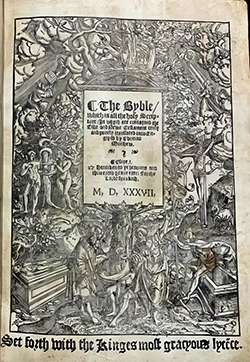 William Tyndale's partial translation of the Bible into English is published, which would eventually be incorporated into the King James Bible.
William Tyndale's partial translation of the Bible into English is published, which would eventually be incorporated into the King James Bible.
(no entry for this year)
1538
(no entry for this year)
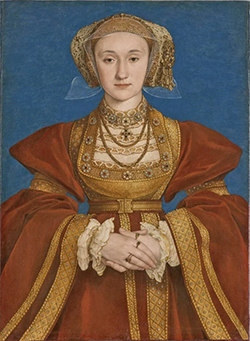 Painting by Hans Holbein (the younger): Portrait of Anne of Clèves. In 1539, Holbein was sent to Düren, in the Duchy of Clèves, to paint a portrait of Anne of Clèves (1515–1557) as a possible candidate for marriage. The marriage was arranged by Henry's chief advisor, Thomas Cromwell. The portrait was painted by Holbein so that Henry could see what his future bride looked like. Based on the portrait, Henry had a swipe right reaction, but when he finally met her in person, he was greatly disappointed. Anne was King Henry VIII's fourth queen. Her marriage to Henry was the shortest of all the six queens, officially lasting just six months. Anne was given a large settlement, which made her very wealthy. She was granted the title King's Sister and went on to live a very comfortable, independent life, outliving Henry, his other wives and his son, Edward.
Painting by Hans Holbein (the younger): Portrait of Anne of Clèves. In 1539, Holbein was sent to Düren, in the Duchy of Clèves, to paint a portrait of Anne of Clèves (1515–1557) as a possible candidate for marriage. The marriage was arranged by Henry's chief advisor, Thomas Cromwell. The portrait was painted by Holbein so that Henry could see what his future bride looked like. Based on the portrait, Henry had a swipe right reaction, but when he finally met her in person, he was greatly disappointed. Anne was King Henry VIII's fourth queen. Her marriage to Henry was the shortest of all the six queens, officially lasting just six months. Anne was given a large settlement, which made her very wealthy. She was granted the title King's Sister and went on to live a very comfortable, independent life, outliving Henry, his other wives and his son, Edward.
1539
Spain annexes Cuba.
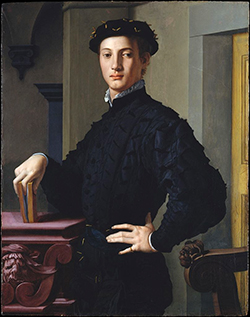 Painting by Agnolo Bronzino: Portrait of a Young Man with a Book The Portrait of a Young Man with a Book is a c.1530s oil on board painting by Agnolo Bronzino. It likely depicts a literary friend of the artist holding open a collection of poetry. It entered the Metropolitan Museum of Art in New York in 1929, where it is still held.
Painting by Agnolo Bronzino: Portrait of a Young Man with a Book The Portrait of a Young Man with a Book is a c.1530s oil on board painting by Agnolo Bronzino. It likely depicts a literary friend of the artist holding open a collection of poetry. It entered the Metropolitan Museum of Art in New York in 1929, where it is still held.
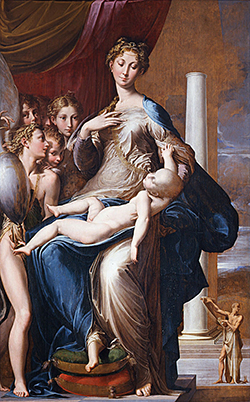 Painting by Parmigianino: Madonna with the Long Neck an Italian Mannerist oil painting depicting Madonna and Child with angels. The painting was begun in 1534 for the funerary chapel of Francesco Tagliaferri in Parma, but remained incomplete on Parmigianino's death in 1540. Ferdinando de' Medici, Grand Prince of Tuscany purchased it in 1698 and it has been on display at the Uffizi since 1948. The painting depicts the Virgin Mary seated on a high pedestal in luxurious robes, holding a rather large baby Jesus on her lap. Six angels crowd together on the Madonna's right, adore the Christ-child. In the lower right-hand corner of the painting is an enigmatic scene, with a row of marble columns and the emaciated figure of St. Jerome. A depiction of St. Jerome was required by the commissioner because of the saint's connection with the adoration of the Virgin Mary. The painting is popularly called "Madonna of the Long Neck" because "the painter, in his eagerness to make the Holy Virgin look graceful and elegant, has given her a neck like that of a swan."
Painting by Parmigianino: Madonna with the Long Neck an Italian Mannerist oil painting depicting Madonna and Child with angels. The painting was begun in 1534 for the funerary chapel of Francesco Tagliaferri in Parma, but remained incomplete on Parmigianino's death in 1540. Ferdinando de' Medici, Grand Prince of Tuscany purchased it in 1698 and it has been on display at the Uffizi since 1948. The painting depicts the Virgin Mary seated on a high pedestal in luxurious robes, holding a rather large baby Jesus on her lap. Six angels crowd together on the Madonna's right, adore the Christ-child. In the lower right-hand corner of the painting is an enigmatic scene, with a row of marble columns and the emaciated figure of St. Jerome. A depiction of St. Jerome was required by the commissioner because of the saint's connection with the adoration of the Virgin Mary. The painting is popularly called "Madonna of the Long Neck" because "the painter, in his eagerness to make the Holy Virgin look graceful and elegant, has given her a neck like that of a swan."
1540
Hernando de Alarcón sets sail to explore the Baja California peninsula; on September 26 he enters the Colorado River.
The Society of Jesus, or the Jesuits, is founded by Ignatius of Loyola and six companions with the approval of Pope Paul III.
(no entry for this year)
1541
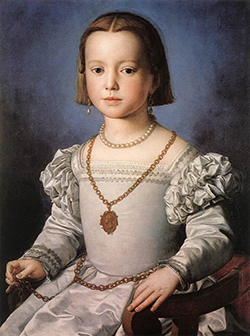 Painting by Agnolo Bronzino: Portrait of Bia de' Medici The Portrait of Bia de' Medici is an oil-tempera on wood painting by Agnolo Bronzino, dating to around 1542 and now in the Uffizi in Florence. Some art historians once identified the child as a young Cosimo I de' Medici, but it is now generally accepted to be Giulia.
Painting by Agnolo Bronzino: Portrait of Bia de' Medici The Portrait of Bia de' Medici is an oil-tempera on wood painting by Agnolo Bronzino, dating to around 1542 and now in the Uffizi in Florence. Some art historians once identified the child as a young Cosimo I de' Medici, but it is now generally accepted to be Giulia.
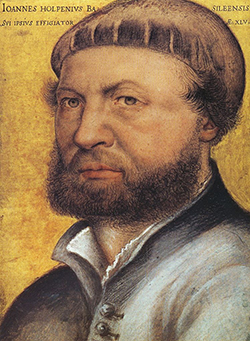 Painting by Hans Holbein the Younger: Self Portrait The Self-portrait is a small drawing by the German Renaissance artist and printmaker Hans Holbein the Younger, completed around 1542-1543, and housed in the Uffizi, Florence. The gold background was added later by a different artist. According to art historian John Rowlands, "Although this drawing has been enlarged on all sides and heavily reworked, enough of it still shows to allow the assumption that the original work was executed by Holbein.
Painting by Hans Holbein the Younger: Self Portrait The Self-portrait is a small drawing by the German Renaissance artist and printmaker Hans Holbein the Younger, completed around 1542-1543, and housed in the Uffizi, Florence. The gold background was added later by a different artist. According to art historian John Rowlands, "Although this drawing has been enlarged on all sides and heavily reworked, enough of it still shows to allow the assumption that the original work was executed by Holbein.
1542
Juan Rodríguez Cabrillo explores the coast of California.
Pope Paul III establishes the Inquisition in Rome.
War resumes between Francis I of France and Emperor Charles V. This time Henry VIII is allied with the Emperor, while James V of Scotland and Sultan Suleiman I are allied with the French.
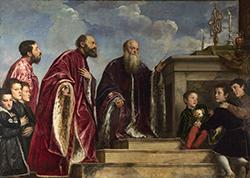 Painting by Titian: Portrait of the Vendramin Family a painting executed around 1543–1547. It presently hangs in the National Gallery in London. The canvas was commissioned by the noble Vendramin family, and portrays, as dictated by Venetian custom, only male members of the dynasty. It includes the brothers Andrea and Gabriele Vendramin, and Andrea's seven sons. Titian's painting has been described as, "one of the greatest group portraits in history". It balances youth and wisdom as well as demonstrating the power of this family and their public commitments to the Republic.
Painting by Titian: Portrait of the Vendramin Family a painting executed around 1543–1547. It presently hangs in the National Gallery in London. The canvas was commissioned by the noble Vendramin family, and portrays, as dictated by Venetian custom, only male members of the dynasty. It includes the brothers Andrea and Gabriele Vendramin, and Andrea's seven sons. Titian's painting has been described as, "one of the greatest group portraits in history". It balances youth and wisdom as well as demonstrating the power of this family and their public commitments to the Republic.
1543
(no entry for this year)
(no entry for this year)
1544
(no entry for this year)
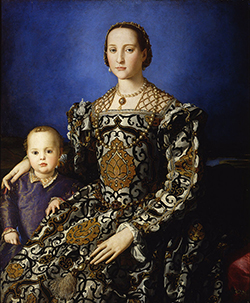 Painting by Agnolo Bronzino: Portrait of Eleanor of Toledo One of his most famous works, it is housed in the Uffizi Gallery of Florence, Italy and is considered one of the preeminent examples of Mannerist portraiture. The painting depicts Eleanor of Toledo, the wife of Cosimo I de' Medici, Grand Duke of Tuscany, sitting with her hand resting on the shoulder of one of her sons. This gesture, as well as the pomegranate motif on her dress, referred to her role as mother. Eleanor wears a heavily brocaded dress with black arabesques. In this pose, she is depicted as the ideal woman of the Renaissance.
Painting by Agnolo Bronzino: Portrait of Eleanor of Toledo One of his most famous works, it is housed in the Uffizi Gallery of Florence, Italy and is considered one of the preeminent examples of Mannerist portraiture. The painting depicts Eleanor of Toledo, the wife of Cosimo I de' Medici, Grand Duke of Tuscany, sitting with her hand resting on the shoulder of one of her sons. This gesture, as well as the pomegranate motif on her dress, referred to her role as mother. Eleanor wears a heavily brocaded dress with black arabesques. In this pose, she is depicted as the ideal woman of the Renaissance.
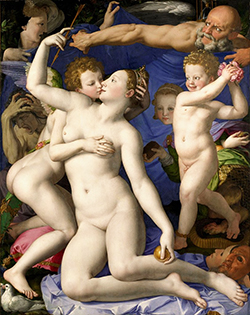 Painting by Agnolo Bronzino: Venus, Cupid, Folly and Time (also called An Allegory of Venus and Cupid and A Triumph of Venus) is an allegorical painting by the Florentine artist Agnolo Bronzino. About 1546, Bronzino was commissioned to create a painting that has come to be known as Venus, Cupid, Folly, and Time. It displays the ambivalence, eroticism, and obscure imagery that are characteristic of the Mannerist period, and of Bronzino's master Pontormo.
Painting by Agnolo Bronzino: Venus, Cupid, Folly and Time (also called An Allegory of Venus and Cupid and A Triumph of Venus) is an allegorical painting by the Florentine artist Agnolo Bronzino. About 1546, Bronzino was commissioned to create a painting that has come to be known as Venus, Cupid, Folly, and Time. It displays the ambivalence, eroticism, and obscure imagery that are characteristic of the Mannerist period, and of Bronzino's master Pontormo.
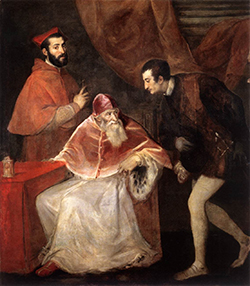 Painting by Titian: Pope Paul III and His Grandsons was commissioned by the Farnese family and painted during Titian's visit to Rome between autumn 1545 and June 1546. It depicts the thorny relationship between Pope Paul III, born Alessandro Farnese, and two of his grandsons, Ottavio and Alessandro. Ottavio is shown in the act of kneeling, to his left; Alessandro, wearing a cardinal's dress, stands behind him to his right. The painting explores the effects of ageing and the manoeuvring behind succession; Paul was at the time in his late seventies and operating within an uncertain political climate as Charles V, Holy Roman Emperor, came into ascendancy. Paul was not a religious man; he viewed the papacy as a means to consolidate his family's position. He appointed Alessandro as cardinal against accusations of nepotism, fathered a number of illegitimate children, and spent large sums of church money collecting art and antiquities.
Painting by Titian: Pope Paul III and His Grandsons was commissioned by the Farnese family and painted during Titian's visit to Rome between autumn 1545 and June 1546. It depicts the thorny relationship between Pope Paul III, born Alessandro Farnese, and two of his grandsons, Ottavio and Alessandro. Ottavio is shown in the act of kneeling, to his left; Alessandro, wearing a cardinal's dress, stands behind him to his right. The painting explores the effects of ageing and the manoeuvring behind succession; Paul was at the time in his late seventies and operating within an uncertain political climate as Charles V, Holy Roman Emperor, came into ascendancy. Paul was not a religious man; he viewed the papacy as a means to consolidate his family's position. He appointed Alessandro as cardinal against accusations of nepotism, fathered a number of illegitimate children, and spent large sums of church money collecting art and antiquities.
1545
(no entry for this year)
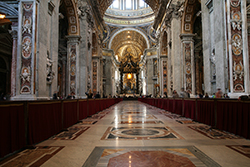 Michelangelo Buonarroti is made chief architect of St. Peter's Basilica.
Michelangelo Buonarroti is made chief architect of St. Peter's Basilica.
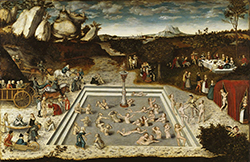 Painting by Lucas Cranach the Elder : The Fountain of Youth The image is an oil painting on a lime wood board, executed in landscape format with the dimensions 186.1 x 120.6 centimeters. It shows on the bottom center, a winged serpent in flight from Cranach's workshop and the year 1546. It shows a fountain where older women but not men bathe, are rejuvenated and finally indulge in music, dance and good food. Cranach presents in this fairy tale image, in many details the real bathing culture of the Middle Ages, that based on the belief that certain baths might heal and rejuvenate. Sensual pleasures belonged to the bathroom now.
Painting by Lucas Cranach the Elder : The Fountain of Youth The image is an oil painting on a lime wood board, executed in landscape format with the dimensions 186.1 x 120.6 centimeters. It shows on the bottom center, a winged serpent in flight from Cranach's workshop and the year 1546. It shows a fountain where older women but not men bathe, are rejuvenated and finally indulge in music, dance and good food. Cranach presents in this fairy tale image, in many details the real bathing culture of the Middle Ages, that based on the belief that certain baths might heal and rejuvenate. Sensual pleasures belonged to the bathroom now.
1546
(no entry for this year)
(no entry for this year)
1547
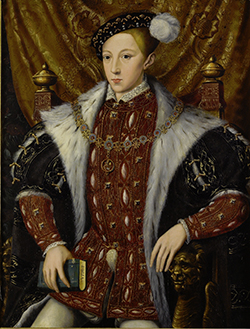 Edward VI becomes King of England and Ireland on 28 January and is crowned on 20 February at the age of 9. The son of Henry VIII and Jane Seymour, Edward was England's first monarch to be raised as a Protestant. During his reign, the realm was governed by a Regency Council because he never reached his majority.
Edward VI becomes King of England and Ireland on 28 January and is crowned on 20 February at the age of 9. The son of Henry VIII and Jane Seymour, Edward was England's first monarch to be raised as a Protestant. During his reign, the realm was governed by a Regency Council because he never reached his majority.
 Grand Prince Ivan the Terrible is crowned tsar of (All)Russia, thenceforth becoming the first Russian tsar.
Grand Prince Ivan the Terrible is crowned tsar of (All)Russia, thenceforth becoming the first Russian tsar.
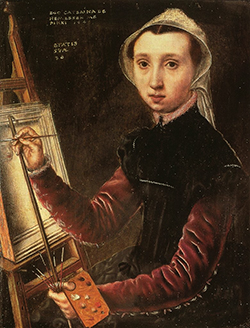 Painting by Caterina van Hemessen: Self Portrait a small painting executed in oil on oak in 1548 by the Flemish Renaissance artist Caterina van Hemessen when she was 20 years old. The painting earned her a considerable reputation during her lifetime and is significant not only for being an early modern female portrait but also for representing an artist in the act of painting. This was very unusual for the time; although self-portraits were common, only a few, like those of Albrecht Dürer (1471–1528), showed the artist's social position and everyday life. Artists of the time rarely directly referred to, much less showed the tools of their profession. Hemessen's portrait is one of the earliest in the Northern European tradition to show a painter not only with a brush but also a palette and easel. She inscribed it with the words: "I Caterina van Hemessen have painted myself / 1548 / Her aged 20".
Painting by Caterina van Hemessen: Self Portrait a small painting executed in oil on oak in 1548 by the Flemish Renaissance artist Caterina van Hemessen when she was 20 years old. The painting earned her a considerable reputation during her lifetime and is significant not only for being an early modern female portrait but also for representing an artist in the act of painting. This was very unusual for the time; although self-portraits were common, only a few, like those of Albrecht Dürer (1471–1528), showed the artist's social position and everyday life. Artists of the time rarely directly referred to, much less showed the tools of their profession. Hemessen's portrait is one of the earliest in the Northern European tradition to show a painter not only with a brush but also a palette and easel. She inscribed it with the words: "I Caterina van Hemessen have painted myself / 1548 / Her aged 20".
1548
Battle of Uedahara: Firearms are used for the first time on the battlefield in Japan.
(no entry for this year)
1549
(no entry for this year)
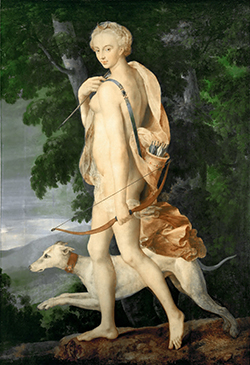 Painting by unknown artist from the school of Fontainbleau: Diana the Huntress This may be an allegorical portrait of Diane de Poitiers, mistress of the French King Henry II. It reveals the profound impact of Italian Mannerist painters on French court art.
Painting by unknown artist from the school of Fontainbleau: Diana the Huntress This may be an allegorical portrait of Diane de Poitiers, mistress of the French King Henry II. It reveals the profound impact of Italian Mannerist painters on French court art.
1550
(no entry for this year)
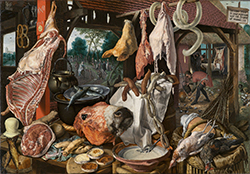 Painting by Pieter Aertsen: A Meat Stall with the Holy Family Giving Alms A large painting, it depicts a peasant market scene, with an abundance of meats and other foods. In the background, it shows a scene from the biblical theme of the flight into Egypt, where the Virgin Mary is seen stopped on the road, giving alms to the poor. Thus, although the painting seems to be at first sight an ordinary still life concentrating on foodstuffs, it is rich with symbolism; it in fact hides a symbolic religious meaning, and embodies a visual metaphor encouraging spiritual life. Aertsen made a name for himself during the 1550s painting scenes from everyday life in a naturalistic manner.
Painting by Pieter Aertsen: A Meat Stall with the Holy Family Giving Alms A large painting, it depicts a peasant market scene, with an abundance of meats and other foods. In the background, it shows a scene from the biblical theme of the flight into Egypt, where the Virgin Mary is seen stopped on the road, giving alms to the poor. Thus, although the painting seems to be at first sight an ordinary still life concentrating on foodstuffs, it is rich with symbolism; it in fact hides a symbolic religious meaning, and embodies a visual metaphor encouraging spiritual life. Aertsen made a name for himself during the 1550s painting scenes from everyday life in a naturalistic manner.
1551
(no entry for this year)
(no entry for this year)
1552
(no entry for this year)
(no entry for this year)
1553
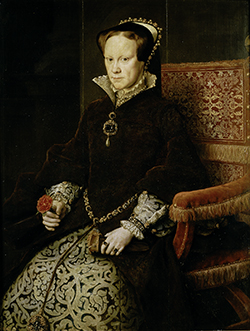 Mary Tudor becomes the first queen regnant of England and restores the Church of England under Papal authority.
Mary Tudor becomes the first queen regnant of England and restores the Church of England under Papal authority.
(no entry for this year)
1554
(no entry for this year)
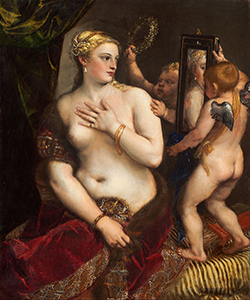 Painting by Titian: Venus with a Mirror The pose of the Venus resembles the classical statues of the Venus de' Medici in Florence or the Capitoline Venus in Rome, which Titian may have seen when he wrote that was "learning from the marvelous ancient stones." The painting is said to celebrate the ideal beauty of the female form, or to be a critique of vanity, or perhaps both. It was copied by several later artists, including Peter Paul Rubens and Anthony van Dyck. Titian made a number of paintings of the same subject, but this is the believed to be the earliest and the only version to be entirely by the hand of Titian, without additions by his assistants. it remained in his house until his death in 1576. X-rays of the painting have revealed that Titian painted it over a double portrait which he had abandoned.
Painting by Titian: Venus with a Mirror The pose of the Venus resembles the classical statues of the Venus de' Medici in Florence or the Capitoline Venus in Rome, which Titian may have seen when he wrote that was "learning from the marvelous ancient stones." The painting is said to celebrate the ideal beauty of the female form, or to be a critique of vanity, or perhaps both. It was copied by several later artists, including Peter Paul Rubens and Anthony van Dyck. Titian made a number of paintings of the same subject, but this is the believed to be the earliest and the only version to be entirely by the hand of Titian, without additions by his assistants. it remained in his house until his death in 1576. X-rays of the painting have revealed that Titian painted it over a double portrait which he had abandoned.
1555
(no entry for this year)
(no entry for this year)
1556
Pomponio Algerio, 25-year-old radical theologian, is executed by boiling in oil as part of the Roman inquisition. After refusing to conform to Church doctrine, he was sentenced to prison and asked to reconsider his Lutheran beliefs. After a year behind bars, he still refused to reconsider. Because Venetian authorities would not consent to an execution, Pope Paul IV sent officials to extradite Pomponio to Rome. In Rome, on 21 August 1555, a monk from the brotherhood of St John the Beheaded visited Pomponio in his cell urging him to repent. If he repented, he would be strangled before burning. The 24-year-old student refused. One year later, on 22 August 1556, he was executed by civil authorities in the Piazza Navona, Rome. Maintaining his composure while he was boiled in oil, he stayed alive for 15 minutes before dying.
The Shaanxi earthquake in China, during the Ming Dynasty, is history's deadliest known earthquake, killing approximately 830,000 people.
(no entry for this year)
1557
(no entry for this year)
(no entry for this year)
1558
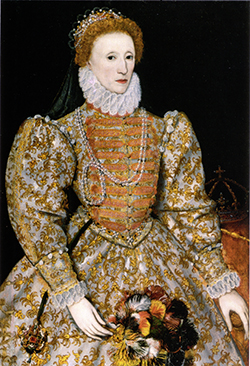 Elizabeth Tudor becomes Queen Elizabeth I at age 25. Sometimes called The Virgin Queen, Gloriana or Good Queen Bess, the childless Elizabeth was the last monarch of the Tudor dynasty. Elizabeth was the daughter of Henry VIII and Anne Boleyn, his second wife, who was executed two-and-a-half years after Elizabeth's birth. Anne's marriage to Henry VIII was annulled, and Elizabeth was declared illegitimate. Elizabeth's reign is known as the Elizabethan era. The period is famous for the flourishing of English drama, led by playwrights such as William Shakespeare and Christopher Marlowe, and for the seafaring prowess of English adventurers such as Francis Drake.
Elizabeth Tudor becomes Queen Elizabeth I at age 25. Sometimes called The Virgin Queen, Gloriana or Good Queen Bess, the childless Elizabeth was the last monarch of the Tudor dynasty. Elizabeth was the daughter of Henry VIII and Anne Boleyn, his second wife, who was executed two-and-a-half years after Elizabeth's birth. Anne's marriage to Henry VIII was annulled, and Elizabeth was declared illegitimate. Elizabeth's reign is known as the Elizabethan era. The period is famous for the flourishing of English drama, led by playwrights such as William Shakespeare and Christopher Marlowe, and for the seafaring prowess of English adventurers such as Francis Drake.
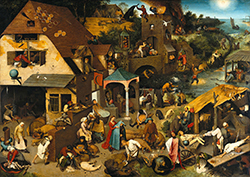 Painting by Pieter Bruegel the Elder: Netherlandish Proverbs a 1559 oil-on-oak-panel painting that depicts a scene in which humans and, to a lesser extent, animals and objects, offer literal illustrations of Dutch language proverbs and idioms. Running themes in Bruegel's paintings are the absurdity, wickedness and foolishness of humans, and this is no exception. The painting's original title, The Blue Cloak or The Folly of the World, indicates that Bruegel's intent was not just to illustrate proverbs, but rather to catalog human folly. Many of the people depicted show the characteristic blank features that Bruegel used to portray fools.
Painting by Pieter Bruegel the Elder: Netherlandish Proverbs a 1559 oil-on-oak-panel painting that depicts a scene in which humans and, to a lesser extent, animals and objects, offer literal illustrations of Dutch language proverbs and idioms. Running themes in Bruegel's paintings are the absurdity, wickedness and foolishness of humans, and this is no exception. The painting's original title, The Blue Cloak or The Folly of the World, indicates that Bruegel's intent was not just to illustrate proverbs, but rather to catalog human folly. Many of the people depicted show the characteristic blank features that Bruegel used to portray fools.
1559
Led by Don Tristán de Luna y Arellano, a Spanish missionary colony of 1500 men on thirteen ships arrives from Vera Cruz at Pensacola Bay, founding the first European settlement on the mainland United States. On September 19, the colony is decimated by a hurricane.
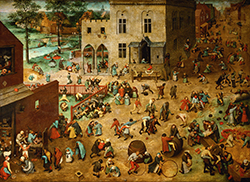 Painting by Pieter Bruegel the Elder: Children's Games The children, who range in age from toddlers to adolescents, roll hoops, walk on stilts, spin hoops, ride hobby-horses, stage mock tournaments, play leap-frog and blind man's bluff, perform handstands, inflate pigs' bladders and play with dolls and other toys. They have also taken over the large building that dominates the square: it may be a town hall or some other important civic building, in this way emphasizing the moral that the adults who direct civic affairs are as children in the sight of God. This crowded scene is to some extent relieved by the landscape in the top left-hand corner; but even here children are bathing in the river and playing on its banks. The artist's intention for this work is more serious than simply to compile an illustrated encyclopaedia of children's games, though some eighty particular games have been identified. Bruegel shows the children absorbed in their games with the seriousness displayed by adults in their apparently more important pursuits. His moral is that in the mind of God children's games possess as much significance as the activities of their parents.
Painting by Pieter Bruegel the Elder: Children's Games The children, who range in age from toddlers to adolescents, roll hoops, walk on stilts, spin hoops, ride hobby-horses, stage mock tournaments, play leap-frog and blind man's bluff, perform handstands, inflate pigs' bladders and play with dolls and other toys. They have also taken over the large building that dominates the square: it may be a town hall or some other important civic building, in this way emphasizing the moral that the adults who direct civic affairs are as children in the sight of God. This crowded scene is to some extent relieved by the landscape in the top left-hand corner; but even here children are bathing in the river and playing on its banks. The artist's intention for this work is more serious than simply to compile an illustrated encyclopaedia of children's games, though some eighty particular games have been identified. Bruegel shows the children absorbed in their games with the seriousness displayed by adults in their apparently more important pursuits. His moral is that in the mind of God children's games possess as much significance as the activities of their parents.
1560
 By winning the Battle of Okehazama, Oda Nobunaga becomes one of the pre-eminent warlords of Japan.
By winning the Battle of Okehazama, Oda Nobunaga becomes one of the pre-eminent warlords of Japan.
(no entry for this year)
1561
(no entry for this year)
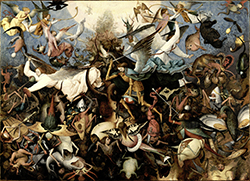 Painting by Pieter Bruegel the Elder: The Fall of the Rebel Angels The depiction of this subject is taken from a passage from the Book of Revelation (12, 2-9) and reveals the artist's profound debt to Hieronymous Bosch, especially in the grotesque figures of the fallen angels, shown as half-human, half-animal monsters. Together with Dulle Griet and The Triumph of Death, which have similar dimensions, it was probably painted for the same collector and destined to become part of a series.
Painting by Pieter Bruegel the Elder: The Fall of the Rebel Angels The depiction of this subject is taken from a passage from the Book of Revelation (12, 2-9) and reveals the artist's profound debt to Hieronymous Bosch, especially in the grotesque figures of the fallen angels, shown as half-human, half-animal monsters. Together with Dulle Griet and The Triumph of Death, which have similar dimensions, it was probably painted for the same collector and destined to become part of a series.
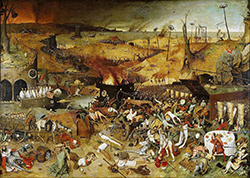 Painting by Pieter Bruegel the Elder: The Triumph of Death The painting shows a panorama of an army of skeletons wreaking havoc across a blackened, desolate landscape. Fires burn in the distance, and the sea is littered with shipwrecks. A few leafless trees stud hills otherwise bare of vegetation; fish lie rotting on the shores of a corpse-choked pond.
Painting by Pieter Bruegel the Elder: The Triumph of Death The painting shows a panorama of an army of skeletons wreaking havoc across a blackened, desolate landscape. Fires burn in the distance, and the sea is littered with shipwrecks. A few leafless trees stud hills otherwise bare of vegetation; fish lie rotting on the shores of a corpse-choked pond.
1562
Britain Joins Slave Trade. John Hawkins, the first Briton to take part in the slave trade, makes a huge profit hauling human cargo from Africa to Hispaniola.
(no entry for this year)
1563
(no entry for this year)
(no entry for this year)
1564
(no entry for this year)
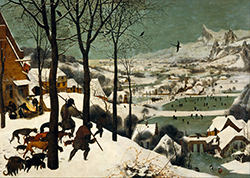 Painting by Pieter Bruegel the Elder: The Hunters in the Snow (Dutch: Jagers in de Sneeuw), also known as The Return of the Hunters, is a 1565 oil-on-wood painting by Flemish artist Pieter Bruegel the Elder. The Northern Renaissance work is one of a series of works, five of which still survive, that depict different times of the year. The Hunters in the Snow, and the series to which it belongs, are in the medieval and early Renaissance tradition of the Labours of the Months: depictions of various rural activities and work understood by a spectator in Breugel's time as representing the different months or times of the year.
Painting by Pieter Bruegel the Elder: The Hunters in the Snow (Dutch: Jagers in de Sneeuw), also known as The Return of the Hunters, is a 1565 oil-on-wood painting by Flemish artist Pieter Bruegel the Elder. The Northern Renaissance work is one of a series of works, five of which still survive, that depict different times of the year. The Hunters in the Snow, and the series to which it belongs, are in the medieval and early Renaissance tradition of the Labours of the Months: depictions of various rural activities and work understood by a spectator in Breugel's time as representing the different months or times of the year.
1565
(no entry for this year)
 Painting by Giuseppe Arcimboldo: The Four Elements a series of paintings that were commissioned by Maximilian II, Holy Roman Emperor. The portraits display figures in profile formed by different animals or objects. Earth is represented by land animals, Air by birds, Water by marine creatures and Fire by burning wood and cannons. This series attempts to express harmony out of chaos with wild animals forming distinct faces. It also praises Maximilian, suggesting that he is a ruler who controls even the four primal elements.
Painting by Giuseppe Arcimboldo: The Four Elements a series of paintings that were commissioned by Maximilian II, Holy Roman Emperor. The portraits display figures in profile formed by different animals or objects. Earth is represented by land animals, Air by birds, Water by marine creatures and Fire by burning wood and cannons. This series attempts to express harmony out of chaos with wild animals forming distinct faces. It also praises Maximilian, suggesting that he is a ruler who controls even the four primal elements.
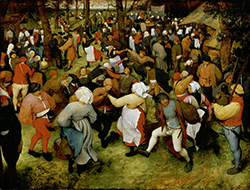 Painting by Pieter Bruegel the Elder: The Wedding Dance The painting depicts 125 wedding guests. As was customary in the Renaissance period, the brides wore black and men wore codpieces. Voyeurism is depicted throughout the entire art work; dancing was disapproved of by the authorities and the church, and the painting can be seen as both a critique and comic depiction of a stereotypical oversexed, overindulgent, peasant class of the times.
Painting by Pieter Bruegel the Elder: The Wedding Dance The painting depicts 125 wedding guests. As was customary in the Renaissance period, the brides wore black and men wore codpieces. Voyeurism is depicted throughout the entire art work; dancing was disapproved of by the authorities and the church, and the painting can be seen as both a critique and comic depiction of a stereotypical oversexed, overindulgent, peasant class of the times.
1566
(no entry for this year)
(no entry for this year)
1567
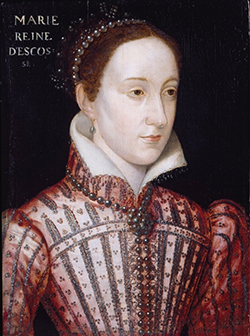 Mary, Queen of Scots, is imprisoned by Elizabeth I. Mary, the only surviving legitimate child of James V of Scotland, was six days old when her father died and she acceded to the throne. Mary had previously claimed Elizabeth's throne as her own and was considered the legitimate sovereign of England by many English Catholics, including participants in a rebellion known as the Rising of the North. Perceiving her as a threat, Elizabeth had her confined in various castles and manor houses in the interior of England. After eighteen and a half years in custody, Mary was found guilty of plotting to assassinate Elizabeth in 1586. She was beheaded the following year.
Mary, Queen of Scots, is imprisoned by Elizabeth I. Mary, the only surviving legitimate child of James V of Scotland, was six days old when her father died and she acceded to the throne. Mary had previously claimed Elizabeth's throne as her own and was considered the legitimate sovereign of England by many English Catholics, including participants in a rebellion known as the Rising of the North. Perceiving her as a threat, Elizabeth had her confined in various castles and manor houses in the interior of England. After eighteen and a half years in custody, Mary was found guilty of plotting to assassinate Elizabeth in 1586. She was beheaded the following year.
(no entry for this year)
1568
The Transylvanian Diet, under the patronage of the prince John Sigismund Zápolya, the former King of Hungary, inspired by the teachings of Ferenc Dávid, the founder of the Unitarian Church of Transylvania, promulgates the Edict of Torda, the first law of Freedom of religion and of conscience in the World.
(no entry for this year)
1569
(no entry for this year)
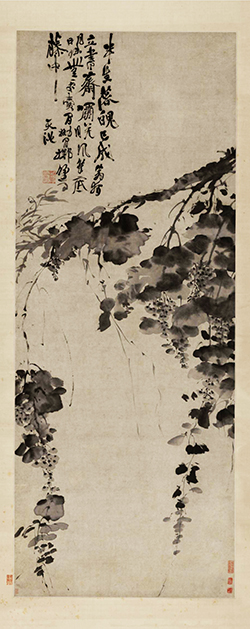 Painting by Xu Wei: Grapes, Xu Wei (1521-1593) took the scholar-bureaucrats' style of painting to an extreme, painting with hard to control, extremely wet puddles of ink. A minor bureaucrat himself, and also a successful playwright, he suffered repeated emotional breakdowns after his powerful mentor was arrested, attempting suicide at least five times and unintentionally murdering his second wife, for which he himself was imprisoned. His style of painting and handwriting is seen as reflecting his wild mental state, and not often imitated but much admired. Grapes, c. 1570, Palace Museum, Beijing. [JLS]
Painting by Xu Wei: Grapes, Xu Wei (1521-1593) took the scholar-bureaucrats' style of painting to an extreme, painting with hard to control, extremely wet puddles of ink. A minor bureaucrat himself, and also a successful playwright, he suffered repeated emotional breakdowns after his powerful mentor was arrested, attempting suicide at least five times and unintentionally murdering his second wife, for which he himself was imprisoned. His style of painting and handwriting is seen as reflecting his wild mental state, and not often imitated but much admired. Grapes, c. 1570, Palace Museum, Beijing. [JLS]
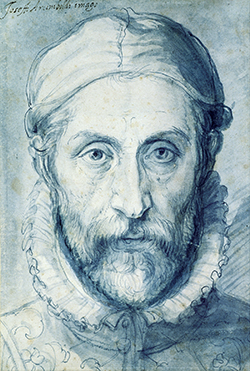 Painting by Giuseppe Arcimboldo: Self Portrait
Painting by Giuseppe Arcimboldo: Self Portrait
1570
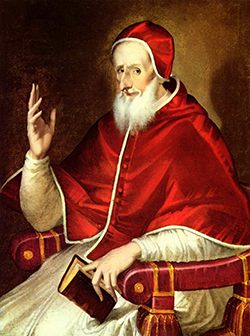 Pope Pius V issues Regnans in Excelsis, a papal bull excommunicating all who obeyed Elizabeth I and calling on all Roman Catholics to rebel against her.
Pope Pius V issues Regnans in Excelsis, a papal bull excommunicating all who obeyed Elizabeth I and calling on all Roman Catholics to rebel against her.
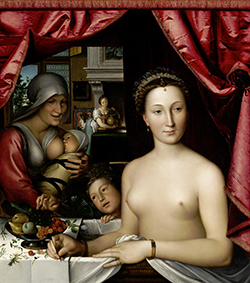 Painting by François Clouet: A Lady in Her Bath The picture is in the National Gallery of Art, Washington DC. It is one of only three paintings signed by Clouet. The bather is unknown. It is possible that she is Diane de Poitiers, mistress of King Henry II of France. Scholar Roger Trinquet suggested in 1966 that the lady is Mary Queen of Scots. The lady's face resembles other portraits of Mary, especially a drawing by Clouet depicting Mary in mourning. Trinquet believes the painting was intended as a satire for a Huguenot patron. The painting set a fashion for portraits of bathers.
Painting by François Clouet: A Lady in Her Bath The picture is in the National Gallery of Art, Washington DC. It is one of only three paintings signed by Clouet. The bather is unknown. It is possible that she is Diane de Poitiers, mistress of King Henry II of France. Scholar Roger Trinquet suggested in 1966 that the lady is Mary Queen of Scots. The lady's face resembles other portraits of Mary, especially a drawing by Clouet depicting Mary in mourning. Trinquet believes the painting was intended as a satire for a Huguenot patron. The painting set a fashion for portraits of bathers.
1571
The Ottoman Empire suffered a major defeat at the Battle of Lepanto, a naval battle fought against a coalition of Christian states led by the Holy League. Despite the loss, the Ottoman navy remained a dominant force in the Mediterranean.
(no entry for this year)
1572
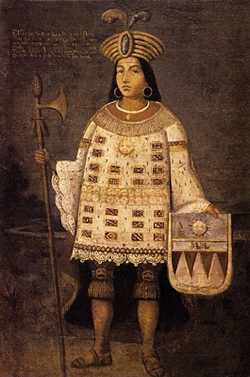 The last Inca leader Tupak Amaru apprehended by Spanish conquistadores at Vilcabamba, Peru, and executed in Cuzco.
The last Inca leader Tupak Amaru apprehended by Spanish conquistadores at Vilcabamba, Peru, and executed in Cuzco.
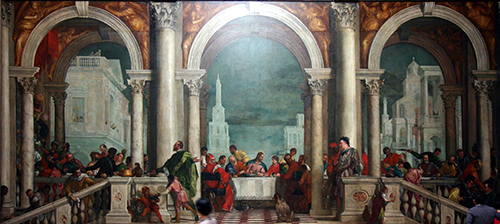 Painting by Paolo Veronese: The Feast in the House of Levi is one of the largest canvases of the 16th century, measuring 555 cm 1,280 cm (18.21 ft 41.99 ft). It is now in the Gallerie dell'Accademia in Venice. It was painted by Veronese for the rear wall of the refectory of the Basilica di Santi Giovanni e Paolo, a Dominican friary, as a Last Supper, to replace an earlier work by Titian destroyed in the fire of 1571. However, the painting led to an investigation by the Roman Catholic Inquisition. Veronese was called to answer for irreverence and indecorum, and the serious offence of heresy was mentioned. He was asked to explain why the painting contained "buffoons, drunken Germans, dwarfs and other such scurrilities" as well as extravagant costumes and settings, in what is indeed a fantasy version of a Venetian patrician feast. Veronese was told that he must change his painting within a three-month period; instead, he simply changed the title to The Feast in the House of Levi, still an episode from the Gospels, but less doctrinally central, and one in which the Gospels specified "sinners" as present. After this, no more was said.
Painting by Paolo Veronese: The Feast in the House of Levi is one of the largest canvases of the 16th century, measuring 555 cm 1,280 cm (18.21 ft 41.99 ft). It is now in the Gallerie dell'Accademia in Venice. It was painted by Veronese for the rear wall of the refectory of the Basilica di Santi Giovanni e Paolo, a Dominican friary, as a Last Supper, to replace an earlier work by Titian destroyed in the fire of 1571. However, the painting led to an investigation by the Roman Catholic Inquisition. Veronese was called to answer for irreverence and indecorum, and the serious offence of heresy was mentioned. He was asked to explain why the painting contained "buffoons, drunken Germans, dwarfs and other such scurrilities" as well as extravagant costumes and settings, in what is indeed a fantasy version of a Venetian patrician feast. Veronese was told that he must change his painting within a three-month period; instead, he simply changed the title to The Feast in the House of Levi, still an episode from the Gospels, but less doctrinally central, and one in which the Gospels specified "sinners" as present. After this, no more was said.
1573
(no entry for this year)
(no entry for this year)
1574
(no entry for this year)
(no entry for this year)
1575
(no entry for this year)
(no entry for this year)
1576
English navigator Martin Frobisher sights Greenland.
(no entry for this year)
1577
(no entry for this year)
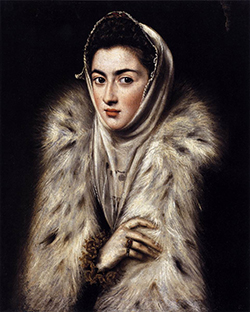 Painting by El Greco: Lady in a Fur Wrap against a dark background a young woman gazes at the viewer, dressed in a fur robe covering the rest of her dress. A fine transparent veil covers her head, and vaguely a neckace can be seen that she is wearing underneath it. The robe falls into darkness behind its fur lining, that may be ermine or lynx. The painting is unsigned but has traditionally been attributed to El Greco since it was in the collection of French king Louis Philippe I and hung at the Louvre.
Painting by El Greco: Lady in a Fur Wrap against a dark background a young woman gazes at the viewer, dressed in a fur robe covering the rest of her dress. A fine transparent veil covers her head, and vaguely a neckace can be seen that she is wearing underneath it. The robe falls into darkness behind its fur lining, that may be ermine or lynx. The painting is unsigned but has traditionally been attributed to El Greco since it was in the collection of French king Louis Philippe I and hung at the Louvre.
1578
(no entry for this year)
(no entry for this year)
1579
Francis Drake, during his circumnavigation of the world, lands in what is now California, which he claims for Queen Elizabeth I of England as Nova Albion.
(no entry for this year)
1580
Francis Drake in the Golden Hind sails into Plymouth having completed the second circumnavigation of the world, westabout, begun in 1577.
Spain unifies with Portugal under Philip II. The struggle for the throne of Portugal ends the Portuguese Empire. The Spanish and Portuguese crowns are united for 60 years, i.e. until 1640.
(no entry for this year)
1581
Slaves in Florida Spanish residents in St. Augustine, the first permanent settlement in Florida, import African slaves.
(no entry for this year)
1582
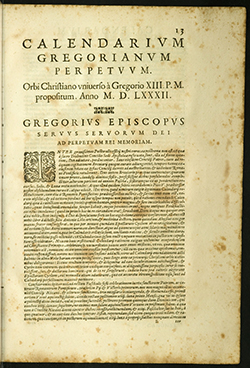 Pope Gregory XIII issues papal bull Inter Gravissimas, thereby establishing the The Gregorian Calendar. The last day of the Julian calendar was Thursday, 4 October 1582 and this was followed by the first day of the Gregorian calendar, Friday, 15 October 1582.
Pope Gregory XIII issues papal bull Inter Gravissimas, thereby establishing the The Gregorian Calendar. The last day of the Julian calendar was Thursday, 4 October 1582 and this was followed by the first day of the Gregorian calendar, Friday, 15 October 1582.
(no entry for this year)
1583
(no entry for this year)
(no entry for this year)
1584
Walter Raleigh sends Philip Amadas and Arthur Barlowe to explore the Outer Banks of Virginia (now North Carolina), with a view to establishing an English colony; they locate Roanoke Island.
(no entry for this year)
1585
(no entry for this year)
(no entry for this year)
1586
(no entry for this year)
(no entry for this year)
1587
Mary, Queen of Scots, is executed by Elizabeth I.
(no entry for this year)
1588
(no entry for this year)
(no entry for this year)
1589
(no entry for this year)
(no entry for this year)
1590
At the Siege of Odawara the Go-Hojo clan surrendered to Toyotomi Hideyoshi, unifying Japan.
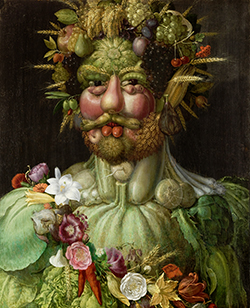 Painting by Giuseppe Arcimboldo: Vertumnus The painting is Arcimboldo's most famous work and is a portrait of the Holy Roman Emperor Rudolf II re-imagined as Vertumnus, the Roman god of metamorphoses in nature and life; the fruits and vegetables symbolize the abundance of the Golden Age that has returned under the Emperor's rule. Looking from the distance, Arcimboldo's whimsical portraits might look like portraits, but they are assembled using vegetables, books, plants, kitchen utensils, oils, fruits, sea creatures, animals and tree roots, each individual object chosen to give the impression of anatomical trait of a human face. The portrait of the emperor is created out of plants — flowers and fruits from all seasons: gourds, pears, apples, cherries, grapes, wheat, artichokes, peapods, corns, onions, artichoke, cabbage foils, cherries, chestnuts, figs, mulberries, grapes, plums, pomegranates, various pumpkins and olives. Rudolf's portrait is composed of fruit, vegetables and flowers were to symbolize the perfect balance and harmony with nature that his reign represented. These portraits were an expression of the Renaissance mind's fascination with riddles, puzzles, and the bizarre.
Painting by Giuseppe Arcimboldo: Vertumnus The painting is Arcimboldo's most famous work and is a portrait of the Holy Roman Emperor Rudolf II re-imagined as Vertumnus, the Roman god of metamorphoses in nature and life; the fruits and vegetables symbolize the abundance of the Golden Age that has returned under the Emperor's rule. Looking from the distance, Arcimboldo's whimsical portraits might look like portraits, but they are assembled using vegetables, books, plants, kitchen utensils, oils, fruits, sea creatures, animals and tree roots, each individual object chosen to give the impression of anatomical trait of a human face. The portrait of the emperor is created out of plants — flowers and fruits from all seasons: gourds, pears, apples, cherries, grapes, wheat, artichokes, peapods, corns, onions, artichoke, cabbage foils, cherries, chestnuts, figs, mulberries, grapes, plums, pomegranates, various pumpkins and olives. Rudolf's portrait is composed of fruit, vegetables and flowers were to symbolize the perfect balance and harmony with nature that his reign represented. These portraits were an expression of the Renaissance mind's fascination with riddles, puzzles, and the bizarre.
1591
(no entry for this year)
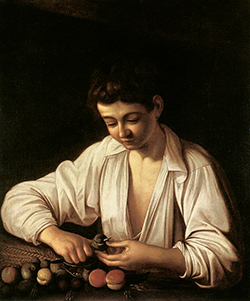 Painting by Caravaggio: Boy Peeling Fruit This is the earliest known work by Caravaggio, painted soon after his arrival in Rome from his native Milan in mid 1592. The fruit being peeled by the boy is something of a mystery. Sources indicate it may be a pear, which is probably correct but has been questioned; it may be a nectarine or plum, several of which lie on the table, but these are not usually peeled; some have suggested a bergamot, a pear-shaped citrus fruit grown in Italy, but others object that the bergamot is sour and practically inedible. Seen as a simple genre painting, it differs from most in that the boy is not 'rusticated,' that is, he is depicted as clean and well-dressed instead of as a 'cute' ragamuffin. An allegoric meaning behind the painting is plausible, given the complex Renaissance symbology of fruit. Caravaggio scholar John T. Spike has recently suggested that the boy demonstrates resistance to temptation by ignoring the sweeter fruits (fruits of sin) in favour of the bergamot, but no specific reading is widely accepted.
Painting by Caravaggio: Boy Peeling Fruit This is the earliest known work by Caravaggio, painted soon after his arrival in Rome from his native Milan in mid 1592. The fruit being peeled by the boy is something of a mystery. Sources indicate it may be a pear, which is probably correct but has been questioned; it may be a nectarine or plum, several of which lie on the table, but these are not usually peeled; some have suggested a bergamot, a pear-shaped citrus fruit grown in Italy, but others object that the bergamot is sour and practically inedible. Seen as a simple genre painting, it differs from most in that the boy is not 'rusticated,' that is, he is depicted as clean and well-dressed instead of as a 'cute' ragamuffin. An allegoric meaning behind the painting is plausible, given the complex Renaissance symbology of fruit. Caravaggio scholar John T. Spike has recently suggested that the boy demonstrates resistance to temptation by ignoring the sweeter fruits (fruits of sin) in favour of the bergamot, but no specific reading is widely accepted.
1592
(no entry for this year)
(no entry for this year)
1593
(no entry for this year)
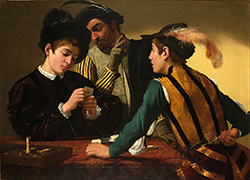 Painting by Caravaggio: Cardsharps The work represents an important milestone for Caravaggio. He painted it when he was attempting an independent career after leaving the workshop of the Cavaliere Giuseppe Cesari d'Arpino, for whom he had been painting "flowers and fruit", finishing the details for the Cavaliere's mass-produced (and massive) output. Caravaggio left Arpino's workshop in January 1594 and began selling works through the dealer Costantino, with the assistance of Prospero Orsi, an established painter of Mannerist grotesques (masks, monsters, etc.). Orsi introduced Caravaggio to his extensive network of contacts in the world of collectors and patrons. Composition The painting shows an expensively-dressed but unworldly boy playing cards with another boy. The second boy, a cardsharp, has extra cards tucked in his belt behind his back, out of sight of the mark but not the viewer, and a sinister older man is peering over the dupe's shoulder and signaling to his young accomplice. The second boy has a dagger handy at his side, and violence is not far away.
Painting by Caravaggio: Cardsharps The work represents an important milestone for Caravaggio. He painted it when he was attempting an independent career after leaving the workshop of the Cavaliere Giuseppe Cesari d'Arpino, for whom he had been painting "flowers and fruit", finishing the details for the Cavaliere's mass-produced (and massive) output. Caravaggio left Arpino's workshop in January 1594 and began selling works through the dealer Costantino, with the assistance of Prospero Orsi, an established painter of Mannerist grotesques (masks, monsters, etc.). Orsi introduced Caravaggio to his extensive network of contacts in the world of collectors and patrons. Composition The painting shows an expensively-dressed but unworldly boy playing cards with another boy. The second boy, a cardsharp, has extra cards tucked in his belt behind his back, out of sight of the mark but not the viewer, and a sinister older man is peering over the dupe's shoulder and signaling to his young accomplice. The second boy has a dagger handy at his side, and violence is not far away.
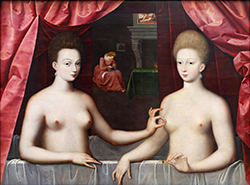 Painting by unknown artist: Gabrielle d'Estrées et une de soeurs The painting now hangs at the Louvre in Paris and is usually thought to be the work of a painter from the Fontainebleau School. The painting portrays Gabrielle d'Estrées, mistress of King Henry IV of France, sitting nude in a bath, holding a ring. Her sister sits nude beside her and pinches her right nipple. The nipple-pinching gesture is often interpreted as a symbolic announcement that Gabrielle is pregnant with Henry's child, César de Bourbon. According to the Louvre's website: "The oddly affectionate way in which the sister is pinching Gabrielle d'Estrées' right breast has often been taken as symbolizing the latter's pregnancy with the illegitimate child of Henry IV. This interpretation would seem to be confirmed by the scene of the young woman sewing — perhaps preparing a layette for the coming child — in the background." The ring that Gabrielle holds is said to be Henry's coronation ring, which he supposedly gave to her as a token of his love shortly before she died.
Painting by unknown artist: Gabrielle d'Estrées et une de soeurs The painting now hangs at the Louvre in Paris and is usually thought to be the work of a painter from the Fontainebleau School. The painting portrays Gabrielle d'Estrées, mistress of King Henry IV of France, sitting nude in a bath, holding a ring. Her sister sits nude beside her and pinches her right nipple. The nipple-pinching gesture is often interpreted as a symbolic announcement that Gabrielle is pregnant with Henry's child, César de Bourbon. According to the Louvre's website: "The oddly affectionate way in which the sister is pinching Gabrielle d'Estrées' right breast has often been taken as symbolizing the latter's pregnancy with the illegitimate child of Henry IV. This interpretation would seem to be confirmed by the scene of the young woman sewing — perhaps preparing a layette for the coming child — in the background." The ring that Gabrielle holds is said to be Henry's coronation ring, which he supposedly gave to her as a token of his love shortly before she died.
1594
(no entry for this year)
(no entry for this year)
1595
A Spanish expedition led by lvaro de Menda a de Neira makes the first European landing in Polynesia, on the Marquesas Islands.
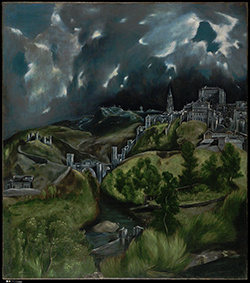 Painting by El Greco: View of Toledo is one of the two surviving landscapes painted by El Greco. The other, View and Plan of Toledo lies at Museo Del Greco, Toledo, Spain. View of Toledo is among the best known depictions of the sky in Western art, along with Vincent van Gogh's The Starry Night and the landscapes of William Turner and Monet, among others. Most notable is the distinct color contrast between the dark and somber skies above and the glowing green hills below. While influenced by the Mannerist style, El Greco's expressive handling of color and form is without parallel in the history of art. In this painting, he takes liberties with the actual layout of Toledo insofar as certain building locations are re-arranged. However, the location of the Castle of San Servando, on the right, is accurately depicted. El Greco's signature appears in the lower-right corner.
Painting by El Greco: View of Toledo is one of the two surviving landscapes painted by El Greco. The other, View and Plan of Toledo lies at Museo Del Greco, Toledo, Spain. View of Toledo is among the best known depictions of the sky in Western art, along with Vincent van Gogh's The Starry Night and the landscapes of William Turner and Monet, among others. Most notable is the distinct color contrast between the dark and somber skies above and the glowing green hills below. While influenced by the Mannerist style, El Greco's expressive handling of color and form is without parallel in the history of art. In this painting, he takes liberties with the actual layout of Toledo insofar as certain building locations are re-arranged. However, the location of the Castle of San Servando, on the right, is accurately depicted. El Greco's signature appears in the lower-right corner.
1596
(no entry for this year)
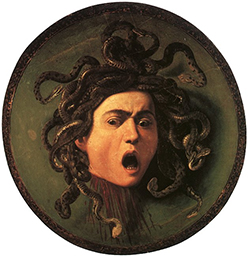 Painting by Caravaggio: Medusa Caravaggio painted two versions of Medusa, the first in 1596 and the other presumably in 1597. The first version is also known as Murtula, by the name of the poet who wrote about it, Gaspare Murtola (d. 1624): "Flee, for if your eyes are petrified in amazement, she will turn you to stone." It measures 48 by 55 cm and is signed Michel A F (Latin: Michel Angelo Fecit), "Michel Angelo made [this]", Michelangelo being Caravaggio's first name. This work is privately owned. The second version, shown here, is slightly bigger (60 × 55 cm) and is not signed; it is held in the Uffizi Gallery in Florence.
Painting by Caravaggio: Medusa Caravaggio painted two versions of Medusa, the first in 1596 and the other presumably in 1597. The first version is also known as Murtula, by the name of the poet who wrote about it, Gaspare Murtola (d. 1624): "Flee, for if your eyes are petrified in amazement, she will turn you to stone." It measures 48 by 55 cm and is signed Michel A F (Latin: Michel Angelo Fecit), "Michel Angelo made [this]", Michelangelo being Caravaggio's first name. This work is privately owned. The second version, shown here, is slightly bigger (60 × 55 cm) and is not signed; it is held in the Uffizi Gallery in Florence.
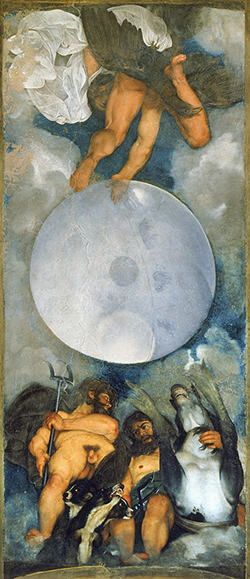 Painting by Michelangelo Merisi da Caravaggio: Jupiter, Neptune and Pluto According to an early biographer, one of Caravaggio's aims was to discredit critics who claimed that he had no grasp of perspective. The three figures demonstrate the most dramatic foreshortening imaginable. They contradict claims that Caravaggio always painted from live models. The artist seems to have used his own face for all three gods. The painting was done for Caravaggio's patron Cardinal Francesco Maria Del Monte and painted on the ceiling of the cardinal's garden casino of his country estate, which later became known as the Villa Ludovisi. The cardinal had a keen interest alchemy. Caravaggio has painted an allegory of the alchemical triad of Paracelsus: Jupiter stands for sulphur and air, Neptune for mercury and water, and Pluto for salt and earth. Each figure is identified by his beast: Jupiter by the eagle, Neptune by the hippocamp, and Pluto by the three-headed dog Cerberus. Jupiter is reaching out to move the celestial sphere in which the Sun revolves around the Earth. Galileo was a friend of Del Monte but had yet to make his mark on cosmology.
Painting by Michelangelo Merisi da Caravaggio: Jupiter, Neptune and Pluto According to an early biographer, one of Caravaggio's aims was to discredit critics who claimed that he had no grasp of perspective. The three figures demonstrate the most dramatic foreshortening imaginable. They contradict claims that Caravaggio always painted from live models. The artist seems to have used his own face for all three gods. The painting was done for Caravaggio's patron Cardinal Francesco Maria Del Monte and painted on the ceiling of the cardinal's garden casino of his country estate, which later became known as the Villa Ludovisi. The cardinal had a keen interest alchemy. Caravaggio has painted an allegory of the alchemical triad of Paracelsus: Jupiter stands for sulphur and air, Neptune for mercury and water, and Pluto for salt and earth. Each figure is identified by his beast: Jupiter by the eagle, Neptune by the hippocamp, and Pluto by the three-headed dog Cerberus. Jupiter is reaching out to move the celestial sphere in which the Sun revolves around the Earth. Galileo was a friend of Del Monte but had yet to make his mark on cosmology.
1597
(no entry for this year)
(no entry for this year)
1598
(no entry for this year)
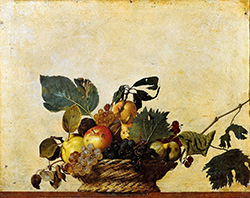 Painting by Caravaggio: Basket of Fruit a still life painting which hangs in the Biblioteca Ambrosiana (Ambrosian Library), Milan. It shows a wicker basket perched on the edge of a ledge. The basket contains a selection of summer fruit. Much has been made of the worm-eaten, insect-predated, and generally less than perfect condition of the fruit. In line with the culture of the age, the general theme appears to revolve about the fading beauty, and the natural decaying of all things. Scholars also describe the basket of fruit as a metaphor of the Church. A recent X-ray study revealed that it was painted on an already used canvas painted with grotesques in the style of Caravaggio's friend Prospero Orsi, who helped the artist in his first breakthrough into the circles of collectors such as his first patron, Cardinal Francesco Maria Del Monte, around 1594/1595, and who remained close to him for many years thereafter.
Painting by Caravaggio: Basket of Fruit a still life painting which hangs in the Biblioteca Ambrosiana (Ambrosian Library), Milan. It shows a wicker basket perched on the edge of a ledge. The basket contains a selection of summer fruit. Much has been made of the worm-eaten, insect-predated, and generally less than perfect condition of the fruit. In line with the culture of the age, the general theme appears to revolve about the fading beauty, and the natural decaying of all things. Scholars also describe the basket of fruit as a metaphor of the Church. A recent X-ray study revealed that it was painted on an already used canvas painted with grotesques in the style of Caravaggio's friend Prospero Orsi, who helped the artist in his first breakthrough into the circles of collectors such as his first patron, Cardinal Francesco Maria Del Monte, around 1594/1595, and who remained close to him for many years thereafter.
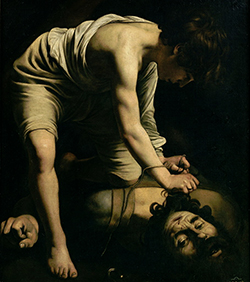 Painting by Caravaggio: David and Goliath The David and Goliath in the Prado was painted in the early part of the artist's career, while he was a member of the household of Cardinal Francesco Maria Del Monte. It shows the Biblical David as a young boy (in accordance with the Bible story) fastening the head of the champion of the Philistines, the giant Goliath, by the hair. The light catches on David's leg, arm and flank, on the massive shoulders from which Goliath's head has been severed, and on the head itself, but everything else is dark. Even David's face is almost invisible in the shadows. A wound on Goliath's forehead shows where he has been felled by the stone from David's sling. The overwhelming impression is of some action intensely personal and private — no triumph, no armies, no victory.
Painting by Caravaggio: David and Goliath The David and Goliath in the Prado was painted in the early part of the artist's career, while he was a member of the household of Cardinal Francesco Maria Del Monte. It shows the Biblical David as a young boy (in accordance with the Bible story) fastening the head of the champion of the Philistines, the giant Goliath, by the hair. The light catches on David's leg, arm and flank, on the massive shoulders from which Goliath's head has been severed, and on the head itself, but everything else is dark. Even David's face is almost invisible in the shadows. A wound on Goliath's forehead shows where he has been felled by the stone from David's sling. The overwhelming impression is of some action intensely personal and private — no triumph, no armies, no victory.
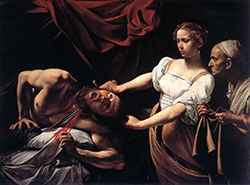 Painting by Caravaggio: Judith Beheading Holofernes The widow Judith first charms the Assyrian general Holofernes, then decapitates him in his tent. The painting was rediscovered in 1950 and is part of the collection of the Galleria Nazionale d'Arte Antica in Rome. The deutero-canonical Book of Judith tells how Judith served her people by seducing and pleasuring Holofernes, the Assyrian general. Judith gets Holofernes drunk, then seizes her sword and slays him: "Approaching to his bed, she took hold of the hair of his head." (Judith, 13:7-8). Caravaggio's approach was, typically, to choose the moment of greatest dramatic impact, the moment of the decapitation itself. The figures are set out in a shallow stage, theatrically lit from the side, isolated against the inky, black background. Judith and her maid Abra stand to the right, partially over Holofernes, who is vulnerable on his back. X-rays have revealed that Caravaggio adjusted the placement of Holofernes' head as he proceeded, separating it slightly from the torso and moving it slightly to the right. The faces of the three characters demonstrate his mastery of emotion, Judith in particular showing in her face a mix of determination and repulsion. Artemisia Gentileschi and others were deeply influenced by this work, and even surpassed Caravaggio's physical realism, but it has been argued that none matched his capture of Judith's psychological ambivalence.
Painting by Caravaggio: Judith Beheading Holofernes The widow Judith first charms the Assyrian general Holofernes, then decapitates him in his tent. The painting was rediscovered in 1950 and is part of the collection of the Galleria Nazionale d'Arte Antica in Rome. The deutero-canonical Book of Judith tells how Judith served her people by seducing and pleasuring Holofernes, the Assyrian general. Judith gets Holofernes drunk, then seizes her sword and slays him: "Approaching to his bed, she took hold of the hair of his head." (Judith, 13:7-8). Caravaggio's approach was, typically, to choose the moment of greatest dramatic impact, the moment of the decapitation itself. The figures are set out in a shallow stage, theatrically lit from the side, isolated against the inky, black background. Judith and her maid Abra stand to the right, partially over Holofernes, who is vulnerable on his back. X-rays have revealed that Caravaggio adjusted the placement of Holofernes' head as he proceeded, separating it slightly from the torso and moving it slightly to the right. The faces of the three characters demonstrate his mastery of emotion, Judith in particular showing in her face a mix of determination and repulsion. Artemisia Gentileschi and others were deeply influenced by this work, and even surpassed Caravaggio's physical realism, but it has been argued that none matched his capture of Judith's psychological ambivalence.
1599
(no entry for this year)
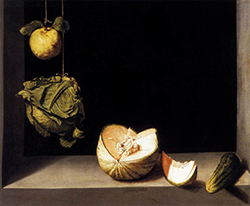 Painting by Juan Sánchez Cotán: Still Life With Quince, Cabbage, Melon, and Cucumber
Painting by Juan Sánchez Cotán: Still Life With Quince, Cabbage, Melon, and Cucumber
1600
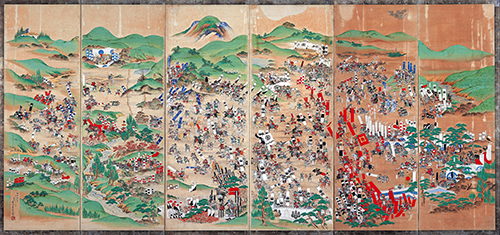 Battle of Sekigahara in Japan. End of the Warring States period and beginning of the Edo period.
Battle of Sekigahara in Japan. End of the Warring States period and beginning of the Edo period.
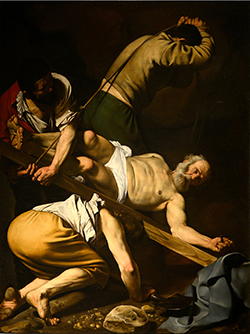 Painting by Caravaggio: Crucifixion of Saint Peter was painted for the Cerasi Chapel of Santa Maria del Popolo in Rome. Across the chapel is a second Caravaggio work depicting the Conversion of Saint Paul on the Road to Damascus (1601). On the altar between the two is an Assumption of the Virgin Mary by Annibale Carracci. The painting depicts the martyrdom of St. Peter by crucifixion Peter asked that his cross be inverted so as not to imitate his God, Jesus Christ, hence he is depicted upside down. The large canvas shows Ancient Romans, their faces shielded, struggling to erect the cross of the elderly but muscular apostle. Peter is heavier than his aged body would suggest, and his lifting requires the efforts of three men, as if the crime they perpetrate already weighs on them.
Painting by Caravaggio: Crucifixion of Saint Peter was painted for the Cerasi Chapel of Santa Maria del Popolo in Rome. Across the chapel is a second Caravaggio work depicting the Conversion of Saint Paul on the Road to Damascus (1601). On the altar between the two is an Assumption of the Virgin Mary by Annibale Carracci. The painting depicts the martyrdom of St. Peter by crucifixion Peter asked that his cross be inverted so as not to imitate his God, Jesus Christ, hence he is depicted upside down. The large canvas shows Ancient Romans, their faces shielded, struggling to erect the cross of the elderly but muscular apostle. Peter is heavier than his aged body would suggest, and his lifting requires the efforts of three men, as if the crime they perpetrate already weighs on them.
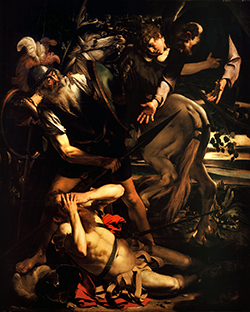 Painting by Caravaggio: The Conversion of St. Paul records the moment when Saul of Tarsus, on his way to Damascus to annihilate the Christian community there, is struck blind by a brilliant light and hears the voice of Christ saying, "Saul, Saul, why persecutest thou me?...And they that were with me saw indeed the light, and were afraid, but they heard not the voice..." (Acts 22:6-11). Elsewhere Paul claims to have seen Christ during the vision, and it is on this basis that he grounds his claim be recognised as an Apostle: "Have I not seen Jesus Christ our Lord?" (I Corinthians 9:1). Caravaggio biographer Helen Langdon describes style of Conversion as "an odd blend of Raphael and clumsy rustic realism," but notes how the composition, with its jagged shapes and irrational light which licks out details for their dramatic impact, creates "a sense of crisis and dislocation [in which] Christ disrupts the mundane world."
Painting by Caravaggio: The Conversion of St. Paul records the moment when Saul of Tarsus, on his way to Damascus to annihilate the Christian community there, is struck blind by a brilliant light and hears the voice of Christ saying, "Saul, Saul, why persecutest thou me?...And they that were with me saw indeed the light, and were afraid, but they heard not the voice..." (Acts 22:6-11). Elsewhere Paul claims to have seen Christ during the vision, and it is on this basis that he grounds his claim be recognised as an Apostle: "Have I not seen Jesus Christ our Lord?" (I Corinthians 9:1). Caravaggio biographer Helen Langdon describes style of Conversion as "an odd blend of Raphael and clumsy rustic realism," but notes how the composition, with its jagged shapes and irrational light which licks out details for their dramatic impact, creates "a sense of crisis and dislocation [in which] Christ disrupts the mundane world."
1601
(no entry for this year)
(no entry for this year)
1602
The Dutch East India Company (VOC) is established by merging competing Dutch trading companies.[4] Its success contributes to the Dutch Golden Age.
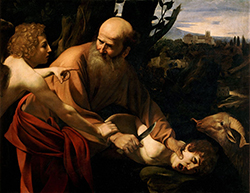 Painting by Caravaggio: Sacrifice of Isaac The Sacrifice of Isaac is the title of two paintings from c. 1598 - 1603 depicting the sacrifice of Isaac. The paintings could be painted by the Italian master Caravaggio (1571 1610) but there is also strong evidence that they may have been the work of Bartolomeo Cavarozzi, a talented early member of the Caravaggio following who is known to have been in Spain about 1617-1619. The second Sacrifice of Isaac is housed in the Uffizi Gallery, Florence. According to the early biographer Giovanni Bellori, Caravaggio painted a version of this subject for Cardinal Maffeo Barberini, the future Pope Urban VIII, and a series of payments totalling one hundred scudi were made to the artist by Barberini between May 1603 and January 1604. Caravaggio had previously painted a Portrait of Maffeo Barberini, which presumably pleased the cardinal enough for him to commission this second painting. Isaac has been identified as Cecco Boneri, who appeared as Caravaggio's model in several other pictures. Recent X-ray analysis showed that Caravaggio used Cecco also for the angel, and later modified the profile and the hair to hide the resemblance.
Painting by Caravaggio: Sacrifice of Isaac The Sacrifice of Isaac is the title of two paintings from c. 1598 - 1603 depicting the sacrifice of Isaac. The paintings could be painted by the Italian master Caravaggio (1571 1610) but there is also strong evidence that they may have been the work of Bartolomeo Cavarozzi, a talented early member of the Caravaggio following who is known to have been in Spain about 1617-1619. The second Sacrifice of Isaac is housed in the Uffizi Gallery, Florence. According to the early biographer Giovanni Bellori, Caravaggio painted a version of this subject for Cardinal Maffeo Barberini, the future Pope Urban VIII, and a series of payments totalling one hundred scudi were made to the artist by Barberini between May 1603 and January 1604. Caravaggio had previously painted a Portrait of Maffeo Barberini, which presumably pleased the cardinal enough for him to commission this second painting. Isaac has been identified as Cecco Boneri, who appeared as Caravaggio's model in several other pictures. Recent X-ray analysis showed that Caravaggio used Cecco also for the angel, and later modified the profile and the hair to hide the resemblance.
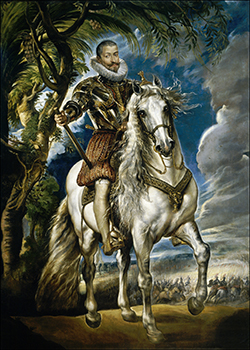 Painting by Peter Paul Rubens: The Duke of Lerma on Horseback. When he visited the Spanish Court for the first time, Rubens (still in his twenties) used this picture to display his talents and to make his mark. It has already many elements of his mature Baroque style, which would have been novel and striking to his viewers. The way in which the horse seems to surge forward towards the spectator - an effect engineered by the low viewpoint and lack of balancing elements in the foreground, and recalling the techniques of Caravaggio - was spectacular, and broke with the traditional profile of equestrian portraits. Other devices used to enhance the spectacle were the eccentric colouring, the tempestuous lighting, and the rather disquieting energy of the horse's hair and the trees' foliage.
Painting by Peter Paul Rubens: The Duke of Lerma on Horseback. When he visited the Spanish Court for the first time, Rubens (still in his twenties) used this picture to display his talents and to make his mark. It has already many elements of his mature Baroque style, which would have been novel and striking to his viewers. The way in which the horse seems to surge forward towards the spectator - an effect engineered by the low viewpoint and lack of balancing elements in the foreground, and recalling the techniques of Caravaggio - was spectacular, and broke with the traditional profile of equestrian portraits. Other devices used to enhance the spectacle were the eccentric colouring, the tempestuous lighting, and the rather disquieting energy of the horse's hair and the trees' foliage.
1603
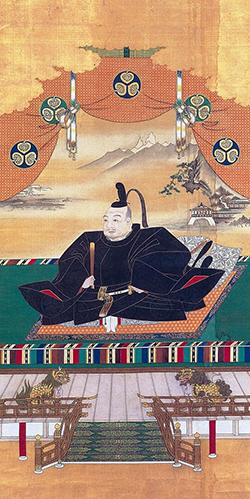 Tokugawa Ieyasu takes the title of Shogun, establishing the Tokugawa Shogunate. This begins the Edo period, which will last until 1869.
Tokugawa Ieyasu takes the title of Shogun, establishing the Tokugawa Shogunate. This begins the Edo period, which will last until 1869.
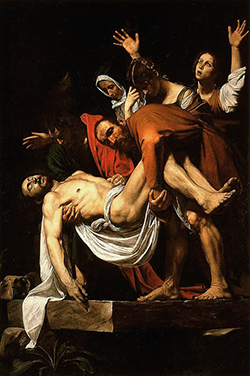 Painting by Caravaggio: The Entombment of Christ, one of the artist's most admired altarpieces, was created for the second chapel on the right in Santa Maria in Vallicella (the Chiesa Nuova), a church built for the Oratory of Saint Philip Neri. A copy of the painting is now in the chapel, and the original is in the Vatican Pinacoteca. The painting has been copied by artists as diverse as Rubens, Fragonard, Géricault and Cézanne.
Painting by Caravaggio: The Entombment of Christ, one of the artist's most admired altarpieces, was created for the second chapel on the right in Santa Maria in Vallicella (the Chiesa Nuova), a church built for the Oratory of Saint Philip Neri. A copy of the painting is now in the chapel, and the original is in the Vatican Pinacoteca. The painting has been copied by artists as diverse as Rubens, Fragonard, Géricault and Cézanne.
1604
(no entry for this year)
(no entry for this year)
1605
Johann Carolus of Germany publishes the 'Relation', the first newspaper.
Tokugawa Ieyasu passes the title of Shogun to his son, Tokugawa Hidetada, and "retires" to Sunpu.
(no entry for this year)
1606
Captain Willem Janszoon and his crew aboard the Dutch East India Company ship Duyfken becomes the first recorded Europeans to sight and make landfall in Australia.
(no entry for this year)
1607
Jamestown, Virginia, is settled as what would become the first permanent English colony in North America.
(no entry for this year)
1608
Quebec City founded by Samuel de Champlain in New France (present-day Canada).
(no entry for this year)
1609
(no entry for this year)
 Painting by Dong Qichang: River and Mountains on a Clear Autumn Day. Dong Qichang (1555–1636), high ranking court official, develops a pictorial scheme for landscape painting composed of limited, repeated component parts, strong and often tilted ground planes, and regulated brushstrokes that becomes high influential over the next two centuries of Chinese landscape painting. He propounded a view of history (inaccurate in many ways) that suggests a long tradition of lofty amateur artists of the elite class of court bureaucrats had favored his more calligraphic mode of painting practice, in contrast to small-minded professional painters who paid more attention to representational accuracy and detail. European influence in his work, via Jesuits at the Ming dynasty court, is possible. [JLS]
Painting by Dong Qichang: River and Mountains on a Clear Autumn Day. Dong Qichang (1555–1636), high ranking court official, develops a pictorial scheme for landscape painting composed of limited, repeated component parts, strong and often tilted ground planes, and regulated brushstrokes that becomes high influential over the next two centuries of Chinese landscape painting. He propounded a view of history (inaccurate in many ways) that suggests a long tradition of lofty amateur artists of the elite class of court bureaucrats had favored his more calligraphic mode of painting practice, in contrast to small-minded professional painters who paid more attention to representational accuracy and detail. European influence in his work, via Jesuits at the Ming dynasty court, is possible. [JLS]
1610
(no entry for this year)
(no entry for this year)
1611
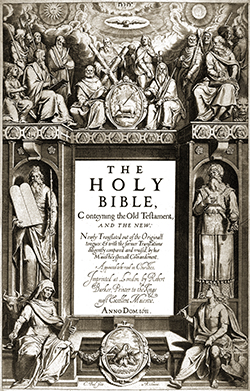 King James Bible is first published. The KJV is an English translation of the Christian Bible for the Church of England begun in 1604 and completed in 1611. The books of the King James Version include the 39 books of the Old Testament, an intertestamental section containing 14 books of the Apocrypha (most of which correspond to books in the Vulgate Deuterocanon adhered to by Roman Catholics), and the 27 books of the New Testament. It was first printed by the King's Printer Robert Barker and was the third translation into English approved by the English Church authorities.
King James Bible is first published. The KJV is an English translation of the Christian Bible for the Church of England begun in 1604 and completed in 1611. The books of the King James Version include the 39 books of the Old Testament, an intertestamental section containing 14 books of the Apocrypha (most of which correspond to books in the Vulgate Deuterocanon adhered to by Roman Catholics), and the 27 books of the New Testament. It was first printed by the King's Printer Robert Barker and was the third translation into English approved by the English Church authorities.
(no entry for this year)
1612
The first commercial tobacco crop is raised in Jamestown, Virginia.
Shakespeare's last play, Henry VIII, is published.
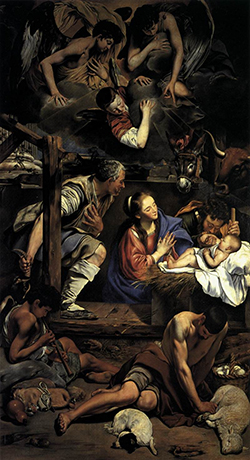 Painting by Juan Bautista Maíno: The Adoration of the Shepherds
Painting by Juan Bautista Maíno: The Adoration of the Shepherds
1613
(no entry for this year)
(no entry for this year)
1614
(no entry for this year)
(no entry for this year)
1615
(no entry for this year)
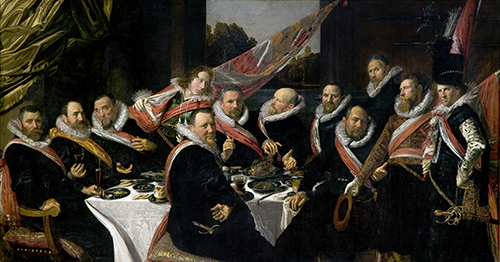 Painting by Frans Hals: Banquet of the Officers of the St. George Civic Guard Company of Haarlem is considered one of the main attractions of the Frans Hals Museum. Hals was in his thirties when he painted this piece, and was far from established as a portrait painter. To be safe, he based most of his design on the painting of his predecessor, Cornelis Cornelisz van Haarlem, who painted the same militia company in 1599. Given a nearly impossible task, namely to complete his assignment but to add theatrical elements at the same time, Hals must have spent lots of time judging the politics of the group. He knew these men well as he served in the St. Joris militia himself from 1612-1615. In his painting, he indicates the political position of each man in the group as well as managing to give each a characteristic portrait. In Cornelis van Haarlem's piece the figures seem crammed into a tight space, and each face seems to have a similar expression. In Hals' group, an illusion of space and relaxed conversation is given. Officers were selected by the council of Haarlem to serve for three years, and this group had just finished their tenure and celebrated their end of service with a portrait. The man with the orange sash heads the table and the second in command is on his right. The three ensigns stand and the servant is carrying a plate.
Painting by Frans Hals: Banquet of the Officers of the St. George Civic Guard Company of Haarlem is considered one of the main attractions of the Frans Hals Museum. Hals was in his thirties when he painted this piece, and was far from established as a portrait painter. To be safe, he based most of his design on the painting of his predecessor, Cornelis Cornelisz van Haarlem, who painted the same militia company in 1599. Given a nearly impossible task, namely to complete his assignment but to add theatrical elements at the same time, Hals must have spent lots of time judging the politics of the group. He knew these men well as he served in the St. Joris militia himself from 1612-1615. In his painting, he indicates the political position of each man in the group as well as managing to give each a characteristic portrait. In Cornelis van Haarlem's piece the figures seem crammed into a tight space, and each face seems to have a similar expression. In Hals' group, an illusion of space and relaxed conversation is given. Officers were selected by the council of Haarlem to serve for three years, and this group had just finished their tenure and celebrated their end of service with a portrait. The man with the orange sash heads the table and the second in command is on his right. The three ensigns stand and the servant is carrying a plate.
1616
Death of retired Shogun Tokugawa Ieyasu.
(no entry for this year)
1617
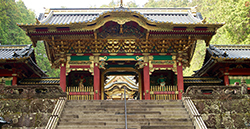 Nikko Tosho-gu Shrine, dedicated to Tokugawa Ieyasu, the founder of the Tokugawa shogunate, is built. Ieyasu is enshrined there, where his remains are also entombed. During the Edo period, the Tokugawa shogunate carried out stately processions from Edo to the Nikko Tosho-gu. The shrine's annual spring and autumn festivals reenact these occasions, and are known as processions of a thousand warriors. Five structures at Nikko Tosho-gu are categorized as National Treasures of Japan, and three more as Important Cultural Properties. The stable of the shrine's sacred horses bears a carving of the three wise monkeys, who hear, speak and see no evil, a traditional symbol in Chinese and Japanese culture.
Nikko Tosho-gu Shrine, dedicated to Tokugawa Ieyasu, the founder of the Tokugawa shogunate, is built. Ieyasu is enshrined there, where his remains are also entombed. During the Edo period, the Tokugawa shogunate carried out stately processions from Edo to the Nikko Tosho-gu. The shrine's annual spring and autumn festivals reenact these occasions, and are known as processions of a thousand warriors. Five structures at Nikko Tosho-gu are categorized as National Treasures of Japan, and three more as Important Cultural Properties. The stable of the shrine's sacred horses bears a carving of the three wise monkeys, who hear, speak and see no evil, a traditional symbol in Chinese and Japanese culture.
(no entry for this year)
1618
Beginning of the Thirty Years War..
The Manchus start invading China. Their conquest eventually topples the Ming Dynasty.
(no entry for this year)
1619
Twenty slaves in Virginia Africans brought to Jamestown are the first slaves imported into Britain's North American colonies. Like indentured servants, they were probably freed after a fixed period of service.
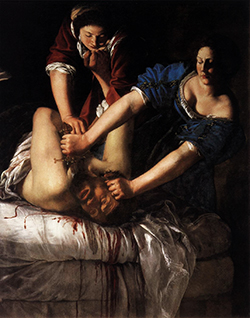 Painting by Artemesia Gentileschi: Judith Beheading Holofernes shows the scene of Judith beheading Holofernes, common in art since the early Renaissance. The subject represents an episode (from the apocryphal Book of Judith in the Old Testament) which recounts the assassination of the Assyrian general Holofernes by the Israelite heroine Judith. The painting shows the moment when Judith, helped by her maidservant, beheads the general after he has fallen asleep drunk. The painting is relentlessly physical, from the wide spurts of blood to the energy of the two women as they perform the act. Although the painting depicts a classic scene from the Bible, Gentileschi drew herself as Judith and her mentor Agostino Tassi, who was tried in court for her rape, as Holofernes. Gentileschi's biographer Mary Garrard famously proposed an autobiographical reading of the painting, stating that it functions as "a cathartic expression of the artist's private, and perhaps repressed, rage."
Painting by Artemesia Gentileschi: Judith Beheading Holofernes shows the scene of Judith beheading Holofernes, common in art since the early Renaissance. The subject represents an episode (from the apocryphal Book of Judith in the Old Testament) which recounts the assassination of the Assyrian general Holofernes by the Israelite heroine Judith. The painting shows the moment when Judith, helped by her maidservant, beheads the general after he has fallen asleep drunk. The painting is relentlessly physical, from the wide spurts of blood to the energy of the two women as they perform the act. Although the painting depicts a classic scene from the Bible, Gentileschi drew herself as Judith and her mentor Agostino Tassi, who was tried in court for her rape, as Holofernes. Gentileschi's biographer Mary Garrard famously proposed an autobiographical reading of the painting, stating that it functions as "a cathartic expression of the artist's private, and perhaps repressed, rage."
1620
The Mayflower arrives at Cape Cod bearing Brownist Pilgrims.
(no entry for this year)
1621
(no entry for this year)
(no entry for this year)
1622
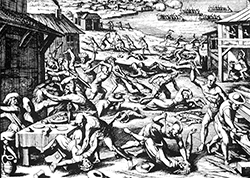 Jamestown massacre: Algonquian natives kill 347 English settlers outside Jamestown, Virginia (one-third of the colony's population) and burn the Henricus settlement.
Jamestown massacre: Algonquian natives kill 347 English settlers outside Jamestown, Virginia (one-third of the colony's population) and burn the Henricus settlement.
The third English dictionary, English Dictionarie, and the first to be called a dictionary is published by Henry Cockeram, listing difficult words with definitions.
1623
(no entry for this year)
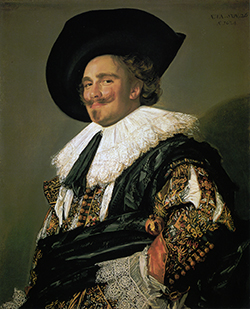 Painting by Frans Hals: The Laughing Cavalier has been described as "one of the most brilliant of all Baroque portraits". The title is an invention of the Victorian public and press, dating from its exhibition in the opening display at the Bethnal Green Museum in 1872 75, just after its arrival in England, after which it was regularly reproduced as a print, and became among of the best known old master paintings in Britain. The unknown subject is in fact not laughing, but can be said to have an enigmatic smile, much amplified by his upturned moustache.
Painting by Frans Hals: The Laughing Cavalier has been described as "one of the most brilliant of all Baroque portraits". The title is an invention of the Victorian public and press, dating from its exhibition in the opening display at the Bethnal Green Museum in 1872 75, just after its arrival in England, after which it was regularly reproduced as a print, and became among of the best known old master paintings in Britain. The unknown subject is in fact not laughing, but can be said to have an enigmatic smile, much amplified by his upturned moustache.
1624
(no entry for this year)
(no entry for this year)
1625
English settlers occupy the islands of Barbados and St. Kitts.
(no entry for this year)
1626
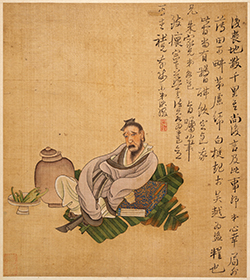 Painting by Chen Hongshou: Self Portrait. After the fall of the Ming dynasty in 1644-45 to the Manchu Qing, many artists of China's bureaucratic elite went into deep retirement, out of loyalty to the fallen government, and their loyalty or regret was sometimes expressed in subtle terms in their works. Chen Hongshou (1598-1652) had lived a life tinged with alcohol and sexual dissipation before entering the government just prior to its fall. Afterward, he committed himself to a Buddhist monastery and living a life of discipline and regret. Even his paintings are distinctive for their expression of distortion and irony. Self-portrait from an album of 11 leaves, c. 1633, Metropolitan Museum of Art. [JLS]
Painting by Chen Hongshou: Self Portrait. After the fall of the Ming dynasty in 1644-45 to the Manchu Qing, many artists of China's bureaucratic elite went into deep retirement, out of loyalty to the fallen government, and their loyalty or regret was sometimes expressed in subtle terms in their works. Chen Hongshou (1598-1652) had lived a life tinged with alcohol and sexual dissipation before entering the government just prior to its fall. Afterward, he committed himself to a Buddhist monastery and living a life of discipline and regret. Even his paintings are distinctive for their expression of distortion and irony. Self-portrait from an album of 11 leaves, c. 1633, Metropolitan Museum of Art. [JLS]
1627
(no entry for this year)
(no entry for this year)
1629
English troops capture Qu bec.
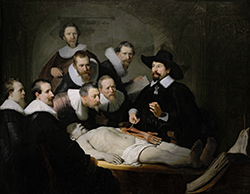 Painting by Rembrandt: The Anatomy Lesson of Dr. Nicolaes Tulp shows Dr. Tulp explaining the musculature of the arm to medical professionals. Some of the spectators are various doctors who paid commissions to be included in the painting. The painting is signed in the top-left hand corner Rembrandt. f[ecit] 1632. This may be the first instance of Rembrandt signing a painting with his forename (in its original form) as opposed to the monogramme RHL (Rembrandt Harmenszoon of Leiden), and is thus a sign of his growing artistic confidence.
Painting by Rembrandt: The Anatomy Lesson of Dr. Nicolaes Tulp shows Dr. Tulp explaining the musculature of the arm to medical professionals. Some of the spectators are various doctors who paid commissions to be included in the painting. The painting is signed in the top-left hand corner Rembrandt. f[ecit] 1632. This may be the first instance of Rembrandt signing a painting with his forename (in its original form) as opposed to the monogramme RHL (Rembrandt Harmenszoon of Leiden), and is thus a sign of his growing artistic confidence.
1632
Charles I of England grants a charter to Cecilius Calvert, second Lord Baltimore, for colony in Maryland
(no entry for this year)
1633
(no entry for this year)
(no entry for this year)
1634
(no entry for this year)
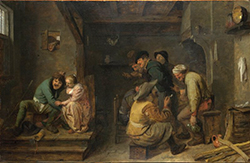 Painting by Adriaen Brouwer: Tavern Scene. Brouwer left a small body of work amounting to about 60 works. Just a few of his works are signed, while none is dated. As Brouwer was widely copied, imitated and followed in his time, attributions of work to Brouwer are sometimes uncertain or contested. For instance, the The smoker (Louvre) showing a man exhaling smoke while holding a bottle of liquor was attributed for a long time to Brouwer, but is now given to Brouwer's follower and, possibly, pupil Joos van Craesbeeck. The principal subject matter of Brouwer are genre scenes with peasants, soldiers and other 'lower class' individuals engaging in drinking, smoking, card or dice playing, fights etc. often set in taverns or rural settings. Brouwer also contributed to the development of the genre of tronies, i.e. head or facial studies, which investigate varieties of expression.
Painting by Adriaen Brouwer: Tavern Scene. Brouwer left a small body of work amounting to about 60 works. Just a few of his works are signed, while none is dated. As Brouwer was widely copied, imitated and followed in his time, attributions of work to Brouwer are sometimes uncertain or contested. For instance, the The smoker (Louvre) showing a man exhaling smoke while holding a bottle of liquor was attributed for a long time to Brouwer, but is now given to Brouwer's follower and, possibly, pupil Joos van Craesbeeck. The principal subject matter of Brouwer are genre scenes with peasants, soldiers and other 'lower class' individuals engaging in drinking, smoking, card or dice playing, fights etc. often set in taverns or rural settings. Brouwer also contributed to the development of the genre of tronies, i.e. head or facial studies, which investigate varieties of expression.
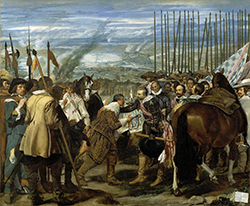 Painting by Diego Velázquez: The Surrender of Breda was inspired by Velázquez's visit to Italy with Ambrogio Spinola, the Genoese general who conquered Breda on June 5, 1625. It is considered one of Velázquez's best works. Jan Morris has called it "one of the most Spanish of all pictures".
Painting by Diego Velázquez: The Surrender of Breda was inspired by Velázquez's visit to Italy with Ambrogio Spinola, the Genoese general who conquered Breda on June 5, 1625. It is considered one of Velázquez's best works. Jan Morris has called it "one of the most Spanish of all pictures".
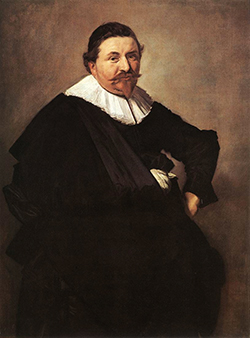 Painting by Frans Hals: Lucas de Clercq, a Dutch cloth merchant known today for his and his wife's pendant marriage portraits painted by Frans Hals.
Painting by Frans Hals: Lucas de Clercq, a Dutch cloth merchant known today for his and his wife's pendant marriage portraits painted by Frans Hals.
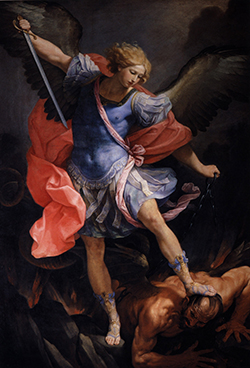 Painting by Guido Reni: The Archangel Michael vanquishing Satan
Painting by Guido Reni: The Archangel Michael vanquishing Satan
1635
(no entry for this year)
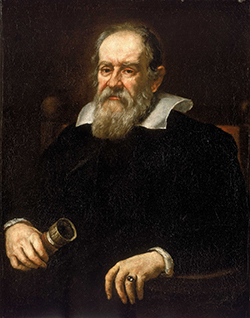 Painting by Justus Sustermans: Portrait of Galileo Galilei. Justus Sustermans was a Flemish painter working in the Baroque style. He was born in Antwerp and died in Florence. Sustermans is chiefly notable for his portraits of members of the Medici family as he was their court painter. His work can be found in both the Palatina Gallery and the Uffizi Gallery in Florence, and in many other galleries around the globe. During his lifetime he was f ted as the finest portrait painter in Italy.
Painting by Justus Sustermans: Portrait of Galileo Galilei. Justus Sustermans was a Flemish painter working in the Baroque style. He was born in Antwerp and died in Florence. Sustermans is chiefly notable for his portraits of members of the Medici family as he was their court painter. His work can be found in both the Palatina Gallery and the Uffizi Gallery in Florence, and in many other galleries around the globe. During his lifetime he was f ted as the finest portrait painter in Italy.
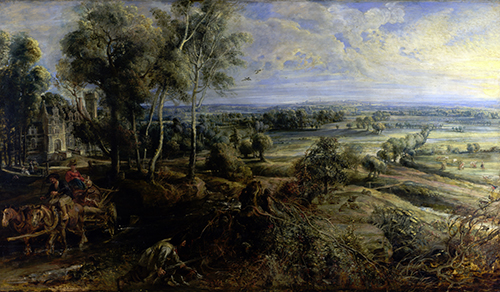 Painting by Peter Paul Rubens: A View of Het Steen in the Early Morning is a landscape painting now in the National Gallery in London. A rare example of a work painted for the artist's own pleasure rather than for a commission, it shows a view of the Het Steen estate near Brussels, which he had acquired in 1635, set in an early-morning autumn landscape. He had initially intended a much smaller painting focussing on the house, using three small oak planks, probably spares from his studio as the concept developed, seventeen more panels were added. It has influenced artists including John Constable, during his period working for Sir George Beaumont, who then owned the painting and later donated it to the National Gallery in 1823. The painting features the first convincing depiction of a mackerel sky.
Painting by Peter Paul Rubens: A View of Het Steen in the Early Morning is a landscape painting now in the National Gallery in London. A rare example of a work painted for the artist's own pleasure rather than for a commission, it shows a view of the Het Steen estate near Brussels, which he had acquired in 1635, set in an early-morning autumn landscape. He had initially intended a much smaller painting focussing on the house, using three small oak planks, probably spares from his studio as the concept developed, seventeen more panels were added. It has influenced artists including John Constable, during his period working for Sir George Beaumont, who then owned the painting and later donated it to the National Gallery in 1823. The painting features the first convincing depiction of a mackerel sky.
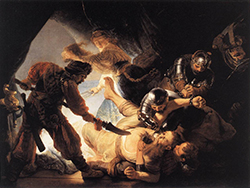 Painting by Rembrandt: The Blinding of Samson is now in the St del. The painting is the first of its kind in pictorial tradition. No other artist at the time had painted this specific narrative moment. This painting was a gift to the House of Orange, Rembrandt's current patron of a few commissioned paintings.
Painting by Rembrandt: The Blinding of Samson is now in the St del. The painting is the first of its kind in pictorial tradition. No other artist at the time had painted this specific narrative moment. This painting was a gift to the House of Orange, Rembrandt's current patron of a few commissioned paintings.
1636
Harvard College is established.
Colonial North America's slave trade begins when the first American slave carrier, Desire, is built and launched in Massachusetts.
Harvard University is founded in Cambridge, Massachusetts.
(no entry for this year)
1637
(no entry for this year)
(no entry for this year)
1638
(no entry for this year)
(no entry for this year)
1639
(no entry for this year)
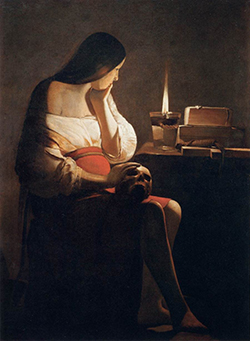 Painting by Georges de La Tour: Magdalene with the Smoking Flame has been allotted the date of 1640, by analogy with the Saint Mary with a Mirror, which has been dated between 1635 and 1645. During the 17th century, great devotion was shown to Mary Magdalene in all Catholic countries. She was the perfect lover of Christ, her beauty made yet more appealing by reason of her repentance, which had a special attraction for a period so passionately interested in problems of mysticism, quietism and asceticism. The theme of the repentance of sinners and trials sent by God is illustrated in such subjects as the Repentance of St. Peter, Mary Magdalene and Job. A number of written works give evidence of the cult of the Magdalene and this cult was the more widespread since Provence owned two great sanctuaries dedicated to her: the grotto of La Sainte-Baume, and the Saintes-Maries-de-la-Mer. It has been suggested that Georges de La Tour took a gypsy as his model: at the time, there were many in Lorraine where he painted this picture.
Painting by Georges de La Tour: Magdalene with the Smoking Flame has been allotted the date of 1640, by analogy with the Saint Mary with a Mirror, which has been dated between 1635 and 1645. During the 17th century, great devotion was shown to Mary Magdalene in all Catholic countries. She was the perfect lover of Christ, her beauty made yet more appealing by reason of her repentance, which had a special attraction for a period so passionately interested in problems of mysticism, quietism and asceticism. The theme of the repentance of sinners and trials sent by God is illustrated in such subjects as the Repentance of St. Peter, Mary Magdalene and Job. A number of written works give evidence of the cult of the Magdalene and this cult was the more widespread since Provence owned two great sanctuaries dedicated to her: the grotto of La Sainte-Baume, and the Saintes-Maries-de-la-Mer. It has been suggested that Georges de La Tour took a gypsy as his model: at the time, there were many in Lorraine where he painted this picture.
1640
John Punch, a runaway black servant, is sentenced to servitude for life. His two white companions are given extended terms of servitude. Punch is the first documented slave for life.
New Netherlands law forbids residents from harboring or feeding runaway slaves.
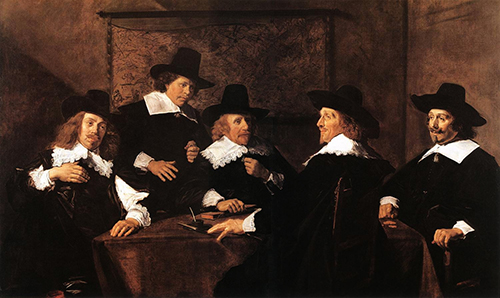 Painting by Frans Hals: Regents of the St. Elizabeth Hospital
Painting by Frans Hals: Regents of the St. Elizabeth Hospital
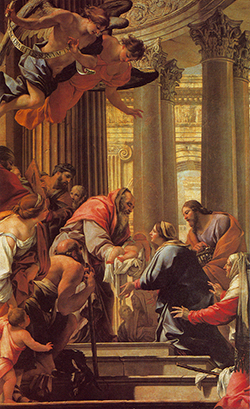 Painting by Simon Vouet: Presentation in the Temple
Painting by Simon Vouet: Presentation in the Temple
1641
Massachusetts is the first colony to legalize slavery.
The D'Angola marriage is the first recorded marriage between blacks in New Amsterdam.
The Tokugawa Shogunate institutes Sakoku — foreigners are expelled and no one is allowed to enter or leave Japan.
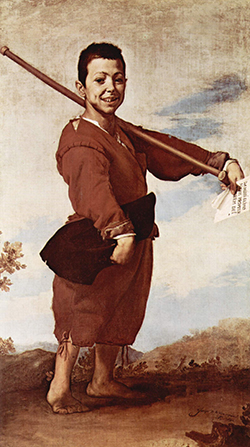 Painting by Jos de Ribera: The Clubfooted Boy is housed in the Mus e du Louvre in Paris (part of the La Caze bequest of 1869), and was painted in Naples. Art historian Ellis Waterhouse wrote of it as "a touchstone by which we can interpret the whole of Ribera's art". Commissioned by a Flemish dealer, the painting features a Neapolitan beggar boy with a deformed foot. Behind him is a vast and luminous landscape, against which the boy stands with a gap-toothed grin, wearing earth-toned clothes and holding his crutch slung over his left shoulder. Written in Latin on the paper in the boy's hand is the sentence "DA MIHI ELEMOSINAM PROPTER AMOREM DEI" ("Give me alms, for the love of God"). This is one of the painter's last works, and one of the most bitter.
Painting by Jos de Ribera: The Clubfooted Boy is housed in the Mus e du Louvre in Paris (part of the La Caze bequest of 1869), and was painted in Naples. Art historian Ellis Waterhouse wrote of it as "a touchstone by which we can interpret the whole of Ribera's art". Commissioned by a Flemish dealer, the painting features a Neapolitan beggar boy with a deformed foot. Behind him is a vast and luminous landscape, against which the boy stands with a gap-toothed grin, wearing earth-toned clothes and holding his crutch slung over his left shoulder. Written in Latin on the paper in the boy's hand is the sentence "DA MIHI ELEMOSINAM PROPTER AMOREM DEI" ("Give me alms, for the love of God"). This is one of the painter's last works, and one of the most bitter.
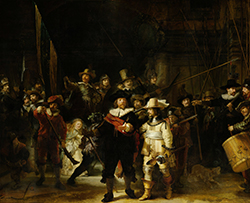 Painting by Rembrandt: The Night Watch is renowned for three characteristics: its colossal size (363 cm 437 cm (11.91 ft 14.34 ft)), the effective use of light and shadow (tenebrism) and the perception of motion in what would have traditionally been a static military portrait. The painting was completed in 1642, at the peak of the Dutch Golden Age. It depicts the eponymous company moving out, led by Captain Frans Banning Cocq (dressed in black, with a red sash) and his lieutenant, Willem van Ruytenburch (dressed in yellow, with a white sash). With effective use of sunlight and shade, Rembrandt leads the eye to the three most important characters among the crowd: the two gentlemen in the centre (from whom the painting gets its original title), and the woman in the centre-left background carrying a chicken. Behind them, the company's colours are carried by the ensign, Jan Visscher Cornelissen.
Painting by Rembrandt: The Night Watch is renowned for three characteristics: its colossal size (363 cm 437 cm (11.91 ft 14.34 ft)), the effective use of light and shadow (tenebrism) and the perception of motion in what would have traditionally been a static military portrait. The painting was completed in 1642, at the peak of the Dutch Golden Age. It depicts the eponymous company moving out, led by Captain Frans Banning Cocq (dressed in black, with a red sash) and his lieutenant, Willem van Ruytenburch (dressed in yellow, with a white sash). With effective use of sunlight and shade, Rembrandt leads the eye to the three most important characters among the crowd: the two gentlemen in the centre (from whom the painting gets its original title), and the woman in the centre-left background carrying a chicken. Behind them, the company's colours are carried by the ensign, Jan Visscher Cornelissen.
1642
The city of Montr al is founded in what will become Canada.
(no entry for this year)
1643
The New England Confederation of Plymouth, Massachusetts, Connecticut, and New Haven adopts a fugitive slave law.
(no entry for this year)
1644
Manchu dynasty established in China; end of the Ming line.
The Manchu conquer China ending the Ming Dynasty. The subsequent Qing Dynasty rules until 1912.
Giacomo Torelli of Venice, Italy invents the first rotating stage.
1645
(no entry for this year)
(no entry for this year)
1646
(no entry for this year)
(no entry for this year)
1647
Peter Stuyvesant appointed governor of New Amsterdam.
George Fox founds the Society of Friends, or Quakers, in England.
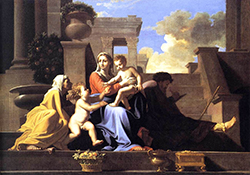 Painting by Nicolas Poussin: The Holy Family on the Steps
Painting by Nicolas Poussin: The Holy Family on the Steps
In France, King Louis XIV establishes The Royal Academy of Painting and Sculpture.
1648
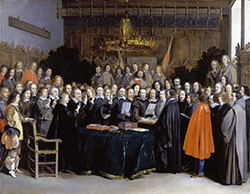 The Peace of Westphalia ends the Thirty Years' War and the Eighty Years' War and marks the ends of Spain and the Holy Roman Empire as major European powers.
The Peace of Westphalia ends the Thirty Years' War and the Eighty Years' War and marks the ends of Spain and the Holy Roman Empire as major European powers.
The Peace of Westphalia brings an end to the Thiry Years War.
(no entry for this year)
1649
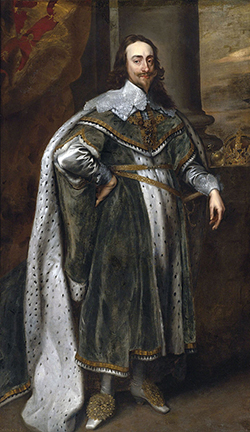 King Charles I is executed for High treason, the first and only English king to be subjected to legal proceedings in a High Court of Justice and put to death.
King Charles I is executed for High treason, the first and only English king to be subjected to legal proceedings in a High Court of Justice and put to death.
George Fox, the founder of the Society of Friends, is imprisoned at Nottingham.
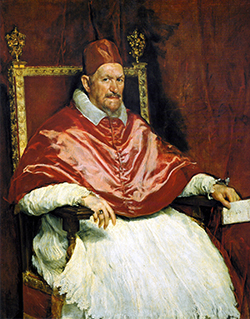 Painting by Diego Velázquez: Portrait of Innocent X is considered by many artists and art critics as the finest portrait ever created. It is housed in the Galleria Doria Pamphilj in Rome. The painting is noted for its realism, in that it is an unflinching portrait of a highly intelligent, shrewd but aging man. He is dressed in linen vestments, and the quality of the work is evident in the rich reds of his upper clothing, head-dress, and the hanging curtains. The pope, born Giovanni Battista Pamphilj, was initially wary of having his portrait taken by Velázquez, but relented after he was given reproductions of examples of Velázquez's portraiture. A contributing factor for this large advancement in the painter's career was that he had already depicted a number of members of Pamphilj's inner court. Yet the pope remained wary and cautious, and the painting was initially displayed to only his immediate family, and was largely lost from public view through the 17th and 18th centuries. The parchment held by the pope contains Velázquez's signature.
Painting by Diego Velázquez: Portrait of Innocent X is considered by many artists and art critics as the finest portrait ever created. It is housed in the Galleria Doria Pamphilj in Rome. The painting is noted for its realism, in that it is an unflinching portrait of a highly intelligent, shrewd but aging man. He is dressed in linen vestments, and the quality of the work is evident in the rich reds of his upper clothing, head-dress, and the hanging curtains. The pope, born Giovanni Battista Pamphilj, was initially wary of having his portrait taken by Velázquez, but relented after he was given reproductions of examples of Velázquez's portraiture. A contributing factor for this large advancement in the painter's career was that he had already depicted a number of members of Pamphilj's inner court. Yet the pope remained wary and cautious, and the painting was initially displayed to only his immediate family, and was largely lost from public view through the 17th and 18th centuries. The parchment held by the pope contains Velázquez's signature.
1650
Connecticut legalizes slavery.
(no entry for this year)
1651
(no entry for this year)
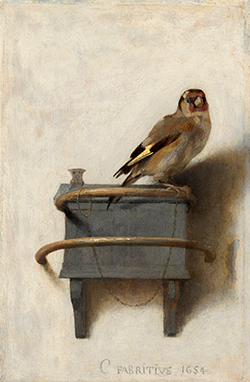 Painting by Carel Fabritius: The Goldfinch is an animal painting by Carel Fabritius of a chained goldfinch. The work belongs to the collection of the Mauritshuis in The Hague, Netherlands. The painting is a trompe-l' il of a European goldfinch (Carduelis carduelis) on top of its feeder that is attached to the wall. The feeder consists of two half rings and a blue container. The bird is sitting on the top ring, to which it is chained by its foot. In the 17th century, goldfinches were popular pets because they could be trained to draw water from a bowl with a miniature bucket. The Dutch title of the painting pertains to the bird's nickname puttertje, which refers to this custom and translates literally as 'little weller'.
Painting by Carel Fabritius: The Goldfinch is an animal painting by Carel Fabritius of a chained goldfinch. The work belongs to the collection of the Mauritshuis in The Hague, Netherlands. The painting is a trompe-l' il of a European goldfinch (Carduelis carduelis) on top of its feeder that is attached to the wall. The feeder consists of two half rings and a blue container. The bird is sitting on the top ring, to which it is chained by its foot. In the 17th century, goldfinches were popular pets because they could be trained to draw water from a bowl with a miniature bucket. The Dutch title of the painting pertains to the bird's nickname puttertje, which refers to this custom and translates literally as 'little weller'.
1652
Massachusetts requires all black and Indian servants to receive military training.
Rhode Island passes laws restricting slavery and forbidding enslavement for more than 10 years.
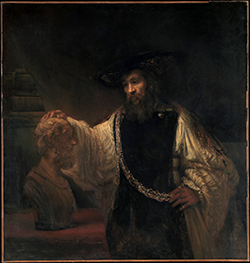 Painting by Rembrandt: Aristotle Contemplating a Bust of Homer was painted as a commission from Don Antonio Ruffo, from Messina in Sicily, who did not request a particular subject. Aristotle, world-weary, looks at the bust of blind, humble Homer, on which he rests one of his hands. This has variously been interpreted as the man of sound, methodical science deferring to Art, or as the wealthy and famous philosopher, wearing the jeweled belt given to him by Alexander the Great, envying the life of the poor blind bard. It has also been suggested that this is Rembrandt's commentary on the power of portraiture.
Painting by Rembrandt: Aristotle Contemplating a Bust of Homer was painted as a commission from Don Antonio Ruffo, from Messina in Sicily, who did not request a particular subject. Aristotle, world-weary, looks at the bust of blind, humble Homer, on which he rests one of his hands. This has variously been interpreted as the man of sound, methodical science deferring to Art, or as the wealthy and famous philosopher, wearing the jeweled belt given to him by Alexander the Great, envying the life of the poor blind bard. It has also been suggested that this is Rembrandt's commentary on the power of portraiture.
1653
Oliver Cromwell dissolves the Rump Parliament and replaces it with the Nominated Assembly (also called the Assembly of Saints or Barebones Parliament.) After three months, the Nominated Assembly passes a motion to dissolve itself and Cromwell establishes the Protectorate.
(no entry for this year)
1654
A Virginia court grants blacks the right to hold slaves.
Scotland incorporated with the English Commonwealth.
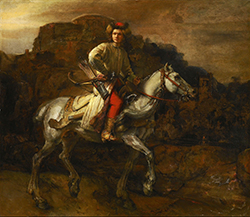 Painting by Rembrandt: The Polish Rider depicts a young man traveling on horseback through a murky landscape. When the painting was sold by Zdzislaw Tarnowski to Henry Frick in 1910, there was consensus that the work was by the Dutch painter Rembrandt. This attribution has since been contested, though this remains a minority view. There has also been debate over whether the painting was intended as a portrait of a particular person, living or historical, and if so of whom, or if not, what it was intended to represent. Both the quality of the painting and its slight air of mystery are commonly recognized, though parts of the background are very sketchily painted or unfinished.
Painting by Rembrandt: The Polish Rider depicts a young man traveling on horseback through a murky landscape. When the painting was sold by Zdzislaw Tarnowski to Henry Frick in 1910, there was consensus that the work was by the Dutch painter Rembrandt. This attribution has since been contested, though this remains a minority view. There has also been debate over whether the painting was intended as a portrait of a particular person, living or historical, and if so of whom, or if not, what it was intended to represent. Both the quality of the painting and its slight air of mystery are commonly recognized, though parts of the background are very sketchily painted or unfinished.
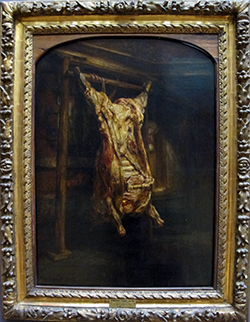 Painting by Rembrandt: The Slaughtered Ox is an oil on beech panel painting by Rembrandt. It has been in the collection of the Louvre in Paris since 1857. A similar painting is in Kelvingrove Art Gallery and Museum, possibly by Rembrandt himself but probably by one of his pupils, perhaps Fabritius. Other similar, paintings attributed to Rembrandt or his circle, are held by museums in Budapest and Philadelphia. The work follows in a tradition of showing butchery, for example Pieter Aertsen's A Meat Stall with the Holy Family Giving Alms and Annibale Carracci's Butcher's Shop. Rembrandt made a drawing of a similar scene c.1635. Another, pre-1655, painting of a slaughtered ox (the example in Edinburgh, now attributed to Rembrandt's circle but formerly to Rembrandt) was perhaps inspired by a lost earlier work by Rembrandt himself. In northern Europe, the month of November was traditionally the season slaughtering livestock in northern Europe, before winter made feed difficult to find.
Painting by Rembrandt: The Slaughtered Ox is an oil on beech panel painting by Rembrandt. It has been in the collection of the Louvre in Paris since 1857. A similar painting is in Kelvingrove Art Gallery and Museum, possibly by Rembrandt himself but probably by one of his pupils, perhaps Fabritius. Other similar, paintings attributed to Rembrandt or his circle, are held by museums in Budapest and Philadelphia. The work follows in a tradition of showing butchery, for example Pieter Aertsen's A Meat Stall with the Holy Family Giving Alms and Annibale Carracci's Butcher's Shop. Rembrandt made a drawing of a similar scene c.1635. Another, pre-1655, painting of a slaughtered ox (the example in Edinburgh, now attributed to Rembrandt's circle but formerly to Rembrandt) was perhaps inspired by a lost earlier work by Rembrandt himself. In northern Europe, the month of November was traditionally the season slaughtering livestock in northern Europe, before winter made feed difficult to find.
1655
The island of Jamaica is captured from the Spaniards by the English.
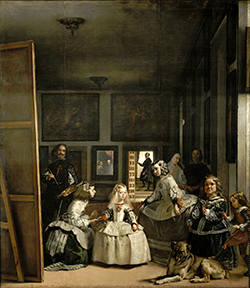 Painting by Diego Velásquez: Las Meninas (The Ladies-in-Waiting) has a complex and enigmatic composition that raises questions about reality and illusion, and creates an uncertain relationship between the viewer and the figures depicted. Because of these complexities, Las Meninas has been one of the most widely analyzed works in Western painting. The painting shows a large room in the Royal Alcazar of Madrid during the reign of King Philip IV of Spain, and presents several figures, most identifiable from the Spanish court, captured, according to some commentators, in a particular moment as if in a snapshot. Some look out of the canvas towards the viewer, while others interact among themselves. The young Infanta Margaret Theresa is surrounded by her entourage of maids of honour, chaperone, bodyguard, two dwarfs and a dog. Just behind them, Velázquez portrays himself working at a large canvas. Velázquez looks outwards, beyond the pictorial space to where a viewer of the painting would stand. In the background there is a mirror that reflects the upper bodies of the king and queen. They appear to be placed outside the picture space in a position similar to that of the viewer, although some scholars have speculated that their image is a reflection from the painting Velázquez is shown working on. Las Meninas has long been recognised as one of the most important paintings in Western art history. The Baroque painter Luca Giordano said that it represents the "theology of painting" and in 1827 the president of the Royal Academy of Arts Sir Thomas Lawrence described the work in a letter to his successor David Wilkie as "the true philosophy of the art". More recently, it has been described as "Velázquez's supreme achievement, a highly self-conscious, calculated demonstration of what painting could achieve, and perhaps the most searching comment ever made on the possibilities of the easel painting".
Painting by Diego Velásquez: Las Meninas (The Ladies-in-Waiting) has a complex and enigmatic composition that raises questions about reality and illusion, and creates an uncertain relationship between the viewer and the figures depicted. Because of these complexities, Las Meninas has been one of the most widely analyzed works in Western painting. The painting shows a large room in the Royal Alcazar of Madrid during the reign of King Philip IV of Spain, and presents several figures, most identifiable from the Spanish court, captured, according to some commentators, in a particular moment as if in a snapshot. Some look out of the canvas towards the viewer, while others interact among themselves. The young Infanta Margaret Theresa is surrounded by her entourage of maids of honour, chaperone, bodyguard, two dwarfs and a dog. Just behind them, Velázquez portrays himself working at a large canvas. Velázquez looks outwards, beyond the pictorial space to where a viewer of the painting would stand. In the background there is a mirror that reflects the upper bodies of the king and queen. They appear to be placed outside the picture space in a position similar to that of the viewer, although some scholars have speculated that their image is a reflection from the painting Velázquez is shown working on. Las Meninas has long been recognised as one of the most important paintings in Western art history. The Baroque painter Luca Giordano said that it represents the "theology of painting" and in 1827 the president of the Royal Academy of Arts Sir Thomas Lawrence described the work in a letter to his successor David Wilkie as "the true philosophy of the art". More recently, it has been described as "Velázquez's supreme achievement, a highly self-conscious, calculated demonstration of what painting could achieve, and perhaps the most searching comment ever made on the possibilities of the easel painting".
1656
The first persecution of Quakers occurs in Massachusetts.
(no entry for this year)
1657
Virginia passes a fugitive slave law.
(no entry for this year)
1658
Cromwell dies and his son Richard becomes Lord Protector.
(no entry for this year)
1659
Richard Cromwell is pressured into dissolving the Protectorate; the Rump Parliament is restored.
For the first time, women began to act in plays in London. Previously men had portrayed both male and female roles.
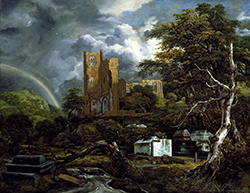 Painting by Jacob von Ruisdale: The Jewish Cemetery is an oil on canvas painting. It is an example of Dutch Golden Age painting and is now in the collection of the Detroit Institute of Arts. This painting was documented by John Smith in 1835, who wrote: "This grand and affecting picture exhibits the ruins of a church and convent upon the summit of a hill, occupying the whole extent of the view in the second distance, the declivity of which presents a cemetery, interspersed with large stones. On the foreground are a broken tree lying across a rapid stream, a tomb of black marble, with an inscription on it; a row of three sarcophagi extending along the front; and on the left stands a cluster of large umbrageous trees, the verdant hues of whose foliage is contrasted by the leafless trunk of a beech. Three persons in black are seen near a small tomb on the side of the hill, musing amidst the tombs. The grandeur and solemnity of the scene is strikingly enhanced by rolling stormy clouds, in which may be perceived the evanescent colours of a rainbow.
Painting by Jacob von Ruisdale: The Jewish Cemetery is an oil on canvas painting. It is an example of Dutch Golden Age painting and is now in the collection of the Detroit Institute of Arts. This painting was documented by John Smith in 1835, who wrote: "This grand and affecting picture exhibits the ruins of a church and convent upon the summit of a hill, occupying the whole extent of the view in the second distance, the declivity of which presents a cemetery, interspersed with large stones. On the foreground are a broken tree lying across a rapid stream, a tomb of black marble, with an inscription on it; a row of three sarcophagi extending along the front; and on the left stands a cluster of large umbrageous trees, the verdant hues of whose foliage is contrasted by the leafless trunk of a beech. Three persons in black are seen near a small tomb on the side of the hill, musing amidst the tombs. The grandeur and solemnity of the scene is strikingly enhanced by rolling stormy clouds, in which may be perceived the evanescent colours of a rainbow.
1660
Charles II, King of England, orders the Council of Foreign Plantations to devise strategies for converting slaves and servants to Christianity.
End of Puritan rule in England; restoration of the Stuarts.
The Commonwealth of England ends and the monarchy is brought back during the English Restoration.
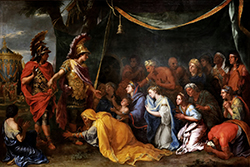 Painting by Charles Le Brun: The Family of Darius Before Alexander represents the scene when the Queen of Persia is kneeling at the feet of Alexander the Great.
Painting by Charles Le Brun: The Family of Darius Before Alexander represents the scene when the Queen of Persia is kneeling at the feet of Alexander the Great.
1661
(no entry for this year)
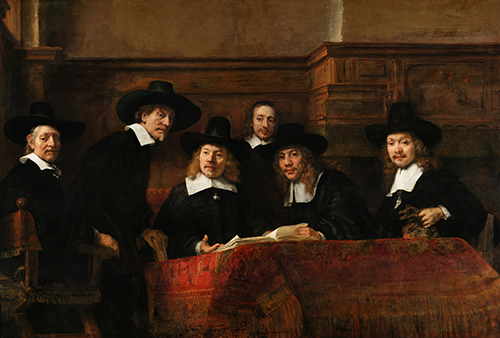 Painting by Rembrandt: The Syndics of the Drapers Guild has been described as Rembrandt's "last great collective portrait". The men (with the exception of Bel who is an attendant as indicated by his calotte) are drapers who were elected to assess the quality of cloth that weavers offered for sale to members of their guild. Their one-year terms in office began on Good Friday and they were expected to conduct their inspections thrice weekly. The Dutch word staal means 'sample' and refers to the samples of cloth that were assessed. The inspectors used pliers to press the seals of their city (front) and guild (reverse) into penny-sized slugs of lead that were specially affixed to record the results of the inspection. There were four grades of quality, the highest was indicated by pressing four seals and the lowest by pressing only one. The men, who are appraising a length of Persian-style fabric against exemplars from a swatch book, are (from left to right): Jacob van Loon, Volckert Jansz, Willem van Doeyenburg, Frans Hendricksz Bel, Jochem de Neve, and Aernout van der Mye. The guild commissioned this portrait and it hung in their guildhall, the Staalhof, until 1771. The painting is used on the packaging of Dutch Masters cigars.
Painting by Rembrandt: The Syndics of the Drapers Guild has been described as Rembrandt's "last great collective portrait". The men (with the exception of Bel who is an attendant as indicated by his calotte) are drapers who were elected to assess the quality of cloth that weavers offered for sale to members of their guild. Their one-year terms in office began on Good Friday and they were expected to conduct their inspections thrice weekly. The Dutch word staal means 'sample' and refers to the samples of cloth that were assessed. The inspectors used pliers to press the seals of their city (front) and guild (reverse) into penny-sized slugs of lead that were specially affixed to record the results of the inspection. There were four grades of quality, the highest was indicated by pressing four seals and the lowest by pressing only one. The men, who are appraising a length of Persian-style fabric against exemplars from a swatch book, are (from left to right): Jacob van Loon, Volckert Jansz, Willem van Doeyenburg, Frans Hendricksz Bel, Jochem de Neve, and Aernout van der Mye. The guild commissioned this portrait and it hung in their guildhall, the Staalhof, until 1771. The painting is used on the packaging of Dutch Masters cigars.
1662
Hereditary slavery is established, when Virginia law decrees that children of black mothers shall be bond or free according to the condition of the mother.
Massachusetts reverses a ruling dating back to 1652, which allowed blacks to train in arms. New York, Connecticut, and New Hampshire pass similar laws restricting the bearing of arms.
(no entry for this year)
1663
Charles II, King of England, gives the Carolinas to proprietors. Until the 1680s, most settlers in the region are small landowners from Barbados.
In Gloucester County, Virginia the first documented slave rebellion in the colonies takes place.
Maryland legalizes slavery.
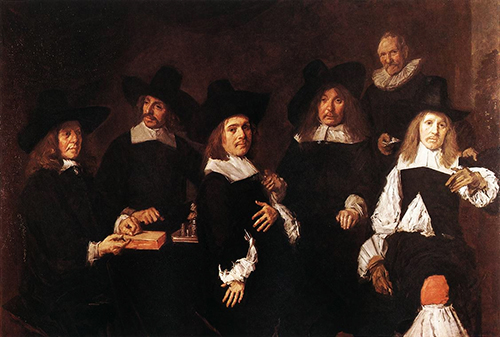 Painting by Frans Hals The Governors of the Almshouse is a regents' group portrait of five regents and their servant painted by Frans Hals in 1664 for the Oude Mannenhuis in Haarlem, the Netherlands. It forms a pendant with the Regentesses of the Old Men's Almshouse. Though it is no longer known which name belongs with which face, the regents portrayed were Jonas de Jong, Mattheus Everzwijn, dr. Cornelis Westerloo, Daniel Deinoot and Johannes Walles. Frans Hals painted them in his "loose style", with rough brush strokes. The painting is traditionally dated 1664, though no archival evidence has yet been found to confirm this. The date is chosen as the middle of the term that the sitters served as regents. Though the paintings as pendants seem to belong together, they did not hang together, and as was the case in the St. Elisabeth hospital across the street, they probably each hung in a separate regents' meeting room; the one for the ladies in the ladies' meeting room and the one for the men in the men's meeting room.
Painting by Frans Hals The Governors of the Almshouse is a regents' group portrait of five regents and their servant painted by Frans Hals in 1664 for the Oude Mannenhuis in Haarlem, the Netherlands. It forms a pendant with the Regentesses of the Old Men's Almshouse. Though it is no longer known which name belongs with which face, the regents portrayed were Jonas de Jong, Mattheus Everzwijn, dr. Cornelis Westerloo, Daniel Deinoot and Johannes Walles. Frans Hals painted them in his "loose style", with rough brush strokes. The painting is traditionally dated 1664, though no archival evidence has yet been found to confirm this. The date is chosen as the middle of the term that the sitters served as regents. Though the paintings as pendants seem to belong together, they did not hang together, and as was the case in the St. Elisabeth hospital across the street, they probably each hung in a separate regents' meeting room; the one for the ladies in the ladies' meeting room and the one for the men in the men's meeting room.
1664
Maryland is the first colony to take legal action against marriages between white women and black men.
New York and New Jersey legalize slavery.
The State of Maryland mandates lifelong servitude for all black slaves. New York, New Jersey, the Carolinas, and Virginia all pass similar laws.
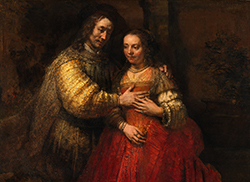 Painting by Rembrandt: The Jewish Bride gained its current name in the early 19th century, when an Amsterdam art collector identified the subject as that of a Jewish father bestowing a necklace upon his daughter on her wedding day. This interpretation is no longer accepted, and the identity of the couple is uncertain. The ambiguity is heightened by the lack of anecdotal context, leaving only the central universal theme, that of a couple joined in love. Speculative suggestions as to the couple's identity have ranged from Rembrandt's son Titus and his bride, or Amsterdam poet Miguel de Barrios and his wife. Also considered are several couples from the Old Testament, including Abraham and Sarah, or Boaz and Ruth. The likeliest identification, however, is that of Isaac and Rebekah, as described in Genesis 26:8, and is supported by a drawing by the artist of the same theme.
Painting by Rembrandt: The Jewish Bride gained its current name in the early 19th century, when an Amsterdam art collector identified the subject as that of a Jewish father bestowing a necklace upon his daughter on her wedding day. This interpretation is no longer accepted, and the identity of the couple is uncertain. The ambiguity is heightened by the lack of anecdotal context, leaving only the central universal theme, that of a couple joined in love. Speculative suggestions as to the couple's identity have ranged from Rembrandt's son Titus and his bride, or Amsterdam poet Miguel de Barrios and his wife. Also considered are several couples from the Old Testament, including Abraham and Sarah, or Boaz and Ruth. The likeliest identification, however, is that of Isaac and Rebekah, as described in Genesis 26:8, and is supported by a drawing by the artist of the same theme.
1665
Great Plague occurs in London.
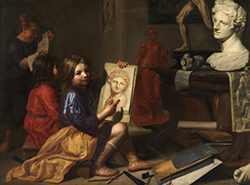 Painting by Jacob van Oost: The Painter's Studio, an allegory of the academic doctrine of beauty, in which the example of Classical Antiquity and draftsmanship were central. It is signed and dated lower right.
Painting by Jacob van Oost: The Painter's Studio, an allegory of the academic doctrine of beauty, in which the example of Classical Antiquity and draftsmanship were central. It is signed and dated lower right.
1666
Maryland passes a fugitive slave law.
Milton's Paradise Lost is published.
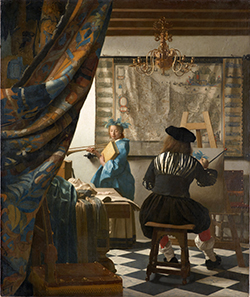 Painting by Jan Vermeer: The Art of Painting is one of Vermeer's most famous. In 1868 Thoré-Bürger, known today for his rediscovery of the work of painter Johannes Vermeer, regarded this painting as his most interesting. Svetlana Alpers describes it as unique and ambitious; Walter Liedtke "as a virtuoso display of the artist's power of invention and execution, staged in an imaginary version of his studio ..." According to Albert Blankert "No other painting so flawlessly integrates naturalistic technique, brightly illuminated space, and a complexly integrated composition." Many art historians think that it is an allegory of painting, hence the alternative title of the painting. Its composition and iconography make it the most complex Vermeer work of all.
Painting by Jan Vermeer: The Art of Painting is one of Vermeer's most famous. In 1868 Thoré-Bürger, known today for his rediscovery of the work of painter Johannes Vermeer, regarded this painting as his most interesting. Svetlana Alpers describes it as unique and ambitious; Walter Liedtke "as a virtuoso display of the artist's power of invention and execution, staged in an imaginary version of his studio ..." According to Albert Blankert "No other painting so flawlessly integrates naturalistic technique, brightly illuminated space, and a complexly integrated composition." Many art historians think that it is an allegory of painting, hence the alternative title of the painting. Its composition and iconography make it the most complex Vermeer work of all.
1667
Virginia declares that Christian baptism will not alter a person's status as a slave.
Treaty of Breda; peace established among England, Holland, France, Denmark.
(no entry for this year)
1668
The Mission of Sault Ste. Marie, in what will become Michigan, is founded by Father Marquette.
New Jersey passes a fugitive slave law.
 Painting by Willem Kalf: Still Life with a Chinese Porcelain Jar is a sumptuous still life displaying the sort of costly wares that flowed through the Netherlands during its heyday as a trade center. In Still Life with a Chinese Porcelain Jar, Kalf selected an array of precious objects with which to showcase the wealth and refinement of the Netherlands and his own skills as a painter. Everything is expensive, imported, or both. The citrus fruit, glassware from Venice, and Chinese porcelain jar are evidence of Dutch sailors' enterprise. Local talent is displayed by Dutch silver and a rummer, or wineglass, with a cherub holding a cornucopia at its base. They stand on a marble tabletop with a carelessly crumpled oriental rug. Amid all that luxury is a lesson: a ticking watch on the silver platter reminds the viewer that such earthly riches are fleeting, and worth far less than eternal salvation. The carefully balanced composition, rich colors, and warm tonalities make this painting an object of beauty as well as moral edification.
Painting by Willem Kalf: Still Life with a Chinese Porcelain Jar is a sumptuous still life displaying the sort of costly wares that flowed through the Netherlands during its heyday as a trade center. In Still Life with a Chinese Porcelain Jar, Kalf selected an array of precious objects with which to showcase the wealth and refinement of the Netherlands and his own skills as a painter. Everything is expensive, imported, or both. The citrus fruit, glassware from Venice, and Chinese porcelain jar are evidence of Dutch sailors' enterprise. Local talent is displayed by Dutch silver and a rummer, or wineglass, with a cherub holding a cornucopia at its base. They stand on a marble tabletop with a carelessly crumpled oriental rug. Amid all that luxury is a lesson: a ticking watch on the silver platter reminds the viewer that such earthly riches are fleeting, and worth far less than eternal salvation. The carefully balanced composition, rich colors, and warm tonalities make this painting an object of beauty as well as moral edification.
1669
(no entry for this year)
1670
The Hudson Bay Company is incorporated.
The State of Virginia prohibits free blacks and Indians from keeping Christian (i.e. white) servants.
(no entry for this year)
1671
(no entry for this year)
(no entry for this year)
1672
(no entry for this year)
(no entry for this year)
1673
The Mississippi River is discovered.
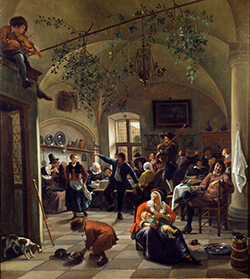 Painting by Jan Steen: Merrymaking at an Inn combines the Flemish tradition of low-life tavern scenes with the more elegant Dutch merry companies.
Painting by Jan Steen: Merrymaking at an Inn combines the Flemish tradition of low-life tavern scenes with the more elegant Dutch merry companies.
1674
New York declares that blacks who convert to Christianity after their enslavement will not be freed.
(no entry for this year)
1675
King Philip's War (sometimes called the First Indian War, Metacom's War, Metacomet's War, or Metacom's Rebellion) begins in New England. The war was an armed conflict between American Indian inhabitants of present-day New England and English colonists and their Indian allies in 1675 78. The war is named for Metacomet, the Wampanoag chief who adopted the English name Philip due to the friendly relations between his father and the Mayflower Pilgrims. The war continued in the most northern reaches of New England until the signing of the Treaty of Casco Bay in April 1678. The war was the single greatest calamity to occur in seventeenth century Puritan New England and is considered by many to be the deadliest war in the history of European settlement in North America in proportion to the population. In the space of little more than a year, twelve of the region's towns were destroyed and many more damaged, the colony's economy was all but ruined, and its population was decimated, losing one-tenth of all men available for military service. More than half of New England's towns were attacked by Indians. By early July, over 400 had surrendered to the colonists, and Metacomet took refuge in the Assowamset Swamp below Providence, close to where the war had started. The colonists formed raiding parties of militia and Indians. They were allowed to keep the possessions of warring Indians and received a bounty on all captives. Metacomet was killed by one of these teams when he was tracked down by Captain Benjamin Church and Captain Josiah Standish of the Plymouth Colony militia at Mount Hope in Bristol, Rhode Island. He was shot and killed by an Indian named John Alderman on August 12, 1676. After his death, his wife and nine-year-old son were captured and sold as slaves in Bermuda. Philip's head was mounted on a pike at the entrance to Fort Plymouth, where it remained for more than two decades. His body was cut into quarters and hung in trees. Alderman was given Metacomet's right hand as a reward.
(no entry for this year)
1676
In Virginia, black slaves and black and white indentured servants band together to participate in Bacon's Rebellion.
(no entry for this year)
1677
(no entry for this year)
(no entry for this year)
1678
The Treaty of Nijmegen ends various interconnected wars among France, the Dutch Republic, Spain, Brandenburg, Sweden, Denmark, the Prince-Bishopric of M nster, and the Holy Roman Empire.
(no entry for this year)
1679
The habeas corpus act is passed in England.
(no entry for this year)
1680
The State of Virginia forbids blacks and slaves from bearing arms, prohibits blacks from congregating in large numbers, and mandates harsh punishment for slaves who assault Christians or attempt escape.
The Pueblo Revolt drives the Spanish out of New Mexico until 1692.
(no entry for this year)
1681
(no entry for this year)
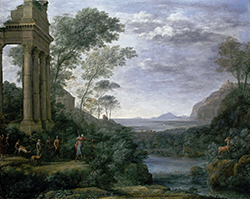 Painting by Claude Lorraine: Landscape with Ascanius Shooting the Stag of Sylvia was painted in Rome for Prince Lorenzo Onofrio Colonna (1637 1689), Claude's most important patron in his last years, and is now in the Ashmolean Museum, Oxford. It is signed, dated with the year, and inscribed with the subject (at centre bottom), as Claude sometimes did with his less common subjects. It was Claude's last painting, and is perhaps not quite finished; it therefore does not appear in the Liber Veritatis, where he made drawings to record his finished works. His date of birth is uncertain, but he was at least in his late seventies when he painted it, perhaps as old as 82.
Painting by Claude Lorraine: Landscape with Ascanius Shooting the Stag of Sylvia was painted in Rome for Prince Lorenzo Onofrio Colonna (1637 1689), Claude's most important patron in his last years, and is now in the Ashmolean Museum, Oxford. It is signed, dated with the year, and inscribed with the subject (at centre bottom), as Claude sometimes did with his less common subjects. It was Claude's last painting, and is perhaps not quite finished; it therefore does not appear in the Liber Veritatis, where he made drawings to record his finished works. His date of birth is uncertain, but he was at least in his late seventies when he painted it, perhaps as old as 82.
1682
What will become Pennsylvania is colonized by William Penn. Penn founds Philadelphia. Also, with other Friends, Penn purchases East Jersey.
New York makes it illegal for slaves to sell goods.
Virginia declares that all imported black servants are slaves for life.
La Salle (Ren -Robert Cavelier, Sieur de La Salle) explores the length of the Mississippi River and claims Louisiana for France.
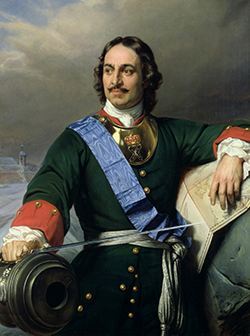 Peter the Great becomes joint ruler of Russia (sole tsar in 1696).
Peter the Great becomes joint ruler of Russia (sole tsar in 1696).
(no entry for this year)
1683
The Ottoman Empire suffered a significant defeat at the Siege of Vienna, a failed attempt to capture the city of Vienna, Austria. This marked the beginning of the empire's decline, as it was forced to cede territory and lost its status as a major European power.
The Ottoman Empire is defeated in the second Siege of Vienna.
(no entry for this year)
1684
(no entry for this year)
(no entry for this year)
1685
Edict of Fontainebleau outlaws Protestantism in France. King Charles II dies.
(no entry for this year)
1686
(no entry for this year)
(no entry for this year)
1687
(no entry for this year)
(no entry for this year)
1688
The Pennsylvania Quakers pass the first formal antislavery resolution.
(no entry for this year)
1689
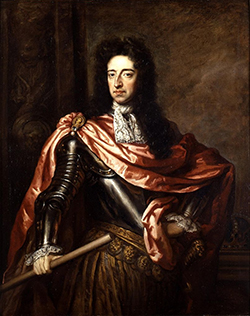 William III ascends to the throne over England, Scotland, and Ireland.
William III ascends to the throne over England, Scotland, and Ireland.
(no entry for this year)
1691
South Carolina passes the first comprehensive slave codes.
Virginia passes the first anti-miscegenation law, forbidding marriages between whites and blacks or whites and Native Americans.
Virginia prohibits the manumission of slaves within its borders. Manumitted slaves are forced to leave the colony.
(no entry for this year)
1692
The colonies of Plymouth and Massachusetts are united.
Witchcraft mania begins to take over new England.
(no entry for this year)
1693
The College of William and Mary is founded in Williamsburg, Virginia, by a royal charter.
(no entry for this year)
1694
Rice cultivation is introduced into Carolina. Slave importation increases dramatically.
The Bank of England is established.
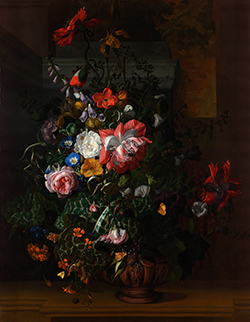 Painting by Rachel Ruysch: Flowers on a Ledge. Ruysch's skill lay in the minute observation of each flower in a totally realistic way which is then composed into an elaborate arrangement which would be very difficult to achieve in nature, as the flowers would not support each other so well under such an arrangement. In common with most flower pieces from the last third of the 17th century, the colors of the flowers are much more carefully balanced than in the earlier pictures.
Painting by Rachel Ruysch: Flowers on a Ledge. Ruysch's skill lay in the minute observation of each flower in a totally realistic way which is then composed into an elaborate arrangement which would be very difficult to achieve in nature, as the flowers would not support each other so well under such an arrangement. In common with most flower pieces from the last third of the 17th century, the colors of the flowers are much more carefully balanced than in the earlier pictures.
1695
(no entry for this year)
(no entry for this year)
1696
The Royal African Trade Company loses its monopoly and New England colonists enter the slave trade.
(no entry for this year)
1697
(no entry for this year)
(no entry for this year)
1698
Calcutta is founded by the English.
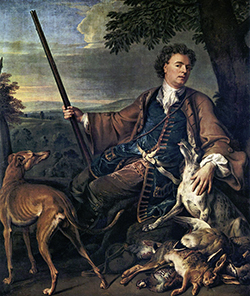 Painting by Alexandre-François Desportes: Autoportrait en chasseur (Self-portrait as hunter). Desportes was born in Champigneulle, Ardennes. He studied in Paris, in the studio of the Flemish painter Nicasius Bernaerts, a pupil of Frans Snyders. During a brief sojourn in Poland, 1695–1696, he painted portraits of John III Sobieski and Polish aristocrats; after the king's death Desportes returned to Paris, convinced that he should specialise in animals and flowers. He was received by the Académie de peinture et de sculpture in 1699, with the Self-Portrait in Hunting Dress now in the Musée du Louvre. In 1712–1713 he spent six months in England. He received many commissions for decorative panels for the royal chateaux: Versailles, Marly, Meudon, Compiègne and, his last royal commission, for Louis XV at Choisy, 1742. He also did decorative paintings for the duc de Bourbon at Chantilly. Both Louis XIV and Louis XV commissioned portraits of their favorite hunting dogs.
Painting by Alexandre-François Desportes: Autoportrait en chasseur (Self-portrait as hunter). Desportes was born in Champigneulle, Ardennes. He studied in Paris, in the studio of the Flemish painter Nicasius Bernaerts, a pupil of Frans Snyders. During a brief sojourn in Poland, 1695–1696, he painted portraits of John III Sobieski and Polish aristocrats; after the king's death Desportes returned to Paris, convinced that he should specialise in animals and flowers. He was received by the Académie de peinture et de sculpture in 1699, with the Self-Portrait in Hunting Dress now in the Musée du Louvre. In 1712–1713 he spent six months in England. He received many commissions for decorative panels for the royal chateaux: Versailles, Marly, Meudon, Compiègne and, his last royal commission, for Louis XV at Choisy, 1742. He also did decorative paintings for the duc de Bourbon at Chantilly. Both Louis XIV and Louis XV commissioned portraits of their favorite hunting dogs.
1699
(no entry for this year)
(no entry for this year)
1700
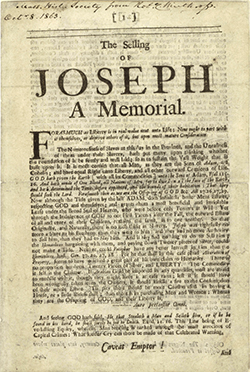 Samuel Sewall (1652-1730) publishes The Selling of Joseph — the first American protest against slavery.
Samuel Sewall (1652-1730) publishes The Selling of Joseph — the first American protest against slavery.
Pennsylvania legalizes slavery.
The Collegiate School (which will later become Yale) is founded in Saybrook, Connecticut.
1701
(no entry for this year)
The Daily Courant — the first daily newspaper — is published in London.
1702
New York passes An Act for Regulating Slaves. Among the prohibitions of this act are meetings of more than three slaves, trading by slaves, and testimony by slaves in court.
(no entry for this year)
1703
Delaware separates from Pennsylvania and becomes an independent colony.
Connecticut assigns the punishment of whipping to any slaves who disturb the peace or assault whites.
Massachusetts requires those masters who liberate slaves to provide a bond of 50 pounds or more in the event that the freedman becomes a public charge.
Rhode Island makes it illegal for blacks and Indians to walk at night without passes.
 Jonathan Swift publishes "A Tale of a Tub."
Jonathan Swift publishes "A Tale of a Tub."
1704
(no entry for this year)
(no entry for this year)
1705
Massachusetts makes marriage and sexual relations between blacks and whites illegal.
New York declares that punishment by execution will be applied to certain runaway slaves.
The Virginia Slave Code codifies slave status, declaring all non-Christian servants entering the colony to be slaves. It defines all slaves as real estate, acquits masters who kill slaves during punishment, forbids slaves and free colored peoples from physically assaulting white persons, and denies slaves the right to bear arms or move abroad without written permission.
(no entry for this year)
1706
Connecticut requires that Indians, mulattos, and black servants gain permission from their masters to engage in trade.
New York declares blacks, Indians, and slaves who kill white people to be subject to the death penalty.
(no entry for this year)
1707
(no entry for this year)
(no entry for this year)
1708
Africans in the colony of South Carolina outnumber Europeans, making it the first English colony with a black majority.
Blacks outnumber whites in South Carolina.
Rhode Island requires that slaves be accompanied by their masters when visiting the homes of free persons.
The Southern colonies require militia captains to enlist and train one slave for every white soldier.
(no entry for this year)
1709
(no entry for this year)
(no entry for this year)
1710
New York forbids blacks, Indians, and mulattos from walking at night without lighted lanterns.
(no entry for this year)
1711
Great Britain's Queen Anne overrules a Pennsylvania colonial law prohibiting slavery.
Pennsylvania prohibits the importation of blacks and Indians.
Rhode Island prohibits the clandestine importation of black and Indian slaves.
Rio de Janeiro is captured by the French.
(no entry for this year)
1712
In Charleston, South Carolina slaves are forbidden from hiring themselves out.
New York declares it illegal for blacks, Indians, and slaves to murder other blacks, Indians, and slaves.
New York forbids freed blacks, Indians, and mulatto slaves from owning real estate and holding property.
Pennsylvania prohibits the importation of slaves.
Slave Revolt: New York Slaves in New York City kill whites during an uprising, later squelched by the militia. Nineteen rebels are executed.
(no entry for this year)
1713
England secures the exclusive right to transport slaves to the Spanish colonies in America.
(no entry for this year)
1714
(no entry for this year)
(no entry for this year)
1715
Maryland declares all slaves entering the province and their descendants to be slaves for life.
Rhode Island legalizes slavery.
The Collegiate School trustees vote to move to more hospitable New Haven. Citizens of other communities vied to host the fledgling school, but friends in New Haven outbid them, fulfilling the dream of one of New Haven's founders, the Reverend John Davenport, to establish a college there.
1716
(no entry for this year)
 George Frideric Handel's "Water Music" is first performed on the Thames.
George Frideric Handel's "Water Music" is first performed on the Thames.
1717
New York enacts a fugitive slave law.
The Collegiate School is renamed Yale College in recognition of Elihu Yale's donation of books and goods.
 Voltaire is imprisoned in the Bastille; while there, he writes Oedipe.
Voltaire is imprisoned in the Bastille; while there, he writes Oedipe.
1718
(no entry for this year)
(no entry for this year)
1719
(no entry for this year)
(no entry for this year)
1720
(no entry for this year)
 Johann Sebastian Bach presents "The Brandenburg Concertos", a collection of six instrumental works, to Christian Ludwig, margrave of Brandenburg-Schwedt.
Johann Sebastian Bach presents "The Brandenburg Concertos", a collection of six instrumental works, to Christian Ludwig, margrave of Brandenburg-Schwedt.
1721
(no entry for this year)
(no entry for this year)
1723
Virginia abolishes manumissions.
(no entry for this year)
1724
Louisiana's Code Noir is enacted in New Orleans to regulate black slavery and to banish Jews from the colony
French Louisiana prohibits slaves from marrying without the permission of their owners.
(no entry for this year)
1725
(no entry for this year)
 Jonathan Swift publishes "A Modest Proposal".
Jonathan Swift publishes "A Modest Proposal".
 Jonathan Swift publishes Gulliver's Travels.
Jonathan Swift publishes Gulliver's Travels.
1726
(no entry for this year)
(no entry for this year)
1727
(no entry for this year)
(no entry for this year)
1728
(no entry for this year)
(no entry for this year)
1729
The Qing Dynasty Emperor Yongzheng prohibits opium smoking in China. British refusal to comply with these anti-narcotics laws will ultimately lead to two wars (the Opium Wars) and the subjugation of China to Britain (and other western powers).
(no entry for this year)
1730
The number of male and female slaves imported to the North American British colonies balances out for the first time.
(no entry for this year)
1731
The Spanish reverse a 1730 decision and declare that slaves fleeing to Florida from Carolina will not be sold or returned.
The Reverend George Berkeley establishes the Berkeley Scholarships for graduate study at Yale, the first such scholarships in America.
Benjamin Franklin's "Poor Richard's Almanack" first issued.
1732
Slaves aboard the ship of New Hampshire Captain John Major kill both captain and crew, seizing the vessel and its cargo.
(no entry for this year)
1733
Quaker Elihu Coleman's A Testimony against That Anti-Christian Practice of Maling Slaves of Men is published.
(no entry for this year)
1734
(no entry for this year)
(no entry for this year)
1735
Georgia petitions Britain for the legalization of slavery.
Louis XV, King of France, declares that when an enslaved woman gives birth to the child of a free man, neither mother nor child can be sold. Further, after a certain time, mother and child will be freed.
Under an English law Georgia prohibits the importation and use of black slaves.
(no entry for this year)
1736
(no entry for this year)
(no entry for this year)
1737
An indentured black servant petitions a Massachusetts court and wins his freedom after the death of his master.
(no entry for this year)
1738
Georgia's trustees permit the importation of black slaves.
Spanish Florida promises freedom and land to runaway slaves.
(no entry for this year)
1739
Slaves in Stono, South Carolina rebel, sacking and burning an armory and killing whites. Some 75 slaves in South Carolina steal weapons and flee toward freedom in Florida (then under Spanish rule). Crushed by the South Carolina militia, the revolt results in the deaths of 40 blacks and 20 whiteThe colonial militia puts an end to the rebellion before slaves are able to reach freedom in Florida.
(no entry for this year)
1740
Georgia and Carolina attempt to invade Florida in retaliation for the territory's policy toward runaways.
South Carolina passes the comprehensive Negro Act, making it illegal for slaves to move abroad, assemble in groups, raise food, earn money, and learn to read English. Owners are permitted to kill rebellious slaves if necessary.
(no entry for this year)
1741
(no entry for this year)
(no entry for this year)
1742
(no entry for this year)
(no entry for this year)
1743
(no entry for this year)
First recorded cricket match: Kent versus All England.
1744
(no entry for this year)
(no entry for this year)
1745
(no entry for this year)
(no entry for this year)
1746
(no entry for this year)
(no entry for this year)
1747
(no entry for this year)
Tobias Smollett publishes The Adventures of Roderick Random.
1748
(no entry for this year)
(no entry for this year)
1749
Georgia repeals its prohibition and permits the importation of black slaves.
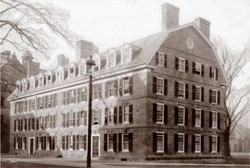 Construction is started on Connecticut Hall at Yale, now the oldest building in New Haven and a National Historic Landmark.
Construction is started on Connecticut Hall at Yale, now the oldest building in New Haven and a National Historic Landmark.
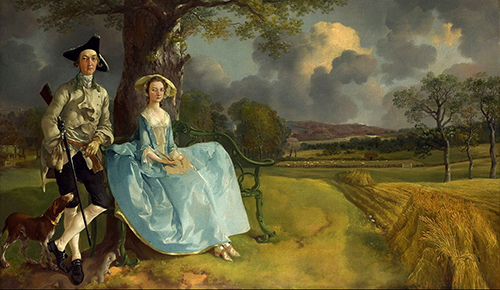 Painting by Thomas Gainsborough: Mr and Mrs Andrews is one of his most famous works. However, it remained in the family of the sitters until 1960 and was very little known before it appeared in an exhibition in Ipswich in 1927. The work is an unusual combination of two common types of painting of the period: a double portrait, here of a recently married couple, and a landscape view of the English countryside. Gainsborough's work mainly consisted of these two different genres, but their striking combination side-by-side in this extended horizontal format is unique in Gainsborough's oeuvre, and extremely rare in other painters.
Painting by Thomas Gainsborough: Mr and Mrs Andrews is one of his most famous works. However, it remained in the family of the sitters until 1960 and was very little known before it appeared in an exhibition in Ipswich in 1927. The work is an unusual combination of two common types of painting of the period: a double portrait, here of a recently married couple, and a landscape view of the English countryside. Gainsborough's work mainly consisted of these two different genres, but their striking combination side-by-side in this extended horizontal format is unique in Gainsborough's oeuvre, and extremely rare in other painters.
1750
(no entry for this year)
The minuet becomes a fashionable dance in Europe.
1751
Colonial South Carolina prohibits slaves from learning about or practicing medicine.
George II repeals the 1705 act, making slaves real estate in Virginia.
(no entry for this year)
1752
(no entry for this year)
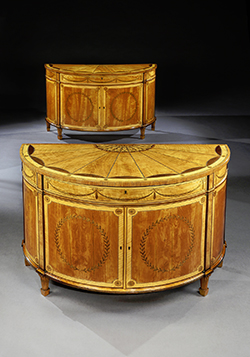 Thomas Chippendale begins making furniture in his workshop in London, England.
Thomas Chippendale begins making furniture in his workshop in London, England.
 English painter and engraver William Hogarth publishes the aesthetic treatise, The Analysis of Beauty.
English painter and engraver William Hogarth publishes the aesthetic treatise, The Analysis of Beauty.
1753
(no entry for this year)
(no entry for this year)
1754
The French and Indian War breaks out on the North American continent between the European powers Britain and France.
 English critic and writer Samuel Johnson publishes A Dictionary of the English Language, a landmark of lexicography that he has compiled by himself over the course of eight years.
English critic and writer Samuel Johnson publishes A Dictionary of the English Language, a landmark of lexicography that he has compiled by himself over the course of eight years.
1755
 The Great Lisbon Earthquake occurs, killing more than 60,000 people. The huge earthquake (estimated at 9.0 on the modern Richter scale) strikes Lisbon, Portugal, at 9:40 am, on 1 November, during church services for All Saint's Day. Because the earthquake hits on an important church holiday and destroys almost every important church in the city, much anxiety and confusion is generated amongst the citizens of this staunch and devout Roman Catholic city and country, which had been a major patron of the Church. Theologians speculate on the religious cause and message, seeing the earthquake as a manifestation of the anger of God. Some philosophers struggle to reconcile the event with the concept that humanity lives in the best of all possible worlds — a world closely supervised by a benevolent deity.
The Great Lisbon Earthquake occurs, killing more than 60,000 people. The huge earthquake (estimated at 9.0 on the modern Richter scale) strikes Lisbon, Portugal, at 9:40 am, on 1 November, during church services for All Saint's Day. Because the earthquake hits on an important church holiday and destroys almost every important church in the city, much anxiety and confusion is generated amongst the citizens of this staunch and devout Roman Catholic city and country, which had been a major patron of the Church. Theologians speculate on the religious cause and message, seeing the earthquake as a manifestation of the anger of God. Some philosophers struggle to reconcile the event with the concept that humanity lives in the best of all possible worlds — a world closely supervised by a benevolent deity.
 English statesman and writer Edmund Burke publishes A Philosophical Inquiry into the Origin of Our Ideas of the Sublime and Beautiful. This work of aesthetics, with its emphasis on the sublime, will have a powerful influence on romantic artists and writers.
English statesman and writer Edmund Burke publishes A Philosophical Inquiry into the Origin of Our Ideas of the Sublime and Beautiful. This work of aesthetics, with its emphasis on the sublime, will have a powerful influence on romantic artists and writers.
1756
(no entry for this year)
(no entry for this year)
1757
(no entry for this year)
The first English manual on guitar playing is published.
1758
Pennsylvania Quakers forbid their members from owning slaves or participating in the slave trade.
 Voltaire publishes his great satirical work Candide, inspired in part by the Great Lisbon Earthquake.
Voltaire publishes his great satirical work Candide, inspired in part by the Great Lisbon Earthquake.
1759
The British capture Québec from the French.
(no entry for this year)
1760
Jupiter Hammon of Long Island, New York, publishes a book of poetry. This is believed to be the first volume written and published by an African-American
New Jersey prohibits the enlistment of slaves in the militia without their master's permission.
 King George III ascends the English throne.
King George III ascends the English throne.
(no entry for this year)
1761
(no entry for this year)
 English poet, playwright, and novelist Oliver Goldsmith's Letters from a Citizen of the World is published, a collection of satirical essays on Britain from the point of view of a fictitious Chinese visitor.
English poet, playwright, and novelist Oliver Goldsmith's Letters from a Citizen of the World is published, a collection of satirical essays on Britain from the point of view of a fictitious Chinese visitor.
 French philosopher Jean-Jacques Rousseau writes a philosophical treatise on government and the populace, The Social Contract.
French philosopher Jean-Jacques Rousseau writes a philosophical treatise on government and the populace, The Social Contract.
 Austrian composer Wolfgang Amadeus Mozart, age 6, tours Europe as a musical prodigy.
Austrian composer Wolfgang Amadeus Mozart, age 6, tours Europe as a musical prodigy.
1762
Virginia restricts voting rights to white men.
 Catherine the Great becomes Empress of all the Russias after death of her husband.
Catherine the Great becomes Empress of all the Russias after death of her husband.
On May 16, English critic and writer Samuel Johnson meets the young Scotsman James Boswell, who will become his biographer.
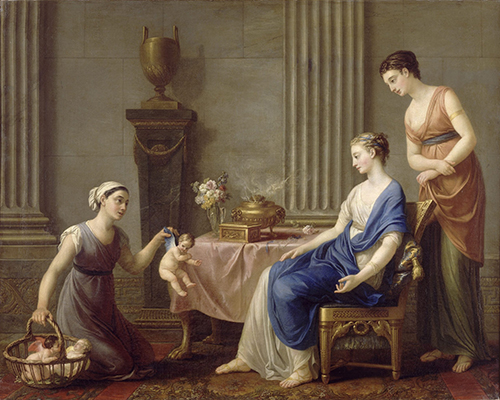 Painting by Joseph-Marie Vien: The Cupid Seller depicts a business transaction — the offer for sale of several wriggling cupids. The customers seem unimpressed.
Painting by Joseph-Marie Vien: The Cupid Seller depicts a business transaction — the offer for sale of several wriggling cupids. The customers seem unimpressed.
1763
Charles Mason and Jeremiah Dixon begin surveying Mason-Dixon Line between Pennsylvania and Maryland.
 Chief Pontiac leads a Native American rebellion against British settlers in and around Detroit.
Chief Pontiac leads a Native American rebellion against British settlers in and around Detroit.
The French Indian War ends with the Treaty of Paris surrendering Canada to England.
 Austrian composer Wolfgang Amadeus Mozart, age eight, writes his first symphony.
Austrian composer Wolfgang Amadeus Mozart, age eight, writes his first symphony.
 German archaeologist and critic Johann Winckelmann publishes his History of Ancient Art Among the Greeks, the first book to include the phrase "history of art" in the title.
German archaeologist and critic Johann Winckelmann publishes his History of Ancient Art Among the Greeks, the first book to include the phrase "history of art" in the title.
1764
(no entry for this year)
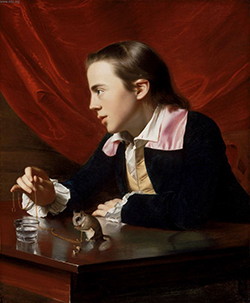 Painting by John Singleton Copley: The Boy with a Squirrel, a portrait highly praised when exhibited in London. The subject is Copley's half-brother, Henry Pelham, seated at a table and playing with a pet squirrel. This picture, which made the young Boston painter a Fellow of the Society of Artists of Great Britain, by vote of September 3, 1766, had been painted the preceding year
Painting by John Singleton Copley: The Boy with a Squirrel, a portrait highly praised when exhibited in London. The subject is Copley's half-brother, Henry Pelham, seated at a table and playing with a pet squirrel. This picture, which made the young Boston painter a Fellow of the Society of Artists of Great Britain, by vote of September 3, 1766, had been painted the preceding year
1765
Britain enacts Quartering Act, requiring colonists to provide temporary housing to British soldiers.
Stamp Act passed; this is the first direct British tax on colonists.
(no entry for this year)
1766
Britain repeals the Stamp Act.
Mozart's opera "Apollo et Hyacinthus," premieres in Salzburg.
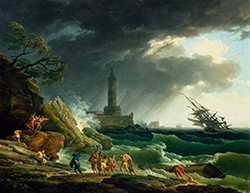 Painting by Claude Joseph Vernet: A Storm on a Mediterranean Coast. Perhaps no painter of landscapes or sea-pieces has ever made the human figure so completely a part of the scene depicted or so important a factor in his design. In this respect he was heavily influenced by Giovanni Paolo Panini, whom he probably met and worked with in Rome. Vernet's work draws on natural themes, but in a way that is neither sentimental or emotive. The overall effect of his style is wholly decorative.
Painting by Claude Joseph Vernet: A Storm on a Mediterranean Coast. Perhaps no painter of landscapes or sea-pieces has ever made the human figure so completely a part of the scene depicted or so important a factor in his design. In this respect he was heavily influenced by Giovanni Paolo Panini, whom he probably met and worked with in Rome. Vernet's work draws on natural themes, but in a way that is neither sentimental or emotive. The overall effect of his style is wholly decorative.
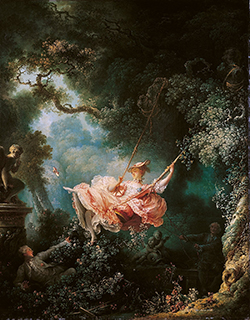 Painting by Jean-Honor Fragonard: The Swing (French: L'Escarpolette), also known as The Happy Accidents of the Swing (French: Les Hasards heureux de l'escarpolette, the original title), is an 18th-century oil painting in the Wallace Collection in London. It is considered to be one of the masterpieces of the rococo era, and is Fragonard's best known work. From a contemporary perspective, it would be hard to imagine a more frilly piece of trivia.
Painting by Jean-Honor Fragonard: The Swing (French: L'Escarpolette), also known as The Happy Accidents of the Swing (French: Les Hasards heureux de l'escarpolette, the original title), is an 18th-century oil painting in the Wallace Collection in London. It is considered to be one of the masterpieces of the rococo era, and is Fragonard's best known work. From a contemporary perspective, it would be hard to imagine a more frilly piece of trivia.
1767
Britain passes Townshend Revenue Act levying taxes on America.
The Virginia House of Burgess boycotts the British slave trade in protest of the Townsend Acts. Georgia and the Carolinas follow suit.
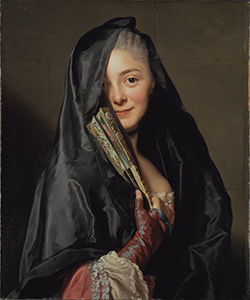 Painting by Alexander Roslin: The Lady with the Veil is one of the Swedish National Museum of Fine Arts' best loved paintings. The woman in the portrait is partially hidden by a black silk veil. Beneath the veil she is dressed for a special occasion in white lace and pink silk. During the 18th century, theatre was an important part of the life of the upper classes. Dressing up, disguising oneself and playing dramatic roles was a common pastime. The Lady with the Veil shows how one could dress up — la bolonaise — in the style of Bologna.
Painting by Alexander Roslin: The Lady with the Veil is one of the Swedish National Museum of Fine Arts' best loved paintings. The woman in the portrait is partially hidden by a black silk veil. Beneath the veil she is dressed for a special occasion in white lace and pink silk. During the 18th century, theatre was an important part of the life of the upper classes. Dressing up, disguising oneself and playing dramatic roles was a common pastime. The Lady with the Veil shows how one could dress up — la bolonaise — in the style of Bologna.
1768
 Britain's Capt. James Cook begins exploring the Pacific, putting ashore in such places as New Zealand and Australia.
Britain's Capt. James Cook begins exploring the Pacific, putting ashore in such places as New Zealand and Australia.
(no entry for this year)
1769
 Father Junipero Serra founds Mission San Diego, first mission in California.
Father Junipero Serra founds Mission San Diego, first mission in California.
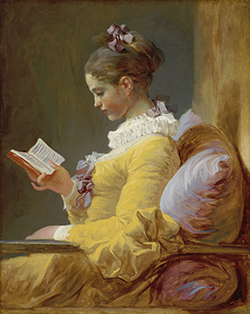 Painting by Jean-Honor Fragonard: Young Girl Reading, or The Reader (French: La Liseuse), is an 18th-century oil painting, purchased by the National Gallery of Art in Washington, DC in 1961 using funds donated by Ailsa Mellon Bruce, the daughter of Andrew W. Mellon, following her father's death. The work is more a genre painting of an everyday scene than a portrait, and the name of the sitter is not known. X-ray photography has revealed that the canvas originally featured a different head looking towards the viewer, which Fragonard painted over.
Painting by Jean-Honor Fragonard: Young Girl Reading, or The Reader (French: La Liseuse), is an 18th-century oil painting, purchased by the National Gallery of Art in Washington, DC in 1961 using funds donated by Ailsa Mellon Bruce, the daughter of Andrew W. Mellon, following her father's death. The work is more a genre painting of an everyday scene than a portrait, and the name of the sitter is not known. X-ray photography has revealed that the canvas originally featured a different head looking towards the viewer, which Fragonard painted over.
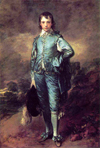 Painting by Thomas Gainsborough: The Blue Boy. Perhaps Gainsborough's most famous work, it is thought to be a portrait of Jonathan Buttall (1752 1805), the son of a wealthy hardware merchant, although this has never been proven. It is a historical costume study as well as a portrait: the youth in his 17th-century apparel is regarded as Gainsborough's homage to Anthony van Dyck, and in particular is very close to Van Dyck's portrait of Charles II as a boy.
Painting by Thomas Gainsborough: The Blue Boy. Perhaps Gainsborough's most famous work, it is thought to be a portrait of Jonathan Buttall (1752 1805), the son of a wealthy hardware merchant, although this has never been proven. It is a historical costume study as well as a portrait: the youth in his 17th-century apparel is regarded as Gainsborough's homage to Anthony van Dyck, and in particular is very close to Van Dyck's portrait of Charles II as a boy.
1770
 Crispus Attucks, an escaped slave, becomes the first colonial resident to die for American independence when he is killed by the British in the Boston massacre.
Crispus Attucks, an escaped slave, becomes the first colonial resident to die for American independence when he is killed by the British in the Boston massacre.
Around 1770, the European slave trade with Africa reaches its peak, transporting nearly 80,000 enslaved Africans across the Atlantic annually.
Escaped slave, Crispus Attucks, is killed by British forces in Boston, Massachusetts. He is one of the first colonists to die in the war for independence.
(no entry for this year)
1772
 On June 22, Lord Chief Mansfield rules in the James Somerset case that an enslaved person brought to England becomes free and cannot be returned to slavery. His ruling establishes the legal basis for the freeing of England's fifteen thousand slaves.
On June 22, Lord Chief Mansfield rules in the James Somerset case that an enslaved person brought to England becomes free and cannot be returned to slavery. His ruling establishes the legal basis for the freeing of England's fifteen thousand slaves.
James Albert Ukawsaw Gronniosaw's writes the first autobiographical slave narrative.
(no entry for this year)
1773
Jean Baptiste Point du Sable is the first settler in the community now known as Chicago. Point du Sable described himself as "a free mulatto man." He was married to a Potawatomi woman named Catherine some time in the 1770s.
 Phillis Wheatley of Boston publishes Poems on Various Subjects, Religious and Moral. This is the first book of poetry published by an African-American woman.
Phillis Wheatley of Boston publishes Poems on Various Subjects, Religious and Moral. This is the first book of poetry published by an African-American woman.
Phillis Wheatley becomes the first published African-American poet when a London publishing company releases a collection of her verse.
Slaves in Massachusetts unsuccessfully petition the government for their freedom.
The first separate black church in America is founded in South Carolina.
The "Boston Tea Party" occurs as a protest against British taxation policies.
 German poet Johann Wolfgang von Goethe writes the short novel The Sorrows of Young Werther.
German poet Johann Wolfgang von Goethe writes the short novel The Sorrows of Young Werther.
1774
Rhode Island becomes first colony to prohibit importation of slaves.
Connecticut, Rhode Island, and Georgia prohibit the importation of slaves.
The First Continental Congress bans trade with Britain and vows to discontinue the slave trade after the 1st of December.
Virginia takes action against slave importation.
(no entry for this year)
1775
Lord Dunmore, promises freedom to male slaves who join British army.
 General Washington forbids recruiting officers enlisting blacks to fight in defense of American freedom.
General Washington forbids recruiting officers enlisting blacks to fight in defense of American freedom.
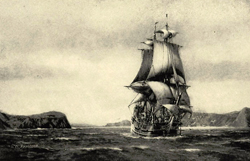 The first Spanish ship, the San Carlos, commanded by Juan Manuel de Ayala, enters San Francisco Bay.
The first Spanish ship, the San Carlos, commanded by Juan Manuel de Ayala, enters San Francisco Bay.
 The Grand Union flag is adopted by the American colonies in rebellion against England.
The Grand Union flag is adopted by the American colonies in rebellion against England.
Abolitionist Society Anthony Benezet of Philadelphia founds the world's first abolitionist society. Benjamin Franklin becomes its president in 1787.
In April, the first battles of the Revolutionary war are waged between the British and Colonial armies at Lexington and Concord, Massachusetts. Black Minutemen participate in the fighting.
In July, George Washington announces a ban on the enlistment of free blacks and slaves in the colonial army. By the end of the year, he reverses the ban, ordering the Continental Army to accept the service of free blacks.
In November, Virginia Governor John Murray, Lord Dunmore, issues a proclamation announcing that any slave fighting on the side of the British will be liberated.
The slave population in the colonies is nearly 500,000. In Virginia, the ratio of free colonists to slaves is nearly 1:1. In South Carolina it is approximately 1:2. 1775 Georgia takes action against slave importation.
Benjamin Franklin and Benjamin Rush form an anti-slavery group in Philadelphia.
The American Revolution begins with fighting at Lexington and Concord, Massachusetts.
The Continental Congress appoints George Washington head of the Continental Army.
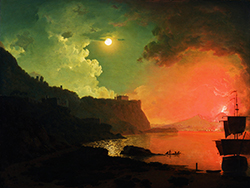 Painting by Joseph Wright: Vesuvius in Eruption is the subject of thirty paintings and at least one preliminary sketch by Joseph Wright of Derby, who travelled in Italy in the years 1773-1775. It appears that whilst Wright was in Italy Vesuvius was not erupting.
Painting by Joseph Wright: Vesuvius in Eruption is the subject of thirty paintings and at least one preliminary sketch by Joseph Wright of Derby, who travelled in Italy in the years 1773-1775. It appears that whilst Wright was in Italy Vesuvius was not erupting.
1776
Presidio of San Francisco forms as a Spanish fort.
Continental Congress approves enlistment of free blacks .
Delaware prohibits the importation of African slaves.
In Philadelphia, Pennsylvania, members of the Continental Congress sign the Declaration of Independence.
In Philadelphia, Pennsylvania, the Society of Friends, also known as the Quakers, forbids its members from holding slaves.
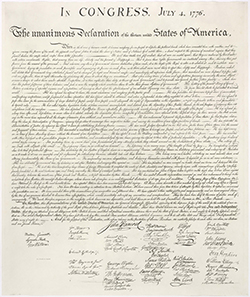 Declaration of Independence published. The Declaration of Independence is the statement adopted by the Second Continental Congress meeting at the Pennsylvania State House (Independence Hall) in Philadelphia on July 4, 1776, which announced that the thirteen American colonies, then at war with the Kingdom of Great Britain, regarded themselves as thirteen newly independent sovereign states, and no longer under British rule. Instead they formed a new nation — the United States of America. John Adams was a leader in pushing for independence, which was passed on July 2 with no opposing vote cast. A committee of five had already drafted the formal declaration, to be ready when Congress voted on independence. The term "Declaration of Independence" is not used in the document itself. Although Americans generally regard themselves as having been independent since July 4, 1776, in fact true, legal independence was not achieved until the Treaty of Paris was signed in 1783 and ratified by the Congress of the Confederation on January 14, 1784.
Declaration of Independence published. The Declaration of Independence is the statement adopted by the Second Continental Congress meeting at the Pennsylvania State House (Independence Hall) in Philadelphia on July 4, 1776, which announced that the thirteen American colonies, then at war with the Kingdom of Great Britain, regarded themselves as thirteen newly independent sovereign states, and no longer under British rule. Instead they formed a new nation — the United States of America. John Adams was a leader in pushing for independence, which was passed on July 2 with no opposing vote cast. A committee of five had already drafted the formal declaration, to be ready when Congress voted on independence. The term "Declaration of Independence" is not used in the document itself. Although Americans generally regard themselves as having been independent since July 4, 1776, in fact true, legal independence was not achieved until the Treaty of Paris was signed in 1783 and ratified by the Congress of the Confederation on January 14, 1784.
 Adam Smith publishes The Wealth of Nations, which lays the foundation for free-market capitalism.
Adam Smith publishes The Wealth of Nations, which lays the foundation for free-market capitalism.
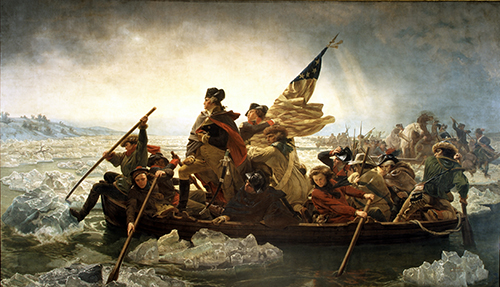 Washington leads the Continental Army in a crossing of the Delaware River, beginning on Christmas Day. The crossing catches the British army unaware, resulting in a victory for the rebel forces.
Washington leads the Continental Army in a crossing of the Delaware River, beginning on Christmas Day. The crossing catches the British army unaware, resulting in a victory for the rebel forces.
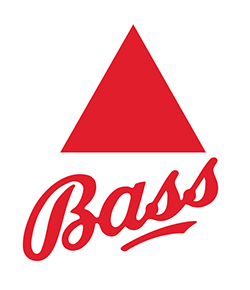 The Bass Brewery was founded in 1777 by William Bass in Burton-upon-Trent, England. The main brand was Bass Pale Ale, once the highest-selling beer in the UK. By 1877, Bass had become the largest brewery in the world, with an annual output of one million barrels. Its pale ale was exported throughout the British Empire, and the company's distinctive red triangle became the UK's first registered trademark. Bass was a pioneer in international brand marketing. Very early on, Bass applied a red triangle to casks of its Pale Ale. Bottles of Bass with the Red Triangle logo have occasionally appeared in art and literature, including Édouard Manet's 1882 painting A Bar at the Folies-Bergère. In 2001, 66,500,000 litres of Bass were sold in the United States. However Bass seems to have suffered under the custodianship of InBev and later Anheuser-Busch InBev as it is undergoing heavy decline in American consumption, with 24,200,000 litres sold in the country in 2010.
The Bass Brewery was founded in 1777 by William Bass in Burton-upon-Trent, England. The main brand was Bass Pale Ale, once the highest-selling beer in the UK. By 1877, Bass had become the largest brewery in the world, with an annual output of one million barrels. Its pale ale was exported throughout the British Empire, and the company's distinctive red triangle became the UK's first registered trademark. Bass was a pioneer in international brand marketing. Very early on, Bass applied a red triangle to casks of its Pale Ale. Bottles of Bass with the Red Triangle logo have occasionally appeared in art and literature, including Édouard Manet's 1882 painting A Bar at the Folies-Bergère. In 2001, 66,500,000 litres of Bass were sold in the United States. However Bass seems to have suffered under the custodianship of InBev and later Anheuser-Busch InBev as it is undergoing heavy decline in American consumption, with 24,200,000 litres sold in the country in 2010.
1777
San Jose, California, is founded on orders from Antonio María de Bucareli y Ursúa, Spanish Viceroy of New Spain, thus providing an answer to the not-yet-asked question, Do you know the way to San Jose?
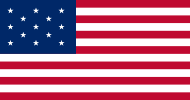 Continental Congress adopts the Stars and Stripes replacing the Grand Union flag. The new flag has thirteen stars and thirteen stripes, representing the thirteen original states: Delaware, Pennsylvania, New Jersey, Georgia, Connecticut, Massachusetts, Maryland, South Carolina, New Hampshire, Virginia, New York, North Carolina, and Rhode Island.
Continental Congress adopts the Stars and Stripes replacing the Grand Union flag. The new flag has thirteen stars and thirteen stripes, representing the thirteen original states: Delaware, Pennsylvania, New Jersey, Georgia, Connecticut, Massachusetts, Maryland, South Carolina, New Hampshire, Virginia, New York, North Carolina, and Rhode Island.
Vermont amends its constitution to ban slavery. Over the next 25 years, other Northern states emancipate their slaves and ban the institution: Pennsylvania, 1780; Massachusetts and New Hampshire, 1783; Connecticut and Rhode Island, 1784; New York, 1799; and New Jersey, 1804. Some of the state laws stipulate gradual emancipation.
New York enfranchises all free propertied men regardless of color or prior servitude.
Vermont is the first of the thirteen colonies to abolish slavery and enfranchise all adult males.
The German composer Ludwig von Beethoven, age eight, is presented by his father as a music prodigy.
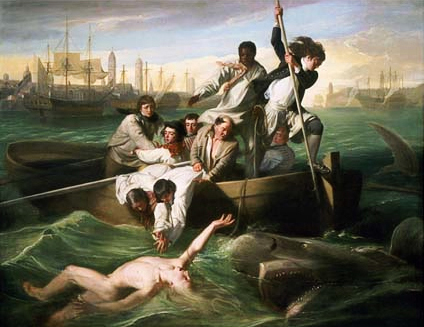 Painting by John Singleton Copley: Watson and the Shark about a shark attack on a swimmer, Brook Watson, that occurred in Havana, Cuba in 1749. Copley had never visited Havana, and it is likely that he had never seen a shark, much less a shark attack. It is probable that he gleaned details of Havana harbor from prints and book illustrations: he includes the real landmark of Morro Castle in the background of the painting. The shark is less convincing; it includes details not found in sharks, such as forward-facing eyes and lips.
Painting by John Singleton Copley: Watson and the Shark about a shark attack on a swimmer, Brook Watson, that occurred in Havana, Cuba in 1749. Copley had never visited Havana, and it is likely that he had never seen a shark, much less a shark attack. It is probable that he gleaned details of Havana harbor from prints and book illustrations: he includes the real landmark of Morro Castle in the background of the painting. The shark is less convincing; it includes details not found in sharks, such as forward-facing eyes and lips.
1778
Rhode Island forbids the removal of slaves from the state.
Virginia prohibits the importation of slaves.
The first school of the arts is established in the New World, in Mexico City.
1779
 Capt. James Cook dies during a skirmish in Hawaii.
Capt. James Cook dies during a skirmish in Hawaii.
(no entry for this year)
1780
Massachusetts abolishes slavery and grants African-American men the right to vote.
A freedom clause in the Massachusetts constitution is interpreted as an abolishment of slavery. Massachusetts enfranchises all men regardless of race.
Delaware makes it illegal to enslave imported Africans.
Pennsylvania begins gradual emancipation.
Great Hurricane of 1780 — the deadliest Atlantic hurricane on record — kills 20,000 to 30,000 in Caribbean.
 Mozart's opera "Idomeneo" premieres in Munich.
Mozart's opera "Idomeneo" premieres in Munich.
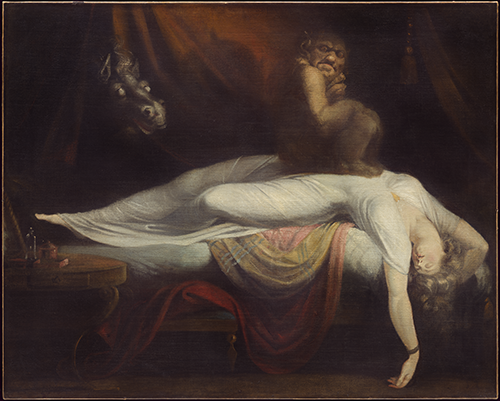 Painting by Henry Fuseli: The Nightmare shows a woman in deep sleep with her arms thrown below her, and with a demonic and apelike incubus crouched on her chest. The painting's dream like and haunting erotic evocation of infatuation and obsession was a huge popular success. After its first exhibition, at the 1782 Royal Academy of London, critics and patrons reacted with horrified fascination and the work became widely popular, to the extent that it was parodied in political satire, and an engraved version was widely distributed. In response, Fuseli produced at least three other versions.
Painting by Henry Fuseli: The Nightmare shows a woman in deep sleep with her arms thrown below her, and with a demonic and apelike incubus crouched on her chest. The painting's dream like and haunting erotic evocation of infatuation and obsession was a huge popular success. After its first exhibition, at the 1782 Royal Academy of London, critics and patrons reacted with horrified fascination and the work became widely popular, to the extent that it was parodied in political satire, and an engraved version was widely distributed. In response, Fuseli produced at least three other versions.
1781
Los Angeles, California, is founded by 54 settlers, including 26 of African ancestry.
 Immanuel Kant publishes Critique of Pure Reason, a fundamental work of modern philosophy.
Immanuel Kant publishes Critique of Pure Reason, a fundamental work of modern philosophy.
(no entry for this year)
1782
Britain signs agreement recognizing U.S. independence.
Congress approves Great Seal of U.S. and the eagle as its symbol.
(no entry for this year)
1783
American Revolution Ends Britain and the infant United States sign the Peace of Paris treaty.
Earthquakes ravage Calabria in Italy, killing 30,000.
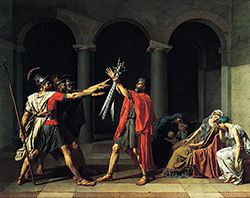 Painting by Jacques-Louis David: Oath of the Horatii (French: Le Serment des Horaces), is now on display in the Louvre in Paris. The painting immediately became a huge success with critics and the public, and remains one of the best known paintings in the Neoclassical style. It depicts a scene from a Roman legend about a dispute between two warring cities, Rome and Alba Longa. Instead of the two cities sending their armies to war, they agree to choose three men from each city; the victor in that fight will be the victorious city. From Rome, three brothers from a Roman family, the Horatii, agree to end the war by fighting three brothers from a family of Alba Longa, the Curiatii. The three brothers, all of whom appear willing to sacrifice their lives for the good of Rome, are shown saluting their father who holds their swords out for them. Aside from the three brothers depicted, David also represents, in the bottom right corner, a woman crying whilst sitting down. She is Camilla, a sister of the Horatii brothers, who is also betrothed to one of the Curiatii fighters, and thus she weeps in the realisation that, in any case, she will lose someone she loves. The painting is considered a paragon of neoclassical art.
Painting by Jacques-Louis David: Oath of the Horatii (French: Le Serment des Horaces), is now on display in the Louvre in Paris. The painting immediately became a huge success with critics and the public, and remains one of the best known paintings in the Neoclassical style. It depicts a scene from a Roman legend about a dispute between two warring cities, Rome and Alba Longa. Instead of the two cities sending their armies to war, they agree to choose three men from each city; the victor in that fight will be the victorious city. From Rome, three brothers from a Roman family, the Horatii, agree to end the war by fighting three brothers from a family of Alba Longa, the Curiatii. The three brothers, all of whom appear willing to sacrifice their lives for the good of Rome, are shown saluting their father who holds their swords out for them. Aside from the three brothers depicted, David also represents, in the bottom right corner, a woman crying whilst sitting down. She is Camilla, a sister of the Horatii brothers, who is also betrothed to one of the Curiatii fighters, and thus she weeps in the realisation that, in any case, she will lose someone she loves. The painting is considered a paragon of neoclassical art.
1784
John Jay becomes first U.S. Secretary of State.
Russian trappers established a colony on Kodiak Island, Alaska.
Congress narrowly defeats Thomas Jefferson's proposal to ban slavery in new territories after 1800.
Treaty of Paris ratified, officially ending the American Revolutionary War
Congress of the Confederation ratifies the Treaty of Paris on January 14, 1784, formally ending the Revolutionary War.
John Wesley charters Methodist Church.
(no entry for this year)
1785
New York frees all slaves who served in the Revolutionary Army.
Napoleon Bonaparte (16) graduates from the military academy in Paris (42nd in a class of 51).
 Mozart's opera, The Marriage of Figaro, premieres in Vienna.
Mozart's opera, The Marriage of Figaro, premieres in Vienna.
1786
 Frederick the Great, King of Prussia, dies.
Frederick the Great, King of Prussia, dies.
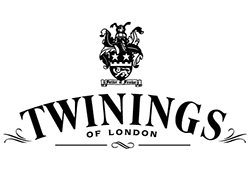 Twining's Tea creates a logo that is still in use today, making it the world's oldest, continuous use logo. The founder of Twinings was Thomas Twining from Painswick, Gloucestershire in England. He opened Britain's first known tea room at No. 216 Strand, London, in 1706; it still operates today.
Twining's Tea creates a logo that is still in use today, making it the world's oldest, continuous use logo. The founder of Twinings was Thomas Twining from Painswick, Gloucestershire in England. He opened Britain's first known tea room at No. 216 Strand, London, in 1706; it still operates today.
1787
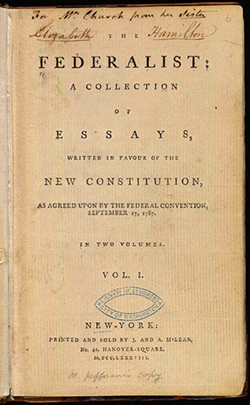 Federalist Papers published, calls for ratification of Constitution. The Federalist (later known as The Federalist Papers) is a collection of 85 articles and essays written (under the pseudonym Publius) by Alexander Hamilton, James Madison, and John Jay promoting the ratification of the United States Constitution. Seventy-seven were published serially in the Independent Journal and the New York Packet between October 1787 and August 1788. A compilation of these and eight others, called The Federalist: A Collection of Essays, Written in Favour of the New Constitution, as Agreed upon by the Federal Convention, September 17, 1787, was published in two volumes in 1788 by J. and A. McLean. The collection's original title was The Federalist; the title The Federalist Papers did not emerge until the 20th century. This book should be carefully read by anyone with an interest in American democracy.
Federalist Papers published, calls for ratification of Constitution. The Federalist (later known as The Federalist Papers) is a collection of 85 articles and essays written (under the pseudonym Publius) by Alexander Hamilton, James Madison, and John Jay promoting the ratification of the United States Constitution. Seventy-seven were published serially in the Independent Journal and the New York Packet between October 1787 and August 1788. A compilation of these and eight others, called The Federalist: A Collection of Essays, Written in Favour of the New Constitution, as Agreed upon by the Federal Convention, September 17, 1787, was published in two volumes in 1788 by J. and A. McLean. The collection's original title was The Federalist; the title The Federalist Papers did not emerge until the 20th century. This book should be carefully read by anyone with an interest in American democracy.
Constitutional convention opens at Philadelphia, George Washington presiding.
The Northwest Ordinance bans slavery in the Northwest Territory (what becomes the states of Ohio, Indiana, Illinois, Michigan, and Wisconsin). The ordinance together with state emancipation laws create a free North.
Austrian emperor Jozef II bans children under 8 from labor.
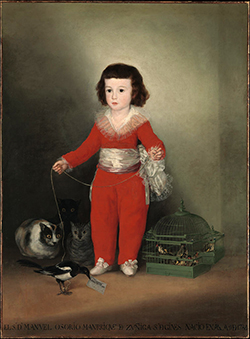 Painting by Francisco de Goya: Manuel Osorio Manrique de Zúñiga, also known as Goya's Red Boy. Vicente Joaquin Osorio de Moscoso y Guzmán (1756–1816), Count of Altamira, had hired Goya for several family portraits. Altamira held many titles and was also a director of the Banco de San Carlos. In 1786, after painting several portraits of the court, Goya was nominated painter to Charles III. This painting, from 1787–88, is of Altimira's youngest son, Manuel, who was born in April 1784 and died at age eight on June 12, 1792.
Painting by Francisco de Goya: Manuel Osorio Manrique de Zúñiga, also known as Goya's Red Boy. Vicente Joaquin Osorio de Moscoso y Guzmán (1756–1816), Count of Altamira, had hired Goya for several family portraits. Altamira held many titles and was also a director of the Banco de San Carlos. In 1786, after painting several portraits of the court, Goya was nominated painter to Charles III. This painting, from 1787–88, is of Altimira's youngest son, Manuel, who was born in April 1784 and died at age eight on June 12, 1792.
1788
Maryland votes (December 23) to cede a ten-square-mile area for District of Columbia.
New York City becomes first capital of US.
The Massachusetts General Court (legislature), following an incident in which free blacks were kidnapped and transported to the island of Martinique, declares the slave trade illegal and provides monetary damages to victims of kidnappings.
Captain Arthur Phillip forms English colony at Sydney, Botany Bay, New South Wales, Australia.
 Kant publishes Critique of Practical Reason.
Kant publishes Critique of Practical Reason.
(no entry for this year)
1789
US Congress passes Federal Judiciary Act, creating a six-person Supreme Court.
 George Washington becomes the first president of the United States.
George Washington becomes the first president of the United States.
 Fletcher Christian leads Mutiny on HMS Bounty and Captain William Bligh. Mutineers from the Bounty settle on Pitcairn Island.
Fletcher Christian leads Mutiny on HMS Bounty and Captain William Bligh. Mutineers from the Bounty settle on Pitcairn Island.
 Former slave Olaudah Equiano publishes his memoirs, and he travels in Britain lecturing against slavery.
Former slave Olaudah Equiano publishes his memoirs, and he travels in Britain lecturing against slavery.
The fall of the Bastille marks the beginning of the French Revolution.
(no entry for this year)
1790
First U.S. census is conducted, showing a population of 3,939,214.
Society of Friends petitions Congress for abolition of slavery.
The first ten amendments to the US Constitution — The Bill of Rights — are ratified.
Washington, D.C., founded as the capitol of the United States.
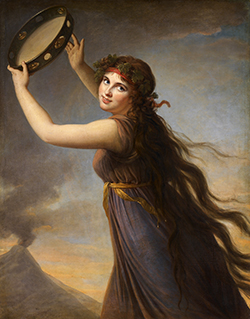 Painting by Élisabeth Vigée Le Brun: Lady Hamilton as a Bacchante Emma, Lady Hamilton, model and actress, is best remembered as the mistress of Lord Nelson and as the muse of George Romney. She was born Amy Lyon in Ness near Neston, Cheshire, England, the daughter of Henry Lyon, a blacksmith who died when she was two months old. She was raised by her mother, the former Mary Kidd, at Hawarden, and received no formal education. She later changed her name to Emma Hart.
Painting by Élisabeth Vigée Le Brun: Lady Hamilton as a Bacchante Emma, Lady Hamilton, model and actress, is best remembered as the mistress of Lord Nelson and as the muse of George Romney. She was born Amy Lyon in Ness near Neston, Cheshire, England, the daughter of Henry Lyon, a blacksmith who died when she was two months old. She was raised by her mother, the former Mary Kidd, at Hawarden, and received no formal education. She later changed her name to Emma Hart.
1791
Vermont admitted as 14th state (first addition to the original thirteen colonies).
"La Marseillaise" composed by Claude-Joseph Rouget de Lisle.
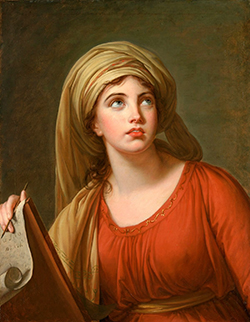 Painting by Élisabeth Vigée Le Brun: Lady Hamilton as the Persian Sibyl, commissioned by the Duc de Brissac and painted in Naples, a copy of which was sent to Sir William. This portrait gained great fame wherever it was displayed, and was instrumental in the rise of Le Brun's career as a portrait artist.[ Emma, Lady Hamilton, model and actress, is best remembered as the mistress of Lord Nelson and as the muse of George Romney. She was born Amy Lyon in Ness near Neston, Cheshire, England, the daughter of Henry Lyon, a blacksmith who died when she was two months old. She was raised by her mother, the former Mary Kidd, at Hawarden, and received no formal education. She later changed her name to Emma Hart.
Painting by Élisabeth Vigée Le Brun: Lady Hamilton as the Persian Sibyl, commissioned by the Duc de Brissac and painted in Naples, a copy of which was sent to Sir William. This portrait gained great fame wherever it was displayed, and was instrumental in the rise of Le Brun's career as a portrait artist.[ Emma, Lady Hamilton, model and actress, is best remembered as the mistress of Lord Nelson and as the muse of George Romney. She was born Amy Lyon in Ness near Neston, Cheshire, England, the daughter of Henry Lyon, a blacksmith who died when she was two months old. She was raised by her mother, the former Mary Kidd, at Hawarden, and received no formal education. She later changed her name to Emma Hart.
1792
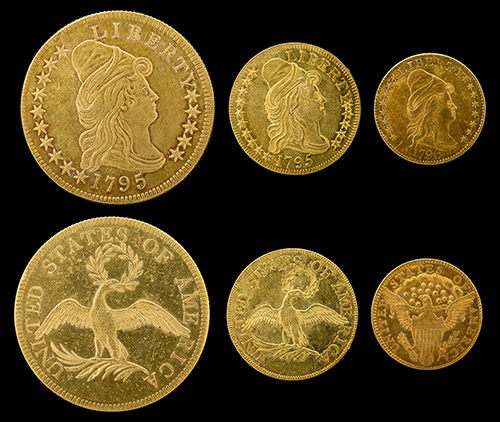 The Coinage Act of 1792 (also known as the Mint Act; officially: An act establishing a mint, and regulating the Coins of the United States), passed by the United States Congress on April 2, 1792, created the United States dollar as the country's standard unit of money, established the United States Mint, and regulated the coinage of the United States. This act established the silver dollar as the unit of money in the United States, declared it to be lawful tender, and created a decimal system for U.S. currency. The Act specified the issuing of three gold coins comprising a $10 gold coin called an "eagle", a $5 coin called a "half eagle", and a $2.5 coin called a "quarter eagle". The Act also authorized construction of a mint building in Philadelphia, the nation's capital at the time. This was the first federal building erected under the United States Constitution. Adjusted for inflation, the ten-dollar coin would be worth $231.00 in today's money. As collector's items, these gold coins have sold for more than $100,000 each.
The Coinage Act of 1792 (also known as the Mint Act; officially: An act establishing a mint, and regulating the Coins of the United States), passed by the United States Congress on April 2, 1792, created the United States dollar as the country's standard unit of money, established the United States Mint, and regulated the coinage of the United States. This act established the silver dollar as the unit of money in the United States, declared it to be lawful tender, and created a decimal system for U.S. currency. The Act specified the issuing of three gold coins comprising a $10 gold coin called an "eagle", a $5 coin called a "half eagle", and a $2.5 coin called a "quarter eagle". The Act also authorized construction of a mint building in Philadelphia, the nation's capital at the time. This was the first federal building erected under the United States Constitution. Adjusted for inflation, the ten-dollar coin would be worth $231.00 in today's money. As collector's items, these gold coins have sold for more than $100,000 each.
U.S. postal service created; postage 6–12 cents, depending on distance. (In today's dollars, that would be somewhere between $1.40 and $3.00.)
Captain George Vancouver claims Puget Sound for Britain.
France declares war on Austria, starting French Revolutionary Wars.
The French Republic is proclaimed.
Twenty-four merchants form New York Stock Exchange at 70 Wall Street.
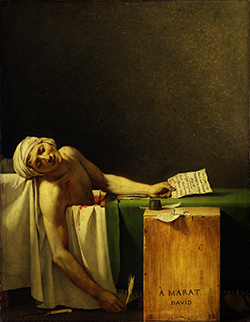 Painting by Jacques-Louis David: The Death of Marat (French: La Mort de Marat or Marat Assassiné) is one of the most famous images of the French Revolution. David was the leading French painter, as well as a Montagnard and a member of the revolutionary Committee of General Security. The painting shows the radical journalist lying dead in his bath on 13 July 1793 after his murder by Charlotte Corday. Painted in the months after Marat's murder, it has been described by T. J. Clark as the first modernist painting, for "the way it took the stuff of politics as its material, and did not transmute it".
Painting by Jacques-Louis David: The Death of Marat (French: La Mort de Marat or Marat Assassiné) is one of the most famous images of the French Revolution. David was the leading French painter, as well as a Montagnard and a member of the revolutionary Committee of General Security. The painting shows the radical journalist lying dead in his bath on 13 July 1793 after his murder by Charlotte Corday. Painted in the months after Marat's murder, it has been described by T. J. Clark as the first modernist painting, for "the way it took the stuff of politics as its material, and did not transmute it".
1793
To enforce Article IV, Section 2, the U.S. Congress enacts the Fugitive Slave Law. It allows slaveowners to cross state lines to recapture their slaves. They must then prove ownership in a court of law. In reaction, some Northern states pass personal liberty laws, granting the alleged fugitive slaves the rights to habeas corpus, jury trials, and testimony on their own behalf. These Northern state legislatures also pass anti-kidnapping laws to punish slave-catchers who kidnap free blacks, instead of fugitive slaves.
 King Louis XVI of France is executed.
King Louis XVI of France is executed.
(no entry for this year)
1794
Slavery abolished in the French colonies.
Beethoven (24) debuts as pianist in Vienna.
1795
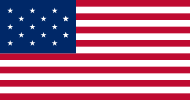 The US flag is modified to have fifteen stars and fifteen stripes, reflecting the addition of two new states: Vermont and Kentucky. This is the only US flag to have other than thirteen stripes.
The US flag is modified to have fifteen stars and fifteen stripes, reflecting the addition of two new states: Vermont and Kentucky. This is the only US flag to have other than thirteen stripes.
(no entry for this year)
1796
George Washington declines a third term as President, gives his Farewell Address.
(no entry for this year)
1798
Napoleon invades Egypt and defeats the Egyptians at the Battle of the Pyramids.
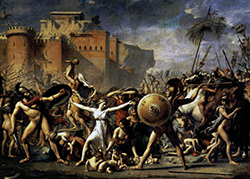 Painting by Jacques-Louis David: The Intervention of the Sabine Women shows a legendary episode following the abduction of the Sabine women by the founding generation of Rome. The genesis of Les Sabines and the work itself represented a significant departure for the day. Historical depictions had been typically commissioned. David however, conceived, produced and promoted his work for profit. He produced marketing material to accompany the first exhibition. Le Tableau des Sabines, Exposé Publiquement au Palais National des Sciences et des Arts "the Tableau of the Sabines, Public Exhibition at the National Palace of Arts and Science" contained his own account of the episode and anticipated the controversy over his use of nudity with an end-note explaining his rationale. Its 1799 exhibition attracted a large number of paying visitors for several years and in 1819 he sold Les Sabines and his L onidas at Thermopylae to the Royal Museums for 10,000 francs.
Painting by Jacques-Louis David: The Intervention of the Sabine Women shows a legendary episode following the abduction of the Sabine women by the founding generation of Rome. The genesis of Les Sabines and the work itself represented a significant departure for the day. Historical depictions had been typically commissioned. David however, conceived, produced and promoted his work for profit. He produced marketing material to accompany the first exhibition. Le Tableau des Sabines, Exposé Publiquement au Palais National des Sciences et des Arts "the Tableau of the Sabines, Public Exhibition at the National Palace of Arts and Science" contained his own account of the episode and anticipated the controversy over his use of nudity with an end-note explaining his rationale. Its 1799 exhibition attracted a large number of paying visitors for several years and in 1819 he sold Les Sabines and his L onidas at Thermopylae to the Royal Museums for 10,000 francs.
1799
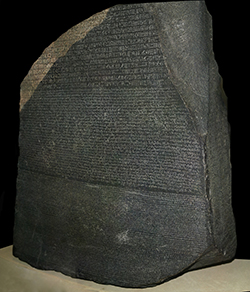 The Rosetta Stone is discovered in Egypt. The stone is a fragment of an Egyptian stele with the same inscription in three texts: ancient Egyptian hieroglyphs, Egyptian demotic script, and Greek. This side-by-side translation allows historians to translate ancient Egyptian hieroglyphs for the first time.
The Rosetta Stone is discovered in Egypt. The stone is a fragment of an Egyptian stele with the same inscription in three texts: ancient Egyptian hieroglyphs, Egyptian demotic script, and Greek. This side-by-side translation allows historians to translate ancient Egyptian hieroglyphs for the first time.
 Napoleon Bonaparte becomes First Consul and seizes power in France.
Napoleon Bonaparte becomes First Consul and seizes power in France.
First performance of Ludwig von Beethoven's 1st Symphony in C.
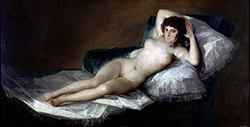 Painting by Francisco de Goya: The Nude Maja (Spanish: La Maja Desnuda) portrays a nude woman reclining on a bed of pillows, and was probably commissioned by Manuel de Godoy, to hang in his private collection in a separate cabinet reserved for nude paintings. Goya created a pendant of the same woman identically posed, but clothed, known today as La maja vestida (The Clothed Maja); also in the Prado, it is usually hung next to La maja desnuda. The subject is identified as a maja based on her costume in La maja vestida. The painting is renowned for the straightforward and unashamed gaze of the model towards the viewer. With this work Goya not only upset the ecclesiastical authorities, but also titillated the public and extended the artistic horizon of the day. It has been in the Museo del Prado in Madrid since 1901.
Painting by Francisco de Goya: The Nude Maja (Spanish: La Maja Desnuda) portrays a nude woman reclining on a bed of pillows, and was probably commissioned by Manuel de Godoy, to hang in his private collection in a separate cabinet reserved for nude paintings. Goya created a pendant of the same woman identically posed, but clothed, known today as La maja vestida (The Clothed Maja); also in the Prado, it is usually hung next to La maja desnuda. The subject is identified as a maja based on her costume in La maja vestida. The painting is renowned for the straightforward and unashamed gaze of the model towards the viewer. With this work Goya not only upset the ecclesiastical authorities, but also titillated the public and extended the artistic horizon of the day. It has been in the Museo del Prado in Madrid since 1901.
1800
(no entry for this year)
(no entry for this year)
1801
 Thomas Jefferson becomes the third president of the United States.
Thomas Jefferson becomes the third president of the United States.
Ireland and Great Britain, England and Scotland, form United Kingdom.
(no entry for this year)
1802
The Ohio Constitution outlaws slavery. It also prohibits free blacks from voting.
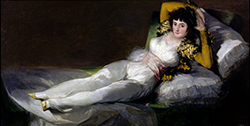 Painting by Francisco de Goya: The Clothed Maja (Spanish: La maja vestida) is a clothed version of the earlier La maja desnuda (1797–1800) and is exhibited next to it in the same room at the Prado Museum in Madrid. It was twice in the collection of the Royal Academy of Fine Arts of San Fernando, also in Madrid, being "sequestered" by the Spanish Inquisition between 1814 and 1836, and has been in the Museo del Prado since 1901.
Painting by Francisco de Goya: The Clothed Maja (Spanish: La maja vestida) is a clothed version of the earlier La maja desnuda (1797–1800) and is exhibited next to it in the same room at the Prado Museum in Madrid. It was twice in the collection of the Royal Academy of Fine Arts of San Fernando, also in Madrid, being "sequestered" by the Spanish Inquisition between 1814 and 1836, and has been in the Museo del Prado since 1901.
1803
U.S. President Thomas Jefferson appoints Meriwether Lewis and William Clark to explore the uncharted West. Among the marvels Lewis and Clark are expected to find are erupting volcanoes, mountains of salt, unicorns, living mastodons and seven-foot-tall beavers. They will find none of these, but will find fossils.
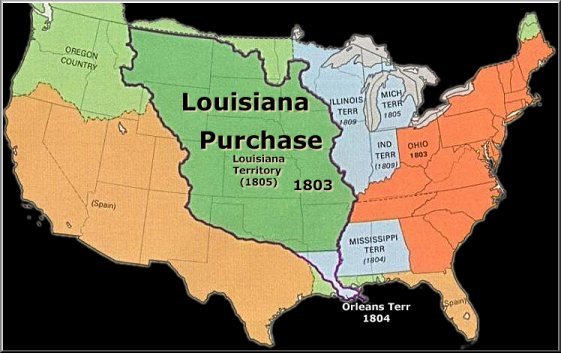 US buys large tract of land from France — The Louisiana Purchase.
US buys large tract of land from France — The Louisiana Purchase.
(no entry for this year)
1804

 Meriwether Lewis and William Clark begin their exploration of the Louisiana territory.
Meriwether Lewis and William Clark begin their exploration of the Louisiana territory.
(no entry for this year)
1805
 Britain's Lord Nelson defeats the Franco-Spanish fleet at the Battle of Trafalgar. Lord Nelson is killed, but his victory ends Napoleons power at sea and makes a French invasion of Britain impossible.
Britain's Lord Nelson defeats the Franco-Spanish fleet at the Battle of Trafalgar. Lord Nelson is killed, but his victory ends Napoleons power at sea and makes a French invasion of Britain impossible.
(no entry for this year)
1806
(no entry for this year)
(no entry for this year)
1807
The Slave Trade Act 1807 or the Abolition of the Slave Trade Act 1807, was an Act of the Parliament of the United Kingdom passed on 25 March 1807, with the title of "An Act for the Abolition of the Slave Trade". The original act is in the Parliamentary Archives. The act abolished the slave trade in the British Empire, in particular the Atlantic slave trade, and also encouraged British action to press other European states to abolish their slave trades, but it did not abolish slavery itself.
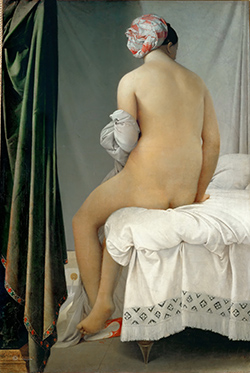 Painting by Jean-Auguste-Dominique Ingres: The Valpincon Bather, painted while the artist was studying at the French Academy in Rome, it was originally titled Seated Woman but later became known after one of its nineteenth-century owners. Ingres had earlier painted female nudes, such as his Bathing Woman of 1807, yet this work is widely regarded as his first great treatment of the subject. As in the previous smaller work, the model is shown from behind; however, The Valpincon Bather lacks the earlier painting's overt sexuality, instead depicting a calm and measured sensuality.
Painting by Jean-Auguste-Dominique Ingres: The Valpincon Bather, painted while the artist was studying at the French Academy in Rome, it was originally titled Seated Woman but later became known after one of its nineteenth-century owners. Ingres had earlier painted female nudes, such as his Bathing Woman of 1807, yet this work is widely regarded as his first great treatment of the subject. As in the previous smaller work, the model is shown from behind; however, The Valpincon Bather lacks the earlier painting's overt sexuality, instead depicting a calm and measured sensuality.
1808
United States Bans Slave Trade Importing African slaves is outlawed, but smuggling continues.
The US prohibits the importation of new slaves from Africa (but the holding of existing slaves and their descendents remains legal).
(no entry for this year)
1809
 12 Feb 1809
12 Feb 1809
Abraham Lincoln is born
 James Madison becomes the fourth president of the United States.
James Madison becomes the fourth president of the United States.
(no entry for this year)
1810
(no entry for this year)
(no entry for this year)
1811
"Luddites" destroy industrial machines in North England, in protest over too rapid modernization.
(no entry for this year)
1812
Between 1812 and 1815, the United States and Great Britain fight the War of 1812.
Napoleon invades Russia; he captures Moscow, but unable to spend the winter there when the city catches fire, he marches his army back to France, experiencing tremendous losses along the way.
US declares war on Britain — War of 1812 begins.
(no entry for this year)
1813
(no entry for this year)
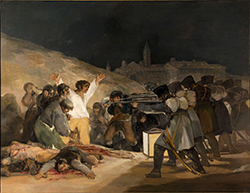 Painting by Francisco de Goya: The Third of May 1808 (also known as El tres de mayo de 1808 en Madrid or Los fusilamientos de la montaña del Príncipe Pío, or Los fusilamientos del tres de mayo) is now in the Museo del Prado, Madrid. In the work, Goya sought to commemorate Spanish resistance to Napoleon's armies during the occupation of 1808 in the Peninsular War. Along with its companion piece of the same size, The Second of May 1808 (or The Charge of the Mamelukes), it was commissioned by the provisional government of Spain at Goya's suggestion. The painting's content, presentation, and emotional force secure its status as a groundbreaking, archetypal image of the horrors of war. Although it draws on many sources from both high and popular art, The Third of May 1808 marks a clear break from convention. Diverging from the traditions of Christian art and traditional depictions of war, it has no distinct precedent, and is acknowledged as one of the first paintings of the modern era. According to the art historian Kenneth Clark, The Third of May 1808 is "the first great picture which can be called revolutionary in every sense of the word, in style, in subject, and in intention".
Painting by Francisco de Goya: The Third of May 1808 (also known as El tres de mayo de 1808 en Madrid or Los fusilamientos de la montaña del Príncipe Pío, or Los fusilamientos del tres de mayo) is now in the Museo del Prado, Madrid. In the work, Goya sought to commemorate Spanish resistance to Napoleon's armies during the occupation of 1808 in the Peninsular War. Along with its companion piece of the same size, The Second of May 1808 (or The Charge of the Mamelukes), it was commissioned by the provisional government of Spain at Goya's suggestion. The painting's content, presentation, and emotional force secure its status as a groundbreaking, archetypal image of the horrors of war. Although it draws on many sources from both high and popular art, The Third of May 1808 marks a clear break from convention. Diverging from the traditions of Christian art and traditional depictions of war, it has no distinct precedent, and is acknowledged as one of the first paintings of the modern era. According to the art historian Kenneth Clark, The Third of May 1808 is "the first great picture which can be called revolutionary in every sense of the word, in style, in subject, and in intention".
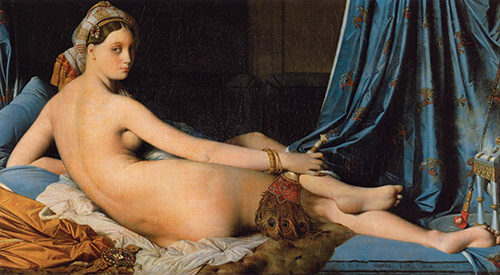 Painting by Jean Auguste Dominique Ingres: Grande Odalisque, also known as Une Odalisque or La Grande Odalisque depicts an odalisque, or concubine. Ingres' contemporaries considered the work to signify Ingres' break from Neoclassicism, indicating a shift toward exotic Romanticism. Grande Odalisque attracted wide criticism when it was first shown. It has been especially noted for the elongated proportions and lack of anatomical realism. The work is displayed in the Louvre, Paris. The painting was commissioned by Napoleon's sister, Queen Caroline Murat of Naples, and finished in 1814. Ingres drew upon works such as Dresden Venus by Giorgione, and Titian's Venus of Urbino as inspiration for his reclining nude figure, though the actual pose of a reclining figure looking back over her shoulder is directly drawn from the 1809 Portrait of Madame Récamier by Jacques-Louis David. Ingres portrays a concubine in languid pose as seen from behind with distorted proportions. The small head, elongated limbs, and cool color scheme all reveal influences from Mannerists such as Parmigianino, whose Madonna with the Long Neck was also famous for anatomical distortion. This eclectic mix of styles, combining classical form with Romantic themes, prompted harsh criticism when it was first shown in 1814. Critics viewed Ingres as a rebel against the contemporary style of form and content
Painting by Jean Auguste Dominique Ingres: Grande Odalisque, also known as Une Odalisque or La Grande Odalisque depicts an odalisque, or concubine. Ingres' contemporaries considered the work to signify Ingres' break from Neoclassicism, indicating a shift toward exotic Romanticism. Grande Odalisque attracted wide criticism when it was first shown. It has been especially noted for the elongated proportions and lack of anatomical realism. The work is displayed in the Louvre, Paris. The painting was commissioned by Napoleon's sister, Queen Caroline Murat of Naples, and finished in 1814. Ingres drew upon works such as Dresden Venus by Giorgione, and Titian's Venus of Urbino as inspiration for his reclining nude figure, though the actual pose of a reclining figure looking back over her shoulder is directly drawn from the 1809 Portrait of Madame Récamier by Jacques-Louis David. Ingres portrays a concubine in languid pose as seen from behind with distorted proportions. The small head, elongated limbs, and cool color scheme all reveal influences from Mannerists such as Parmigianino, whose Madonna with the Long Neck was also famous for anatomical distortion. This eclectic mix of styles, combining classical form with Romantic themes, prompted harsh criticism when it was first shown in 1814. Critics viewed Ingres as a rebel against the contemporary style of form and content
1814
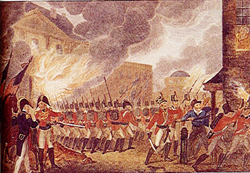 The British army burns down the White House in Washington DC.
The British army burns down the White House in Washington DC.
The defeat of the Creeks by Andrew Jackson begins the forced departure of Indian peoples from the South.
(no entry for this year)
1815
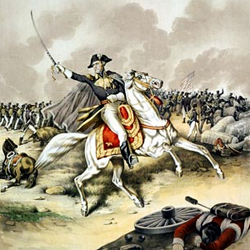 Three thousand troops of the United States Army, led by General Andrew Jackson, defeat the British at the Battle of New Orleans. Six hundred of the US troops are African-American.
Three thousand troops of the United States Army, led by General Andrew Jackson, defeat the British at the Battle of New Orleans. Six hundred of the US troops are African-American.

 An Allied army, led by Britain's Duke of Wellington, defeats Napoleon at the Battle of Waterloo.
An Allied army, led by Britain's Duke of Wellington, defeats Napoleon at the Battle of Waterloo.
(no entry for this year)
1816
Shaka becomes ruler of the Zulu Kingdom; his disciplined and mobile army conquers many peoples of southeastern Africa.
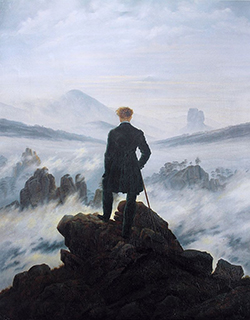 painting by Caspar David Friedrich: Wanderer above the Sea of Fog (German: Der Wanderer über dem Nebelmeer), also known as Wanderer Above the Mist or Mountaineer in a misty Landscape, currently resides in the Kunsthalle Hamburg in Hamburg, Germany. Wanderer above the Sea of Fog is true to the Romantic style and Friedrich's style in particular. Gorra's (2004) analysis was that the message conveyed by the painting is one of Kantian self-reflection, expressed through the wanderer's gazings into the murkiness of the sea of fog.
painting by Caspar David Friedrich: Wanderer above the Sea of Fog (German: Der Wanderer über dem Nebelmeer), also known as Wanderer Above the Mist or Mountaineer in a misty Landscape, currently resides in the Kunsthalle Hamburg in Hamburg, Germany. Wanderer above the Sea of Fog is true to the Romantic style and Friedrich's style in particular. Gorra's (2004) analysis was that the message conveyed by the painting is one of Kantian self-reflection, expressed through the wanderer's gazings into the murkiness of the sea of fog.
1818
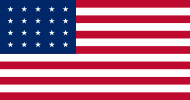 The US flag is modified to have twenty stars, reflecting the addition of five new states: Indiana, Louisiana, Mississippi, Ohio, and Tennessee. The number of stripes is returned to thirteen (both to symbolize the original thirteen states and to avoid having the number of stripes get so large that the flag would seem pink). From this point on, the US flag will have the same overall design, with changes in the number of stars used to denote the addition of new states.
The US flag is modified to have twenty stars, reflecting the addition of five new states: Indiana, Louisiana, Mississippi, Ohio, and Tennessee. The number of stripes is returned to thirteen (both to symbolize the original thirteen states and to avoid having the number of stripes get so large that the flag would seem pink). From this point on, the US flag will have the same overall design, with changes in the number of stars used to denote the addition of new states.
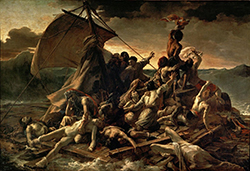 Painting by Théodore Géricault: The Raft of the Medusa (French: Le Radeau de la Méduse) was completed when the artist was 27. The work has become an icon of French Romanticism. At 16' 1" × 23' 6", it is an over-life-size painting that depicts a moment from the aftermath of the wreck of the French naval frigate Méduse, which ran aground off the coast of today's Mauritania on 2 July 1816. On 5 July 1816, at least 147 people were set adrift on a hurriedly constructed raft; all but 15 died in the 13 days before their rescue, and those who survived endured starvation and dehydration and practised cannibalism. Géricault chose to depict this event in order to launch his career with a large-scale uncommissioned work on a subject that had already generated great public interest. The event fascinated him, and before he began work on the final painting, he undertook extensive research and produced many preparatory sketches. He interviewed two of the survivors and constructed a detailed scale model of the raft. He visited hospitals and morgues where he could view, first-hand, the colour and texture of the flesh of the dying and dead. As he had anticipated, the painting proved highly controversial at its first appearance in the 1819 Paris Salon, attracting passionate praise and condemnation in equal measure. However, it established his international reputation, and today is widely seen as seminal in the early history of the Romantic movement in French painting.
Painting by Théodore Géricault: The Raft of the Medusa (French: Le Radeau de la Méduse) was completed when the artist was 27. The work has become an icon of French Romanticism. At 16' 1" × 23' 6", it is an over-life-size painting that depicts a moment from the aftermath of the wreck of the French naval frigate Méduse, which ran aground off the coast of today's Mauritania on 2 July 1816. On 5 July 1816, at least 147 people were set adrift on a hurriedly constructed raft; all but 15 died in the 13 days before their rescue, and those who survived endured starvation and dehydration and practised cannibalism. Géricault chose to depict this event in order to launch his career with a large-scale uncommissioned work on a subject that had already generated great public interest. The event fascinated him, and before he began work on the final painting, he undertook extensive research and produced many preparatory sketches. He interviewed two of the survivors and constructed a detailed scale model of the raft. He visited hospitals and morgues where he could view, first-hand, the colour and texture of the flesh of the dying and dead. As he had anticipated, the painting proved highly controversial at its first appearance in the 1819 Paris Salon, attracting passionate praise and condemnation in equal measure. However, it established his international reputation, and today is widely seen as seminal in the early history of the Romantic movement in French painting.
1819
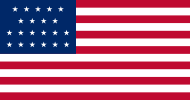 The US flag is modified to have twenty-one stars, reflecting the addition of one new state: Illinois.
The US flag is modified to have twenty-one stars, reflecting the addition of one new state: Illinois.
The Canadian government refuses to cooperate with the American government in the apprehension of fugitive slaves living in Canada. Consequently Canada becomes the destination for 40,000 fugitive slaves from United States between 1819 in 1861.
 The SS Savannah was an American hybrid sailing ship/side-wheel steamer built in 1818. She becomes the first steamship to cross the Atlantic Ocean, a feat accomplished during May–June, 1819. The Savannah was converted back into a sailing ship after returning from Europe. She was wrecked of Long Island in 1821.
The SS Savannah was an American hybrid sailing ship/side-wheel steamer built in 1818. She becomes the first steamship to cross the Atlantic Ocean, a feat accomplished during May–June, 1819. The Savannah was converted back into a sailing ship after returning from Europe. She was wrecked of Long Island in 1821.
The United States purchases Florida from Spain.
(no entry for this year)
1820
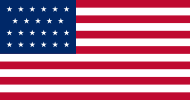 The US flag is modified to have twenty-three stars, reflecting the addition of two new states: Alabama and Maine.
The US flag is modified to have twenty-three stars, reflecting the addition of two new states: Alabama and Maine.
Debate over slavery in the US heats up; The Missouri Compromise admits Maine into the Union as a free state, with Missouri to enter the next year as a slave state. Slavery is banned north of the 36 30' line of latitude in the Louisiana Territory.
Missouri Compromise Missouri is admitted to the Union as a slave state, Maine as a free state. Slavery is forbidden in any subsequent territories north of latitude .
The first Christian missionaries arrived in the Hawaiian Islands.
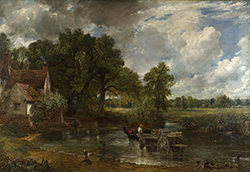 Painting by John Constable: The Hay Wain depicts a rural scene on the River Stour between the English counties of Suffolk and Essex. It hangs in the National Gallery in London and is regarded as "Constable's most famous image" and one of the greatest and most popular English paintings. Painted in oils on canvas, the work depicts as its central feature three horses pulling what in fact appears to be a wood wain or large farm cart across the river. Willy Lott's Cottage, also the subject of an eponymous painting by Constable, is visible on the far left. The scene takes place near Flatford Mill in Suffolk, though since the Stour forms the border of two counties, the left bank is in Suffolk and the landscape on the right bank is in Essex.
Painting by John Constable: The Hay Wain depicts a rural scene on the River Stour between the English counties of Suffolk and Essex. It hangs in the National Gallery in London and is regarded as "Constable's most famous image" and one of the greatest and most popular English paintings. Painted in oils on canvas, the work depicts as its central feature three horses pulling what in fact appears to be a wood wain or large farm cart across the river. Willy Lott's Cottage, also the subject of an eponymous painting by Constable, is visible on the far left. The scene takes place near Flatford Mill in Suffolk, though since the Stour forms the border of two counties, the left bank is in Suffolk and the landscape on the right bank is in Essex.
1821
(no entry for this year)
(no entry for this year)
1822
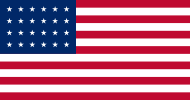 The US flag is modified to have twenty-four stars, reflecting the addition of one new state: Missouri.
The US flag is modified to have twenty-four stars, reflecting the addition of one new state: Missouri.
Slave Revolt: South Carolina Freed slave Denmark Vesey attempts a rebellion in Charleston. Thirty-five participants in the ill-fated uprising are hanged.
(no entry for this year)
1823
Slavery is abolished in Chile.
(no entry for this year)
1824
Mexico outlaws slavery. This decision creates the incentive for Anglo Texans to fight for independence in 1835-1836.
Mexico becomes a republic, three years after declaring independence from Spain.
 The Diary of Samuel Pepys is published in Britain. Pepys (1633-1703) had been a secretary of the Admiralty, a member of Parliament, and President of the Royal Society, and his Diary presents an important and entertaining picture of London during the Restoration period.
The Diary of Samuel Pepys is published in Britain. Pepys (1633-1703) had been a secretary of the Admiralty, a member of Parliament, and President of the Royal Society, and his Diary presents an important and entertaining picture of London during the Restoration period.
1825
 The Last of the Mohicans, by James Fenimore Cooper, is published.
The Last of the Mohicans, by James Fenimore Cooper, is published.
1826
(no entry for this year)
(no entry for this year)
1827
(no entry for this year)
(no entry for this year)
1828
(no entry for this year)
 Chemist James Smithson (1765-1829) bequeaths £100,000 to found the Smithsonian Institution in Washington, D.C. The Institution will be founded in 1846.
Chemist James Smithson (1765-1829) bequeaths £100,000 to found the Smithsonian Institution in Washington, D.C. The Institution will be founded in 1846.
1829
 Andrew Jackson becomes the seventh president of the United States.
Andrew Jackson becomes the seventh president of the United States.
Slavery abolished in Mexico.
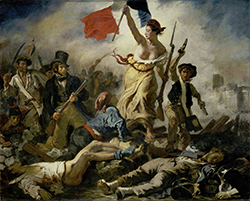 Painting by Eugène Delacroix: Liberty Leading the People (French: La Liberté guidant le peuple) commemorates the July Revolution of 1830, which toppled King Charles X of France. A woman personifying the concept and the Goddess of Liberty leads the people forward over a barricade and the bodies of the fallen, holding the flag of the French Revolution — the tricolour flag, which remains France's national flag — in one hand and brandishing a bayonetted musket with the other. The figure of Liberty is also viewed as a symbol of France and the French Republic known as Marianne. By the time Delacroix painted Liberty Leading the People, he was already the acknowledged leader of the Romantic school in French painting.
Painting by Eugène Delacroix: Liberty Leading the People (French: La Liberté guidant le peuple) commemorates the July Revolution of 1830, which toppled King Charles X of France. A woman personifying the concept and the Goddess of Liberty leads the people forward over a barricade and the bodies of the fallen, holding the flag of the French Revolution — the tricolour flag, which remains France's national flag — in one hand and brandishing a bayonetted musket with the other. The figure of Liberty is also viewed as a symbol of France and the French Republic known as Marianne. By the time Delacroix painted Liberty Leading the People, he was already the acknowledged leader of the Romantic school in French painting.
1830
 On April 6, the Church of Jesus Christ of Latter-Day Saints is founded by Joseph Smith Jr. (1805-1844), in Fayette, New York. In Palmyra, New York, The Book of Mormon is published for the first time; Smith has translated it, he says, from golden tablets he found buried near Palmyra.
On April 6, the Church of Jesus Christ of Latter-Day Saints is founded by Joseph Smith Jr. (1805-1844), in Fayette, New York. In Palmyra, New York, The Book of Mormon is published for the first time; Smith has translated it, he says, from golden tablets he found buried near Palmyra.
The first wagon trains to cross the Rocky Mountains arrived in California.
The U.S. Congress passes the Indian Removal Act.
The world's population tops 1,000,000,000 (it had been roughly 750 million only 50 years earlier).
(no entry for this year)
1831
Nat Turner leads a slave rebellion in Southampton, Virginia, killing at least 57 whites. Hundreds of black slaves are killed in retaliation.
Alabama makes it illegal for enslaved or free blacks to preach.
 In Boston, William Lloyd Garrison founds the abolitionist newspaper, The Liberator, signaling a dramatic shift in the antislavery movement. In the previous decades, it had centered in the South and favored a combination of compensated emancipation and colonization of freed slaves back to Africa. In the 1830s, the abolitionist movement becomes the dominant voice among antislavery advocates. Abolitionists demand the immediate end to slavery, which they consider to be a moral evil, without compensation to slaveowners.
In Boston, William Lloyd Garrison founds the abolitionist newspaper, The Liberator, signaling a dramatic shift in the antislavery movement. In the previous decades, it had centered in the South and favored a combination of compensated emancipation and colonization of freed slaves back to Africa. In the 1830s, the abolitionist movement becomes the dominant voice among antislavery advocates. Abolitionists demand the immediate end to slavery, which they consider to be a moral evil, without compensation to slaveowners.
Nat Turner, a literate slave who believes he is chosen to be the Moses of his people, instigates a slave revolt in Virginia. He and his followers kill 57 whites, but the revolt is unsuccessful and up to 200 slaves are killed. After an intense debate, the Virginia legislature narrowly rejects a bill to emancipate Virginia's slaves. The widespread fear of slave revolts, compounded by the rise of abolitionism, leads legislatures across the South to increase the harshness of their slave codes. Also, expressions of anti-slavery sentiment are suppressed throughout the South through state and private censorship.
North Carolina enacts a statute that bans teaching enslaved people to read and write.
Slave Revolt: Virginia Slave preacher Nat Turner leads a two-day uprising against whites, killing about 60. Militiamen crush the revolt then spend two months searching for Turner, who is eventually caught and hanged. Enraged Southerners impose harsher restrictions on their slaves.
 In Vienna, kitchen apprentice Franz Sacher, 16, creates what comes to be known as Sachertorte, for a dinner in honor of Austria's Prince Klemens Wenzel von Metternich.
In Vienna, kitchen apprentice Franz Sacher, 16, creates what comes to be known as Sachertorte, for a dinner in honor of Austria's Prince Klemens Wenzel von Metternich.
1832
Oberlin College is founded in Ohio. It admits African-Americans. By 1860, one third of its students are black.
 Electric telegraph invented by Samuel Morse.
Electric telegraph invented by Samuel Morse.
(no entry for this year)
1833
The American Anti-Slavery Society is established in Philadelphia.
The British Parliament abolishes slavery in the entire British Empire.
(no entry for this year)
1834
South Carolina bans the teaching of blacks, and slave or free, in its borders.
Federal troops are ordered to put down a riot by workers along the Chesapeake and Ohio Canal. It is the first time federal troops have been used to settle a labor battle in the United States.
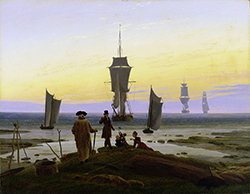 Painting by Caspar David Friedrich: The Stages of Life (German: Die Lebensstufen) is an allegorical oil painting completed just five years before his death. This picture, like many of his works, forms a meditation both on his own mortality and on the transience of life. The painting is set on a sea shore and shows in the foreground an aged man with his back turned to the viewer, walking towards two adults and two children on a hilltop overlooking a harbour. The figures are echoed by five ships shown in the harbour, each at a different distance from the shore, an allegorical reference to the different stages of human life, to the end of a journey, to the closeness of death. The figures have been identified as Friedrich and his family. The aged man is the artist himself, the small boy is his young son Gustav Adolf, the young girl is his daughter Agnes Adelheid, the older girl is his daughter Emma, and the man in the top hat is his nephew Johann Heinrich.}The Stages of Life (German: Die Lebensstufen) is an allegorical oil painting of 1835 by the German Romantic landscape painter Caspar David Friedrich. Completed just five years before his death, this picture, like many of his works, forms a meditation both on his own mortality and on the transience of life. The painting is set on a sea shore and shows in the foreground an aged man with his back turned to the viewer, walking towards two adults and two children on a hilltop overlooking a harbour. The figures are echoed by five ships shown in the harbour, each at a different distance from the shore, an allegorical reference to the different stages of human life, to the end of a journey, to the closeness of death. The figures have been identified as Friedrich and his family. The aged man is the artist himself, the small boy is his young son Gustav Adolf, the young girl is his daughter Agnes Adelheid, the older girl is his daughter Emma, and the man in the top hat is his nephew Johann Heinrich.
Painting by Caspar David Friedrich: The Stages of Life (German: Die Lebensstufen) is an allegorical oil painting completed just five years before his death. This picture, like many of his works, forms a meditation both on his own mortality and on the transience of life. The painting is set on a sea shore and shows in the foreground an aged man with his back turned to the viewer, walking towards two adults and two children on a hilltop overlooking a harbour. The figures are echoed by five ships shown in the harbour, each at a different distance from the shore, an allegorical reference to the different stages of human life, to the end of a journey, to the closeness of death. The figures have been identified as Friedrich and his family. The aged man is the artist himself, the small boy is his young son Gustav Adolf, the young girl is his daughter Agnes Adelheid, the older girl is his daughter Emma, and the man in the top hat is his nephew Johann Heinrich.}The Stages of Life (German: Die Lebensstufen) is an allegorical oil painting of 1835 by the German Romantic landscape painter Caspar David Friedrich. Completed just five years before his death, this picture, like many of his works, forms a meditation both on his own mortality and on the transience of life. The painting is set on a sea shore and shows in the foreground an aged man with his back turned to the viewer, walking towards two adults and two children on a hilltop overlooking a harbour. The figures are echoed by five ships shown in the harbour, each at a different distance from the shore, an allegorical reference to the different stages of human life, to the end of a journey, to the closeness of death. The figures have been identified as Friedrich and his family. The aged man is the artist himself, the small boy is his young son Gustav Adolf, the young girl is his daughter Agnes Adelheid, the older girl is his daughter Emma, and the man in the top hat is his nephew Johann Heinrich.
1835
Texas declares its independence from Mexico. In its constitution as an independent nation, Texas recognizes slavery and makes it difficult for free blacks to remain there.
Southern states expel abolitionists and forbid the mailing of antislavery propaganda.
 The first volume of La Dèmocracie en Amèrique (Democracy in America), by Alexis de Tocqueville (1805-1859), is published in France. Tocqueville, a historian and politician and member of the French aristocracy, writes about the American people and their institutions, based on his 9 months of travels through the United States and eastern Canada in 1831-1832.
The first volume of La Dèmocracie en Amèrique (Democracy in America), by Alexis de Tocqueville (1805-1859), is published in France. Tocqueville, a historian and politician and member of the French aristocracy, writes about the American people and their institutions, based on his 9 months of travels through the United States and eastern Canada in 1831-1832.
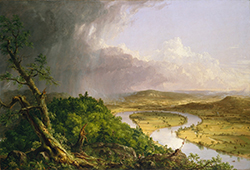 Painting by : View from Mount Holyoke, Northampton, Massachusetts, after a Thunderstorm, commonly known as The Oxbow, is a seminal landscape painting by Thomas Cole, founder of the Hudson River School. The painting depicts a Romantic panorama of the Connecticut River Valley just after a thunderstorm. It has been interpreted as a confrontation between wilderness and civilization.
Painting by : View from Mount Holyoke, Northampton, Massachusetts, after a Thunderstorm, commonly known as The Oxbow, is a seminal landscape painting by Thomas Cole, founder of the Hudson River School. The painting depicts a Romantic panorama of the Connecticut River Valley just after a thunderstorm. It has been interpreted as a confrontation between wilderness and civilization.
1836
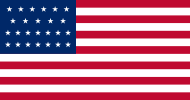 The US flag is modified to have twenty-five stars, reflecting the addition of one new state: Arkansas.
The US flag is modified to have twenty-five stars, reflecting the addition of one new state: Arkansas.
 Davy Crockett killed, as Texans are defeated by the Mexican army at the Alamo.
Davy Crockett killed, as Texans are defeated by the Mexican army at the Alamo.
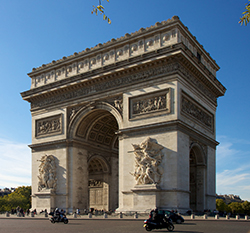 In Paris, the Arc de Triomphe is completed. The arch was ordered built by Napoleon in 1806.
In Paris, the Arc de Triomphe is completed. The arch was ordered built by Napoleon in 1806.
 Texas gains independence from Mexico after winning the battle of San Jacinto.
Texas gains independence from Mexico after winning the battle of San Jacinto.
 Twice-told Tales, by Nathaniel Hawthorne, is published and is an immediate best-seller.
Twice-told Tales, by Nathaniel Hawthorne, is published and is an immediate best-seller.
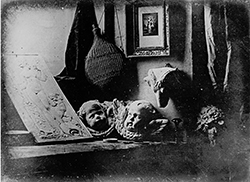 Daguerreotype by Louis Daguerre: Still life with plaster casts is the earliest, reliably dated daguerreotype.
Daguerreotype by Louis Daguerre: Still life with plaster casts is the earliest, reliably dated daguerreotype.
1837
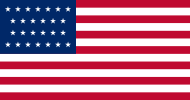 The US flag is modified to have twenty-six stars, reflecting the addition of one new state: Michigan.
The US flag is modified to have twenty-six stars, reflecting the addition of one new state: Michigan.
 Martin Van Buren becomes eighth president of the United States.
Martin Van Buren becomes eighth president of the United States.
 William IV, King of Great Britain, dies.
William IV, King of Great Britain, dies.
 The Seraphim and Other Poems, by Elizabeth Barrett Browning (1806-1861), is published.
The Seraphim and Other Poems, by Elizabeth Barrett Browning (1806-1861), is published.
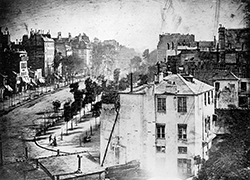 Daguerreotype by Louis Daguerre: The earliest reliably dated photograph of people, taken one spring morning in 1838 from the window of the Diorama, where Daguerre lived and worked. It bears the caption huit heure du matin (8 a.m.). Though it shows the busy Boulevard du Temple, the long exposure time (about ten or twelve minutes) meant that moving traffic cannot be seen; however, the bootblack and his customer at lower left remained still long enough to be distinctly visible. The building signage at the upper left shows that the image is laterally (left-right) reversed, as were most daguerreotypes.
Daguerreotype by Louis Daguerre: The earliest reliably dated photograph of people, taken one spring morning in 1838 from the window of the Diorama, where Daguerre lived and worked. It bears the caption huit heure du matin (8 a.m.). Though it shows the busy Boulevard du Temple, the long exposure time (about ten or twelve minutes) meant that moving traffic cannot be seen; however, the bootblack and his customer at lower left remained still long enough to be distinctly visible. The building signage at the upper left shows that the image is laterally (left-right) reversed, as were most daguerreotypes.
1838
 Coronation of Victoria as queen of Great Britain.
Coronation of Victoria as queen of Great Britain.
 Voices of the Night, the first book of poems by Henry Wadsworth Longfellow (1807-1882), is published.
Voices of the Night, the first book of poems by Henry Wadsworth Longfellow (1807-1882), is published.
1839
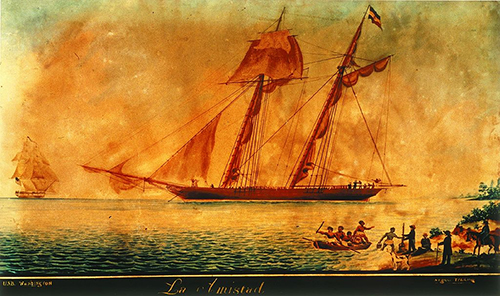 La Amistad was a 19th-century two-masted schooner, owned by a Spaniard living in Cuba. It became renowned in July 1839 for a slave revolt by Mende captives, who had been enslaved in Sierra Leone, and were being transported from Havana, Cuba to their purchasers' plantations. The African captives took control of the ship, killing some of the crew and ordering the survivors to sail the ship to Africa. The Spanish survivors secretly maneuvered the ship north, and La Amistad was captured off the coast of Long Island by the brig USS Washington. The Mende and La Amistad were interned in Connecticut while federal court proceedings were undertaken for their disposition. The owners of the ship and Spanish government claimed the slaves as property; but the US had banned the African trade and argued that the Mende were legally free. Because of issues of ownership and jurisdiction, the case gained international attention. Former president John Quincy Adams argued on behalf of the slaves when the appeal was brought before the U.S. Supreme Court, which eventually determined the Africans to be free men. The case became a symbol in the United States in the movement to abolish slavery.
La Amistad was a 19th-century two-masted schooner, owned by a Spaniard living in Cuba. It became renowned in July 1839 for a slave revolt by Mende captives, who had been enslaved in Sierra Leone, and were being transported from Havana, Cuba to their purchasers' plantations. The African captives took control of the ship, killing some of the crew and ordering the survivors to sail the ship to Africa. The Spanish survivors secretly maneuvered the ship north, and La Amistad was captured off the coast of Long Island by the brig USS Washington. The Mende and La Amistad were interned in Connecticut while federal court proceedings were undertaken for their disposition. The owners of the ship and Spanish government claimed the slaves as property; but the US had banned the African trade and argued that the Mende were legally free. Because of issues of ownership and jurisdiction, the case gained international attention. Former president John Quincy Adams argued on behalf of the slaves when the appeal was brought before the U.S. Supreme Court, which eventually determined the Africans to be free men. The case became a symbol in the United States in the movement to abolish slavery.
Sultan Abdulmecid I implemented the Tanzimat reforms in an attempt to modernize the Ottoman Empire and strengthen it against European powers. The reforms included changes to the legal system, education, and the military, and were influenced by western ideas.

 In response to the British opium trade, Lin Zexu wrote a letter to Queen Victoria, urging her to end the opium trade: We find that your country is sixty or seventy thousand li from China. Yet there are barbarian ships that strive to come here for trade for the purpose of making a great profit. The wealth of China is used to profit the barbarians. That is to say, the great profit made by barbarians is all taken from the rightful share of China. By what right do they then in return use the poisonous drug to injure the Chinese people? Even though the barbarians may not necessarily intend to do us harm, yet in coveting profit to an extreme, they have no regard for injuring others. Let us ask, where is your conscience? The letter to the Queen never reached her. Belatedly, it was delivered and published in The Times of London.
In response to the British opium trade, Lin Zexu wrote a letter to Queen Victoria, urging her to end the opium trade: We find that your country is sixty or seventy thousand li from China. Yet there are barbarian ships that strive to come here for trade for the purpose of making a great profit. The wealth of China is used to profit the barbarians. That is to say, the great profit made by barbarians is all taken from the rightful share of China. By what right do they then in return use the poisonous drug to injure the Chinese people? Even though the barbarians may not necessarily intend to do us harm, yet in coveting profit to an extreme, they have no regard for injuring others. Let us ask, where is your conscience? The letter to the Queen never reached her. Belatedly, it was delivered and published in The Times of London.
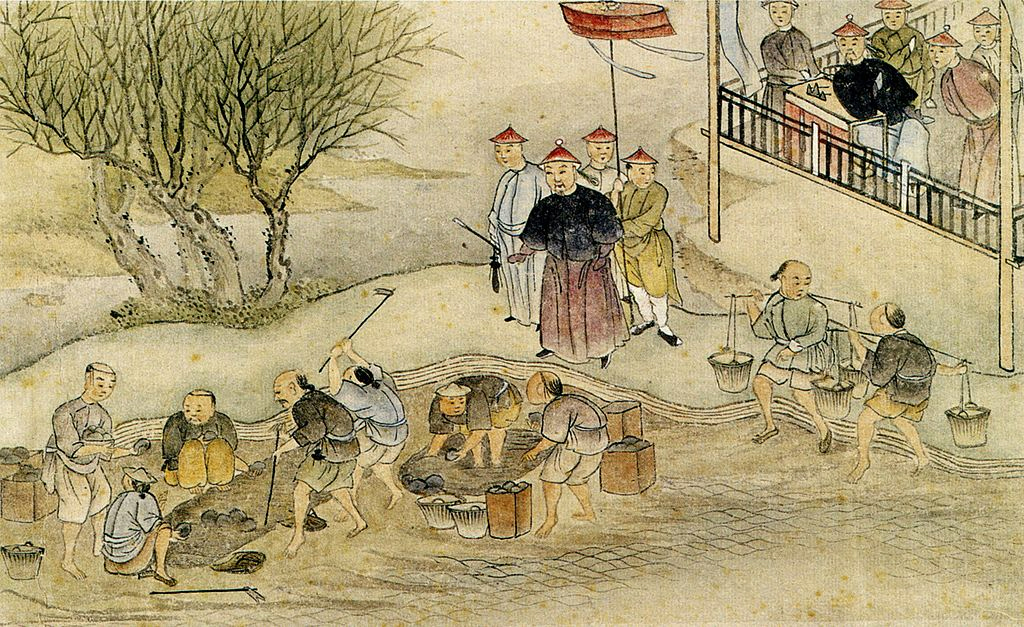 Lin Zexu was a Chinese scholar-official of the Qing dynasty best known for his role in the First Opium War of 1839. In March 1839, Lin arrived in Guangdong Province to take measures that would eliminate the opium trade. He was a formidable bureaucrat known for his competence and high moral standards, with an imperial commission from the Daoguang Emperor to halt the illegal importation of opium by the British. Upon arrival, he made changes within a matter of months. He arrested more than 1,700 Chinese opium dealers and confiscated over 70,000 opium pipes. He initially attempted to get foreign companies to forfeit their opium stores in exchange for tea, but this ultimately failed. Lin resorted to using force in the western merchants' enclave. A month and a half later, the merchants gave up nearly 1.2 million kg (2.6 million pounds) of opium. Beginning 3 June 1839, 500 workers laboured for 23 days to destroy it, mixing the opium with lime and salt and throwing it into the sea outside of Humen Town. Lin composed an elegy apologising to the gods of the sea for polluting their realm.
Lin Zexu was a Chinese scholar-official of the Qing dynasty best known for his role in the First Opium War of 1839. In March 1839, Lin arrived in Guangdong Province to take measures that would eliminate the opium trade. He was a formidable bureaucrat known for his competence and high moral standards, with an imperial commission from the Daoguang Emperor to halt the illegal importation of opium by the British. Upon arrival, he made changes within a matter of months. He arrested more than 1,700 Chinese opium dealers and confiscated over 70,000 opium pipes. He initially attempted to get foreign companies to forfeit their opium stores in exchange for tea, but this ultimately failed. Lin resorted to using force in the western merchants' enclave. A month and a half later, the merchants gave up nearly 1.2 million kg (2.6 million pounds) of opium. Beginning 3 June 1839, 500 workers laboured for 23 days to destroy it, mixing the opium with lime and salt and throwing it into the sea outside of Humen Town. Lin composed an elegy apologising to the gods of the sea for polluting their realm.
The First Opium War between Britain and China occurs between 1839 and 1842, triggered when Chinese officials attempt to prevent the sale of narcotics (opium) to the Chinese people by the British East India trading Company. The British respond by bringing in gunboats and shelling Chinese coastal cities.
 The process of vulcanization, developed by Charles Goodyear, makes possible the commercial use of rubber.
The process of vulcanization, developed by Charles Goodyear, makes possible the commercial use of rubber.
 Anna, the Duchess of Bedford (1788-1861), introduces the ritual of afternoon tea in Britain, although tea has been available in England since the late 1600s.
Anna, the Duchess of Bedford (1788-1861), introduces the ritual of afternoon tea in Britain, although tea has been available in England since the late 1600s.
 The polka makes its U.S. debut, introduced by the ballerina Fanny Elssler (1810-1884), who had brought the dance to Paris in 1834.
The polka makes its U.S. debut, introduced by the ballerina Fanny Elssler (1810-1884), who had brought the dance to Paris in 1834.
 The saxophone is invented in Belgium, by the 26-year old instrument maker Antoine Joseph Sax (1814-1894).
The saxophone is invented in Belgium, by the 26-year old instrument maker Antoine Joseph Sax (1814-1894).
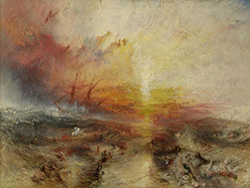 Painting by J. M. W. Turner: The Slave Ship, originally titled Slavers Throwing overboard the Dead and Dying — Typhon coming on, is a painting by the British artist J. M. W. Turner, first exhibited at The Royal Academy of Arts in 1840. In this classic example of a Romantic maritime painting, Turner depicts a ship visible in the background, sailing through a tumultuous sea of churning water and leaving scattered human forms floating in its wake. Turner was possibly moved to paint The Slave Ship after reading about the slave ship Zong in The History and Abolition of the Slave Trade by Thomas Clarkson the second edition of which was published in 1839. The initial exhibition of the painting in 1840 coincided with international abolitionist campaigns.
Painting by J. M. W. Turner: The Slave Ship, originally titled Slavers Throwing overboard the Dead and Dying — Typhon coming on, is a painting by the British artist J. M. W. Turner, first exhibited at The Royal Academy of Arts in 1840. In this classic example of a Romantic maritime painting, Turner depicts a ship visible in the background, sailing through a tumultuous sea of churning water and leaving scattered human forms floating in its wake. Turner was possibly moved to paint The Slave Ship after reading about the slave ship Zong in The History and Abolition of the Slave Trade by Thomas Clarkson the second edition of which was published in 1839. The initial exhibition of the painting in 1840 coincided with international abolitionist campaigns.
1840
(no entry for this year)
The Berlin Zoo opens, when Friedrich Wilhelm IV, the King of Prussia, donates his pheasant gardens and exotic animal colection to the citizens of Berlin.
The New York State Fair is held for the first time, in Syracuse, New York. The Fair is the first in the tradition of U.S. state fairs with agricultural and domestic themes.
 Self-Reliance, by Ralph Waldo Emerson (1803-1882) [essay II in Essays: First Series] is published.
Self-Reliance, by Ralph Waldo Emerson (1803-1882) [essay II in Essays: First Series] is published.
 The first novel in the series called "Leatherstocking Tales", The Deerslayer, by James Fennimore Cooper (1789-1851), is published
The first novel in the series called "Leatherstocking Tales", The Deerslayer, by James Fennimore Cooper (1789-1851), is published
In London, the periodical Punch begins publication.
1841
The U.S.S. Creole, a ship carrying slaves from Virginia to Louisiana, is seized by the slaves on board and taken to Nassau, where they are free.
 John Tyler becomes tenth president of the United States.
John Tyler becomes tenth president of the United States.
 The first centralized government bureau of statistics is founded in Belgium by the mathematician Lambert Adolphe Jacques Quetelet (1781-1840).
The first centralized government bureau of statistics is founded in Belgium by the mathematician Lambert Adolphe Jacques Quetelet (1781-1840).
 In May, Edgar Allan Poe's (1809-1849) story "The Masque of the Red Death" appears in Graham's Magazine.
In May, Edgar Allan Poe's (1809-1849) story "The Masque of the Red Death" appears in Graham's Magazine.
1842
 Frederick Douglass leads a successful campaign against Rhode Island's proposed Dorr Constitution, which would have continued the prohibition on black male voting rights.
Frederick Douglass leads a successful campaign against Rhode Island's proposed Dorr Constitution, which would have continued the prohibition on black male voting rights.
In Prigg v. Pennsylvania, the U.S. Supreme Court upholds the Fugitive Slave Law of 1793, stating that slaveowners have a right to retrievetheir "property." In so doing, the court rules that Pennsylvania's anti-kidnapping law is unconstitutional. At the same time, the Supreme Court declares that enforcement of the Fugitive Slave Lawis a federal responsibility in which states are not compelled to participate. Between 1842 and 1850, nine Northern states pass new personal liberty laws which forbid state officials from cooperating in the return of alleged fugitive slaves and bar the use of state facilities for that purpose.
Slavery is abolished in Uruguay.
The Virginia Legislature votes against abolishing slavery.
In Commonwealth v. Hunt, a case involving the Boston Journeyman Bootmakers Society, the Chief Justice of the Massachusetts Supreme Court ruled that trade unions are legal. The ruling revises the common law that treated such unions as criminal conspiracies.
The Massachusetts State Legislature enacts a child labor law that limits the working hours of children under 12 years-old to 10 hours per day.
P. T. Barnum lures crowds of thousands to see his "Feejee Mermaid."
In London, The Economist and Sunday News of the World begin publication.
 In Dresden, Richard Wagner's opera Der fliegende Holländer is premiered.
In Dresden, Richard Wagner's opera Der fliegende Holländer is premiered.
1843
 Congress grants S. F. B. Morse $30,000 to build the first telegraph line (Washington to Baltimore).
Congress grants S. F. B. Morse $30,000 to build the first telegraph line (Washington to Baltimore).
In England, the Young Men's Christian Association (YMCA) is founded by George Williams (1821-1905).
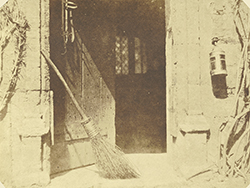 The Open Door is an early calotype, included in The Pencil of Nature, the first commercially published book to be illustrated with photographs.
The Open Door is an early calotype, included in The Pencil of Nature, the first commercially published book to be illustrated with photographs.
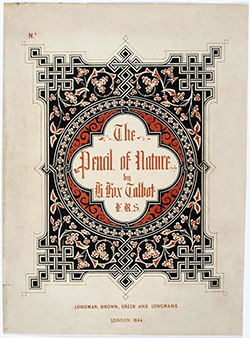 The Pencil of Nature, published in six installments between 1844 and 1846, was the "first photographically illustrated book to be commercially published" or "the first commercially published book illustrated with photographs". It was wholly executed by the new art of Photogenic Drawing, without any aid whatever from the artist's pencil and regarded as an important and influential work in the history of photography. Written by William Henry Fox Talbot and published by Longman, Brown, Green & Longmans in London, the book detailed Talbot's development of the calotype process and included 24 calotype prints, each one pasted in by hand, illustrating some of the possible applications of the new technology. Since photography was still very much a novelty and many people remained unfamiliar with the concept, Talbot felt compelled to insert the following notice into his book: The plates of the present work are impressed by the agency of Light alone, without any aid whatever from the artist's pencil. They are the sun-pictures themselves, and not, as some persons have imagined, engravings in imitation.
The Pencil of Nature, published in six installments between 1844 and 1846, was the "first photographically illustrated book to be commercially published" or "the first commercially published book illustrated with photographs". It was wholly executed by the new art of Photogenic Drawing, without any aid whatever from the artist's pencil and regarded as an important and influential work in the history of photography. Written by William Henry Fox Talbot and published by Longman, Brown, Green & Longmans in London, the book detailed Talbot's development of the calotype process and included 24 calotype prints, each one pasted in by hand, illustrating some of the possible applications of the new technology. Since photography was still very much a novelty and many people remained unfamiliar with the concept, Talbot felt compelled to insert the following notice into his book: The plates of the present work are impressed by the agency of Light alone, without any aid whatever from the artist's pencil. They are the sun-pictures themselves, and not, as some persons have imagined, engravings in imitation.
1844
(no entry for this year)
Scientific American is founded by Alfred Beach (1826-1896). The first issue is published on August 28. The publication, in newspaper format, presents science for the general reader.
 Edgar Allan Poe's "The Raven" appears in the New York Evening Mirror. Poe's collection The Raven and Other Poems is published.
Edgar Allan Poe's "The Raven" appears in the New York Evening Mirror. Poe's collection The Raven and Other Poems is published.
1845
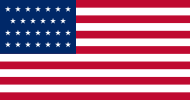 The US flag is modified to have twenty-seven stars, reflecting the addition of one new state: Florida.
The US flag is modified to have twenty-seven stars, reflecting the addition of one new state: Florida.
 Frederick Douglass publishes his autobiography, The Life and Times of Frederick Douglass.
Frederick Douglass publishes his autobiography, The Life and Times of Frederick Douglass.
 James K. Polk becomes eleventh president of the United States.
James K. Polk becomes eleventh president of the United States.
Texas is annexed by the United States.
The Irish potato famine begins, one of the century's worst natural disasters. One million citizens starve to death, and one million others emigrate, mostly to the United States
(no entry for this year)
1846
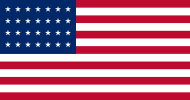 The US flag is modified to have twenty-eight stars, reflecting the addition of one new state: Texas.
The US flag is modified to have twenty-eight stars, reflecting the addition of one new state: Texas.
Mexican-American War Defeated, Mexico yields an enormous amount of territory to the United States. Americans then wrestle with a controversial topic: Is slavery permitted in the new lands?
The first professional baseball game is played, in Hoboken, New Jersey.
The Mexican War (1846-48) between the United States and Mexico results in the United States taking possession of California and much of the Southwest, which had been Mexican territory.
The Oregon Treaty delineates border between the United States and Canada.
(no entry for this year)
1847
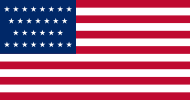 The US flag is modified to have twenty-nine stars, reflecting the addition of one new state: Iowa.
The US flag is modified to have twenty-nine stars, reflecting the addition of one new state: Iowa.
 The North Star, an abolitionist newspaper, begins publication in Rochester, New York. The paper is founded by escaped slave Frederick Douglass (1817-1895), with money he earned as a result of his autobiography.
The North Star, an abolitionist newspaper, begins publication in Rochester, New York. The paper is founded by escaped slave Frederick Douglass (1817-1895), with money he earned as a result of his autobiography.
Liberia is formed as a home for released American slaves.
Missouri bans the education of free blacks.
The Istanbul slave market is abolished.
The Factory Act is passed in Britain. It forbids women and children between the ages of 13 and 18 to work more than 10 hours per day.
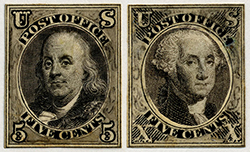 The first United States postage stamps are issued
The first United States postage stamps are issued
 Painting by Jean Auguste Dominique Ingres: Venus Anadyomene, now held at the Musée Condé, Chantilly, France. It is a female nude of the Venus Anadyomene type, showing the goddess Venus rising from the sea. Ingres began the painting in 1808 during his stay in Rome at the French Academy. The first preparatory drawings showed Venus in the Venus Pudica position, standing and covering her breasts with her hands. The pose was inspired by Botticelli's The Birth of Venus — Ingres visited Florence and the Uffizi in 1805 and could have seen the painting there. A drawing of 1806 then shows the goddess with her arms in the air and her hair in her hands, a pose the artist also used in his 1856 The Source. The painting remained in the planning stages until 1848, when he completed it as a commission from the banker and botanist Benjamin Delessert.
Painting by Jean Auguste Dominique Ingres: Venus Anadyomene, now held at the Musée Condé, Chantilly, France. It is a female nude of the Venus Anadyomene type, showing the goddess Venus rising from the sea. Ingres began the painting in 1808 during his stay in Rome at the French Academy. The first preparatory drawings showed Venus in the Venus Pudica position, standing and covering her breasts with her hands. The pose was inspired by Botticelli's The Birth of Venus — Ingres visited Florence and the Uffizi in 1805 and could have seen the painting there. A drawing of 1806 then shows the goddess with her arms in the air and her hair in her hands, a pose the artist also used in his 1856 The Source. The painting remained in the planning stages until 1848, when he completed it as a commission from the banker and botanist Benjamin Delessert.
1848
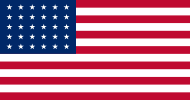 The US flag is modified to have thirty stars, reflecting the addition of one new state: Wisconsin.
The US flag is modified to have thirty stars, reflecting the addition of one new state: Wisconsin.
Slavery is abolished in old French and Danish colonies.
 Karl Marx publishes The Communist Manifesto, which asserts that revolution by the working classes will ultimately destroy capitalism.
Karl Marx publishes The Communist Manifesto, which asserts that revolution by the working classes will ultimately destroy capitalism.
Revolution breaks out across much of Europe; the Second Republic is proclaimed in France.
 Henry David Thoreau's A week on the Concord and Merrimack Rivers and "Resistance to Civil Government" (often referred to as "Civil Disobedience") are published.
Henry David Thoreau's A week on the Concord and Merrimack Rivers and "Resistance to Civil Government" (often referred to as "Civil Disobedience") are published.
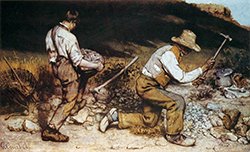 Painting by Gustave Courbet: The Stone Breakers (French: Les Casseurs de pierres) is a work of social realism, depicting two peasants, a young man and an old man, breaking rocks. The painting was first exhibited at the Paris Salon of 1850. It was destroyed during World War II, along with 154 other pictures, when a transport vehicle moving the pictures to the castle of Königstein, near Dresden, was bombed by Allied forces in February 1945.
Painting by Gustave Courbet: The Stone Breakers (French: Les Casseurs de pierres) is a work of social realism, depicting two peasants, a young man and an old man, breaking rocks. The painting was first exhibited at the Paris Salon of 1850. It was destroyed during World War II, along with 154 other pictures, when a transport vehicle moving the pictures to the castle of Königstein, near Dresden, was bombed by Allied forces in February 1945.
1849
 Charles Lewis Reason becomes the first African-American college instructor when he is hired at predominantly white Free Mission College (later New York Central College) to teach Greek, Latin, French, and mathematics.
Charles Lewis Reason becomes the first African-American college instructor when he is hired at predominantly white Free Mission College (later New York Central College) to teach Greek, Latin, French, and mathematics.
 Harriet Tubman escapes from slavery and goes on to lead more than 300 slaves to freedom on the underground railroad.
Harriet Tubman escapes from slavery and goes on to lead more than 300 slaves to freedom on the underground railroad.
 Zachary Taylor becomes twelfth president of the United States.
Zachary Taylor becomes twelfth president of the United States.
The California gold rush begins as more than 100,000 people swarm to California to make their fortunes after gold is found there in 1848.
Showmen Moses Kimball and P. T. Barnum purchase the contents of the Peale Museum (established in 1784).
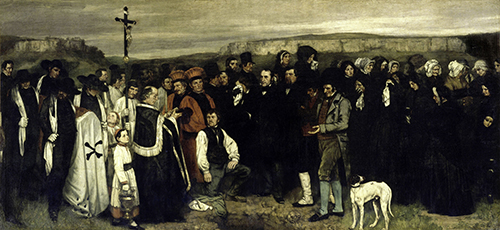 Painting by Gustave Courbet: A Burial At Ornans (French: Un enterrement à Ornans, also known as A Funeral At Ornans) represents one of the major turning points of 19th-century French art. The painting records the funeral in September 1848 of his great-uncle in the painter's birthplace, the small town of Ornans. It treats an ordinary provincial funeral with unflattering realism, and on the giant scale traditionally reserved for the heroic or religious scenes of history painting. Its exhibition at the 1850–51 Paris Salon created an "explosive reaction" and brought Courbet instant fame. It is currently displayed at the Musée d'Orsay in Paris, France.
Painting by Gustave Courbet: A Burial At Ornans (French: Un enterrement à Ornans, also known as A Funeral At Ornans) represents one of the major turning points of 19th-century French art. The painting records the funeral in September 1848 of his great-uncle in the painter's birthplace, the small town of Ornans. It treats an ordinary provincial funeral with unflattering realism, and on the giant scale traditionally reserved for the heroic or religious scenes of history painting. Its exhibition at the 1850–51 Paris Salon created an "explosive reaction" and brought Courbet instant fame. It is currently displayed at the Musée d'Orsay in Paris, France.
1850
The Compromise of 1850 is introduced into Congress by Henry Clay as an omnibus bill designed to settle disputes arising from the conclusion of the Mexican War. It passes after Stephen Douglas divides the bill into several parts: California enters the Union as a free state; the slave trade (but not slavery) is abolished in Washington D.C.; the fugitive slave law is strengthened; and the Utah and New Mexico Territories are opened to slavery on the basis of popular sovereignty (allowing territorial voters to decide the issue without federa linterference).
 The New York Times begins daily publication. The editor of the Times is Henry J. Raymond.
The New York Times begins daily publication. The editor of the Times is Henry J. Raymond.
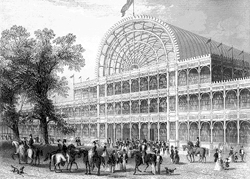 The Great Exhibition opens in London, housed at the Hyde Park Pavilion (the "Crystal Palace" designed by Joseph Paxton), on the First of May. It is the first world's fair, and is attended by more than 6 million people. London is the world's largest city, with a population of nearly 2.4 million people.
The Great Exhibition opens in London, housed at the Hyde Park Pavilion (the "Crystal Palace" designed by Joseph Paxton), on the First of May. It is the first world's fair, and is attended by more than 6 million people. London is the world's largest city, with a population of nearly 2.4 million people.
 Nathaniel Hawthorne's The House of the Seven Gables and The Snow Image and Other Twice-Told Tales both appear.
Nathaniel Hawthorne's The House of the Seven Gables and The Snow Image and Other Twice-Told Tales both appear.
 Moby Dick, by Herman Melville, is published.
Moby Dick, by Herman Melville, is published.
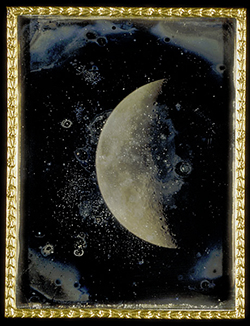 Daguerreotype by John Adams Whipple: Daguerreoype of the moon. Whipple was an American inventor and early photographer. He was the first in the United States to manufacture the chemicals used for daguerreotypes; he pioneered astronomical and night photography; he was a prize-winner for his extraordinary early photographs of the moon; and he was the first to produce images of stars other than the sun — the star Vega and the Mizar-Alcor stellar sextuple system, which was thought to be a double star until 2009.
Daguerreotype by John Adams Whipple: Daguerreoype of the moon. Whipple was an American inventor and early photographer. He was the first in the United States to manufacture the chemicals used for daguerreotypes; he pioneered astronomical and night photography; he was a prize-winner for his extraordinary early photographs of the moon; and he was the first to produce images of stars other than the sun — the star Vega and the Mizar-Alcor stellar sextuple system, which was thought to be a double star until 2009.
1851
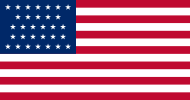 The US flag is modified to have thirty-one stars, reflecting the addition of one new state: California.
The US flag is modified to have thirty-one stars, reflecting the addition of one new state: California.
 Harriet Beecher Stowe publishes her anti-slavery novel, Uncle Tom's Cabin.
Harriet Beecher Stowe publishes her anti-slavery novel, Uncle Tom's Cabin.
 Peter Mark Roget publishes his Thesaurus of English Words and Phrases. Roget, a 73 year-old physician and English scholar, will publish 28 editions of the Thesaurus during his lifetime (he dies at age 90).
Peter Mark Roget publishes his Thesaurus of English Words and Phrases. Roget, a 73 year-old physician and English scholar, will publish 28 editions of the Thesaurus during his lifetime (he dies at age 90).
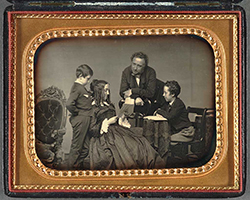 Daguerreotype by John Adams Whipple: Henry Winthrop Sargent and His Family. Whipple kept several distinctive pieces of furniture in his studio that he used to solidify his compositions by disposing them within an image in characteristic ways without having the sitter use them. In fact, it is this unique posing style that identifies Whipple as the artist of the portrait of Henry Winthrop Sargent and his family, taken in Boston in the early 1850s. Here, Whipple's composition is complex and masterful. The empty armchair at the lower left faces the viewer and draws the eye in. The covered table at the far right connects an occupied chair to the edge of the plate and suggests a vanishing point while giving diagonal movement to what is basically a horizontal composition. The corner of a plain backdrop, barely perceptible at the right, aids the illusion of movement and space. The empty armchair acts as a backrest for young Francis Sargent, who is actually supported by a posing stand, the base of which can be seen between his feet and his mother's skirts. Caroline Olmsted Sargent appears to be reading a letter to her assembled family. Her oldest son, Winthrop Henry Sargent, sits facing her, and their profiles echo across the space as he leans toward her. Henry Winthrop Sargent, at the apex of the composition, leans dynamically into the gathering, supporting his weight on the back of a carved side chair. The division of the family into two pairs of linked figures creates powerful parallel diagonals; but despite this calculated arrangement, all of the sitters appear to be at ease and engaged with one another.
Daguerreotype by John Adams Whipple: Henry Winthrop Sargent and His Family. Whipple kept several distinctive pieces of furniture in his studio that he used to solidify his compositions by disposing them within an image in characteristic ways without having the sitter use them. In fact, it is this unique posing style that identifies Whipple as the artist of the portrait of Henry Winthrop Sargent and his family, taken in Boston in the early 1850s. Here, Whipple's composition is complex and masterful. The empty armchair at the lower left faces the viewer and draws the eye in. The covered table at the far right connects an occupied chair to the edge of the plate and suggests a vanishing point while giving diagonal movement to what is basically a horizontal composition. The corner of a plain backdrop, barely perceptible at the right, aids the illusion of movement and space. The empty armchair acts as a backrest for young Francis Sargent, who is actually supported by a posing stand, the base of which can be seen between his feet and his mother's skirts. Caroline Olmsted Sargent appears to be reading a letter to her assembled family. Her oldest son, Winthrop Henry Sargent, sits facing her, and their profiles echo across the space as he leans toward her. Henry Winthrop Sargent, at the apex of the composition, leans dynamically into the gathering, supporting his weight on the back of a carved side chair. The division of the family into two pairs of linked figures creates powerful parallel diagonals; but despite this calculated arrangement, all of the sitters appear to be at ease and engaged with one another.
1852
 The French Republic falls; Louis Napoleon (Napoleon III) is crowned Emperor.
The French Republic falls; Louis Napoleon (Napoleon III) is crowned Emperor.
The U.S. state of Massachusetts adopts a compulsory school-attendance law, the first effective example of such a law in the nation.
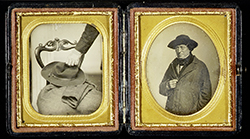 Daguerreotype by John Adams Whipple: Cornelius Conway Felton with His Hat and Coat. Felton was Eliot Professor of Greek Literature at Harvard University, reaching for his felt hat and duster. The first son of a poverty-stricken furniture maker, Felton became one of the most renowned classical scholars in the country and, in 1860, Harvard's president. This witty photograph lampoons the rigid formality of the portrait process through narrative gesture (the implied reach across two separate images) and nuance (the delicate crush of the soft hat's crown). As opposed to the inflexible silk top hat worn by dandies and professors alike, the broad-brimmed felt hat was worn by outdoorsmen and was practical, casual, and fundamentally democratic.
Daguerreotype by John Adams Whipple: Cornelius Conway Felton with His Hat and Coat. Felton was Eliot Professor of Greek Literature at Harvard University, reaching for his felt hat and duster. The first son of a poverty-stricken furniture maker, Felton became one of the most renowned classical scholars in the country and, in 1860, Harvard's president. This witty photograph lampoons the rigid formality of the portrait process through narrative gesture (the implied reach across two separate images) and nuance (the delicate crush of the soft hat's crown). As opposed to the inflexible silk top hat worn by dandies and professors alike, the broad-brimmed felt hat was worn by outdoorsmen and was practical, casual, and fundamentally democratic.
1853
 Commodore Matthew Perry sails into Japan's Edo Bay with his black ships (four modern, steam-powered warships), urging Japan to open trade policies with the United States.
Commodore Matthew Perry sails into Japan's Edo Bay with his black ships (four modern, steam-powered warships), urging Japan to open trade policies with the United States.
 Franklin Pierce becomes fourteenth president of the United States.
Franklin Pierce becomes fourteenth president of the United States.
 Henry David Thoreau's Walden, or Life in the Woods is published.
Henry David Thoreau's Walden, or Life in the Woods is published.
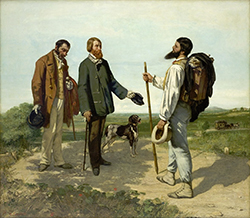 Painting by Gustave Courbet: The Meeting (French: La rencontre) is traditionally interpreted as Courbet greeted by his patron Alfred Bruyas, his servant Calas, and his dog while traveling to Montpellier. The composition is based on the Wandering Jew. The Meeting was exhibited in Paris at the 1855 Exhibition Universelle, where critics ridiculed it as "Bonjour, Monsieur Courbet". Bruyas did not exhibit The Meeting until he donated it to the Musée Fabre in Montpellier in 1868.
Painting by Gustave Courbet: The Meeting (French: La rencontre) is traditionally interpreted as Courbet greeted by his patron Alfred Bruyas, his servant Calas, and his dog while traveling to Montpellier. The composition is based on the Wandering Jew. The Meeting was exhibited in Paris at the 1855 Exhibition Universelle, where critics ridiculed it as "Bonjour, Monsieur Courbet". Bruyas did not exhibit The Meeting until he donated it to the Musée Fabre in Montpellier in 1868.
1854
Kansas-Nebraska Act: In an attempt to spur population growth in the western territories in advance of a transcontinental railroad, Stephen Douglas introduces a bill to establish the territories of Kansas and Nebraska. In order to gain Southern support, the bill stipulates that slavery in the territories will be decided by popular sovereignty. Thus the Kansas-Nebraska Act repeals the Missouri Compromise ban on slavery north of 36 30' in the lands of the Louisiana Purchase.
Ostend Manifesto: The U.S. ministers to Britain, France, and Spain meet in Ostend, Belgium. They draft a policy recommendation to President Pierce, urging him to attempt again to purchase Cuba from Spain and, if Spain refuses, to take the island by force. When the secret proposal, called the Ostend Manifesto, is leaked to the press, it creates an uproar since Cuba would likely become another slave state.
 On May 24, Virginia fugitive slave Anthony Burns is captured in Boston and returned to slavery under the provisions of the Fugitive Slave Act. Fifty thousand Boston residents watch his transport through the streets of the city in shackles. A Boston church raises $1500 to purchase his freedom and Burns returns to the city in 1855, a free man.
On May 24, Virginia fugitive slave Anthony Burns is captured in Boston and returned to slavery under the provisions of the Fugitive Slave Act. Fifty thousand Boston residents watch his transport through the streets of the city in shackles. A Boston church raises $1500 to purchase his freedom and Burns returns to the city in 1855, a free man.
On May 30, the Kansas-Nebraska act is passed by Congress. The act repeals the Missouri Compromise and permits the admission of Kansas and Nebraska territories to the Union after their white male voters decide the fate of slavery in those territories.
Slavery is abolished in Peru and Venezuela.
The Republican Party is formed in the summer in opposition to the extension of slavery into the western territories.
 In Watertown, Wisconsin, the first kindergarten in the U.S. is opened by Mrs. Carl Schurz (Margarethe Meyer Schurz).
In Watertown, Wisconsin, the first kindergarten in the U.S. is opened by Mrs. Carl Schurz (Margarethe Meyer Schurz).
 Henry Wadsworth Longfellow's "Song of Hiawatha" appears.
Henry Wadsworth Longfellow's "Song of Hiawatha" appears.
 Poet Walt Whitman publishes a volume of twelve poems, Leaves of Grass, at his own expense, and meets with no commercial success.
Poet Walt Whitman publishes a volume of twelve poems, Leaves of Grass, at his own expense, and meets with no commercial success.
1855
The Massachusetts Legislature outlaws racially segregated schools.
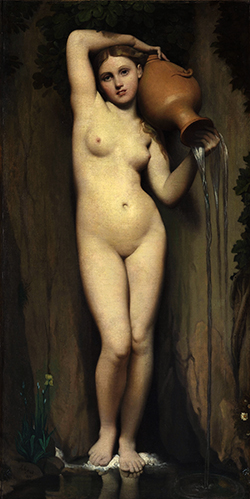 Painting by Jean Auguste Dominique Ingres: The Source (French: La Source), was begun in Florence around 1820 and not completed until 1856, in Paris. When Ingres completed The Source, he was seventy-six years old, already famous, and president of the cole des Beaux-Arts. The pose of the nude may be compared with that of another by Ingres, the Venus Anadyomene (1848), and is a reimagination of the Aphrodite of Cnidus or Venus Pudica. Two of Ingres' students, painters Paul Balze and Alexandre Desgoffe, helped to create the background and water jar. The first exhibition of The Source was in 1856, the year it was completed. The painting was received enthusiastically. Duch tel acquired the painting in 1857 for a sum of 25,000 francs. The state assumed title to the painting in 1878 and it passed to the Mus e du Louvre. In 1986 it was transferred to the Mus e d'Orsay. The painting has been frequently exhibited and widely published. Haldane Macfall in A History of Painting: The French Genius describes The Source as Ingres' "superb nude by which he is chiefly known". Kenneth Clark in his book Feminine Beauty observed how The Source has been described as "the most beautiful figure in French painting."
Painting by Jean Auguste Dominique Ingres: The Source (French: La Source), was begun in Florence around 1820 and not completed until 1856, in Paris. When Ingres completed The Source, he was seventy-six years old, already famous, and president of the cole des Beaux-Arts. The pose of the nude may be compared with that of another by Ingres, the Venus Anadyomene (1848), and is a reimagination of the Aphrodite of Cnidus or Venus Pudica. Two of Ingres' students, painters Paul Balze and Alexandre Desgoffe, helped to create the background and water jar. The first exhibition of The Source was in 1856, the year it was completed. The painting was received enthusiastically. Duch tel acquired the painting in 1857 for a sum of 25,000 francs. The state assumed title to the painting in 1878 and it passed to the Mus e du Louvre. In 1986 it was transferred to the Mus e d'Orsay. The painting has been frequently exhibited and widely published. Haldane Macfall in A History of Painting: The French Genius describes The Source as Ingres' "superb nude by which he is chiefly known". Kenneth Clark in his book Feminine Beauty observed how The Source has been described as "the most beautiful figure in French painting."
1856
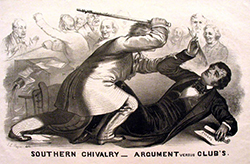 The Caning of Charles Sumner: Senator Charles Sumner delivers a stinging speech in the U.S. Senate, "The Crime against Kansas," in which he attacks slavery, the South, and singles out his Senate colleague, Andrew Butler of South Carolina, for criticism. In retaliation, Butler's nephew, Congressman Preston Brooks of South Carolina, attacks Sumner with a cane while the Massachusetts senator is seated at his desk on the floor of the Senate. The injuries he sustains cause Sumner to be absent from the Senate for four years. The episode revealed the polarization in America, as Sumner became a martyr in the North and Brooks a hero in the South. Northerners were outraged. Southerners sent Brooks hundreds of new canes in endorsement of his assault. One was inscribed "Hit him again." Brooks claimed that he had not intended to kill Sumner, or else he would have used a different weapon. In a speech to the House defending his actions, Brooks stated that he "meant no disrespect to the Senate of the United States" or the House by his attack on Sumner. He was tried in a District of Columbia court, convicted for assault, and fined $300 ($8,000 in today's dollars), but received no prison sentence.
The Caning of Charles Sumner: Senator Charles Sumner delivers a stinging speech in the U.S. Senate, "The Crime against Kansas," in which he attacks slavery, the South, and singles out his Senate colleague, Andrew Butler of South Carolina, for criticism. In retaliation, Butler's nephew, Congressman Preston Brooks of South Carolina, attacks Sumner with a cane while the Massachusetts senator is seated at his desk on the floor of the Senate. The injuries he sustains cause Sumner to be absent from the Senate for four years. The episode revealed the polarization in America, as Sumner became a martyr in the North and Brooks a hero in the South. Northerners were outraged. Southerners sent Brooks hundreds of new canes in endorsement of his assault. One was inscribed "Hit him again." Brooks claimed that he had not intended to kill Sumner, or else he would have used a different weapon. In a speech to the House defending his actions, Brooks stated that he "meant no disrespect to the Senate of the United States" or the House by his attack on Sumner. He was tried in a District of Columbia court, convicted for assault, and fined $300 ($8,000 in today's dollars), but received no prison sentence.
In South Africa, Boers establish the South African Republic (Transvaal), with Pretoria as its capital. Marthinus Wessels Pretorius, 37, is named the first president.
The Second Opium War (1856-1860) between Britain and China leads to further erosion of Chinese sovereignty.
 Madame Bovery, by Gustave Flaubert, is published
Madame Bovery, by Gustave Flaubert, is published
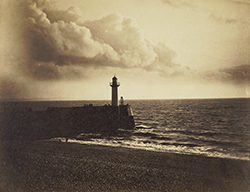 Photograph by Gustave Le Gray: Lighthouse and Jetty, le Havre, an albumen print.
Photograph by Gustave Le Gray: Lighthouse and Jetty, le Havre, an albumen print.
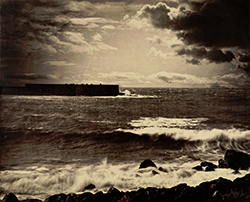 Photograph by Gustave Le Gray: The Great Wave. The dramatic effects of sunlight, clouds, and water in Le Gray's seascapes stunned his contemporaries and immediately brought him international recognition. At a time when photographic emulsions were not equally sensitive to all colors of the spectrum, most photographers found it impossible to achieve proper exposure of both landscape and sky in a single picture. Le Gray solved this problem by printing two negatives on a single sheet of paper: one exposed for the sea, the other for the sky, and sometimes made on separate occasions or in different locations. Le Gray's marine pictures caused a sensation not only because their simultaneous depiction of sea and heavens represented a technical tour de force, but also because the resulting poetic effect was without precedent in photography.
Photograph by Gustave Le Gray: The Great Wave. The dramatic effects of sunlight, clouds, and water in Le Gray's seascapes stunned his contemporaries and immediately brought him international recognition. At a time when photographic emulsions were not equally sensitive to all colors of the spectrum, most photographers found it impossible to achieve proper exposure of both landscape and sky in a single picture. Le Gray solved this problem by printing two negatives on a single sheet of paper: one exposed for the sea, the other for the sky, and sometimes made on separate occasions or in different locations. Le Gray's marine pictures caused a sensation not only because their simultaneous depiction of sea and heavens represented a technical tour de force, but also because the resulting poetic effect was without precedent in photography.
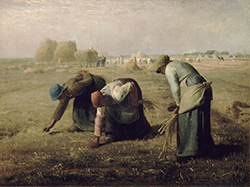 Painting by Jean-François Millet: The Gleaners (Des glaneuses) depicts three peasant women gleaning a field of stray grains of wheat after the harvest. The painting is famous for featuring in a sympathetic way what were then the lowest ranks of rural society; this was received poorly by the French upper classes. The painting immediately drew negative criticism from the middle and upper classes, who viewed the topic with suspicion: one art critic, speaking for other Parisians, perceived in it an alarming intimation of "the scaffolds of 1793." Its size (33×44 inches) was also considered offensive, as it was too large for an image depicting mere labor.
Painting by Jean-François Millet: The Gleaners (Des glaneuses) depicts three peasant women gleaning a field of stray grains of wheat after the harvest. The painting is famous for featuring in a sympathetic way what were then the lowest ranks of rural society; this was received poorly by the French upper classes. The painting immediately drew negative criticism from the middle and upper classes, who viewed the topic with suspicion: one art critic, speaking for other Parisians, perceived in it an alarming intimation of "the scaffolds of 1793." Its size (33×44 inches) was also considered offensive, as it was too large for an image depicting mere labor.
1857
 Farmer Hinton Rowan Helper publishes The Impending Crisis of the South, and How to Meet It, in which he argues that slavery in economically unwise, and particularly devastating to small farmers who do not own slaves. He writes that slavery is "the root of all the shame, poverty, ignorance, tyranny and imbecility" in the South. He also argues that slavery foolishly ties up economic resources in human beings when it might be spent on labor-saving improvements.
Farmer Hinton Rowan Helper publishes The Impending Crisis of the South, and How to Meet It, in which he argues that slavery in economically unwise, and particularly devastating to small farmers who do not own slaves. He writes that slavery is "the root of all the shame, poverty, ignorance, tyranny and imbecility" in the South. He also argues that slavery foolishly ties up economic resources in human beings when it might be spent on labor-saving improvements.
The African slave trade is prohibited in the Ottoman Empire
 The Dred Scott Decision makes the Missouri Compromise unconstitutional and increases tension between North and South over slavery in the United States. Writing for the majority, Chief Justice Roger B. Taney asserted that blacks were "beings of an inferior order, and altogether unfit to associate with the white race, either in social or political relations, and so far inferior that they had no rights which the white man was bound to respect." This embarrassing decision represents a low point in the history of the United States Supreme Court.
The Dred Scott Decision makes the Missouri Compromise unconstitutional and increases tension between North and South over slavery in the United States. Writing for the majority, Chief Justice Roger B. Taney asserted that blacks were "beings of an inferior order, and altogether unfit to associate with the white race, either in social or political relations, and so far inferior that they had no rights which the white man was bound to respect." This embarrassing decision represents a low point in the history of the United States Supreme Court.
 James Buchanan becomes fifteenth president of the United States.
James Buchanan becomes fifteenth president of the United States.
 Giuseppe Garibaldi, who returned to Italy in 1854 after several years working at Staten Island, New York, founds the Italian National Association. The organization is designed to promote the unification of Italy.
Giuseppe Garibaldi, who returned to Italy in 1854 after several years working at Staten Island, New York, founds the Italian National Association. The organization is designed to promote the unification of Italy.
Central Park, in New York City, is opened to the public.
1858
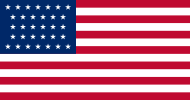 The US flag is modified to have thirty-two stars, reflecting the addition of one new state: Minnesota.
The US flag is modified to have thirty-two stars, reflecting the addition of one new state: Minnesota.
 Abraham Lincoln, running for the United States Senate, declares "A house divided against itself cannot stand." He loses the race to Stephen Douglas, but his performance in there now-legendary debates leads to his nomination as the Republican candidate for president in 1860.
Abraham Lincoln, running for the United States Senate, declares "A house divided against itself cannot stand." He loses the race to Stephen Douglas, but his performance in there now-legendary debates leads to his nomination as the Republican candidate for president in 1860.
In Ireland, the group Sein Féin is founded.
In Manchester, England, the first "playgrounds" for children are opened, complete with swings and horizontal bars for climbing and hanging.
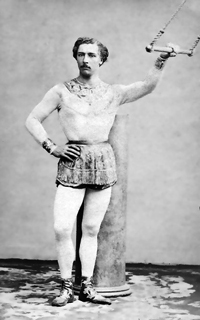 Jules Léotard performs the first flying trapeze circus act, with the Cirque Napoléon in Paris. Léotard's standard performance costume — a skin-tight one-piece garment that covers the torso but leaves the legs free — later becomes known generically as a "leotard." Léotard also becomes the subject of a popular song: "The Daring Young Man on the Flying Trapeze."
Jules Léotard performs the first flying trapeze circus act, with the Cirque Napoléon in Paris. Léotard's standard performance costume — a skin-tight one-piece garment that covers the torso but leaves the legs free — later becomes known generically as a "leotard." Léotard also becomes the subject of a popular song: "The Daring Young Man on the Flying Trapeze."
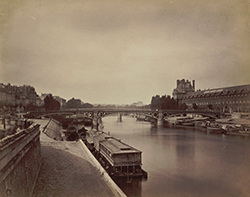 Photograph by Gustave Le Gray: The Pont du Carrousel Seen from the Pont Royal, an albumen print.
Photograph by Gustave Le Gray: The Pont du Carrousel Seen from the Pont Royal, an albumen print.
1859
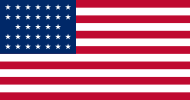 The US flag is modified to have thirty-three stars, reflecting the addition of one new state: Oregon.
The US flag is modified to have thirty-three stars, reflecting the addition of one new state: Oregon.
Harriet Wilson of Milford, New Hampshire, publishes Our Nig; or Sketches from the Life of a Free Black, the first novel by an African-American woman.
 On October 16, John Brown leads 20 men, including five African-Americans, in an unsuccessful attempt to seize the Federal Armory at Harper's ferry, Virginia, with the goal of inspiring a slave insurrection. He was captured by US troops under the command of Colonel Robert E. Lee, tried, and hanged on December 2.
On October 16, John Brown leads 20 men, including five African-Americans, in an unsuccessful attempt to seize the Federal Armory at Harper's ferry, Virginia, with the goal of inspiring a slave insurrection. He was captured by US troops under the command of Colonel Robert E. Lee, tried, and hanged on December 2.
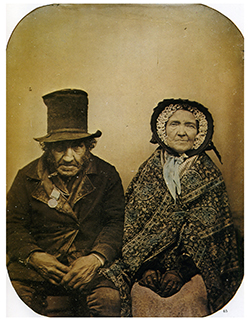 "A Veteran with his Wife", taken by an anonymous photographer, shows a British veteran of the Napoleonic era Peninsular Wars. It is a hand-tinted ambrotype using the set collodion positive process, made circa 1860.
"A Veteran with his Wife", taken by an anonymous photographer, shows a British veteran of the Napoleonic era Peninsular Wars. It is a hand-tinted ambrotype using the set collodion positive process, made circa 1860.
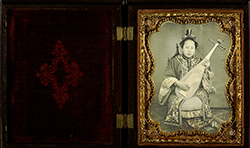 Daguerreotype by Unknown Photographer: Portrait of a Woman with a Mandolin. Collection of the J. Paul Getty Museum.
Daguerreotype by Unknown Photographer: Portrait of a Woman with a Mandolin. Collection of the J. Paul Getty Museum.
1860
On December 20, South Carolina secedes from the union, setting in motion the forces leading to the US Civil war.
Southern Secession South Carolina secedes in December. More states follow the next year.
The Pony Express begins cross-country mail delivery.
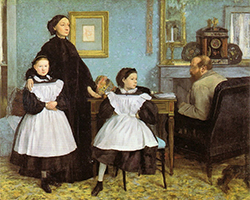 Painting by Edgar Degas: The Bellelli Family, also known as Family Portrait, is housed in the Musée d'Orsay. A masterwork of Degas' youth, the painting is a portrait of his aunt, her husband, and their two young daughters. While finishing his artistic training in Italy, Degas drew and painted his aunt Laura, her husband the baron Gennaro Bellelli, and their daughters Giulia and Giovanna. Although it is not known for certain when or where Degas executed the painting, it is believed that he utilized studies done in Italy to complete the work after his return to Paris. Laura, his father's sister, is depicted in a dress which symbolizes mourning for her father, who had recently died and appears in the framed portrait behind her. Laura Bellelli's countenance is dignified and austere, her gesture connected with those of her daughters. Her husband, by contrast, appears to be separated from his family. His association with business and the outside world is implied by his position at his desk. Giulia holds a livelier pose than that of her sister Giovanna, whose restraint appears to underscore the familial tensions.
Painting by Edgar Degas: The Bellelli Family, also known as Family Portrait, is housed in the Musée d'Orsay. A masterwork of Degas' youth, the painting is a portrait of his aunt, her husband, and their two young daughters. While finishing his artistic training in Italy, Degas drew and painted his aunt Laura, her husband the baron Gennaro Bellelli, and their daughters Giulia and Giovanna. Although it is not known for certain when or where Degas executed the painting, it is believed that he utilized studies done in Italy to complete the work after his return to Paris. Laura, his father's sister, is depicted in a dress which symbolizes mourning for her father, who had recently died and appears in the framed portrait behind her. Laura Bellelli's countenance is dignified and austere, her gesture connected with those of her daughters. Her husband, by contrast, appears to be separated from his family. His association with business and the outside world is implied by his position at his desk. Giulia holds a livelier pose than that of her sister Giovanna, whose restraint appears to underscore the familial tensions.
1861
 Abraham Lincoln becomes sixteenth president of the United States.
Abraham Lincoln becomes sixteenth president of the United States.
Fort Sumter shelled, American Civil War begins.
The First Battle of Bull Run, also known as the First Battle of Manassas (the name used by Confederate forces and still often used in the Southern United States), is fought on July 21, 1861, near Manassas, Virginia. It is the first major land battle of the American Civil War. Neither Confederate nor Union troops were ready for battle. Union troops advanced on Confederate troops, almost breaking through, but at the last moment, Confederate reinforcements arrived on the battlefield and carried the day. Union troops were routed. Union civilian spectators, who had come to watch the expected Confederate defeat as entertainment, were forced to run for their lives.
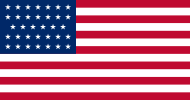 The US flag is modified to have thirty-four stars, reflecting the addition of one new state: Kansas.
The US flag is modified to have thirty-four stars, reflecting the addition of one new state: Kansas.
United States Civil War Four years of brutal conflict claim 623,000 lives.
Congress passes the First Confiscation Act, which prevents Confederate slave owners from re-enslaving runaways.
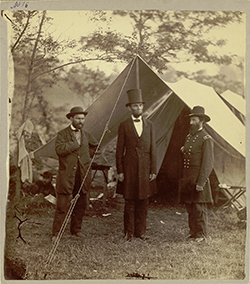 Photograph by Alexander Gardner: President Abraham Lincoln, Headquarters, Army of the Potomac, near Antietam, an albumen silver print. Allan Pinkerton stands to Lincoln's right, General John A. McClernand to Lincoln's left.
Photograph by Alexander Gardner: President Abraham Lincoln, Headquarters, Army of the Potomac, near Antietam, an albumen silver print. Allan Pinkerton stands to Lincoln's right, General John A. McClernand to Lincoln's left.
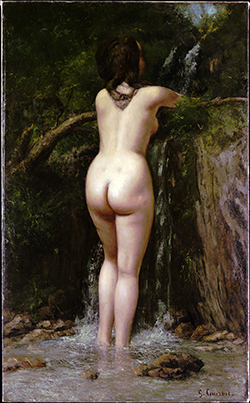 Painting by Gustave Courbet: The Source shows a nude in an unflinchingly naturalistic style and is devoid of the trappings of academic allegory to which the painting's title alludes. Courbet is thought to have intended it as a response to Ingres's own La Source (1856, Musée d Orsay, Paris), which was exhibited at the Galerie Martinet, Paris, in 1861. The picture by Ingres depicts an idealized nude holding a jar from which water pours, an allusion to a spring or river source, and symbolizing poetic inspiration.
Painting by Gustave Courbet: The Source shows a nude in an unflinchingly naturalistic style and is devoid of the trappings of academic allegory to which the painting's title alludes. Courbet is thought to have intended it as a response to Ingres's own La Source (1856, Musée d Orsay, Paris), which was exhibited at the Galerie Martinet, Paris, in 1861. The picture by Ingres depicts an idealized nude holding a jar from which water pours, an allusion to a spring or river source, and symbolizing poetic inspiration.
1862
On April 16, Congress abolishes slavery in the District of Columbia.
 Otto von Bismarck is appointed Prime Minister of Prussia.
Otto von Bismarck is appointed Prime Minister of Prussia.
 The Battle of Fort Donelson (11-16 Feb) is an early Union victory in the American Civil War, which opened the Cumberland River as an avenue for the invasion of the South. The success elevated Brig. Gen. Ulysses S. Grant from an obscure and largely unproven leader to the rank of major general.
The Battle of Fort Donelson (11-16 Feb) is an early Union victory in the American Civil War, which opened the Cumberland River as an avenue for the invasion of the South. The success elevated Brig. Gen. Ulysses S. Grant from an obscure and largely unproven leader to the rank of major general.
The Battle of Shiloh (6-7 Apr). Although the Confederates swept the field on the first day, Union troops under U. S. Grant retook the field on the second day. Combined Union and Confederate casualties (23,746 killed, wounded, or missing) represented more than the total American battle-related casualties of the American Revolutionary War, the War of 1812, and the Mexican-American War combined.
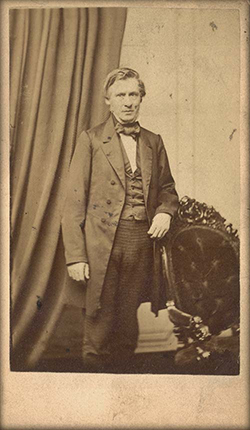 Photograph by John Adams Whipple: Asa Gray, an albumen print. Gray was considered the most important American botanist of the 19th century. His Darwiniana was considered an important explanation of how religion and science were not necessarily mutually exclusive. As a professor of botany at Harvard University for several decades, Gray regularly visited, and corresponded with, many of the leading natural scientists of the era, including Charles Darwin, who held great regard for him. Gray made several trips to Europe to collaborate with leading European scientists of the era, as well as trips to the southern and western United States. He also built an extensive network of specimen collectors.
Photograph by John Adams Whipple: Asa Gray, an albumen print. Gray was considered the most important American botanist of the 19th century. His Darwiniana was considered an important explanation of how religion and science were not necessarily mutually exclusive. As a professor of botany at Harvard University for several decades, Gray regularly visited, and corresponded with, many of the leading natural scientists of the era, including Charles Darwin, who held great regard for him. Gray made several trips to Europe to collaborate with leading European scientists of the era, as well as trips to the southern and western United States. He also built an extensive network of specimen collectors.
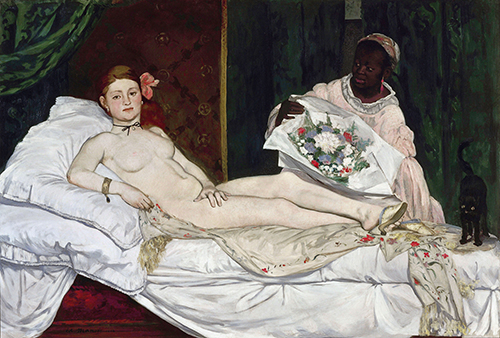 Painting by Édouard Manet: Olympia shocked the art world with its style (strong brush strokes, considered childish and unskilled) and its subject matter, a nude white woman ("Olympia"), presumably a courtesan, lying on a bed being brought flowers by a black servant. When hung in the Salon of Paris in 1865, it was met with jeers, laughter, criticism, and disdain, and was attacked by the public, the critics, the newspapers. Guards were stationed to protect it, until it was moved to a spot high above a doorway, out of reach.
Painting by Édouard Manet: Olympia shocked the art world with its style (strong brush strokes, considered childish and unskilled) and its subject matter, a nude white woman ("Olympia"), presumably a courtesan, lying on a bed being brought flowers by a black servant. When hung in the Salon of Paris in 1865, it was met with jeers, laughter, criticism, and disdain, and was attacked by the public, the critics, the newspapers. Guards were stationed to protect it, until it was moved to a spot high above a doorway, out of reach.
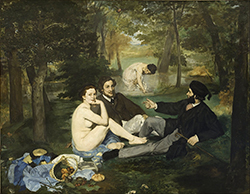 Painting by Édouard Manet: Le Déjeuner sur l'herbe (English: The Luncheon on the Grass) is a large oil on canvas painting depicting a female nude and a scantily dressed female bather on a picnic with two fully dressed men in a rural setting. Rejected by the Salon jury of 1863, Manet seized the opportunity to exhibit this and two other paintings in the 1863 Salon des Refusés where the painting sparked public notoriety and controversy. The piece is now in the Musée d'Orsay in Paris. A smaller, earlier version can be seen at the Courtauld Gallery, London. The painting features a nude woman casually lunching with two fully dressed men. Her body is starkly lit and she stares directly at the viewer. The two men, dressed as young dandies, seem to be engaged in conversation, ignoring the woman. In front of them, the woman's clothes, a basket of fruit, and a round loaf of bread are displayed, as in a still life. In the background, a lightly clad woman bathes in a stream. Too large in comparison with the figures in the foreground, she seems to float above them. The roughly painted background lacks depth — giving the viewer the impression that the scene is not taking place outdoors, but in a studio. This impression is reinforced by the use of broad "studio" light, which casts almost no shadows. The man on the right wears a flat hat with a tassel, of a kind normally worn indoors. Despite the mundane subject, Manet deliberately chose a large canvas size, measuring 81.9 by 104.1 inches, normally reserved for historical, religious, and mythological subjects. The style of the painting breaks with the academic traditions of the time. He did not try to hide the brush strokes; the painting even looks unfinished in some parts of the scene.
Painting by Édouard Manet: Le Déjeuner sur l'herbe (English: The Luncheon on the Grass) is a large oil on canvas painting depicting a female nude and a scantily dressed female bather on a picnic with two fully dressed men in a rural setting. Rejected by the Salon jury of 1863, Manet seized the opportunity to exhibit this and two other paintings in the 1863 Salon des Refusés where the painting sparked public notoriety and controversy. The piece is now in the Musée d'Orsay in Paris. A smaller, earlier version can be seen at the Courtauld Gallery, London. The painting features a nude woman casually lunching with two fully dressed men. Her body is starkly lit and she stares directly at the viewer. The two men, dressed as young dandies, seem to be engaged in conversation, ignoring the woman. In front of them, the woman's clothes, a basket of fruit, and a round loaf of bread are displayed, as in a still life. In the background, a lightly clad woman bathes in a stream. Too large in comparison with the figures in the foreground, she seems to float above them. The roughly painted background lacks depth — giving the viewer the impression that the scene is not taking place outdoors, but in a studio. This impression is reinforced by the use of broad "studio" light, which casts almost no shadows. The man on the right wears a flat hat with a tassel, of a kind normally worn indoors. Despite the mundane subject, Manet deliberately chose a large canvas size, measuring 81.9 by 104.1 inches, normally reserved for historical, religious, and mythological subjects. The style of the painting breaks with the academic traditions of the time. He did not try to hide the brush strokes; the painting even looks unfinished in some parts of the scene.
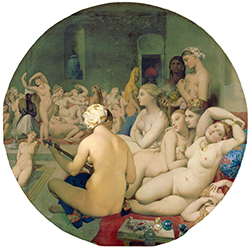 Painting by Jean Auguste Dominique Ingres: The Turkish Bath (Le Bain Turc) depicts a group of nude women in the bath of a harem, and is painted in a highly erotic style that evokes both the near east and earlier western styles associated with mythological subject matter. Painted on canvas laid down on wood, it measures 108 x 108 cm. The work is signed and dated 1862, when Ingres was around 82 years old, and was completed in 1863. In that year Ingres altered the painting's original rectangular format, and cut the painting to its present tondo form. Photographs of the painting in its original format survive. It seems based on an April 1717 written description of a Turkish harem by Lady Mary Montagu, where she mentions having viewed some two hundred nude women. The painting develops and elaborates a number of motifs Ingres had explored in earlier paintings, in particular his 1808 The Valpinçon Bather and Grande Odalisque of 1814. Its erotic content did not provoke a scandal, since for much its existence it has remained in private collections. It is now in the Louvre, Paris.
Painting by Jean Auguste Dominique Ingres: The Turkish Bath (Le Bain Turc) depicts a group of nude women in the bath of a harem, and is painted in a highly erotic style that evokes both the near east and earlier western styles associated with mythological subject matter. Painted on canvas laid down on wood, it measures 108 x 108 cm. The work is signed and dated 1862, when Ingres was around 82 years old, and was completed in 1863. In that year Ingres altered the painting's original rectangular format, and cut the painting to its present tondo form. Photographs of the painting in its original format survive. It seems based on an April 1717 written description of a Turkish harem by Lady Mary Montagu, where she mentions having viewed some two hundred nude women. The painting develops and elaborates a number of motifs Ingres had explored in earlier paintings, in particular his 1808 The Valpinçon Bather and Grande Odalisque of 1814. Its erotic content did not provoke a scandal, since for much its existence it has remained in private collections. It is now in the Louvre, Paris.
 Painting by Alexandre Cabanel: The Birth of Venus, now in the Musée d'Orsay in Paris. A second and smaller version (85 × 135.9 cm) from ca. 1864 is in Dahesh Museum of Art. A third (106 × 182.6 cm)[2] version dates from 1875; it is in the Metropolitan Museum of Art in New York City. Shown to great success at the Paris Salon of 1863, The Birth of Venus was immediately purchased by Napoleon III for his own personal collection. That same year Cabanel was made a professor of the Ecole des Beaux-Arts. Cabanel's combination of sensual and classical imagery appealed to the higher levels of society. Art historian and curator Robert Rosenblum wrote of Cabanel's The Birth of Venus that "This Venus hovers somewhere between an ancient deity and a modern dream"; he described "the ambiguity of her eyes, that seem to be closed but that a close look reveals that she is awake ... A nude who could be asleep or awake is specially formidable for a male viewer."
Painting by Alexandre Cabanel: The Birth of Venus, now in the Musée d'Orsay in Paris. A second and smaller version (85 × 135.9 cm) from ca. 1864 is in Dahesh Museum of Art. A third (106 × 182.6 cm)[2] version dates from 1875; it is in the Metropolitan Museum of Art in New York City. Shown to great success at the Paris Salon of 1863, The Birth of Venus was immediately purchased by Napoleon III for his own personal collection. That same year Cabanel was made a professor of the Ecole des Beaux-Arts. Cabanel's combination of sensual and classical imagery appealed to the higher levels of society. Art historian and curator Robert Rosenblum wrote of Cabanel's The Birth of Venus that "This Venus hovers somewhere between an ancient deity and a modern dream"; he described "the ambiguity of her eyes, that seem to be closed but that a close look reveals that she is awake ... A nude who could be asleep or awake is specially formidable for a male viewer."
1863
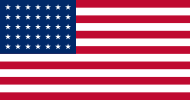 The US flag is modified to have thirty-five stars, reflecting the addition of one new state: West Virginia. This new state was created when Union sympathizers in the western portion of Virginia seceded from Virginia (then in secession from the US) and rejoined the Union.
The US flag is modified to have thirty-five stars, reflecting the addition of one new state: West Virginia. This new state was created when Union sympathizers in the western portion of Virginia seceded from Virginia (then in secession from the US) and rejoined the Union.
Abraham Lincoln's Emancipation Proclamation takes effect on January 1, legally freeing slaves in areas of the South still in rebellion against the United States.
 The Battle of Gettysburg (1-3 Jul) was the battle with the largest number of casualties in the American Civil War. Union Maj. Gen. George Gordon Meade's Army of the Potomac defeated attacks by Confederate Gen. Robert E. Lee's Army of Northern Virginia, ending Lee's invasion of the North.
The Battle of Gettysburg (1-3 Jul) was the battle with the largest number of casualties in the American Civil War. Union Maj. Gen. George Gordon Meade's Army of the Potomac defeated attacks by Confederate Gen. Robert E. Lee's Army of Northern Virginia, ending Lee's invasion of the North.

 The Siege of Vicksburg was the final major military action in the Vicksburg Campaign of the American Civil War. Union Maj. Gen. Ulysses S. Grant crossed the Mississippi River and drove the Confederate army of Lt. Gen. John C. Pemberton into the fortress city of Vicksburg, Mississippi, and placed the city under siege. After more than forty days, with no re-enforcement and supplies nearly gone, the garrison surrendered on July 4. This surrender, combined with Lee's defeat at Gettysburg the previous day, represents the turning point of the war. From then on, military victory for the Confederacy was impossible.
The Siege of Vicksburg was the final major military action in the Vicksburg Campaign of the American Civil War. Union Maj. Gen. Ulysses S. Grant crossed the Mississippi River and drove the Confederate army of Lt. Gen. John C. Pemberton into the fortress city of Vicksburg, Mississippi, and placed the city under siege. After more than forty days, with no re-enforcement and supplies nearly gone, the garrison surrendered on July 4. This surrender, combined with Lee's defeat at Gettysburg the previous day, represents the turning point of the war. From then on, military victory for the Confederacy was impossible.
(no entry for this year)
1864
 After the Confederate defeat at Chattanooga, President Lincoln promoted Grant to a special regular army rank, Lieutenant General, authorized by Congress on March 2, 1864. This rank had previously been awarded two other times, a full rank to George Washington and a Brevet rank to Winfield Scott. Lincoln then places Grant in charges of all Union forces.
After the Confederate defeat at Chattanooga, President Lincoln promoted Grant to a special regular army rank, Lieutenant General, authorized by Congress on March 2, 1864. This rank had previously been awarded two other times, a full rank to George Washington and a Brevet rank to Winfield Scott. Lincoln then places Grant in charges of all Union forces.


 Sherman captures Atlanta, marches to Savannah. Through a series of bloody battles, Grant forces Lee back to Petersburg, Virginia, and then lays siege to the city. Lincoln is reelected, destroying the South's hope for a political settlement to the war.
Sherman captures Atlanta, marches to Savannah. Through a series of bloody battles, Grant forces Lee back to Petersburg, Virginia, and then lays siege to the city. Lincoln is reelected, destroying the South's hope for a political settlement to the war.
 Alice's Adventures in Wonderland (commonly shortened to Alice in Wonderland) first published. The novel was written by English author Charles Lutwidge Dodgson under the pseudonym Lewis Carroll.
Alice's Adventures in Wonderland (commonly shortened to Alice in Wonderland) first published. The novel was written by English author Charles Lutwidge Dodgson under the pseudonym Lewis Carroll.
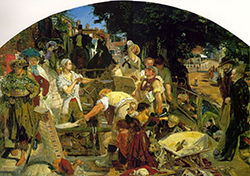 Painting by Ford Madox Brown: Work is generally considered to be his most important achievement. It exists in two versions. The painting attempts to portray, both literally and analytically, the totality of the Victorian social system and the transition from a rural to an urban economy. Brown began the painting in 1852 and completed it in 1865, when he set up a special exhibition to show it along with several of his other works. He wrote a detailed catalogue explaining the significance of the picture. The picture depicts a group of so-called "navvies" digging up the road to build an underground tunnel. It is typically assumed that this was part of the extensions of London's sewerage system, which were being undertaken to deal with the threat of typhus and cholera. The workers are in the centre of the painting. On either side of them are individuals who are either unemployed or represent the leisured classes. Behind the workers are two wealthy figures on horseback, whose progress along the road has been halted by the excavations. The painting also portrays an election campaign, evidenced by posters and people carrying sandwich boards with the name of the candidate "Bobus". A poster also draws attention to the potential presence of a burglar. The setting is an accurate depiction of The Mount on Heath Street in Hampstead, London, where a side road rises up above the main road and runs alongside it. Brown made a detailed study of the location in 1852.
Painting by Ford Madox Brown: Work is generally considered to be his most important achievement. It exists in two versions. The painting attempts to portray, both literally and analytically, the totality of the Victorian social system and the transition from a rural to an urban economy. Brown began the painting in 1852 and completed it in 1865, when he set up a special exhibition to show it along with several of his other works. He wrote a detailed catalogue explaining the significance of the picture. The picture depicts a group of so-called "navvies" digging up the road to build an underground tunnel. It is typically assumed that this was part of the extensions of London's sewerage system, which were being undertaken to deal with the threat of typhus and cholera. The workers are in the centre of the painting. On either side of them are individuals who are either unemployed or represent the leisured classes. Behind the workers are two wealthy figures on horseback, whose progress along the road has been halted by the excavations. The painting also portrays an election campaign, evidenced by posters and people carrying sandwich boards with the name of the candidate "Bobus". A poster also draws attention to the potential presence of a burglar. The setting is an accurate depiction of The Mount on Heath Street in Hampstead, London, where a side road rises up above the main road and runs alongside it. Brown made a detailed study of the location in 1852.
1865
On February 1, Abraham Lincoln signs the 13th Amendment to the United States Constitution outlawing slavery throughout the United States.
The Thirteenth Amendment to the United States Constitution officially abolished slavery and involuntary servitude, except as punishment for a crime. It was passed by the Senate on April 8, 1864, passed by the House on January 21, 1865, and adopted on December 6, 1865.
Lee surrenders, US Civil war ends, Lincoln assassinated.
 Andrew Johnson becomes seventeenth president of the United States.
Andrew Johnson becomes seventeenth president of the United States.
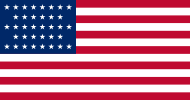 The US flag is modified to have thirty-six stars, reflecting the addition of one new state: Nevada.
The US flag is modified to have thirty-six stars, reflecting the addition of one new state: Nevada.
 The Ku Klux Klan is formed on December 24 in Polanski, Tennessee, by six Confederate veterans. Nathan Bedford Forrest, a former Confederate cavalry general and slave trader, serves as the Klan's first grand wizard or leader-in-chief.
The Ku Klux Klan is formed on December 24 in Polanski, Tennessee, by six Confederate veterans. Nathan Bedford Forrest, a former Confederate cavalry general and slave trader, serves as the Klan's first grand wizard or leader-in-chief.
 Blue Danube Waltz Presented Johann Strauss the younger first presents his Blue Danube Waltz, which later became one of the most popular and familiar works of European music.
Blue Danube Waltz Presented Johann Strauss the younger first presents his Blue Danube Waltz, which later became one of the most popular and familiar works of European music.
1866
On June 13, Congress approves the Fourteenth Amendment to the Constitution, guaranteeing due process and equal protection under the law to all citizens. The amendment also grants citizenship to African-Americans.
(no entry for this year)
1867
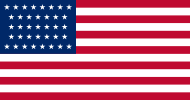 The US flag is modified to have thirty-seven stars, reflecting the addition of one new state: Nebraska.
The US flag is modified to have thirty-seven stars, reflecting the addition of one new state: Nebraska.
The Alaska Purchase resulted in the transfer of Alaska to the United States from the Russian Empire for a total price of $ 7,000,000. The purchase, made at the initiative of United States Secretary of State William H. Seward, gained 586,412 square miles of new United States territory.
 Louisa May Alcott publishes Little Women.
Louisa May Alcott publishes Little Women.
1868
The Meiji Restoration in Japan (led by samurai from the western clans of Satsuma, Choshu, Tosa, and Hizen) overthrows the feudal shogunate system and initiates Japan's participation in the modern world.
The Impeachment of Andrew Johnson, 17th President of the United States, was one of the most dramatic events in the political life of the United States during Reconstruction, and the first impeachment in history of a sitting United States president.
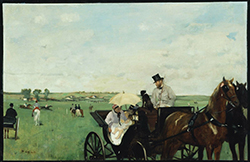 Painting by : At the Races in the Countryside. This painting was one of the first works that Degas sold (in 1872) to Paul Durand-Ruel, the dealer who became the early champion of the Impressionists. It is not only a landscape but also a scene from everyday life and — most of all — a family portrait. The driver of the carriage is Degas's friend Paul Valpin on, who is shown with his wife, a wet nurse, and in the nurse's lap, the couple's son, Henri.
Painting by : At the Races in the Countryside. This painting was one of the first works that Degas sold (in 1872) to Paul Durand-Ruel, the dealer who became the early champion of the Impressionists. It is not only a landscape but also a scene from everyday life and — most of all — a family portrait. The driver of the carriage is Degas's friend Paul Valpin on, who is shown with his wife, a wet nurse, and in the nurse's lap, the couple's son, Henri.
1869
On February 26, Congress sends the Fifteenth Amendment to the Constitution to the states for approval. The amendment guarantees African-American males the right to vote.
Transcontinental Rail Service Begun in the United States On May 10th, at Promontory Point, Utah, a golden rail spike was struck, completing the first transcontinental railroad line.
 Ulysses S. Grant becomes eighteenth president of the United States.
Ulysses S. Grant becomes eighteenth president of the United States.
 Japan colonizes Hokkaido as part of its new nation state.
Japan colonizes Hokkaido as part of its new nation state.
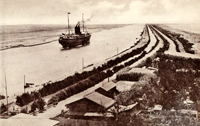 The Suez Canal opened to traffic on 17 November. The canal linked the Mediterranean and the Red Sea. It was 103 miles long and it brought Oriental ports 5,000 miles closer to Europe. Work had begun on the canal in 1859, financed primarily by French investors. The canal increased the strategic importance of Egypt to European powers.
The Suez Canal opened to traffic on 17 November. The canal linked the Mediterranean and the Red Sea. It was 103 miles long and it brought Oriental ports 5,000 miles closer to Europe. Work had begun on the canal in 1859, financed primarily by French investors. The canal increased the strategic importance of Egypt to European powers.
(no entry for this year)
1870
 Standard Oil Formed On January 10th, 1870, John D Rockefeller and four partners incorporate the Standard Oil Company. The company gains control of nearly 95% of the oil refining industry in the United States.
Standard Oil Formed On January 10th, 1870, John D Rockefeller and four partners incorporate the Standard Oil Company. The company gains control of nearly 95% of the oil refining industry in the United States.
The First Vatican Council of the Roman Catholic Church proclaims the dogma of the infallibility of the Pope.
The Franco-Prussian war (1870-71) leads to the formation of the German Empire.
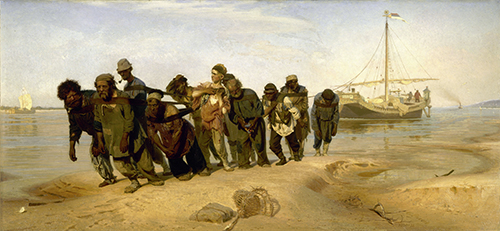 Painting by Ilia Efimovich Repin: Barge Haulers on the Volga or Burlaki (Russian: Burlaki na Volge) is an 1870 73 oil-on-canvas painting depicting laboring men dragging a barge on the Volga River. The men seem to almost collapse forward in exhaustion under the burden of hauling a large boat upstream in heavy, hot weather. The work is both a celebration of the men's dignity and fortitude, and a highly emotional condemnation of those who sanctioned such inhumane labor. Although they are presented as stoical and accepting, the men are largely defeated; only one stands out: in the center of both the row and canvas, a brightly colored youth fights against his leather binds and takes on a heroic pose.
Painting by Ilia Efimovich Repin: Barge Haulers on the Volga or Burlaki (Russian: Burlaki na Volge) is an 1870 73 oil-on-canvas painting depicting laboring men dragging a barge on the Volga River. The men seem to almost collapse forward in exhaustion under the burden of hauling a large boat upstream in heavy, hot weather. The work is both a celebration of the men's dignity and fortitude, and a highly emotional condemnation of those who sanctioned such inhumane labor. Although they are presented as stoical and accepting, the men are largely defeated; only one stands out: in the center of both the row and canvas, a brightly colored youth fights against his leather binds and takes on a heroic pose.
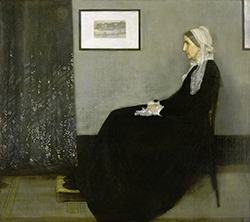 Painting by James McNeill Whistler: Arrangement in Grey and Black No.1, best known under its colloquial name Whistler's Mother, depicts Whistler's mother, Anna McNeill Whistler. The painting is 56.81 by 63.94 inches, displayed in a frame of Whistler's own design. It is exhibited in and held by the Musée d'Orsay in Paris, having been bought by the French state in 1891. It is one of the most famous works by an American artist outside the United States. It has been variously described as an American icon and a Victorian Mona Lisa.
Painting by James McNeill Whistler: Arrangement in Grey and Black No.1, best known under its colloquial name Whistler's Mother, depicts Whistler's mother, Anna McNeill Whistler. The painting is 56.81 by 63.94 inches, displayed in a frame of Whistler's own design. It is exhibited in and held by the Musée d'Orsay in Paris, having been bought by the French state in 1891. It is one of the most famous works by an American artist outside the United States. It has been variously described as an American icon and a Victorian Mona Lisa.
1871
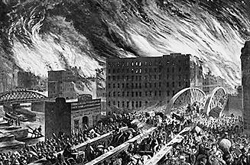 On October 8th, a fire broke out in the west side of Chicago. The Great Chicago Fire lasted two days, killing 300 people, and destroying most of Chicago. Property damages were estimated at 200 million dollars.
On October 8th, a fire broke out in the west side of Chicago. The Great Chicago Fire lasted two days, killing 300 people, and destroying most of Chicago. Property damages were estimated at 200 million dollars.
On October 8th, a fire broke out in the village of Peshtigo, Wisconsin. The Peshtigo Fire caused more deaths than any other fire in the history of the United States. By the time it was over, 1,875 square miles (1.2 million acres) of forest had been consumed, an area approximately twice the size of the state of Rhode Island. Some sources list as much as 1.5 million acres burned. Twelve communities were destroyed. An accurate death toll has never been determined since local population records were destroyed in the fire. Between 1,200 and 2,500 people are thought to have lost their lives.
The occurrence of this fire, and several other smaller fires, on the same day as the Great Chicago fire has lead some to speculate that all of the fires may have had a common cause: multiple impacts from fragments of a disintegrating comet.

 Henry Morton Stanley finds David Livingstone in Africa, greeting the Scotsman with the famous words, "Dr. Livingstone, I presume."
Henry Morton Stanley finds David Livingstone in Africa, greeting the Scotsman with the famous words, "Dr. Livingstone, I presume."
The Second Reich proclaimed With the German victory in France complete, the German Reichstag(parliament) proclaimed the creation of the Second Reich. The Reichstag approved with minor modification the constitution of the Northern German Federation. William I became King of Germany with Otto Bismarck the first chancellor.
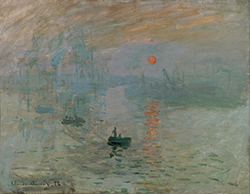 Painting by Claude Monet: Impression, Sunrise (French: Impression, soleil levant) was shown at what would later be known as the "Exhibition of the Impressionists" in April 1874. The painting depicts the port of Le Havre, Monet's hometown, and is his most famous painting of the harbor. Monet claimed that he titled the painting Impression, Sunrise due to his hazy painting style in his depiction of the subject: "They asked me for a title for the catalogue, it couldn't really be taken for a view of Le Havre, and I said: 'Put Impression.'" In addition to this explanation for the title of the work, art historian Paul Smith claims that Monet might have named the painting Impression to excuse his painting from accusations of being unfinished or lacking descriptive detail, but Monet received these criticisms regardless of the title
Painting by Claude Monet: Impression, Sunrise (French: Impression, soleil levant) was shown at what would later be known as the "Exhibition of the Impressionists" in April 1874. The painting depicts the port of Le Havre, Monet's hometown, and is his most famous painting of the harbor. Monet claimed that he titled the painting Impression, Sunrise due to his hazy painting style in his depiction of the subject: "They asked me for a title for the catalogue, it couldn't really be taken for a view of Le Havre, and I said: 'Put Impression.'" In addition to this explanation for the title of the work, art historian Paul Smith claims that Monet might have named the painting Impression to excuse his painting from accusations of being unfinished or lacking descriptive detail, but Monet received these criticisms regardless of the title
1872
(no entry for this year)
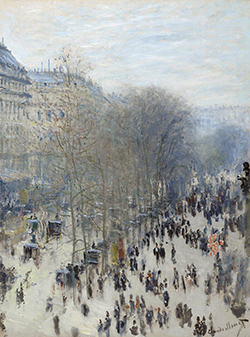 Painting by Claud Monet: Boulevard des Capucines. From the late 1860s, Monet and other like-minded artists, met with rejection from the conservative Académie des Beaux-Arts which held its annual exhibition at the Salon de Paris. During the latter part of 1873, Monet, Renoir, Pissarro, and Sisley organized the Société anonyme des artistes peintres, sculpteurs et graveurs to exhibit their artworks independently. At their first exhibition, held in April 1874, Monet exhibited the work that was to give the group its lasting name, Impression, Sunrise. Among the works Monet included in the first Impressionist exhibition was The Luncheon, 1868, which features Camille Doncieux and Jean Monet. The painting was rejected by the Paris Salon of 1870. Also in this exhibition was a painting titled Boulevard des Capucines, a painting of the boulevard done from the from the studio of Monet's friend, the photographer Felix Nadar.
Painting by Claud Monet: Boulevard des Capucines. From the late 1860s, Monet and other like-minded artists, met with rejection from the conservative Académie des Beaux-Arts which held its annual exhibition at the Salon de Paris. During the latter part of 1873, Monet, Renoir, Pissarro, and Sisley organized the Société anonyme des artistes peintres, sculpteurs et graveurs to exhibit their artworks independently. At their first exhibition, held in April 1874, Monet exhibited the work that was to give the group its lasting name, Impression, Sunrise. Among the works Monet included in the first Impressionist exhibition was The Luncheon, 1868, which features Camille Doncieux and Jean Monet. The painting was rejected by the Paris Salon of 1870. Also in this exhibition was a painting titled Boulevard des Capucines, a painting of the boulevard done from the from the studio of Monet's friend, the photographer Felix Nadar.
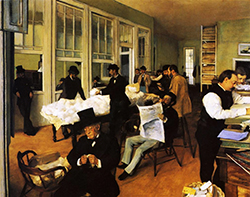 Painting by Edgar Degas: A Cotton Office in New Orleans depicts the artist's uncle Michel Musson's cotton brokerage business (which several years later went bankrupt in an economic crash, according to Michael McMahon of the Pittsburgh Post-Gazette when the firm was swamped by the postwar growth of the much larger Cotton Exchange). In the painting, Musson is seen examining raw cotton for its quality while Degas' brother René reads The Daily Picayune. Another brother, Achille, rests against a window wall at left while others, including Musson's partners, go about their business. A Cotton Office in New Orleans was the first painting by Degas to be purchased by a museum, and the first by an Impressionist. Degas' sale of the piece marked a turning point in his career as he moved from being a struggling, unrecognized artist to a recognized and financially stable artist, according to Marilyn Brown in her book Degas and the Business of Art: A Cotton Office in New Orleans. Degas traveled from Europe to New Orleans in late 1872 with his brother, René, to visit his mother's brother, Michael Musson. After the American Civil War, René had joined his uncle's cotton business in New Orleans. Degas was to return to Europe in January 1873, but when his return trip was delayed, he was asked by his relatives to paint their portraits, and decided to show them as a group, at work in the family office.
Painting by Edgar Degas: A Cotton Office in New Orleans depicts the artist's uncle Michel Musson's cotton brokerage business (which several years later went bankrupt in an economic crash, according to Michael McMahon of the Pittsburgh Post-Gazette when the firm was swamped by the postwar growth of the much larger Cotton Exchange). In the painting, Musson is seen examining raw cotton for its quality while Degas' brother René reads The Daily Picayune. Another brother, Achille, rests against a window wall at left while others, including Musson's partners, go about their business. A Cotton Office in New Orleans was the first painting by Degas to be purchased by a museum, and the first by an Impressionist. Degas' sale of the piece marked a turning point in his career as he moved from being a struggling, unrecognized artist to a recognized and financially stable artist, according to Marilyn Brown in her book Degas and the Business of Art: A Cotton Office in New Orleans. Degas traveled from Europe to New Orleans in late 1872 with his brother, René, to visit his mother's brother, Michael Musson. After the American Civil War, René had joined his uncle's cotton business in New Orleans. Degas was to return to Europe in January 1873, but when his return trip was delayed, he was asked by his relatives to paint their portraits, and decided to show them as a group, at work in the family office.
1873
Slavery is abolished in Puerto Rico.
Spain decrees the end of slavery in Cuba, still a Spanish colony.
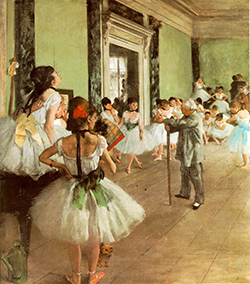 Painting by Edgar Degas: The Ballet Class (French: La Classe de danse) is in the collection of the Musée d'Orsay, Paris, France. It was commissioned by Jean-Baptiste Faure. Degas temporarily abandoned work on this painting, and delivered a work of a similar name to Faure. The painting depicts dancers at the end of a lesson under ballet master Jules Perrot. Perrot and Degas were friends, and Perrot allowed Degas access to dance classes.
Painting by Edgar Degas: The Ballet Class (French: La Classe de danse) is in the collection of the Musée d'Orsay, Paris, France. It was commissioned by Jean-Baptiste Faure. Degas temporarily abandoned work on this painting, and delivered a work of a similar name to Faure. The painting depicts dancers at the end of a lesson under ballet master Jules Perrot. Perrot and Degas were friends, and Perrot allowed Degas access to dance classes.
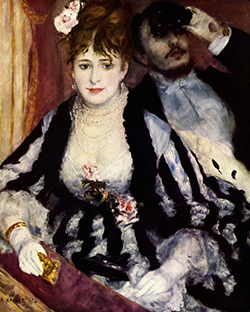 Painting by Pierre-Auguste Renoir: La Loge (The Theatre Box) depicts an elegant-looking couple sitting in an elevated theater box. This tribute to Parisian modern life was also the artist's principal contribution to the very first Impressionist exhibition of the same year, and it was met with much acclaim. It is now part of the collection at Courtauld Institute of Art in London.
Painting by Pierre-Auguste Renoir: La Loge (The Theatre Box) depicts an elegant-looking couple sitting in an elevated theater box. This tribute to Parisian modern life was also the artist's principal contribution to the very first Impressionist exhibition of the same year, and it was met with much acclaim. It is now part of the collection at Courtauld Institute of Art in London.
1874
(no entry for this year)
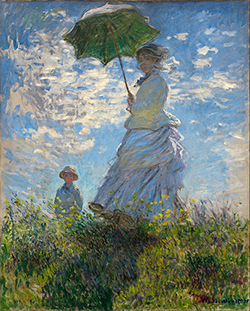 Painting by Claude Monet: Woman with a Parasol - Madame Monet and Her Son, sometimes known as The Stroll (French: La Promenade) depicts his wife Camille Monet and their son Jean Monet in the period from 1871 to 1877 while they were living in Argenteuil, capturing a moment on a stroll on a windy summer's day. The work is a genre painting of an everyday family scene, not a formal portrait. The work was painted outdoors, en plein air, and quickly, probably in a single period of a few hours. It measures 100 × 81 centimetres (39 × 32 in), his largest work in the 1870s, and is signed "Monet 75" in the lower right corner.
Painting by Claude Monet: Woman with a Parasol - Madame Monet and Her Son, sometimes known as The Stroll (French: La Promenade) depicts his wife Camille Monet and their son Jean Monet in the period from 1871 to 1877 while they were living in Argenteuil, capturing a moment on a stroll on a windy summer's day. The work is a genre painting of an everyday family scene, not a formal portrait. The work was painted outdoors, en plein air, and quickly, probably in a single period of a few hours. It measures 100 × 81 centimetres (39 × 32 in), his largest work in the 1870s, and is signed "Monet 75" in the lower right corner.
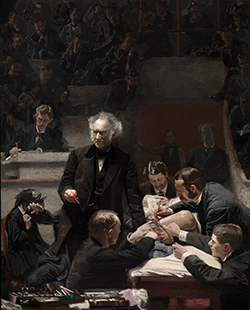 Painting by Thomas Eakins: The Gross Clinic, or, The Clinic of Dr. Gross, is large painting, measuring 8 feet (240 cm) by 6.5 feet (200 cm). Dr. Samuel D. Gross, a seventy-year-old professor dressed in a black frock coat, lectures a group of Jefferson Medical College students. Admired for its uncompromising realism, The Gross Clinic has an important place documenting the history of medicine both because it honors the emergence of surgery as a healing profession (previously, surgery was associated primarily with amputation), and because it shows us what the surgical theater looked like in the nineteenth century. In 1875, anesthesia was used, but sterile procedures were not.
Painting by Thomas Eakins: The Gross Clinic, or, The Clinic of Dr. Gross, is large painting, measuring 8 feet (240 cm) by 6.5 feet (200 cm). Dr. Samuel D. Gross, a seventy-year-old professor dressed in a black frock coat, lectures a group of Jefferson Medical College students. Admired for its uncompromising realism, The Gross Clinic has an important place documenting the history of medicine both because it honors the emergence of surgery as a healing profession (previously, surgery was associated primarily with amputation), and because it shows us what the surgical theater looked like in the nineteenth century. In 1875, anesthesia was used, but sterile procedures were not.
1875
(no entry for this year)
 Mark Twain publishes Tom Sawyer.
Mark Twain publishes Tom Sawyer.
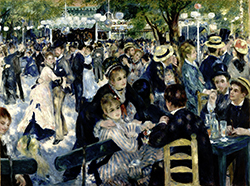 Painting by Pierre-Auguste Renoir: Bal du moulin de la Galette (commonly known as Dance at Le moulin de la Galette) is housed at the Musée d'Orsay in Paris and is one of Impressionism's most celebrated masterpieces. The painting depicts a typical Sunday afternoon at Moulin de la Galette in the district of Montmartre in Paris. In the late 19th century, working class Parisians would dress up and spend time there dancing, drinking, and eating galettes into the evening. Like other works of Renoir's early maturity, Bal du moulin de la Galette is a typically Impressionist snapshot of real life. It shows a richness of form, a fluidity of brush stroke, and a flickering light.
Painting by Pierre-Auguste Renoir: Bal du moulin de la Galette (commonly known as Dance at Le moulin de la Galette) is housed at the Musée d'Orsay in Paris and is one of Impressionism's most celebrated masterpieces. The painting depicts a typical Sunday afternoon at Moulin de la Galette in the district of Montmartre in Paris. In the late 19th century, working class Parisians would dress up and spend time there dancing, drinking, and eating galettes into the evening. Like other works of Renoir's early maturity, Bal du moulin de la Galette is a typically Impressionist snapshot of real life. It shows a richness of form, a fluidity of brush stroke, and a flickering light.
1876
 Custer Killed at Little Bighorn On June 25th, in Dakota territory, at the Little Big Horn, General George Armstrong Custer (who graduated from West Point in 1861, last in his class) and all 256 troops were killed. The defeat of Custer in the Battle of the Little Big Horn was the last Indian victory.
Custer Killed at Little Bighorn On June 25th, in Dakota territory, at the Little Big Horn, General George Armstrong Custer (who graduated from West Point in 1861, last in his class) and all 256 troops were killed. The defeat of Custer in the Battle of the Little Big Horn was the last Indian victory.
 Alexander Graham Bell patents the telephone.
Alexander Graham Bell patents the telephone.
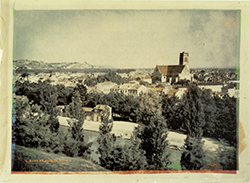 Early color photo of Agen, France, by Louis Ducos du Hauron, 1877. The cathedral in the scene is the Cath drale Saint-Caprais d'Agen.
Early color photo of Agen, France, by Louis Ducos du Hauron, 1877. The cathedral in the scene is the Cath drale Saint-Caprais d'Agen.
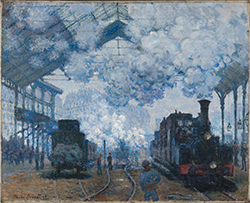 Painting by Claude Monet: The Gare Saint-Lazare: Arrival of a Train. The Gare Saint-Lazare has been represented in a number of artworks. It attracted artists during the Impressionist period and many of them lived very close to the Gare St-Lazare during the 1870s and 1880s. In 1877, painter Claude Monet rented a studio near the Gare Saint Lazare. That same year he exhibited seven paintings of the railway station in an impressionist painting exhibition. He completed several paintings of this subject. The Gare Saint-Lazare is far different than Monet's previous paintings of harbors, boats and oceans that viewers had seen before. The Gare Saint-Lazare series of paintings lead the viewers through a tour of the train station in different points of the day. Monet exemplifies the modern life, in all its chaos and instability, The steam coming from the trains creates a way of dissolving the train and showing the impressionistic style of blending colors and light. Everything dissipates with the steam of the train and turns into a flurry of blended colors. As said by mile Zola, Monet is able to turn a normally dirty and gritty place into a peaceful and beautiful scene You can hear the trains rumbling in, see the smoke billow up under the huge roofs that is where painting is today our artists have to find the poetry in train station, the way their fathers found the poetry in forests and rivers. Monet's work on the Gare Saint-Lazare is unparalleled in its evocation of steamm and the smoke-filled station. In spite of the impressionist style, the work reproduces accurately the topography of the area, even allowing one to deduce the precise point where the artist was standing while painting. This is the first time an artist had showed a single theme through a series of variations
Painting by Claude Monet: The Gare Saint-Lazare: Arrival of a Train. The Gare Saint-Lazare has been represented in a number of artworks. It attracted artists during the Impressionist period and many of them lived very close to the Gare St-Lazare during the 1870s and 1880s. In 1877, painter Claude Monet rented a studio near the Gare Saint Lazare. That same year he exhibited seven paintings of the railway station in an impressionist painting exhibition. He completed several paintings of this subject. The Gare Saint-Lazare is far different than Monet's previous paintings of harbors, boats and oceans that viewers had seen before. The Gare Saint-Lazare series of paintings lead the viewers through a tour of the train station in different points of the day. Monet exemplifies the modern life, in all its chaos and instability, The steam coming from the trains creates a way of dissolving the train and showing the impressionistic style of blending colors and light. Everything dissipates with the steam of the train and turns into a flurry of blended colors. As said by mile Zola, Monet is able to turn a normally dirty and gritty place into a peaceful and beautiful scene You can hear the trains rumbling in, see the smoke billow up under the huge roofs that is where painting is today our artists have to find the poetry in train station, the way their fathers found the poetry in forests and rivers. Monet's work on the Gare Saint-Lazare is unparalleled in its evocation of steamm and the smoke-filled station. In spite of the impressionist style, the work reproduces accurately the topography of the area, even allowing one to deduce the precise point where the artist was standing while painting. This is the first time an artist had showed a single theme through a series of variations
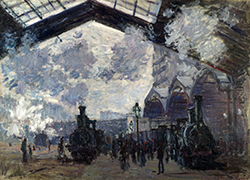 Painting by Claude Monet: The Gare Saint-Lazare. The Gare Saint-Lazare has been represented in a number of artworks. It attracted artists during the Impressionist period and many of them lived very close to the Gare St-Lazare during the 1870s and 1880s. In 1877, painter Claude Monet rented a studio near the Gare Saint Lazare. That same year he exhibited seven paintings of the railway station in an impressionist painting exhibition. He completed several paintings of this subject. The Gare Saint-Lazare is far different than Monet's previous paintings of harbors, boats and oceans that viewers had seen before. The Gare Saint-Lazare series of paintings lead the viewers through a tour of the train station in different points of the day. Monet exemplifies the modern life, in all its chaos and instability, The steam coming from the trains creates a way of dissolving the train and showing the impressionistic style of blending colors and light. Everything dissipates with the steam of the train and turns into a flurry of blended colors. As said by mile Zola, Monet is able to turn a normally dirty and gritty place into a peaceful and beautiful scene You can hear the trains rumbling in, see the smoke billow up under the huge roofs that is where painting is today our artists have to find the poetry in train station, the way their fathers found the poetry in forests and rivers. Monet's work on the Gare Saint-Lazare is unparalleled in its evocation of steamm and the smoke-filled station. In spite of the impressionist style, the work reproduces accurately the topography of the area, even allowing one to deduce the precise point where the artist was standing while painting. This is the first time an artist had showed a single theme through a series of variations
Painting by Claude Monet: The Gare Saint-Lazare. The Gare Saint-Lazare has been represented in a number of artworks. It attracted artists during the Impressionist period and many of them lived very close to the Gare St-Lazare during the 1870s and 1880s. In 1877, painter Claude Monet rented a studio near the Gare Saint Lazare. That same year he exhibited seven paintings of the railway station in an impressionist painting exhibition. He completed several paintings of this subject. The Gare Saint-Lazare is far different than Monet's previous paintings of harbors, boats and oceans that viewers had seen before. The Gare Saint-Lazare series of paintings lead the viewers through a tour of the train station in different points of the day. Monet exemplifies the modern life, in all its chaos and instability, The steam coming from the trains creates a way of dissolving the train and showing the impressionistic style of blending colors and light. Everything dissipates with the steam of the train and turns into a flurry of blended colors. As said by mile Zola, Monet is able to turn a normally dirty and gritty place into a peaceful and beautiful scene You can hear the trains rumbling in, see the smoke billow up under the huge roofs that is where painting is today our artists have to find the poetry in train station, the way their fathers found the poetry in forests and rivers. Monet's work on the Gare Saint-Lazare is unparalleled in its evocation of steamm and the smoke-filled station. In spite of the impressionist style, the work reproduces accurately the topography of the area, even allowing one to deduce the precise point where the artist was standing while painting. This is the first time an artist had showed a single theme through a series of variations
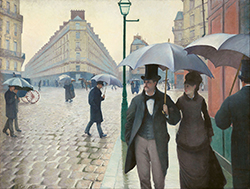 Painting by Gustave Caillebotte: Paris Street; Rainy Day (French Rue de Paris, temps de pluie) is his best known work. It shows a number of individuals walking through the Place de Dublin, in 1877 known as the Carrefour de Moscou, at an intersection to the east of the Gare Saint-Lazare in north Paris. Although Caillebotte was a friend and patron of many of the impressionist painters, and this work is part of that school, it differs in its realism and reliance on line rather than broad brush strokes. Caillebotte's interest in photography is evident. The figures in the foreground appear "out of focus", those in the mid-distance (the carriage and the pedestrians in the intersection) have sharp edges, while the features in the background become progressively indistinct. The severe cropping of some figures — particularly the man to the far right — further suggests the influence.
Painting by Gustave Caillebotte: Paris Street; Rainy Day (French Rue de Paris, temps de pluie) is his best known work. It shows a number of individuals walking through the Place de Dublin, in 1877 known as the Carrefour de Moscou, at an intersection to the east of the Gare Saint-Lazare in north Paris. Although Caillebotte was a friend and patron of many of the impressionist painters, and this work is part of that school, it differs in its realism and reliance on line rather than broad brush strokes. Caillebotte's interest in photography is evident. The figures in the foreground appear "out of focus", those in the mid-distance (the carriage and the pedestrians in the intersection) have sharp edges, while the features in the background become progressively indistinct. The severe cropping of some figures — particularly the man to the far right — further suggests the influence.
1877
The Compromise of 1877 ends Reconstruction and gives the Presidency to Rutherford B. Hayes. Although Democratic presidential candidate Samuel Tilden won the popular vote, Southern Democratic leaders agreed to support Rutherford Hayes' efforts to obtain the disputed electoral votes of Florida, Louisiana, and South Carolina in exchange for the withdrawal of the last federal troops from the South and the end of federal efforts to protect the civil rights of African Americans.
 Rutherford B. Hayes becomes nineteenth president of the United States.
Rutherford B. Hayes becomes nineteenth president of the United States.
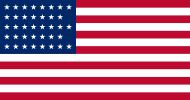 The US flag is modified to have thirty-eight stars, reflecting the addition of one new state: Colorado.
The US flag is modified to have thirty-eight stars, reflecting the addition of one new state: Colorado.
Frederick Douglass becomes US Marshal for the District of Columbia.
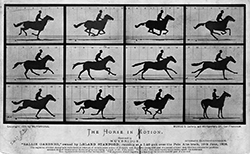 Photograph by Eadweard Muybridge: Sallie Gardner at a Gallop, also known as The Horse in Motion, is a series of photographs consisting of a galloping horse, the result of a photographic experiment on June 15, 1878. Sometimes cited as an early silent film, the series and later experiments like it were precursors to the development of motion pictures. The series consists of 24 photographs shot in rapid succession that were shown on a zoopraxiscope. Muybridge was commissioned by Leland Stanford, the industrialist and horseman, who was interested in gait analysis. The purpose of the shoot was to determine whether a galloping horse ever lifts all four feet completely off the ground during the gait; at this speed, the human eye cannot break down the action. Muybridge arranged 24 cameras, 27 inches apart, along a track parallel to the horse's path, with their shutters controlled by trip wires triggered by the horse's legs. The stop-action photographs showed the mare lifted all four legs off the ground at certain points during the gallop. Run together, the photographs produced the effect of the horse in motion, or a film.
Photograph by Eadweard Muybridge: Sallie Gardner at a Gallop, also known as The Horse in Motion, is a series of photographs consisting of a galloping horse, the result of a photographic experiment on June 15, 1878. Sometimes cited as an early silent film, the series and later experiments like it were precursors to the development of motion pictures. The series consists of 24 photographs shot in rapid succession that were shown on a zoopraxiscope. Muybridge was commissioned by Leland Stanford, the industrialist and horseman, who was interested in gait analysis. The purpose of the shoot was to determine whether a galloping horse ever lifts all four feet completely off the ground during the gait; at this speed, the human eye cannot break down the action. Muybridge arranged 24 cameras, 27 inches apart, along a track parallel to the horse's path, with their shutters controlled by trip wires triggered by the horse's legs. The stop-action photographs showed the mare lifted all four legs off the ground at certain points during the gallop. Run together, the photographs produced the effect of the horse in motion, or a film.
1878

 Thomas Edison and Joseph Wilson Swan produce first successful incandescent electric light.
Thomas Edison and Joseph Wilson Swan produce first successful incandescent electric light.
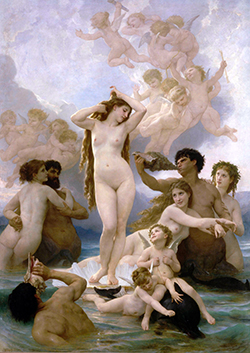 Painting by William-Adolphe Bouguereau: The Birth of Venus, one of Bouguereau's most famous paintings (now at the Musée d'Orsay, Paris). It depicts not the actual birth of Venus from the sea, but her transportation in a shell as a fully mature woman from the sea to Paphos in Cyprus. She is considered the epitome of the Classical Greek and Roman ideal of the female form and beauty, on par with Venus de Milo. For Bouguereau, it is considered a tour de force. The canvas stands at just over 300 centimetres (9 feet 10 inches) high, and 218 cm (7 ft 2 in) wide. The subject matter, as well as the composition, resembles a previous rendition of this subject, Sandro Botticelli's The Birth of Venus, as well as Raphael's The Triumph of Galatea.
Painting by William-Adolphe Bouguereau: The Birth of Venus, one of Bouguereau's most famous paintings (now at the Musée d'Orsay, Paris). It depicts not the actual birth of Venus from the sea, but her transportation in a shell as a fully mature woman from the sea to Paphos in Cyprus. She is considered the epitome of the Classical Greek and Roman ideal of the female form and beauty, on par with Venus de Milo. For Bouguereau, it is considered a tour de force. The canvas stands at just over 300 centimetres (9 feet 10 inches) high, and 218 cm (7 ft 2 in) wide. The subject matter, as well as the composition, resembles a previous rendition of this subject, Sandro Botticelli's The Birth of Venus, as well as Raphael's The Triumph of Galatea.
1879
 F. W. Woolworth opens his first "five and dime store".
F. W. Woolworth opens his first "five and dime store".
(no entry for this year)
1880
(no entry for this year)
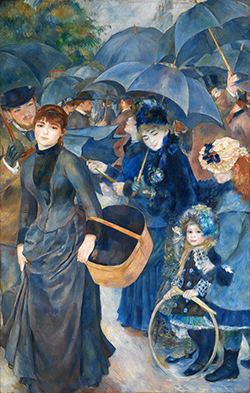 Painting by Pierre-Auguste Renoir: The Umbrellas (French: Les Parapluies) is an oil-on-canvas painting, painted in two phases in the 1880s. It is owned by the National Gallery in London as part of the Lane Bequest, but is displayed alternately in London and at the Dublin City Gallery The Hugh Lane. In May 2013, it returned to Dublin for a six-year period. Renoir began the painting in about 1880-81, using the loose brushwork with dark and bright tones typical of the Impressionist movement. In about 1885-6, after losing his attachment to Impressionism and drawing inspiration from classical art he had seen in Italy and the works of Ingres and Cézanne, he reworked parts of the painting, particularly the principal female figure to the left of the frame, in a more classical linear style using more muted colours, and added the background and the umbrellas themselves. X-ray photography has shown that the clothing of the female figure was originally different: she wore a hat and her dress had horizontal rows of frills, with white lace at its cuffs and collar, suggesting that she was middle class, whereas the simpler clothes in the revised painting mark her out as a member of the working class, a grisette not a bourgeoise. The x-ray analysis and then the changing fashions allow the periods of work to be dated with reasonable accuracy.
Painting by Pierre-Auguste Renoir: The Umbrellas (French: Les Parapluies) is an oil-on-canvas painting, painted in two phases in the 1880s. It is owned by the National Gallery in London as part of the Lane Bequest, but is displayed alternately in London and at the Dublin City Gallery The Hugh Lane. In May 2013, it returned to Dublin for a six-year period. Renoir began the painting in about 1880-81, using the loose brushwork with dark and bright tones typical of the Impressionist movement. In about 1885-6, after losing his attachment to Impressionism and drawing inspiration from classical art he had seen in Italy and the works of Ingres and Cézanne, he reworked parts of the painting, particularly the principal female figure to the left of the frame, in a more classical linear style using more muted colours, and added the background and the umbrellas themselves. X-ray photography has shown that the clothing of the female figure was originally different: she wore a hat and her dress had horizontal rows of frills, with white lace at its cuffs and collar, suggesting that she was middle class, whereas the simpler clothes in the revised painting mark her out as a member of the working class, a grisette not a bourgeoise. The x-ray analysis and then the changing fashions allow the periods of work to be dated with reasonable accuracy.
1881
 James A Garfield becomes twentieth president of the United States.
James A Garfield becomes twentieth president of the United States.
Six months after taking office, Garfield becomes the second US President to be assassinated, when he was shot by Charles J. Guiteau — a disgruntled and impoverished would-be office holder. When he purchased the pistol used in the assassination, he chose to buy one with an ivory handle because he thought it would look good as a museum exhibit after the assassination.
In January, the Tennessee State Legislature votes to segregate railroad passenger cars.
 On the Fourth of July, Booker T. Washington opens Tuskegee Institute in central Alabama.
On the Fourth of July, Booker T. Washington opens Tuskegee Institute in central Alabama.
 Chester A. Arthur becomes twenty-first president of the United States.
Chester A. Arthur becomes twenty-first president of the United States.
 Clara Barton founds the American Red Cross.
Clara Barton founds the American Red Cross.
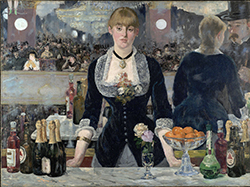 Painting by Édouard Manet: A Bar at the Folies-Bergère (French: Un bar aux Folies Bergère), is considered Manet's last major work. It depicts a scene in the Folies Bergère nightclub in Paris. It originally belonged to the composer Emmanuel Chabrier, who was Manet's neighbor, and hung over his piano. The painting exemplifies Manet's commitment to Realism in its detailed representation of a contemporary scene. Many features have puzzled critics but almost all of them have been shown to have a rationale, and the painting has been the subject of numerous popular and scholarly articles. The central figure stands before a mirror, although critics — accusing Manet of ignorance of perspective and alleging various impossibilities in the painting — have debated this point since the earliest reviews were published. In 2000, however, a photograph taken from a suitable point of view of a staged reconstruction was shown to reproduce the scene as painted by Manet.
Painting by Édouard Manet: A Bar at the Folies-Bergère (French: Un bar aux Folies Bergère), is considered Manet's last major work. It depicts a scene in the Folies Bergère nightclub in Paris. It originally belonged to the composer Emmanuel Chabrier, who was Manet's neighbor, and hung over his piano. The painting exemplifies Manet's commitment to Realism in its detailed representation of a contemporary scene. Many features have puzzled critics but almost all of them have been shown to have a rationale, and the painting has been the subject of numerous popular and scholarly articles. The central figure stands before a mirror, although critics — accusing Manet of ignorance of perspective and alleging various impossibilities in the painting — have debated this point since the earliest reviews were published. In 2000, however, a photograph taken from a suitable point of view of a staged reconstruction was shown to reproduce the scene as painted by Manet.
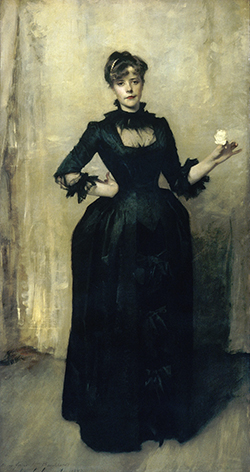 Painting by John Singer Sargent: Lady with the Rose (Charlotte Louise Burckhardt). The subject of this portrait was the twenty-year-old daughter of a Swiss merchant and his American wife, members of the artist's cosmopolitan circle in Paris. Did she enjoy the experience? Look at her expression.
Painting by John Singer Sargent: Lady with the Rose (Charlotte Louise Burckhardt). The subject of this portrait was the twenty-year-old daughter of a Swiss merchant and his American wife, members of the artist's cosmopolitan circle in Paris. Did she enjoy the experience? Look at her expression.
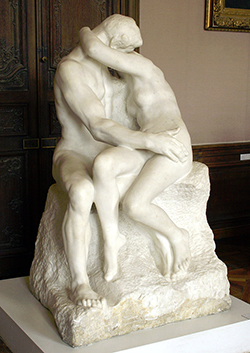 Sculpture by Auguste Rodin: The sculpture, The Kiss, was originally titled Francesca da Rimini, as it depicts the 13th-century Italian noblewoman immortalised in Dante's Inferno (Circle 2, Canto 5) who falls in love with her husband Giovanni Malatesta's younger brother Paolo. Having fallen in love while reading the story of Lancelot and Guinevere, the couple are discovered and killed by Francesca's husband. In the sculpture, the book can be seen in Paolo's hand. The lovers' lips do not actually touch in the sculpture, suggesting that they were interrupted and met their demise without their lips ever having touched. When critics first saw the sculpture in 1887, they suggested the less specific title Le Baiser (The Kiss).
Sculpture by Auguste Rodin: The sculpture, The Kiss, was originally titled Francesca da Rimini, as it depicts the 13th-century Italian noblewoman immortalised in Dante's Inferno (Circle 2, Canto 5) who falls in love with her husband Giovanni Malatesta's younger brother Paolo. Having fallen in love while reading the story of Lancelot and Guinevere, the couple are discovered and killed by Francesca's husband. In the sculpture, the book can be seen in Paolo's hand. The lovers' lips do not actually touch in the sculpture, suggesting that they were interrupted and met their demise without their lips ever having touched. When critics first saw the sculpture in 1887, they suggested the less specific title Le Baiser (The Kiss).
1882
Britain Invades Egypt The British invaded Egypt in response to anti foreign riots. The British defeated the army of Arabi Pasha at Al Tell. On September 15th they captured Cairo. Arabi pasha the nationalist leader was deported to Ceylon.
(no entry for this year)
1883
On October 16, the United States Supreme Court declares invalid the Civil Rights Act of 1875, stating that the federal government cannot bar corporations or individuals from discriminating on the basis of race.
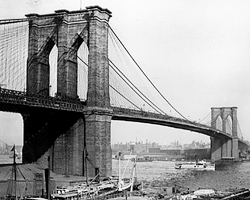 On May 25, the New York boroughs of Manhattan and Brooklyn were linked with the opening of the Brooklyn Bridge. The bridge was the first steel suspension bridge erected in the United States. It was built at a cost of $16 million and 26 lives. When it opened, the Brooklyn Bridge was the longest suspension bridge in the world.
On May 25, the New York boroughs of Manhattan and Brooklyn were linked with the opening of the Brooklyn Bridge. The bridge was the first steel suspension bridge erected in the United States. It was built at a cost of $16 million and 26 lives. When it opened, the Brooklyn Bridge was the longest suspension bridge in the world.
(no entry for this year)
1884
(no entry for this year)
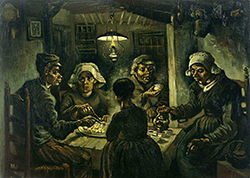 Painting by Vincent van Gogh: The Potato Eaters (Dutch: De Aardappeleters). Van Gogh said he wanted to depict peasants as they really were. He deliberately chose coarse and ugly models, thinking that they would be natural and unspoiled in his finished work: "You see, I really have wanted to make it so that people get the idea that these folk, who are eating their potatoes by the light of their little lamp, have tilled the earth themselves with these hands they are putting in the dish, and so it speaks of manual labor and — that they have thus honestly earned their food. I wanted it to give the idea of a wholly different way of life from ours — civilized people. So I certainly don't want everyone just to admire it or approve of it without knowing why."
Painting by Vincent van Gogh: The Potato Eaters (Dutch: De Aardappeleters). Van Gogh said he wanted to depict peasants as they really were. He deliberately chose coarse and ugly models, thinking that they would be natural and unspoiled in his finished work: "You see, I really have wanted to make it so that people get the idea that these folk, who are eating their potatoes by the light of their little lamp, have tilled the earth themselves with these hands they are putting in the dish, and so it speaks of manual labor and — that they have thus honestly earned their food. I wanted it to give the idea of a wholly different way of life from ours — civilized people. So I certainly don't want everyone just to admire it or approve of it without knowing why."
1885
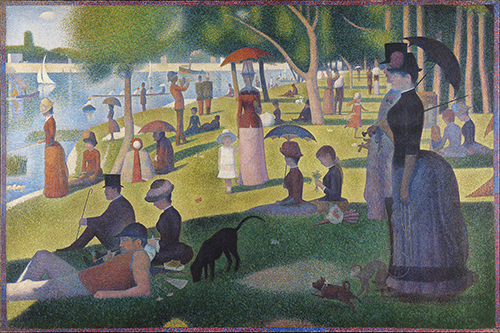 Painting by Georges Seurat: A Sunday Afternoon on the Island of La Grande Jatte (French: Un dimanche après-midi à l'Île de la Grande Jatte) is one of the artist's most famous works. It is a leading example of pointillism technique, executed on a large canvas. Seurat's composition includes a number of Parisians at a park on the banks of the River Seine. Inspired by optical effects and perception inherent in the color theories of Michel Eugène Chevreul, Ogden Rood and others, Seurat adapted this scientific research to his painting. Seurat contrasted miniature dots or small brushstrokes of colors that when unified optically in the human eye were perceived as a single shade or hue. He believed that this form of painting, called divisionism at the time but now known as pointillism, would make the colors more brilliant and powerful than standard brushstrokes.
Painting by Georges Seurat: A Sunday Afternoon on the Island of La Grande Jatte (French: Un dimanche après-midi à l'Île de la Grande Jatte) is one of the artist's most famous works. It is a leading example of pointillism technique, executed on a large canvas. Seurat's composition includes a number of Parisians at a park on the banks of the River Seine. Inspired by optical effects and perception inherent in the color theories of Michel Eugène Chevreul, Ogden Rood and others, Seurat adapted this scientific research to his painting. Seurat contrasted miniature dots or small brushstrokes of colors that when unified optically in the human eye were perceived as a single shade or hue. He believed that this form of painting, called divisionism at the time but now known as pointillism, would make the colors more brilliant and powerful than standard brushstrokes.
1886
Slavery is abolished in Cuba.
Daimler produces his first car.
(no entry for this year)
1887
African-American players are banned from major league baseball.
Slavery is abolished in Brazil
Interstate Commerce Act Passed On February 4, President Cleveland signed into law the first bill regulating the railroads. The act, which called for just and equal rates, also limited pooling (secret pacts between railroads). This measure received broad support in the Congress.
The United States acquires Pearl Harbor, Hawaii, as a coaling station and future naval base.
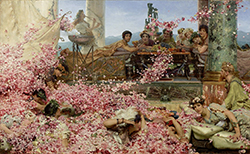 Painting by Sir Lawrence Alma-Tadema: The Roses of Heliogabalus shows a group of Roman diners at a banquet, being swamped by drifts of pink rose petals falling from a false ceiling above. The Roman emperor Elagabalus reclines on a platform behind them, wearing a golden robe and a tiara, watching the spectacle with other garlanded guests. A woman plays the double pipes beside a marble pillar in the background, wearing the leopard skin of a maenad, with a bronze statue of Dionysus, based on the Ludovisi Dionysus, in front of a view of distant hills. The painting depicts a (probably invented) episode in the life of the Roman emperor Elagabalus, also known as Heliogabalus, (204–222), taken from the Augustan History. Although the Latin refers to "violets and other flowers", Alma-Tadema depicts Elagabalus smothering his unsuspecting guests with rose petals released from a false ceiling.
Painting by Sir Lawrence Alma-Tadema: The Roses of Heliogabalus shows a group of Roman diners at a banquet, being swamped by drifts of pink rose petals falling from a false ceiling above. The Roman emperor Elagabalus reclines on a platform behind them, wearing a golden robe and a tiara, watching the spectacle with other garlanded guests. A woman plays the double pipes beside a marble pillar in the background, wearing the leopard skin of a maenad, with a bronze statue of Dionysus, based on the Ludovisi Dionysus, in front of a view of distant hills. The painting depicts a (probably invented) episode in the life of the Roman emperor Elagabalus, also known as Heliogabalus, (204–222), taken from the Augustan History. Although the Latin refers to "violets and other flowers", Alma-Tadema depicts Elagabalus smothering his unsuspecting guests with rose petals released from a false ceiling.
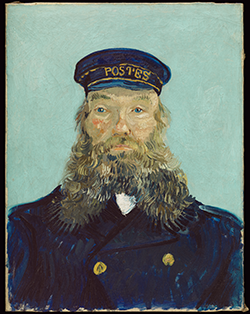 Painting by Vincent Van Gogh: Portrait of Postman Roulin. In February 1888 Van Gogh moved to Arles, in the south of France, and continued to paint landscapes and portraits. Between late July 1888 and April 1889, he painted at least six portraits of Joseph-Etienne Roulin (1841–1903), a postman in Arles. Here, the artist concentrated on Roulin's head, which he described in a letter as "somewhat like Socrates, hardly any nose at all, a high forehead, bald crown, little gray eyes, bright red chubby cheeks, a big pepper-and-salt beard, large eyes."
Painting by Vincent Van Gogh: Portrait of Postman Roulin. In February 1888 Van Gogh moved to Arles, in the south of France, and continued to paint landscapes and portraits. Between late July 1888 and April 1889, he painted at least six portraits of Joseph-Etienne Roulin (1841–1903), a postman in Arles. Here, the artist concentrated on Roulin's head, which he described in a letter as "somewhat like Socrates, hardly any nose at all, a high forehead, bald crown, little gray eyes, bright red chubby cheeks, a big pepper-and-salt beard, large eyes."
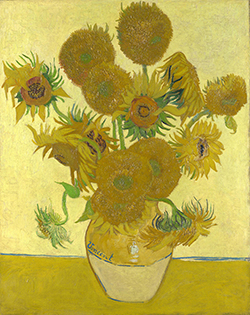 Painting by Vincent van Gogh: Sunflowers (original title, in French: Tournesols). Sunflowers are the subject of two series of still life paintings by the Dutch painter . The earlier series, executed in Paris in 1887, depicts the flowers lying on the ground, while the second set, executed a year later in Arles, shows bouquets of sunflowers in a vase. In the artist's mind both sets were linked by the name of his friend Paul Gauguin, who acquired two of the Paris versions. About eight months later van Gogh hoped to welcome and to impress Gauguin again with Sunflowers, now part of the painted Décoration for the Yellow House that he prepared for the guestroom of his home in Arles, where Gauguin was supposed to stay. After Gauguin's departure, van Gogh imagined the two major versions as wings of the Berceuse Triptych, and finally he included them in his Les XX in Bruxelles exhibit
Painting by Vincent van Gogh: Sunflowers (original title, in French: Tournesols). Sunflowers are the subject of two series of still life paintings by the Dutch painter . The earlier series, executed in Paris in 1887, depicts the flowers lying on the ground, while the second set, executed a year later in Arles, shows bouquets of sunflowers in a vase. In the artist's mind both sets were linked by the name of his friend Paul Gauguin, who acquired two of the Paris versions. About eight months later van Gogh hoped to welcome and to impress Gauguin again with Sunflowers, now part of the painted Décoration for the Yellow House that he prepared for the guestroom of his home in Arles, where Gauguin was supposed to stay. After Gauguin's departure, van Gogh imagined the two major versions as wings of the Berceuse Triptych, and finally he included them in his Les XX in Bruxelles exhibit
1888
 George Eastman Patents Camera George Eastman patents the hand held camera.
George Eastman Patents Camera George Eastman patents the hand held camera.
Slavery is abolished in Brazil, bringing to an end of the legal sanction of slavery in the Americas.
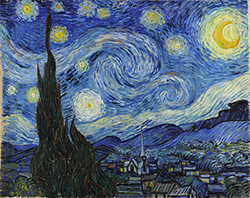 Painting by Vincent van Gogh: The Starry Night depicts the view from the east-facing window of his asylum room at Saint-Rémy-de-Provence, just before sunrise, with the addition of an idealized village. It is regarded as among Van Gogh's finest works, and is one of the most recognized paintings in the history of Western culture. In the aftermath of the 23 December 1888 breakdown that resulted in the self-mutilation of his left ear, Van Gogh voluntarily admitted himself to the Saint-Paul-de-Mausole lunatic asylum on 8 May 1889. Housed in a former monastery, Saint-Paul-de-Mausole catered to the wealthy and was less than half full when Van Gogh arrived, allowing him to occupy not only a second-story bedroom but also a ground-floor room for use as a painting studio.
Painting by Vincent van Gogh: The Starry Night depicts the view from the east-facing window of his asylum room at Saint-Rémy-de-Provence, just before sunrise, with the addition of an idealized village. It is regarded as among Van Gogh's finest works, and is one of the most recognized paintings in the history of Western culture. In the aftermath of the 23 December 1888 breakdown that resulted in the self-mutilation of his left ear, Van Gogh voluntarily admitted himself to the Saint-Paul-de-Mausole lunatic asylum on 8 May 1889. Housed in a former monastery, Saint-Paul-de-Mausole catered to the wealthy and was less than half full when Van Gogh arrived, allowing him to occupy not only a second-story bedroom but also a ground-floor room for use as a painting studio.
1889
Florida becomes the first state to use the poll tax to disenfranchise black voters.
 Frederick Douglass is appointed minister to Haiti.
Frederick Douglass is appointed minister to Haiti.
 Benjamin Harrison becomes twenty-third president of the United States.
Benjamin Harrison becomes twenty-third president of the United States.
Oklahoma Land Rush The last major unsettled territory in the United States (which had been exclusively Indian) is opened for settlement. Over 200,000 settlers gather at the borders of the territory awaiting the opportunity to seize land. On the first day the territory was opened, 12,000 settlers arrived in Guthrie, Oklahoma.
(no entry for this year)
1890
 About 60 common starlings are released into New York's Central Park by Eugene Schieffelin, as part of an effort to introduce every bird species mentioned in the works of William Shakespeare into North America. The original 60 birds have since swelled in number to 150 million, occupying an area extending from southern Canada and Alaska to Central America.
About 60 common starlings are released into New York's Central Park by Eugene Schieffelin, as part of an effort to introduce every bird species mentioned in the works of William Shakespeare into North America. The original 60 birds have since swelled in number to 150 million, occupying an area extending from southern Canada and Alaska to Central America.
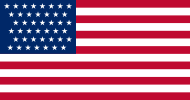 The US flag is modified to have forty-three stars, reflecting the addition of five new states: Idaho, Montana, North Dakota, South Dakota, and Washington.
The US flag is modified to have forty-three stars, reflecting the addition of five new states: Idaho, Montana, North Dakota, South Dakota, and Washington.
The United States Army massacres 200 Indians at Wounded Knee in South Dakota, ending the Indian wars of resistance.
(no entry for this year)
1891
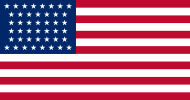 The US flag is modified to have forty-four stars, reflecting the addition of one new state: Wyoming.
The US flag is modified to have forty-four stars, reflecting the addition of one new state: Wyoming.
The first basketball game is played, in Springfield, Massachusetts.
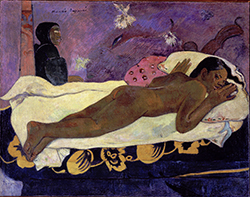 Painting by Paul Gauguin: Spirit of the Dead Watching (Manao tupapau) is an oil on burlap canvas depicting a naked Tahitian girl lying on her stomach. An old woman is seated behind her. Gauguin said the title may refer to either the girl imagining the ghost, or the ghost imagining her. The subject of the painting is Gauguin's young native wife Teha'amana (called Tehura in his letters), who one night, according to Gauguin, was lying in fear when he arrived home late: " ... motionless, naked, belly down on the bed: she stared up at me, her eyes wide with fear, '... Perhaps she took me, with my anguished face, for one of those legendary demons or specters, the Tupapaus that filled the sleepless nights of her people."
Painting by Paul Gauguin: Spirit of the Dead Watching (Manao tupapau) is an oil on burlap canvas depicting a naked Tahitian girl lying on her stomach. An old woman is seated behind her. Gauguin said the title may refer to either the girl imagining the ghost, or the ghost imagining her. The subject of the painting is Gauguin's young native wife Teha'amana (called Tehura in his letters), who one night, according to Gauguin, was lying in fear when he arrived home late: " ... motionless, naked, belly down on the bed: she stared up at me, her eyes wide with fear, '... Perhaps she took me, with my anguished face, for one of those legendary demons or specters, the Tupapaus that filled the sleepless nights of her people."
1892
A record 230 people are lynched in the United States this year; 161 are black and 69 white.
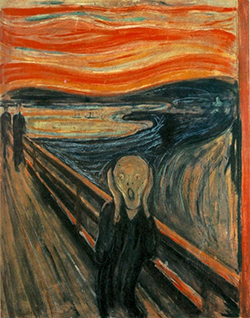 Painting by Edvard Munch: The Scream (Norwegian: Skrik). The same title — The Scream — is the popular name given to each of four versions of a composition, created as both paintings and pastels, by Norwegian Expressionist artist between 1893 and 1910. The German title Munch gave these works is Der Schrei der Natur (The Scream of Nature). The works show a figure with an agonized expression against a landscape with a tumultuous orange sky. Arthur Lubow has described The Scream as "an icon of modern art, a Mona Lisa for our time." Edvard Munch created the four versions in various media. The National Gallery in Oslo, Norway, holds one of two painted versions (1893, shown here). The Munch Museum holds the other painted version and a pastel version from 1893. The fourth version (pastel, 1895) was sold for $119,922,600 at Sotheby's Impressionist and Modern Art auction on 2 May 2012 to financier Leon Black, the fourth highest nominal price paid for a painting at auction. The painting was on display in the Museum of Modern Art in New York from October 2012 to April 2013.
Painting by Edvard Munch: The Scream (Norwegian: Skrik). The same title — The Scream — is the popular name given to each of four versions of a composition, created as both paintings and pastels, by Norwegian Expressionist artist between 1893 and 1910. The German title Munch gave these works is Der Schrei der Natur (The Scream of Nature). The works show a figure with an agonized expression against a landscape with a tumultuous orange sky. Arthur Lubow has described The Scream as "an icon of modern art, a Mona Lisa for our time." Edvard Munch created the four versions in various media. The National Gallery in Oslo, Norway, holds one of two painted versions (1893, shown here). The Munch Museum holds the other painted version and a pastel version from 1893. The fourth version (pastel, 1895) was sold for $119,922,600 at Sotheby's Impressionist and Modern Art auction on 2 May 2012 to financier Leon Black, the fourth highest nominal price paid for a painting at auction. The painting was on display in the Museum of Modern Art in New York from October 2012 to April 2013.
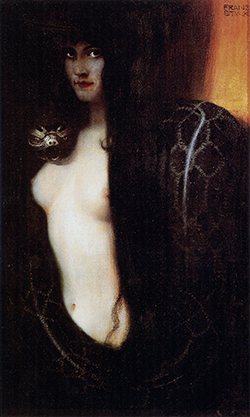 Painting by Franz Stuck: The Sin (German: Die Sünde) depicts the nude Eve with a big serpent wrapped around her body. In the upper right corner is a bright field, while the rest of the surroundings are dark. The motif was conceived as a development of Stuck's 1889 painting Sensuality (Die Sinnlichkeit). The Sin was first exhibited in 1893, at the inaugural exhibition of the Munich Secession, where it caused a sensation. It was bought by the Neue Pinakothek in Munich and became a critical and commercial breakthrough for Stuck. It has since become an emblematic painting for the symbolist movement. Stuck made twelve known versions of the painting. Some of these can be viewed at the Neue Pinakothek in Munich, the National Gallery in Berlin, the Galleria di arte Moderna in Palermo, the Frye Art Museum in Seattle, and at the Villa Stuck in Munich, where it is enshrined in the artist's Künstleraltar.
Painting by Franz Stuck: The Sin (German: Die Sünde) depicts the nude Eve with a big serpent wrapped around her body. In the upper right corner is a bright field, while the rest of the surroundings are dark. The motif was conceived as a development of Stuck's 1889 painting Sensuality (Die Sinnlichkeit). The Sin was first exhibited in 1893, at the inaugural exhibition of the Munich Secession, where it caused a sensation. It was bought by the Neue Pinakothek in Munich and became a critical and commercial breakthrough for Stuck. It has since become an emblematic painting for the symbolist movement. Stuck made twelve known versions of the painting. Some of these can be viewed at the Neue Pinakothek in Munich, the National Gallery in Berlin, the Galleria di arte Moderna in Palermo, the Frye Art Museum in Seattle, and at the Villa Stuck in Munich, where it is enshrined in the artist's Künstleraltar.
1893
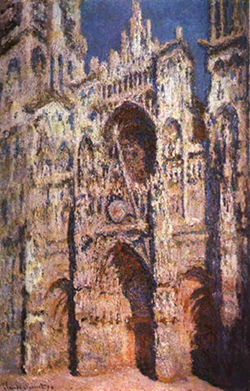 Painting by Claude Monet: The Rouen Cathedral, Full Sunlight was one of a series, with each painting in the series intended to capture the facade of the Rouen Cathedral at different times of the day and year, reflecting changes in its appearance under different lighting conditions. The Rouen Cathedral paintings, more than thirty in all, were made in 1892 and 1893, then reworked in Monet's studio in 1894. Monet rented spaces across the street from the cathedral, where he set up temporary studios for the purpose. In 1895, he selected what he considered to be the twenty best paintings from the series for display at his Paris dealer's gallery, and of these he sold eight before the exhibition was over. Pissarro and Cézanne visited the exhibition and praised the series highly. When Monet painted the Rouen Cathedral series, he had long since been impressed with the way light imparts to a subject a distinctly different character at different times of the day and the year, and as atmospheric conditions change. For Monet, the effects of light on a subject became as important as the subject itself.
Painting by Claude Monet: The Rouen Cathedral, Full Sunlight was one of a series, with each painting in the series intended to capture the facade of the Rouen Cathedral at different times of the day and year, reflecting changes in its appearance under different lighting conditions. The Rouen Cathedral paintings, more than thirty in all, were made in 1892 and 1893, then reworked in Monet's studio in 1894. Monet rented spaces across the street from the cathedral, where he set up temporary studios for the purpose. In 1895, he selected what he considered to be the twenty best paintings from the series for display at his Paris dealer's gallery, and of these he sold eight before the exhibition was over. Pissarro and Cézanne visited the exhibition and praised the series highly. When Monet painted the Rouen Cathedral series, he had long since been impressed with the way light imparts to a subject a distinctly different character at different times of the day and the year, and as atmospheric conditions change. For Monet, the effects of light on a subject became as important as the subject itself.
1894
(no entry for this year)
(no entry for this year)
1895
The Lumiere Brothers introduce moving pictures.
The Sino-Japanese War ends and Japan gains dominance over Korea and Taiwan.
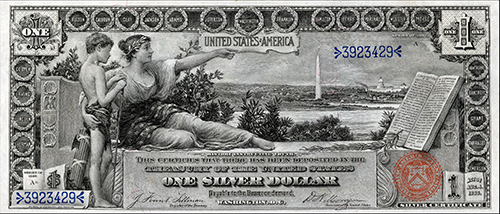 Currency as Art: United States, Educational Series, One Dollar Bill. "Educational Series" is the informal name used by numismatists to refer to a series of United States silver certificates produced by the U.S. Treasury in 1896. The One Dollar bill shows a personification of History instructing a youth, pointing to a panoramic view of the Potomac River and Washington, D.C. The Washington Monument and the Capitol are visible in the background. The United States Constitution is displayed to the right. Circling the motif are the last names of famous Americans.
Currency as Art: United States, Educational Series, One Dollar Bill. "Educational Series" is the informal name used by numismatists to refer to a series of United States silver certificates produced by the U.S. Treasury in 1896. The One Dollar bill shows a personification of History instructing a youth, pointing to a panoramic view of the Potomac River and Washington, D.C. The Washington Monument and the Capitol are visible in the background. The United States Constitution is displayed to the right. Circling the motif are the last names of famous Americans.
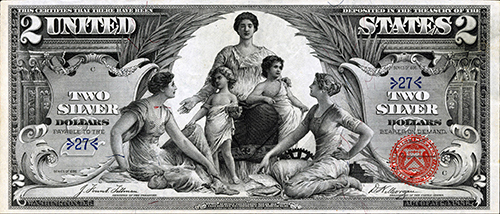 Currency as Art: United States, Educational Series, Two Dollar Bill. "Educational Series" is the informal name used by numismatists to refer to a series of United States silver certificates produced by the U.S. Treasury in 1896. The Two Dollar bill shows Science (center) presenting the two children, Steam and Electricity, to the more mature figures of Commerce (left) and Manufacture (right).
Currency as Art: United States, Educational Series, Two Dollar Bill. "Educational Series" is the informal name used by numismatists to refer to a series of United States silver certificates produced by the U.S. Treasury in 1896. The Two Dollar bill shows Science (center) presenting the two children, Steam and Electricity, to the more mature figures of Commerce (left) and Manufacture (right).
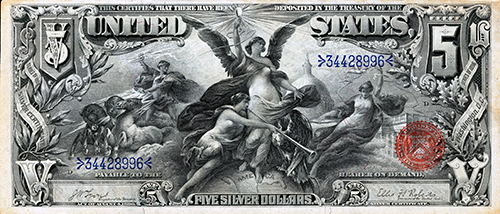 Currency as Art: United States, Educational Series, Five Dollar Bill. "Educational Series" is the informal name used by numismatists to refer to a series of United States silver certificates produced by the U.S. Treasury in 1896. The Five Dollar bill shows Electricity surrounded by other allegorical figures, representing the dominant force in the world. The United States Capitol building can be seen behind the female figures. The naked breasts of the female figures on the $5 silver certificate reportedly caused some minor controversy when several Boston society ladies took offense to the design. Some bankers reportedly refused to accept the notes in transactions, and the term "banned in Boston" allegedly originates from the $5 silver certificate.
Currency as Art: United States, Educational Series, Five Dollar Bill. "Educational Series" is the informal name used by numismatists to refer to a series of United States silver certificates produced by the U.S. Treasury in 1896. The Five Dollar bill shows Electricity surrounded by other allegorical figures, representing the dominant force in the world. The United States Capitol building can be seen behind the female figures. The naked breasts of the female figures on the $5 silver certificate reportedly caused some minor controversy when several Boston society ladies took offense to the design. Some bankers reportedly refused to accept the notes in transactions, and the term "banned in Boston" allegedly originates from the $5 silver certificate.
The first Sunday newspaper comics appear.
1896
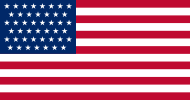 The US flag is modified to have forty-five stars, reflecting the addition of one new state: Utah.
The US flag is modified to have forty-five stars, reflecting the addition of one new state: Utah.
In Plessy vs. Ferguson, the United States Supreme Court declares legalized segregation in the United States to be constitutional.
 The will of Alfred Nobel establishes annual prizes for peace, science, and literature.
The will of Alfred Nobel establishes annual prizes for peace, science, and literature.
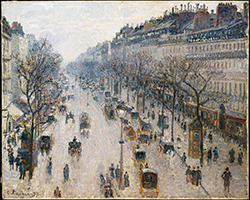 Painting by : The Boulevard Montmartre on a Winter Morning. In the late 1890s, Pissarro painted a series of works depicting the boulevards, as seen from his windows, at various times of year.
Painting by : The Boulevard Montmartre on a Winter Morning. In the late 1890s, Pissarro painted a series of works depicting the boulevards, as seen from his windows, at various times of year.
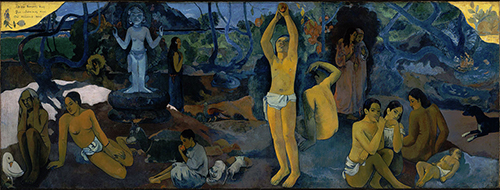 Painting by Paul Gauguin: Where Do We Come From? What Are We? Where Are We Going?. Gauguin inscribed the original French title in the upper left corner: D'où Venons Nous / Que Sommes Nous / Où Allons Nous. The inscription the artist wrote on his canvas has no question mark, no dash, and all words are capitalized. In the upper right corner he signed and dated the painting: P. Gauguin / 1897. The painting was created in Tahiti, and is in the Museum of Fine Arts in Boston, Massachusetts, USA. Gauguin had been a student at the Petit Séminaire de La Chapelle-Saint-Mesmin, just outside Orléans, from the age of eleven to the age of sixteen. His subjects there included a class in Catholic liturgy; the teacher for this class was the Bishop of Orléans, Félix-Antoine-Philibert Dupanloup. Dupanloup had devised his own catechism to be lodged in the minds of the young schoolboys, and to lead them towards proper spiritual reflections on the nature of life. The three fundamental questions in this catechism were: "Where does humanity come from?" "Where is it going to?", "How does humanity proceed?". Although in later life Gauguin was vociferously anticlerical, these questions from Dupanloup's catechism obviously had lodged in his mind, and "where?" became the key question that Gauguin asked in his art.
Painting by Paul Gauguin: Where Do We Come From? What Are We? Where Are We Going?. Gauguin inscribed the original French title in the upper left corner: D'où Venons Nous / Que Sommes Nous / Où Allons Nous. The inscription the artist wrote on his canvas has no question mark, no dash, and all words are capitalized. In the upper right corner he signed and dated the painting: P. Gauguin / 1897. The painting was created in Tahiti, and is in the Museum of Fine Arts in Boston, Massachusetts, USA. Gauguin had been a student at the Petit Séminaire de La Chapelle-Saint-Mesmin, just outside Orléans, from the age of eleven to the age of sixteen. His subjects there included a class in Catholic liturgy; the teacher for this class was the Bishop of Orléans, Félix-Antoine-Philibert Dupanloup. Dupanloup had devised his own catechism to be lodged in the minds of the young schoolboys, and to lead them towards proper spiritual reflections on the nature of life. The three fundamental questions in this catechism were: "Where does humanity come from?" "Where is it going to?", "How does humanity proceed?". Although in later life Gauguin was vociferously anticlerical, these questions from Dupanloup's catechism obviously had lodged in his mind, and "where?" became the key question that Gauguin asked in his art.
1897
 William McKinley becomes twenty-fifth president of the United States. McKinley was the last veteran of the Civil war to serve as President. He enlisted as a private in the 23rd Ohio Infantry, and by the end of the war he had been promoted several times, finally leaving the service with the rank of Captain.
William McKinley becomes twenty-fifth president of the United States. McKinley was the last veteran of the Civil war to serve as President. He enlisted as a private in the 23rd Ohio Infantry, and by the end of the war he had been promoted several times, finally leaving the service with the rank of Captain.
 Zionist activity begins in the Middle East, under the World Zionist Congress called by Theodore Herzl.
Zionist activity begins in the Middle East, under the World Zionist Congress called by Theodore Herzl.
(no entry for this year)
1898
The United States Supreme Court, in Williams vs. Mississippi, rules that poll taxes and literacy tests do not violate the Constitution.
United States invades Cuba and defeats Spain in the Spanish-American War.
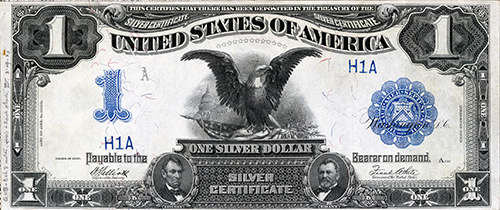 Currency as Art: The Black Eagle one-dollar silver certificate produced in 1899 in the United States. The note measured 7.38 × 3.18 in and featured a bald eagle with its wings spread. The note was also referred to as "Eagle of the Capitol", because the United States Capitol is visible behind the eagle. The note was issued from 1899 to 1923 and the Bureau of Engraving and Printing (BEP) printed 3,604,239,600 Black Eagles. The 1899 series replaced the 1896 Educational Series notes. One reason for the redesign was to make counterfeiting more difficult.
Currency as Art: The Black Eagle one-dollar silver certificate produced in 1899 in the United States. The note measured 7.38 × 3.18 in and featured a bald eagle with its wings spread. The note was also referred to as "Eagle of the Capitol", because the United States Capitol is visible behind the eagle. The note was issued from 1899 to 1923 and the Bureau of Engraving and Printing (BEP) printed 3,604,239,600 Black Eagles. The 1899 series replaced the 1896 Educational Series notes. One reason for the redesign was to make counterfeiting more difficult.
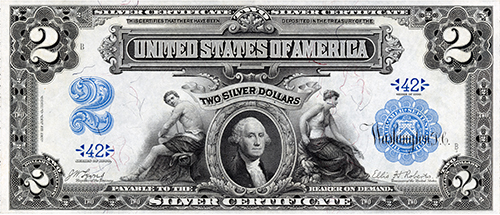 Currency as Art: In 1899, the US two-dollar Silver Certificate was redesigned with a small portrait of George Washington surrounded by allegorical figures representing agriculture and mechanics.
Currency as Art: In 1899, the US two-dollar Silver Certificate was redesigned with a small portrait of George Washington surrounded by allegorical figures representing agriculture and mechanics.
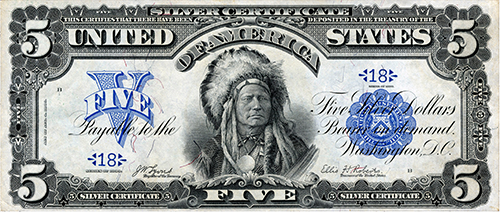 Currency as Art: The 1899 United States five-dollar Silver Certificate is known as the Indian Chief Note note. The note features Sioux chief Running Antelope. It is the only US federal paper currency featuring a named Native American. G.F.C. Smillie of the U.S. Bureau of Engraving and Printing (BEP) engraved the portrait of Running Antelope of the Hunkpapa Sioux which is found on this five-dollar Silver Certificate. During the photoshoot Running Antelope wore his three-feathered headdress but when engraving for the note, his headdress did not fit in the space of the 1899 five-dollar Silver Certificate. Smillie found an image of a feathered-War bonnet that was likely Pawnee and he used it in the engraving. Because of the incorrect headdress, the engraved portrait was controversial. The Sioux were enemies of the Pawnee so the depiction of a Sioux chief with his enemies war bonnet became a controversy.
Currency as Art: The 1899 United States five-dollar Silver Certificate is known as the Indian Chief Note note. The note features Sioux chief Running Antelope. It is the only US federal paper currency featuring a named Native American. G.F.C. Smillie of the U.S. Bureau of Engraving and Printing (BEP) engraved the portrait of Running Antelope of the Hunkpapa Sioux which is found on this five-dollar Silver Certificate. During the photoshoot Running Antelope wore his three-feathered headdress but when engraving for the note, his headdress did not fit in the space of the 1899 five-dollar Silver Certificate. Smillie found an image of a feathered-War bonnet that was likely Pawnee and he used it in the engraving. Because of the incorrect headdress, the engraved portrait was controversial. The Sioux were enemies of the Pawnee so the depiction of a Sioux chief with his enemies war bonnet became a controversy.
1899
The Boer war breaks out between Afrikaners and the British in southern Africa.
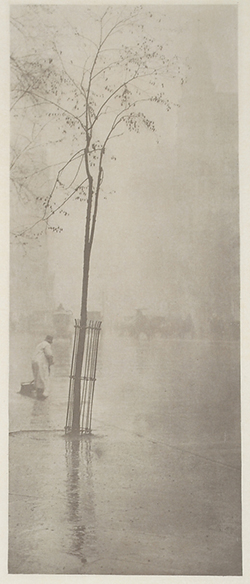 Photograph by Alfred Stieglitz: Spring Showers, The Street Cleaner.
Photograph by Alfred Stieglitz: Spring Showers, The Street Cleaner.
1900
 Booker T. Washington publishes Up from Slavery, his autobiography.
Booker T. Washington publishes Up from Slavery, his autobiography.
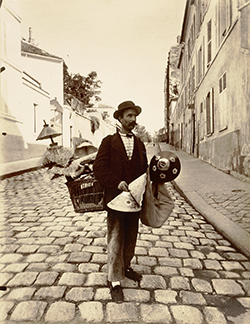 Eug ne Atget: Marchand d'Abat-Jours, an albumen silver print, now in the J. Paul Getty Museum.
Eug ne Atget: Marchand d'Abat-Jours, an albumen silver print, now in the J. Paul Getty Museum.
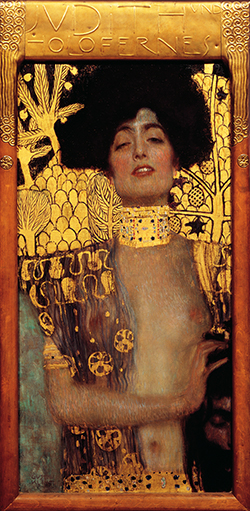 Painting by Gustav Klimt: Judith and the Head of Holofernes (also known as Judith I) depicts the biblical character of Judith holding the severed head of Holofernes. Judith I reveals a curious symbolic and compositional consonance with The Sin by Franz Stuck: the temptation illustrated by the German painter becomes the model for Klimt's femme fatale by suggesting the posture of the disrobed and evanescent body as focal piece of the canvas, as well as the facial set. Judith's force originates from the close-up and the solidity of posture, rendered by the orthogonal projection of lines: to the body's verticality (and that of Holofernes') corresponds to the horizontal parallels in the lower margin: those of the arm, the shoulders joined by the collier, and finally the hair base.
Painting by Gustav Klimt: Judith and the Head of Holofernes (also known as Judith I) depicts the biblical character of Judith holding the severed head of Holofernes. Judith I reveals a curious symbolic and compositional consonance with The Sin by Franz Stuck: the temptation illustrated by the German painter becomes the model for Klimt's femme fatale by suggesting the posture of the disrobed and evanescent body as focal piece of the canvas, as well as the facial set. Judith's force originates from the close-up and the solidity of posture, rendered by the orthogonal projection of lines: to the body's verticality (and that of Holofernes') corresponds to the horizontal parallels in the lower margin: those of the arm, the shoulders joined by the collier, and finally the hair base.
1901
 Theodore Roosevelt becomes twenty-sixth president of the United States.
Theodore Roosevelt becomes twenty-sixth president of the United States.
 Queen Victoria dies and is succeeded by her son, Edward VII.
Queen Victoria dies and is succeeded by her son, Edward VII.
1902
(no entry for this year)
 Richard Steiff designs the first teddy bears, named after Pres. Teddy Roosevelt.
Richard Steiff designs the first teddy bears, named after Pres. Teddy Roosevelt.
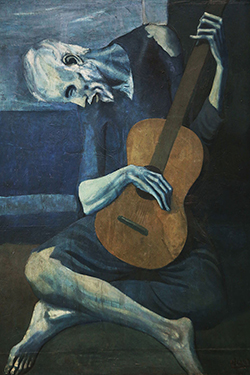 Painting by Pablo Picasso: The Old Guitarist depicts an old, blind, haggard man with threadbare clothing weakly hunched over his guitar, playing in the streets of Barcelona, Spain. It is currently on display in the Art Institute of Chicago as part of the Helen Birch Bartlett Memorial Collection. At the time of The Old Guitarist's creation, Modernism, Impressionism, Post-Impressionism, and Symbolism had merged and created an overall movement called Expressionism which greatly influenced Picasso's style. Furthermore, El Greco, Picasso's poor standard of living, and the suicide of a dear friend influenced Picasso's style at the time which came to be known as his Blue Period. In the early 1960s, nearly forty percent of all college dorm rooms had a poster of this painting on the wall.
Painting by Pablo Picasso: The Old Guitarist depicts an old, blind, haggard man with threadbare clothing weakly hunched over his guitar, playing in the streets of Barcelona, Spain. It is currently on display in the Art Institute of Chicago as part of the Helen Birch Bartlett Memorial Collection. At the time of The Old Guitarist's creation, Modernism, Impressionism, Post-Impressionism, and Symbolism had merged and created an overall movement called Expressionism which greatly influenced Picasso's style. Furthermore, El Greco, Picasso's poor standard of living, and the suicide of a dear friend influenced Picasso's style at the time which came to be known as his Blue Period. In the early 1960s, nearly forty percent of all college dorm rooms had a poster of this painting on the wall.
1903
 W. E. B. Du Bois' The Souls of Black Folk is published on April 27. Du Bois rejects the gradualism of Booker T. Washington and calls for agitation on behalf of African-American rights.
W. E. B. Du Bois' The Souls of Black Folk is published on April 27. Du Bois rejects the gradualism of Booker T. Washington and calls for agitation on behalf of African-American rights.
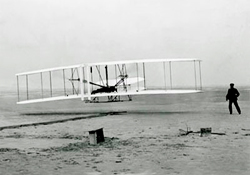 Orville and Wilbur Wright succeed with the first controlled flight in a heavier-than-air machine.
Orville and Wilbur Wright succeed with the first controlled flight in a heavier-than-air machine.
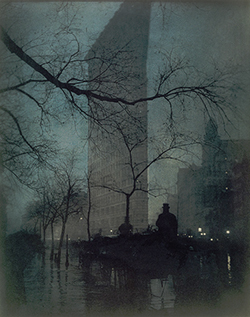 Photograph by Edward Steichen: The Flatiron Building depicts the recently erected Flatiron Building in New York, taking inspiration from fellow photographers like Alfred Stieglitz, who had just photographed the building a year prior. The original negative was made in 1904 and spawned three platinum-gum exhibition prints in brown (1905), blue-green (1909), and yellow-green-black (1904–1909; uncertain).  Using different proportions of pigments in each gum process, Steichen was able to create these three unique platinum-gum prints. The photograph's most notable variant is the blue-green version, which, according to Penelope Niven, became "widely reproduced from 1909 onward" because of its intense color contrasts. The significance of the prints as a whole comes from how they showcase what Niven refers to as the "artistic potential" of photography. The work is one of the best-known photographs of Steichen's Pictorialist phase.
Photograph by Edward Steichen: The Flatiron Building depicts the recently erected Flatiron Building in New York, taking inspiration from fellow photographers like Alfred Stieglitz, who had just photographed the building a year prior. The original negative was made in 1904 and spawned three platinum-gum exhibition prints in brown (1905), blue-green (1909), and yellow-green-black (1904–1909; uncertain).  Using different proportions of pigments in each gum process, Steichen was able to create these three unique platinum-gum prints. The photograph's most notable variant is the blue-green version, which, according to Penelope Niven, became "widely reproduced from 1909 onward" because of its intense color contrasts. The significance of the prints as a whole comes from how they showcase what Niven refers to as the "artistic potential" of photography. The work is one of the best-known photographs of Steichen's Pictorialist phase.
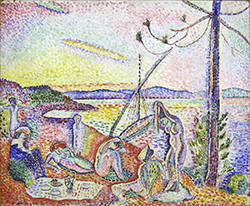 Painting by Henri Matisse: Luxe, Calme et Volupt is an oil painting by the French artist Henri Matisse. Both foundational in the oeuvre of Matisse and a pivotal work in the history of art, Luxe, Calme et Volupt is considered the starting point of Fauvism. Luxe, Calme et Volupt was painted by artist called Matisse in 1904, after a summer spent working in St. Tropez on the French Riviera alongside the neo-Impressionist painters Paul Signac and Henri-Edmond Cross. The painting is Matisse's most important work in which he used the Divisionist technique advocated by Signac.
Painting by Henri Matisse: Luxe, Calme et Volupt is an oil painting by the French artist Henri Matisse. Both foundational in the oeuvre of Matisse and a pivotal work in the history of art, Luxe, Calme et Volupt is considered the starting point of Fauvism. Luxe, Calme et Volupt was painted by artist called Matisse in 1904, after a summer spent working in St. Tropez on the French Riviera alongside the neo-Impressionist painters Paul Signac and Henri-Edmond Cross. The painting is Matisse's most important work in which he used the Divisionist technique advocated by Signac.
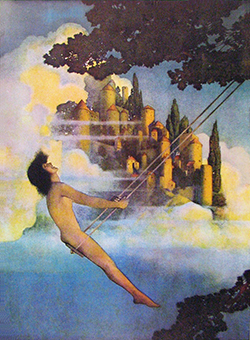 Painting by Maxfield Parrish: The Dinky Bird, an illustration from Poems of Childhood exemplifies Parrish's characteristic use of androgynous figures. To a modern eye, Parrish's early work — characterized by himself as "girls on rocks" — may bring to mind the words kitsch or schlock or schmaltz or maudlin, but to many who were enduring the Great Depression or World War II, his images, like Busby Berkeley musicals, inspired a bit of hope — an imagining that things did not always have to be this bad. During those hard times, many a lower middle class American living room had one or more cheap Parrish prints, sometimes just a page from a magazine, adorning the wall.
Painting by Maxfield Parrish: The Dinky Bird, an illustration from Poems of Childhood exemplifies Parrish's characteristic use of androgynous figures. To a modern eye, Parrish's early work — characterized by himself as "girls on rocks" — may bring to mind the words kitsch or schlock or schmaltz or maudlin, but to many who were enduring the Great Depression or World War II, his images, like Busby Berkeley musicals, inspired a bit of hope — an imagining that things did not always have to be this bad. During those hard times, many a lower middle class American living room had one or more cheap Parrish prints, sometimes just a page from a magazine, adorning the wall.
1904
The Russo-Japanese war begins with a surprise attack by the Imperial Japanese Navy against the Russian far East Fleet, while it was at anchor at Port Arthur.
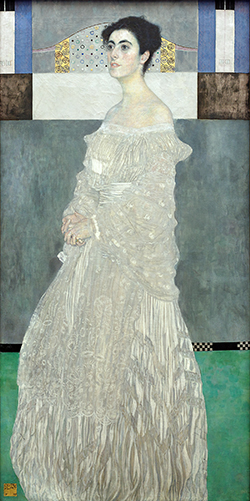 Painting by Gustav Klimt: Margaret "Gretl" Stonborough-Wittgenstein. Stonborough-Wittgenstein, a member of the prominent and wealthy Viennese Wittgenstein family, was a sister of the philosopher Ludwig Wittgenstein and the pianist Paul Wittgenstein. She was the subject of a portrait painted for her wedding by the artist Gustav Klimt (Stonborough-Wittgenstein and other members of the Wittgenstein family were among Klimt's most important patrons), which was sold in 1960 by her son Thomas and may now be seen in the Neue Pinakothek gallery in Munich. Aside: The painting appears briefly behind Ava, an AI robot, in the film Ex Machina (a film that is an excellent exploration of artificial intelligence, the nature of consciousness, and passing a Turing Test).
Painting by Gustav Klimt: Margaret "Gretl" Stonborough-Wittgenstein. Stonborough-Wittgenstein, a member of the prominent and wealthy Viennese Wittgenstein family, was a sister of the philosopher Ludwig Wittgenstein and the pianist Paul Wittgenstein. She was the subject of a portrait painted for her wedding by the artist Gustav Klimt (Stonborough-Wittgenstein and other members of the Wittgenstein family were among Klimt's most important patrons), which was sold in 1960 by her son Thomas and may now be seen in the Neue Pinakothek gallery in Munich. Aside: The painting appears briefly behind Ava, an AI robot, in the film Ex Machina (a film that is an excellent exploration of artificial intelligence, the nature of consciousness, and passing a Turing Test).
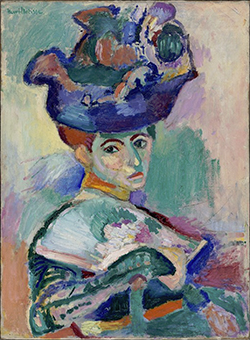 Painting by Henri Matisse: Woman with a Hat (La femme au chapeau) depicts Matisse's wife, Amelie. It was painted in 1905 and exhibited at the Salon d'Automne during the fall of the same year, along with works by André Derain, Maurice de Vlaminck and several other artists known as "Fauves". Woman with a Hat was at the center of the controversy that led to the term Fauvism. It was also a painting that marked a stylistic shift in the work of Matisse from the Divisionist brushstrokes of his earlier work to a more expressive style. Its loose brushwork and "unfinished" quality shocking viewers as much as its vivid, non-naturalistic colors. Although the Fauve works on display were condemned by many — "A pot of paint has been flung in the face of the public", declared the critic Camille Mauclair — they also gained some favorable attention. The painting that was singled out for attacks was Matisse's Woman with a Hat.
Painting by Henri Matisse: Woman with a Hat (La femme au chapeau) depicts Matisse's wife, Amelie. It was painted in 1905 and exhibited at the Salon d'Automne during the fall of the same year, along with works by André Derain, Maurice de Vlaminck and several other artists known as "Fauves". Woman with a Hat was at the center of the controversy that led to the term Fauvism. It was also a painting that marked a stylistic shift in the work of Matisse from the Divisionist brushstrokes of his earlier work to a more expressive style. Its loose brushwork and "unfinished" quality shocking viewers as much as its vivid, non-naturalistic colors. Although the Fauve works on display were condemned by many — "A pot of paint has been flung in the face of the public", declared the critic Camille Mauclair — they also gained some favorable attention. The painting that was singled out for attacks was Matisse's Woman with a Hat.
1905
 An obscure Swiss patent clerk, Albert Einstein, formulates the special theory of relativity and ushers in the atomic age.
An obscure Swiss patent clerk, Albert Einstein, formulates the special theory of relativity and ushers in the atomic age.
The National Forest Service is established in the United States by Gifford Pinchot.
 Upton Sinclair publishes The Jungle.
Upton Sinclair publishes The Jungle.
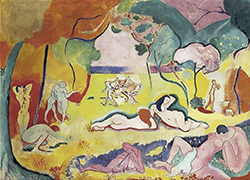 painting by Henri Matisse: Le bonheur de vivre (The Joy of Life) is (along with Picasso's Les Demoiselles d'Avignon) regarded as one of the pillars of early modernism. The monumental canvas was first exhibited at the Salon des Indépendants of 1906, where its cadmium colors and spatial distortions caused a public expression of protest and outrage. "The work is known to have invigorated fellow artists, especially Pablo Picasso, who, in an effort to outdo Matisse in terms of shock value, immediately began work on his watershed Les Demoiselles D'Avignon," writes Martha Lucy, associate curator at the Barnes Foundation.
painting by Henri Matisse: Le bonheur de vivre (The Joy of Life) is (along with Picasso's Les Demoiselles d'Avignon) regarded as one of the pillars of early modernism. The monumental canvas was first exhibited at the Salon des Indépendants of 1906, where its cadmium colors and spatial distortions caused a public expression of protest and outrage. "The work is known to have invigorated fellow artists, especially Pablo Picasso, who, in an effort to outdo Matisse in terms of shock value, immediately began work on his watershed Les Demoiselles D'Avignon," writes Martha Lucy, associate curator at the Barnes Foundation.
1906
 An All-India Muslim League is founded by Sultan Mahommed Shah, Aga Khan III.
An All-India Muslim League is founded by Sultan Mahommed Shah, Aga Khan III.
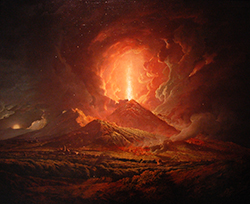 Mount Vesuvius erupts, devastating the town of Ottaiano, Italy
Mount Vesuvius erupts, devastating the town of Ottaiano, Italy
The Great San Francisco Earthquake kills seven hundred people and causes more than $400 million in property losses.
The world's largest battleship — the Satsuma — is launched in Japan.
Kenneth Grahame publishes The Wind in the Willows.
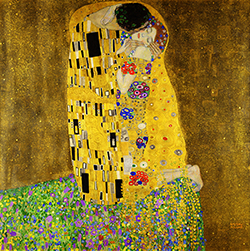 Painting by Gustav Klimt : The Kiss (Lovers) was painted by the Austrian Symbolist painter Gustav Klimt between 1907 and 1908, the highpoint of his "Golden Period", when he painted a number of works in a similar gilded style. A perfect square, the canvas depicts a couple embracing, their bodies entwined in elaborate robes decorated in a style influenced by both linear constructs of the contemporary Art Nouveau style and the organic forms of the earlier Arts and Crafts movement. The work is composed of oil paint with applied layers of gold leaf, an aspect that gives it its strikingly modern, yet evocative appearance. The painting is now in the sterreichische Galerie Belvedere museum in the Belvedere palace, Vienna, and is widely considered a masterpiece of the early modern period. It is a symbol of Vienna Jugendstil Viennese Art Nouveau and is considered Klimt's most popular work
Painting by Gustav Klimt : The Kiss (Lovers) was painted by the Austrian Symbolist painter Gustav Klimt between 1907 and 1908, the highpoint of his "Golden Period", when he painted a number of works in a similar gilded style. A perfect square, the canvas depicts a couple embracing, their bodies entwined in elaborate robes decorated in a style influenced by both linear constructs of the contemporary Art Nouveau style and the organic forms of the earlier Arts and Crafts movement. The work is composed of oil paint with applied layers of gold leaf, an aspect that gives it its strikingly modern, yet evocative appearance. The painting is now in the sterreichische Galerie Belvedere museum in the Belvedere palace, Vienna, and is widely considered a masterpiece of the early modern period. It is a symbol of Vienna Jugendstil Viennese Art Nouveau and is considered Klimt's most popular work
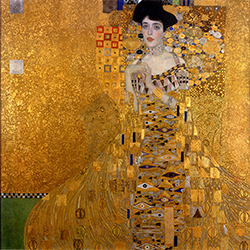 Painting by Gustav Klimt: Portrait of Adele Bloch-Bauer I (also called The Lady in Gold or The Woman in Gold) was completed between 1903 and 1907. The portrait was commissioned by the sitter's husband, Ferdinand Bloch-Bauer, a Jewish banker and sugar producer. It is the final and most fully representative work of Klimt's golden phase. The portrait was the first of two depictions of Adele by Klimt — the second was completed in 1912; these were two of several works by the artist that the family owned. Adele died in 1925; her will asked that the artworks by Klimt were to be left to the Österreichische Galerie Belvedere, although these belonged to Ferdinand, not her.
Painting by Gustav Klimt: Portrait of Adele Bloch-Bauer I (also called The Lady in Gold or The Woman in Gold) was completed between 1903 and 1907. The portrait was commissioned by the sitter's husband, Ferdinand Bloch-Bauer, a Jewish banker and sugar producer. It is the final and most fully representative work of Klimt's golden phase. The portrait was the first of two depictions of Adele by Klimt — the second was completed in 1912; these were two of several works by the artist that the family owned. Adele died in 1925; her will asked that the artworks by Klimt were to be left to the Österreichische Galerie Belvedere, although these belonged to Ferdinand, not her.
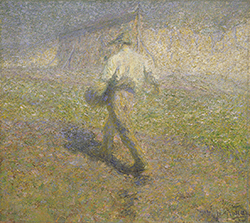 Painting by Ivan Grohar: The Sower (Slovene: Sejalec), is an image of a peasant sowing seeds on a ploughed field in an early and foggy morning. A hayrack, typical of the Slovene landscape, stands in the back, and even farther, the rocks of the small hill Kamnitnik near Škofja Loka. It has been a metaphor for the 19th-century myth of Slovenes as a vigorous nation in front of an unclear destiny, a symbol for the Slovene nation that sows in order that it could harvest, and a depiction of human interrelatedness with the nature. It is also a reflection of the context of Slovene transition from a rural to an urban culture. It has become one of the most characteristic and established Slovene creations in visual arts.
Painting by Ivan Grohar: The Sower (Slovene: Sejalec), is an image of a peasant sowing seeds on a ploughed field in an early and foggy morning. A hayrack, typical of the Slovene landscape, stands in the back, and even farther, the rocks of the small hill Kamnitnik near Škofja Loka. It has been a metaphor for the 19th-century myth of Slovenes as a vigorous nation in front of an unclear destiny, a symbol for the Slovene nation that sows in order that it could harvest, and a depiction of human interrelatedness with the nature. It is also a reflection of the context of Slovene transition from a rural to an urban culture. It has become one of the most characteristic and established Slovene creations in visual arts.
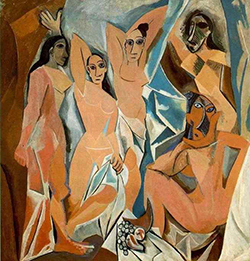 Painting by Pablo Picasso: Les Demoiselles d'Avignon (The Young Ladies of Avignon, and originally titled The Brothel of Avignon) portrays five nude female prostitutes from a brothel on Carrer d'Avinyó (Avinyó Street) in Barcelona. Each figure is depicted in a disconcerting confrontational manner and none are conventionally feminine. In this adaptation of Primitivism and abandonment of perspective in favor of a flat, two-dimensional picture plane, Picasso makes a radical departure from traditional European painting. This proto-Cubist work is widely considered to be seminal in the early development of both Cubism and Modern art. Les Demoiselles was revolutionary and controversial, and led to widespread anger and disagreement, even amongst the painter's closest associates and friends. Matisse considered the work something of a bad joke, yet indirectly reacted to it in his 1908 Bathers with a Turtle. Braque too initially disliked the painting, yet perhaps more than anyone else, studied the work in great detail. And effectively, his subsequent friendship and collaboration with Picasso led to the Cubist revolution
Painting by Pablo Picasso: Les Demoiselles d'Avignon (The Young Ladies of Avignon, and originally titled The Brothel of Avignon) portrays five nude female prostitutes from a brothel on Carrer d'Avinyó (Avinyó Street) in Barcelona. Each figure is depicted in a disconcerting confrontational manner and none are conventionally feminine. In this adaptation of Primitivism and abandonment of perspective in favor of a flat, two-dimensional picture plane, Picasso makes a radical departure from traditional European painting. This proto-Cubist work is widely considered to be seminal in the early development of both Cubism and Modern art. Les Demoiselles was revolutionary and controversial, and led to widespread anger and disagreement, even amongst the painter's closest associates and friends. Matisse considered the work something of a bad joke, yet indirectly reacted to it in his 1908 Bathers with a Turtle. Braque too initially disliked the painting, yet perhaps more than anyone else, studied the work in great detail. And effectively, his subsequent friendship and collaboration with Picasso led to the Cubist revolution
Henri Matisse coins the term "Cubism" — the first Cubist exhibition opens in Paris.
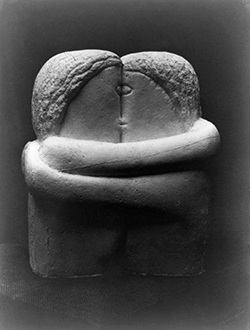 Sculpture by Constantin Brâncusi: The Kiss is an early example of his proto-cubist style of non-literal representation. This plaster was exhibited at the 1913 Armory Show and published in the Chicago Tribune, 25 March 1913. This early plaster sculpture is one of six casts that Brancusi made of the 1907–08 The Kiss. The original stone carving is in the Muzeul de Arta at Craiova, Romania. Brâncusi created many versions of The Kiss, further simplifying geometric forms and sparse objects in each version, tending each time further toward abstraction. His abstract style emphasizes simple geometrical lines that balance forms inherent in his materials with the symbolic allusions of representational art. Here, the shape of the original block of material is maintained.
Sculpture by Constantin Brâncusi: The Kiss is an early example of his proto-cubist style of non-literal representation. This plaster was exhibited at the 1913 Armory Show and published in the Chicago Tribune, 25 March 1913. This early plaster sculpture is one of six casts that Brancusi made of the 1907–08 The Kiss. The original stone carving is in the Muzeul de Arta at Craiova, Romania. Brâncusi created many versions of The Kiss, further simplifying geometric forms and sparse objects in each version, tending each time further toward abstraction. His abstract style emphasizes simple geometrical lines that balance forms inherent in his materials with the symbolic allusions of representational art. Here, the shape of the original block of material is maintained.
1907
 Alain Locke of Philadelphia, a Harvard graduate, becomes the first African-American Rhodes scholar to study at Oxford University in England.
Alain Locke of Philadelphia, a Harvard graduate, becomes the first African-American Rhodes scholar to study at Oxford University in England.
Robert Baden-Powell founds the Boy Scout movement, in Britain.
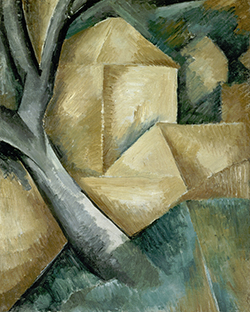 Painting by Georges Braque: Houses at l'Estaque (French: Maisons à l'Estaque) is considered either an important Proto-Cubist landscape or the first Cubist landscape. The painting prompted art critic Louis Vauxcelles to mock it as being composed of cubes which led to the name of the movement. This painting by Braque was refused at the Salon d'Automne in 1908. Louis Vauxcelles recounted how Matisse told him at the time, "Braque has just sent in [to the 1908 Salon d'Automne] a painting made of little cubes". The critic Charles Morice relayed Matisse's words and spoke of Braque's little cubes. The motif of the viaduct at l'Estaque had inspired Braque to produce three paintings marked by the simplification of form and deconstruction of perspective. Six landscapes painted at L'Estaque signed Georges Braque were presented to the Jury of the Salon d'Automne: Guérin, Marquet, Rouault and Matisse rejected Braque's entire submission. Guérin and Marquet elected to keep two in play. Braque withdrew the two in protest, placing the blame on Matisse.
Painting by Georges Braque: Houses at l'Estaque (French: Maisons à l'Estaque) is considered either an important Proto-Cubist landscape or the first Cubist landscape. The painting prompted art critic Louis Vauxcelles to mock it as being composed of cubes which led to the name of the movement. This painting by Braque was refused at the Salon d'Automne in 1908. Louis Vauxcelles recounted how Matisse told him at the time, "Braque has just sent in [to the 1908 Salon d'Automne] a painting made of little cubes". The critic Charles Morice relayed Matisse's words and spoke of Braque's little cubes. The motif of the viaduct at l'Estaque had inspired Braque to produce three paintings marked by the simplification of form and deconstruction of perspective. Six landscapes painted at L'Estaque signed Georges Braque were presented to the Jury of the Salon d'Automne: Guérin, Marquet, Rouault and Matisse rejected Braque's entire submission. Guérin and Marquet elected to keep two in play. Braque withdrew the two in protest, placing the blame on Matisse.
1908
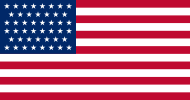 The US flag is modified to have forty-six stars, reflecting the addition of one new state: Oklahoma.
The US flag is modified to have forty-six stars, reflecting the addition of one new state: Oklahoma.
The Young Turk revolution restores the Constitution and parliamentary government in the Ottoman Empire.
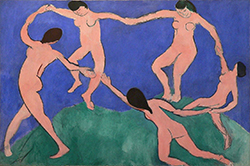 Painting by Henri Matisse: Dance (La Danse). The title refers to either of two related paintings made between 1909 and 1910. The first, preliminary version is Matisse's study for the second version. The composition or arrangement of dancing figures is reminiscent of Blake's watercolour "Oberon, Titania and Puck with fairies dancing" from 1786.
Painting by Henri Matisse: Dance (La Danse). The title refers to either of two related paintings made between 1909 and 1910. The first, preliminary version is Matisse's study for the second version. The composition or arrangement of dancing figures is reminiscent of Blake's watercolour "Oberon, Titania and Puck with fairies dancing" from 1786.
1909
The National Association for the Advancement of Colored People (NAACP) is formed on February 12 in New York City.
 William Howard Taft becomes twenty-seventh president of the United States.
William Howard Taft becomes twenty-seventh president of the United States.
Tel Aviv, the first Jewish town in modern Palestine, is founded.
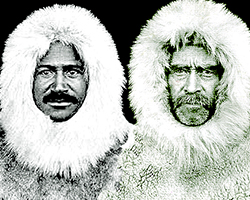 United States explorer Commander Robert E. Peary, accompanied by Matthew Henson, is the first person to reach North Pole.
United States explorer Commander Robert E. Peary, accompanied by Matthew Henson, is the first person to reach North Pole.
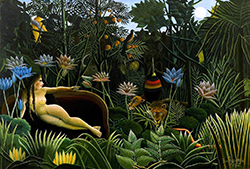 Painting by Henri Rousseau: The Dream (French: Le Rêve, occasionally also known as Le Songe or Rêve exotique) is a large oil-on-canvas painting, one of more than 25 Rousseau paintings with a jungle theme. His last completed work, it was first exhibited at the Salon des Indépendants from 18 March to 1 May 1910, a few months before his death on 2 September 1910. Rousseau's earlier works had received a negative reception, but poet and critic Guillaume Apollinaire remarked on its debut: "The picture radiates beauty, that is indisputable. I believe nobody will laugh this year." The Dream is the largest of the jungle paintings, measuring 6' 8.5" × 9' 9.5". It features an almost surreal portrait of Yadwigha (Jadwiga), Rousseau's Polish mistress from his youth, lying naked on a divan to the left of the painting, gazing over a landscape of lush jungle foliage, including lotus flowers, and animals including birds, monkeys, an elephant, a lion and lioness, and a snake. French art dealer Ambroise Vollard (the same Vollard who purchased 250 paintings from Cézanne for 50 francs each) bought the painting from Rousseau in February 1910
Painting by Henri Rousseau: The Dream (French: Le Rêve, occasionally also known as Le Songe or Rêve exotique) is a large oil-on-canvas painting, one of more than 25 Rousseau paintings with a jungle theme. His last completed work, it was first exhibited at the Salon des Indépendants from 18 March to 1 May 1910, a few months before his death on 2 September 1910. Rousseau's earlier works had received a negative reception, but poet and critic Guillaume Apollinaire remarked on its debut: "The picture radiates beauty, that is indisputable. I believe nobody will laugh this year." The Dream is the largest of the jungle paintings, measuring 6' 8.5" × 9' 9.5". It features an almost surreal portrait of Yadwigha (Jadwiga), Rousseau's Polish mistress from his youth, lying naked on a divan to the left of the painting, gazing over a landscape of lush jungle foliage, including lotus flowers, and animals including birds, monkeys, an elephant, a lion and lioness, and a snake. French art dealer Ambroise Vollard (the same Vollard who purchased 250 paintings from Cézanne for 50 francs each) bought the painting from Rousseau in February 1910
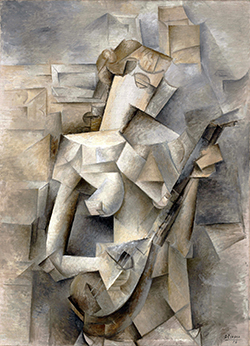 Painting by Pablo Picasso: Girl with a Mandolin is an early example of the artist's analytic cubist style. By the winter of 1909/10 Picasso's pictorial language had already become increasingly hard to decipher. He was steadily divesting his paintings of mere likeness, not that this was synonymous with a progressive elimination of the subject: his paintings were becoming more abstract but not entirely so.
Painting by Pablo Picasso: Girl with a Mandolin is an early example of the artist's analytic cubist style. By the winter of 1909/10 Picasso's pictorial language had already become increasingly hard to decipher. He was steadily divesting his paintings of mere likeness, not that this was synonymous with a progressive elimination of the subject: his paintings were becoming more abstract but not entirely so.
1910
 On July 4, boxer Jack Johnson defeats Jim Jeffries in Reno, Nevada, to become the first African-American world heavyweight champion.
On July 4, boxer Jack Johnson defeats Jim Jeffries in Reno, Nevada, to become the first African-American world heavyweight champion.
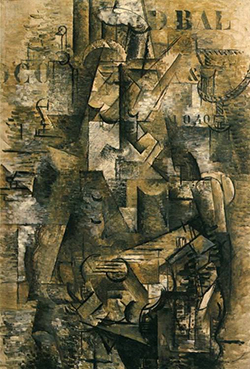 Painting by Georges Braque: The Portuguese
Painting by Georges Braque: The Portuguese
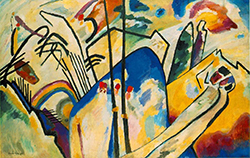 painting by Wassily Kandinsky: Composition IV is the fourth of a series of paintings that explore the artist's attempts to represent the structure and form of music through the medium of painting. The painting measures 62 7/8 × 98 5/8 inches, and it is in the Hermitage Museum in St. Petersburg, Russia. It was made using oil paints on canvas.
painting by Wassily Kandinsky: Composition IV is the fourth of a series of paintings that explore the artist's attempts to represent the structure and form of music through the medium of painting. The painting measures 62 7/8 × 98 5/8 inches, and it is in the Hermitage Museum in St. Petersburg, Russia. It was made using oil paints on canvas.
1911
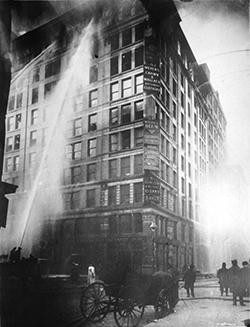 A fire inside the Triangle Shirtwaist Company factory in New York City's garment district kills 146 workers, mostly immigrant Jewish and Italian women in their teens and early 20s. Most women could not escape the burning building because the doors to the stairwells and exits were locked to keep the workers from stealing linen from the factory. It is the deadliest workplace incident in the city's history until 9/11.
A fire inside the Triangle Shirtwaist Company factory in New York City's garment district kills 146 workers, mostly immigrant Jewish and Italian women in their teens and early 20s. Most women could not escape the burning building because the doors to the stairwells and exits were locked to keep the workers from stealing linen from the factory. It is the deadliest workplace incident in the city's history until 9/11.
Winston Churchill is appointed First Lord of the Admiralty.
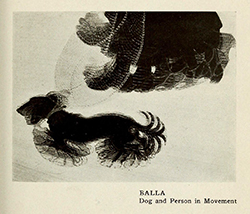 Painting by Giacomo Balla: Dynamism of a Dog on a Leash (Italian: Dinamismo di un cane al guinzaglio), sometimes called Dog on a Leash or Leash in Motion, depicts a dachshund on a leash and the feet of a lady walking it, both in rapid motion as indicated by the blurring and multiplication of their parts. It is considered one of his best-known works, and one of the most important works, in Futurism. Chronophotographic studies of animals in motion, created by scientist Étienne–Jules Marey beginning in the 1880s, led to the introduction in painting of techniques to show motion, such as blurring, multiplication, and superimposition of body parts — perhaps in an effort to imitate these mechanical images. Such multiplication can be see in Marcel Duchamp's Nude Descending a Staircase, No. 2, painted the same year as Balla's painting. Balla's interest in capturing a single moment in a series of planes was inspired by his fascination with chronophotography. In later, more abstract works created during World War I, Balla used planes of color to suggest movement.
Painting by Giacomo Balla: Dynamism of a Dog on a Leash (Italian: Dinamismo di un cane al guinzaglio), sometimes called Dog on a Leash or Leash in Motion, depicts a dachshund on a leash and the feet of a lady walking it, both in rapid motion as indicated by the blurring and multiplication of their parts. It is considered one of his best-known works, and one of the most important works, in Futurism. Chronophotographic studies of animals in motion, created by scientist Étienne–Jules Marey beginning in the 1880s, led to the introduction in painting of techniques to show motion, such as blurring, multiplication, and superimposition of body parts — perhaps in an effort to imitate these mechanical images. Such multiplication can be see in Marcel Duchamp's Nude Descending a Staircase, No. 2, painted the same year as Balla's painting. Balla's interest in capturing a single moment in a series of planes was inspired by his fascination with chronophotography. In later, more abstract works created during World War I, Balla used planes of color to suggest movement.
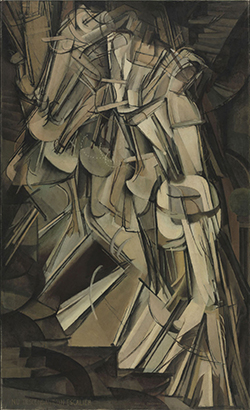 Painting by Marcel Duchamp: Nude Descending a Staircase causes an uproar at the 1913 Armory show in New York City. In interviews, Duchamp suggested that he had been influenced by seeing stop-motion images and that his aim was to achieve " a static representation of movement, a static composition of indications of various positions taken by a form in movement." In a New York Times review, an art critic described the painting as resembling "an explosion in a shingle factory."
Painting by Marcel Duchamp: Nude Descending a Staircase causes an uproar at the 1913 Armory show in New York City. In interviews, Duchamp suggested that he had been influenced by seeing stop-motion images and that his aim was to achieve " a static representation of movement, a static composition of indications of various positions taken by a form in movement." In a New York Times review, an art critic described the painting as resembling "an explosion in a shingle factory."
1912
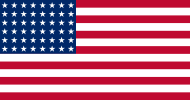 The US flag is modified to have forty-eight stars, reflecting the addition of two new states: Arizona and New Mexico.
The US flag is modified to have forty-eight stars, reflecting the addition of two new states: Arizona and New Mexico.
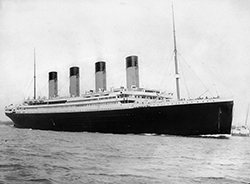 On April 10, the RMS Titanic — the largest, most advanced, and most luxurious passenger ship in the world — set off on her maiden voyage from Southampton, England to New York City. Four days later, this unsinkable marvel of modern engineering rammed an iceberg and sank in the North Atlantic, resulting in the deaths of 1,517 people.
On April 10, the RMS Titanic — the largest, most advanced, and most luxurious passenger ship in the world — set off on her maiden voyage from Southampton, England to New York City. Four days later, this unsinkable marvel of modern engineering rammed an iceberg and sank in the North Atlantic, resulting in the deaths of 1,517 people.

 The Republic of China is a nationally proclaimed with Sun Yat-sen as president. He appoints Chiang Kai-shek as his military advisor.
The Republic of China is a nationally proclaimed with Sun Yat-sen as president. He appoints Chiang Kai-shek as his military advisor.
 Thomas Mann publishes Death in Venice.
Thomas Mann publishes Death in Venice.
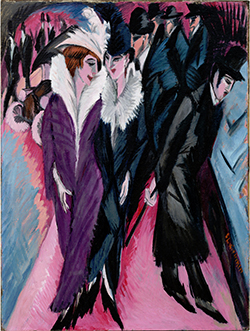 Painting by Ernst Ludwig Kirchner: Street, Berlin shows Berlin in 1913,` before the outbreak of World War 1. At this time, Kirchner painted several different street scenes that illustrated the chaos of city life and the relationship between men and women. The mass of men in the background do not have any identifying features, but instead appear as a copy of each other. Their clothes flow into one another and their non-distinct facial features cause you to connect with the women because they are the only two with a sense of identity. Kirchner uses some anti-naturalistic color in this piece including the skin of the figures which varies between shades of pink and orange as well as the blue and pink shades in the scenery. The anti-naturalistic tones are common in the German Expressionism and his other work during this time period.
Painting by Ernst Ludwig Kirchner: Street, Berlin shows Berlin in 1913,` before the outbreak of World War 1. At this time, Kirchner painted several different street scenes that illustrated the chaos of city life and the relationship between men and women. The mass of men in the background do not have any identifying features, but instead appear as a copy of each other. Their clothes flow into one another and their non-distinct facial features cause you to connect with the women because they are the only two with a sense of identity. Kirchner uses some anti-naturalistic color in this piece including the skin of the figures which varies between shades of pink and orange as well as the blue and pink shades in the scenery. The anti-naturalistic tones are common in the German Expressionism and his other work during this time period.
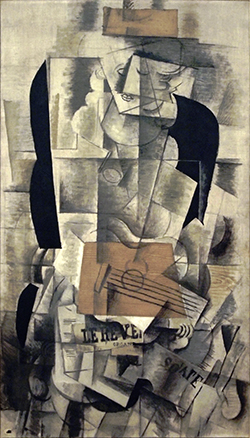 Painting by Georges Braque: Woman with a Guitar. A relatively large painting it is 130 cm by 73 cm, and utilised both oil paint and charcoal. While the painting is abstracted the basic subject can still be seen towards the top in the feminine mouth and eye, as well as the brown trapezoid shape containing the strings of a guitar.
Painting by Georges Braque: Woman with a Guitar. A relatively large painting it is 130 cm by 73 cm, and utilised both oil paint and charcoal. While the painting is abstracted the basic subject can still be seen towards the top in the feminine mouth and eye, as well as the brown trapezoid shape containing the strings of a guitar.
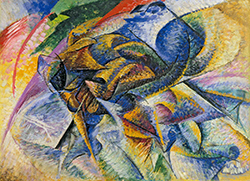 Painting by Umberto Boccioni: Dynamism of a Cyclist (Dinamismo di un Ciclista) demonstrates the Futurist preoccupation with speed, modern methods of transport, and the depiction of the dynamic sensation of movement. Futurism was an early twentieth-century movement in Italy that sought to free the country from what the Futurists saw as the dead weight of its classical past. The Futurists were preoccupied with the technology and dynamism of modern life. The movement found its expression primarily in literature and art.
Painting by Umberto Boccioni: Dynamism of a Cyclist (Dinamismo di un Ciclista) demonstrates the Futurist preoccupation with speed, modern methods of transport, and the depiction of the dynamic sensation of movement. Futurism was an early twentieth-century movement in Italy that sought to free the country from what the Futurists saw as the dead weight of its classical past. The Futurists were preoccupied with the technology and dynamism of modern life. The movement found its expression primarily in literature and art.
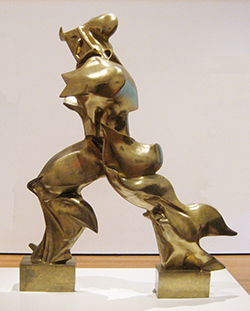 Sculpture by Umberto Boccioni: Unique Forms of Continuity in Space (Italian: Forme uniche della continuità nello spazio) is seen as an expression of movement and fluidity. The sculpture is depicted on the obverse of the Italian-issue 20 cent euro coin. The Futurist movement was striving to portray speed and forceful dynamism in their art. Boccioni, though trained as a painter, began sculpting in 1912. He exclaimed that "these days I am obsessed by sculpture! I believe I have glimpsed a complete renovation of that mummified art." The following year Boccioni completed the sculpture. His goal for the work was to depict a "synthetic continuity" of motion instead of an "analytical discontinuity" that he saw in artists like František Kupka and Marcel Duchamp.
Sculpture by Umberto Boccioni: Unique Forms of Continuity in Space (Italian: Forme uniche della continuità nello spazio) is seen as an expression of movement and fluidity. The sculpture is depicted on the obverse of the Italian-issue 20 cent euro coin. The Futurist movement was striving to portray speed and forceful dynamism in their art. Boccioni, though trained as a painter, began sculpting in 1912. He exclaimed that "these days I am obsessed by sculpture! I believe I have glimpsed a complete renovation of that mummified art." The following year Boccioni completed the sculpture. His goal for the work was to depict a "synthetic continuity" of motion instead of an "analytical discontinuity" that he saw in artists like František Kupka and Marcel Duchamp.
1913
 Woodrow Wilson becomes twenty-eighth president of the United States.
Woodrow Wilson becomes twenty-eighth president of the United States.
On April 11, President Woodrow Wilson initiates the racial segregation of workplaces, restaurants, and lunchrooms and all federal offices across the nation.
The federal income tax is introduced in the United States with the 16th amendment.
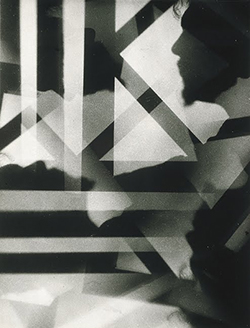 Photograph by Alvin Langdon Coburn: Vortograph — a kaleidoscopic effect — created by placing mirrors in triangular arrangements around a lens.
Photograph by Alvin Langdon Coburn: Vortograph — a kaleidoscopic effect — created by placing mirrors in triangular arrangements around a lens.
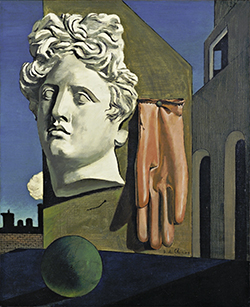 Painting by Giorgio de Chirico: The Song of Love (also known as Le chant d'amour or Love Song; 1914) is one of the most famous works by de Chirico and an early example of the surrealist style, though it was painted ten years before the movement was "founded" by André Breton in 1924. It depicts an outdoor architectural setting similar to other works by de Chirico at this time. This time however, the main focus is a small wall on which is mounted a Greek sculpted head and a surgeon's glove. Below it is a green ball. On the horizon is the outline of a locomotive, an image that recurs several times during this period of de Chirico's career.
Painting by Giorgio de Chirico: The Song of Love (also known as Le chant d'amour or Love Song; 1914) is one of the most famous works by de Chirico and an early example of the surrealist style, though it was painted ten years before the movement was "founded" by André Breton in 1924. It depicts an outdoor architectural setting similar to other works by de Chirico at this time. This time however, the main focus is a small wall on which is mounted a Greek sculpted head and a surgeon's glove. Below it is a green ball. On the horizon is the outline of a locomotive, an image that recurs several times during this period of de Chirico's career.
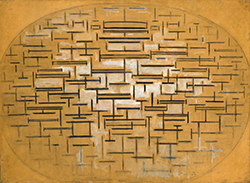 Painting by Piet Mondrian: The Ocean 5 is basically an abstracted pier that is composed of vertical lines that touch the base of the oval, which stretches into the ocean and short crosses that give the impression of light flickering on the water surface.
Painting by Piet Mondrian: The Ocean 5 is basically an abstracted pier that is composed of vertical lines that touch the base of the oval, which stretches into the ocean and short crosses that give the impression of light flickering on the water surface.
1914
The Ottoman Empire entered World War I on the side of the Central Powers, fighting against the Allied Powers. The war proved costly for the empire, leading to economic hardship, military defeats, and ultimately, its dissolution.
World War I begins after Archduke Francis Ferdinand, heir to the Austrian throne, and his wife are assassinated in Sarajevo, Bosnia, on June 28 by a Serbian nationalist.
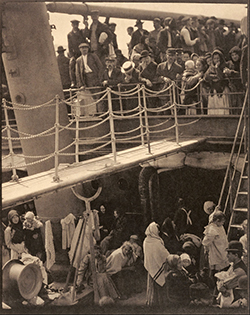 Photograph by Alfred Stieglitz: The Steerage has been hailed as one of the greatest photographs of all time because it captures in a single image both a formative document of its time and one of the first works of artistic modernism. Stieglitz first published The Steerage in the October 1911 issue of Camera Work, which he had devoted to his own photography. It appeared the following year on the cover of the magazine section of the Saturday Evening Mail (20 April 1912), a New York weekly magazine. It was first exhibited in a show of Stieglitz's photographs at "291" in 1913. In 1915 Stieglitz devoted the entire No 7-8 issue of 291 to The Steerage. The only text in the issue were comments on the photo by Paul Haviland and Marius de Zayas.
Photograph by Alfred Stieglitz: The Steerage has been hailed as one of the greatest photographs of all time because it captures in a single image both a formative document of its time and one of the first works of artistic modernism. Stieglitz first published The Steerage in the October 1911 issue of Camera Work, which he had devoted to his own photography. It appeared the following year on the cover of the magazine section of the Saturday Evening Mail (20 April 1912), a New York weekly magazine. It was first exhibited in a show of Stieglitz's photographs at "291" in 1913. In 1915 Stieglitz devoted the entire No 7-8 issue of 291 to The Steerage. The only text in the issue were comments on the photo by Paul Haviland and Marius de Zayas.
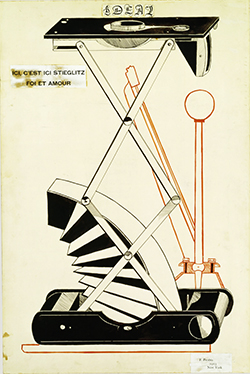 Work by Francis Picabia: Ici, C'est Ici Stieglitz Foi et Amour (Here, this is Stieglitz. Faith and Love) was published in 1915 as the cover of the avant-garde American journal 291. The work was one of a series of witty "machine portraits" by French artist Francis Picabia, soon to become a leading figure in the developing Dada art movement in New York City. The journal's title, named after Alfred Stieglitz's 291 Gallery on Fifth Avenue, pays tribute to the photographer's role in promoting modern art. But the symbolic portrait suggests that he has lost his momentum: it portrays its subject as a limp and broken camera striving toward, but not reaching, the "Ideal," with an automobile gearshift lodged in neutral and a hand brake engaged.
Work by Francis Picabia: Ici, C'est Ici Stieglitz Foi et Amour (Here, this is Stieglitz. Faith and Love) was published in 1915 as the cover of the avant-garde American journal 291. The work was one of a series of witty "machine portraits" by French artist Francis Picabia, soon to become a leading figure in the developing Dada art movement in New York City. The journal's title, named after Alfred Stieglitz's 291 Gallery on Fifth Avenue, pays tribute to the photographer's role in promoting modern art. But the symbolic portrait suggests that he has lost his momentum: it portrays its subject as a limp and broken camera striving toward, but not reaching, the "Ideal," with an automobile gearshift lodged in neutral and a hand brake engaged.
1915
(no entry for this year)
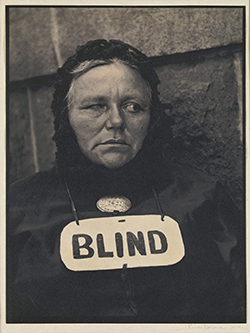 Photograph by Paul Strand:: Blind, taken as part of a series of street portraits. He used a camera outfitted with a special false lens that allowed him to point the camera in one direction while actually taking a photograph ninety degrees to the side. The result was a collection of remarkably natural and unposed photographs.
Photograph by Paul Strand:: Blind, taken as part of a series of street portraits. He used a camera outfitted with a special false lens that allowed him to point the camera in one direction while actually taking a photograph ninety degrees to the side. The result was a collection of remarkably natural and unposed photographs.
1916

 The Sykes–Picot Agreement (a secret agreement between the governments of the UK and France defining their respective spheres of influence and control in the Middle East after the expected downfall of the Ottoman Empire during World War I) is drawn up and signed by Sir Mark Sykes and Fran ois Georges-Picot.
The Sykes–Picot Agreement (a secret agreement between the governments of the UK and France defining their respective spheres of influence and control in the Middle East after the expected downfall of the Ottoman Empire during World War I) is drawn up and signed by Sir Mark Sykes and Fran ois Georges-Picot.
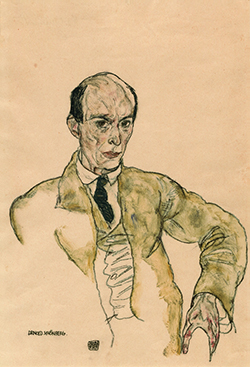 Painting by Egon Schiele: Portrait of the Composer Arnold Schönberg (German: Bildnis des Komponisten Arnold Schönberg)
Painting by Egon Schiele: Portrait of the Composer Arnold Schönberg (German: Bildnis des Komponisten Arnold Schönberg)
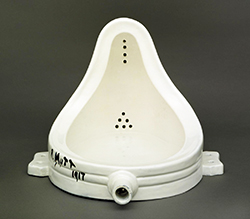 "Sculpture" by Marcel Duchamp: Fountain. Duchamp submits this work to the exhibition of the Society of Independent Artists. The piece is actually a porcelain urinal, signed R. Mutt, 1917. The work (originally conceived as a prank) is regarded by art historians as a major landmark in 20th-century art.
"Sculpture" by Marcel Duchamp: Fountain. Duchamp submits this work to the exhibition of the Society of Independent Artists. The piece is actually a porcelain urinal, signed R. Mutt, 1917. The work (originally conceived as a prank) is regarded by art historians as a major landmark in 20th-century art.
1917
 Lucy Diggs Slowe wins the championship in the first national tennis tournament sponsored by the American Tennis Association. With her victory she becomes the first African-American woman to win a major sports title.
Lucy Diggs Slowe wins the championship in the first national tennis tournament sponsored by the American Tennis Association. With her victory she becomes the first African-American woman to win a major sports title.
 The Balfour Declaration (dated 2 November 1917) — a formal statement of policy by the British government, written by Arthur Balfour, stating that "His Majesty's government view with favour the establishment in Palestine of a national home for the Jewish people, and will use their best endeavours to facilitate the achievement of this object" — is issued. The anniversary of the declaration, 2 November, is widely commemorated in Israel and among Jews in the Jewish diaspora as Balfour Day. This day is also observed as a day of mourning in Arab countries still today.
The Balfour Declaration (dated 2 November 1917) — a formal statement of policy by the British government, written by Arthur Balfour, stating that "His Majesty's government view with favour the establishment in Palestine of a national home for the Jewish people, and will use their best endeavours to facilitate the achievement of this object" — is issued. The anniversary of the declaration, 2 November, is widely commemorated in Israel and among Jews in the Jewish diaspora as Balfour Day. This day is also observed as a day of mourning in Arab countries still today.
The October Revolution occurs in Russia, followed by the Russian Civil War.
 The United States enters World War I; Gen. Pershing goes to Paris to lead American forces.
The United States enters World War I; Gen. Pershing goes to Paris to lead American forces.
 Painting by Marcel Duchamp: Tu m'. This was Duchamp's last painting and was commissioned by Katherine Dreier to be hung over a bookcase in her library, hence the unusual length and frieze-like shape of the work. Executed in 1918, it is Marcel Duchamp's last painting on canvas and sums up his previous artistic concerns. Ranging across the canvas from left to right are cast shadows that refer to three "ready-mades": a bicycle wheel, a corkscrew, and a hat rack. Several objects are rendered illusionistically, such as a painted hand with a pointed finger in the lower center. Providing counterpoints to these trompe l'oeil elements are real objects: a bottle brush, a bolt, and safety pins. Duchamp summarizes different ways in which a work of art can suggest reality: as shadow, imitation, or actual object. The title lends a sarcastic tone to the work, for the words, perhaps short for the French "tu m'emmerdes" (you annoy me) or "tu m'ennuies" (you bore me), seem to express his attitude toward painting as he was casting it aside.
Painting by Marcel Duchamp: Tu m'. This was Duchamp's last painting and was commissioned by Katherine Dreier to be hung over a bookcase in her library, hence the unusual length and frieze-like shape of the work. Executed in 1918, it is Marcel Duchamp's last painting on canvas and sums up his previous artistic concerns. Ranging across the canvas from left to right are cast shadows that refer to three "ready-mades": a bicycle wheel, a corkscrew, and a hat rack. Several objects are rendered illusionistically, such as a painted hand with a pointed finger in the lower center. Providing counterpoints to these trompe l'oeil elements are real objects: a bottle brush, a bolt, and safety pins. Duchamp summarizes different ways in which a work of art can suggest reality: as shadow, imitation, or actual object. The title lends a sarcastic tone to the work, for the words, perhaps short for the French "tu m'emmerdes" (you annoy me) or "tu m'ennuies" (you bore me), seem to express his attitude toward painting as he was casting it aside.
1918
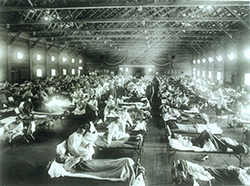 A worldwide influenza epidemic strikes. By 1920, 50 to 100 millions are dead, including Mark Sykes, the author of the British half of the Sykes-Picot Treaty.
A worldwide influenza epidemic strikes. By 1920, 50 to 100 millions are dead, including Mark Sykes, the author of the British half of the Sykes-Picot Treaty.
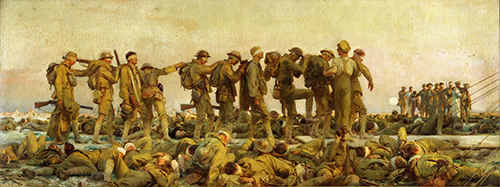 Painting by John Singer Sargent: Gassed is a very large (7.5 × 20 feet) oil painting completed in March 1919 by John Singer Sargent. It depicts the aftermath of a mustard gas attack during the First World War, with a line of wounded soldiers walking towards a dressing station. Sargent was commissioned by the British War Memorials Committee to document the war and visited the Western Front in July 1918 spending time with the Guards Division near Arras, and then with the American Expeditionary Forces near Ypres. The painting was finished in March 1919 and voted picture of the year by the Royal Academy of Arts in 1919. It is now held by the Imperial War Museum.
Painting by John Singer Sargent: Gassed is a very large (7.5 × 20 feet) oil painting completed in March 1919 by John Singer Sargent. It depicts the aftermath of a mustard gas attack during the First World War, with a line of wounded soldiers walking towards a dressing station. Sargent was commissioned by the British War Memorials Committee to document the war and visited the Western Front in July 1918 spending time with the Guards Division near Arras, and then with the American Expeditionary Forces near Ypres. The painting was finished in March 1919 and voted picture of the year by the Royal Academy of Arts in 1919. It is now held by the Imperial War Museum.
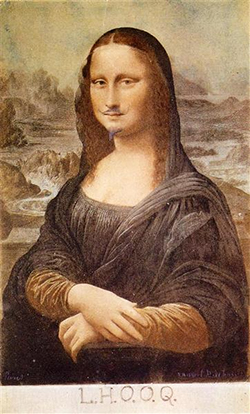 Work by Marcel Duchamp: L.H.O.O.Q., was one of what Duchamp referred to as a readymade, or more specifically a rectified ready-made. The readymade involves taking mundane, often utilitarian objects not generally considered to be art and transforming them, by adding to them, changing them, or (as in the case of his most famous work Fountain) simply renaming them and placing them in a gallery setting. In L.H.O.O.Q. the objet trouvé ("found object") is a cheap postcard reproduction of Leonardo da Vinci's Mona Lisa onto which Duchamp drew a moustache and beard in pencil and appended the title. The name of the piece, L.H.O.O.Q., is a pun; the letters pronounced in French sound like "Elle a chaud au cul", "She is hot in the arse"; "avoir chaud au cul" is a vulgar expression implying that a woman has sexual restlessness. In a late interview, Duchamp gives a loose translation of L.H.O.O.Q. as "there is fire down below". As was the case with a number of his readymades, Duchamp made multiple versions of L.H.O.O.Q. of differing sizes and in different media throughout his career, one of which, an unmodified black and white reproduction of the Mona Lisa mounted on card, is called L.H.O.O.Q. Shaved.
Work by Marcel Duchamp: L.H.O.O.Q., was one of what Duchamp referred to as a readymade, or more specifically a rectified ready-made. The readymade involves taking mundane, often utilitarian objects not generally considered to be art and transforming them, by adding to them, changing them, or (as in the case of his most famous work Fountain) simply renaming them and placing them in a gallery setting. In L.H.O.O.Q. the objet trouvé ("found object") is a cheap postcard reproduction of Leonardo da Vinci's Mona Lisa onto which Duchamp drew a moustache and beard in pencil and appended the title. The name of the piece, L.H.O.O.Q., is a pun; the letters pronounced in French sound like "Elle a chaud au cul", "She is hot in the arse"; "avoir chaud au cul" is a vulgar expression implying that a woman has sexual restlessness. In a late interview, Duchamp gives a loose translation of L.H.O.O.Q. as "there is fire down below". As was the case with a number of his readymades, Duchamp made multiple versions of L.H.O.O.Q. of differing sizes and in different media throughout his career, one of which, an unmodified black and white reproduction of the Mona Lisa mounted on card, is called L.H.O.O.Q. Shaved.
1919
By the beginning of 1919, the Ku Klux Klan (revived in 1915 at Stone Mountain, Georgia) operates in 27 states. Eighty-three African Americans are lynched during the year, among them a number of returning soldiers still in uniform.
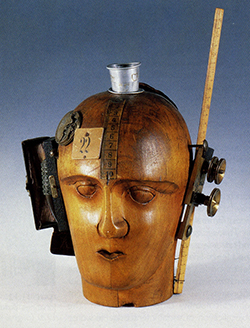 Sculpture by Raoul Hausmann: Mechanischer Kopf (Der Geist Unserer Zeit) — "The Mechanical Head (The Spirit of Our Time)" is the only surviving assemblage that Hausmann produced around 1919-20. Constructed from a hairdresser's wig-making dummy, the piece has various measuring devices attached including a ruler, a pocket watch mechanism, a typewriter, some camera segments and a crocodile wallet. "Der Geist Unserer Zeit — Mechanischer Kopf specifically evokes the philosopher George Wilhelm Friedrich Hegel. For Hegel...everything is mind. Among Hegel's disciples and critics was Karl Marx. Hausmann's sculpture might be seen as an aggressively Marxist reversal of Hegel: this is a head whose "thoughts" are materially determined by objects literally fixed to it. However, there are deeper targets in western culture that give this modern masterpiece its force. Hausmann turns inside out the notion of the head as seat of reason, an assumption that lies behind the European fascination with the portrait. He reveals a head that is penetrated and governed by brute external forces.
Sculpture by Raoul Hausmann: Mechanischer Kopf (Der Geist Unserer Zeit) — "The Mechanical Head (The Spirit of Our Time)" is the only surviving assemblage that Hausmann produced around 1919-20. Constructed from a hairdresser's wig-making dummy, the piece has various measuring devices attached including a ruler, a pocket watch mechanism, a typewriter, some camera segments and a crocodile wallet. "Der Geist Unserer Zeit — Mechanischer Kopf specifically evokes the philosopher George Wilhelm Friedrich Hegel. For Hegel...everything is mind. Among Hegel's disciples and critics was Karl Marx. Hausmann's sculpture might be seen as an aggressively Marxist reversal of Hegel: this is a head whose "thoughts" are materially determined by objects literally fixed to it. However, there are deeper targets in western culture that give this modern masterpiece its force. Hausmann turns inside out the notion of the head as seat of reason, an assumption that lies behind the European fascination with the portrait. He reveals a head that is penetrated and governed by brute external forces.
1920
Women gain the right to vote in the United States.
The Russian Civil War ends in victory for the Bolsheviks.
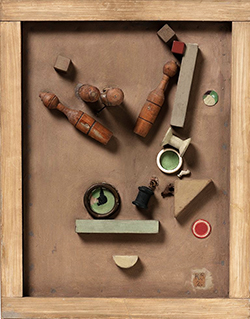 Assemblage by Kurt Schwitters: Merzpicture 46A. The Skittle Picture — an early example of Schitters' assemblages in which two and three dimensional objects are combined. The word "Merz," which Schwitters used to describe his art practice as well as his individual pieces, is a nonsensical word, like Dada, that Schwitters culled from the word "commerz", the meaning of which he described as follows: "In the war, things were in terrible turmoil. What I had learned at the academy was of no use to me.... Everything had broken down and new things had to be made out of the fragments; and this is Merz". In his Merzpictures, which have been called "psychological collages," he arranged found objects — usually detritus — in simple compositions that transformed trash into beautiful works of art. Whether the materials were string, a ticket stub, or a chess piece, Schwitters considered them to be equal with any traditional art material. Merz, however, is not ideological, dogmatic, hostile, or political as is much of Dada art.
Assemblage by Kurt Schwitters: Merzpicture 46A. The Skittle Picture — an early example of Schitters' assemblages in which two and three dimensional objects are combined. The word "Merz," which Schwitters used to describe his art practice as well as his individual pieces, is a nonsensical word, like Dada, that Schwitters culled from the word "commerz", the meaning of which he described as follows: "In the war, things were in terrible turmoil. What I had learned at the academy was of no use to me.... Everything had broken down and new things had to be made out of the fragments; and this is Merz". In his Merzpictures, which have been called "psychological collages," he arranged found objects — usually detritus — in simple compositions that transformed trash into beautiful works of art. Whether the materials were string, a ticket stub, or a chess piece, Schwitters considered them to be equal with any traditional art material. Merz, however, is not ideological, dogmatic, hostile, or political as is much of Dada art.
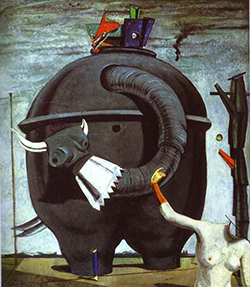 Painting by Max Ernst: The Elephant Celebes (or short Celebes) is among the most famous of Ernst's early surrealist works and "undoubtedly the first masterpiece of Surrealist painting in the de Chirico tradition." It combines the vivid dreamlike atmosphere of Surrealism with the collage aspects of Dada. The painting attempts to apply Dada's collage effects to simulate different materials. Ernst's realistic portrayal of the constituent elements produces a hallucinatory effect that he associated with collage, and was trying to achieve in this painting. Regarding the art of collage, Ernst said, "It is the systematic exploitation of the coincidental or artificially provoked encounter of two of more unrelated realities on an apparently inappropriate plane and the spark of poetry created by the proximity of these realities."
Painting by Max Ernst: The Elephant Celebes (or short Celebes) is among the most famous of Ernst's early surrealist works and "undoubtedly the first masterpiece of Surrealist painting in the de Chirico tradition." It combines the vivid dreamlike atmosphere of Surrealism with the collage aspects of Dada. The painting attempts to apply Dada's collage effects to simulate different materials. Ernst's realistic portrayal of the constituent elements produces a hallucinatory effect that he associated with collage, and was trying to achieve in this painting. Regarding the art of collage, Ernst said, "It is the systematic exploitation of the coincidental or artificially provoked encounter of two of more unrelated realities on an apparently inappropriate plane and the spark of poetry created by the proximity of these realities."
1921

 James Joyce publishes Ulysses and T. S. Eliot publishes The Wasteland, two significant works in the new literary movement called modernism.
James Joyce publishes Ulysses and T. S. Eliot publishes The Wasteland, two significant works in the new literary movement called modernism.
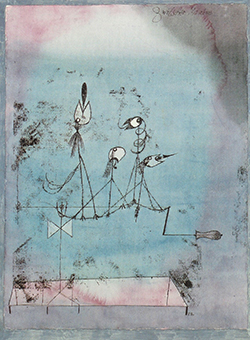 Painting by Paul Klee: Twittering Machine (Die Zwitscher-Maschine). Like other artworks by Klee, it blends biology and machinery, depicting a loosely sketched group of birds on a wire or branch connected to a hand-crank. Interpretations of the work vary widely: it has been perceived as a nightmarish lure for the viewer or a depiction of the helplessness of the artist, but also as a triumph of nature over mechanical pursuits. It has been seen as a visual representation of the mechanics of sound. Originally displayed in Germany, the image was declared "degenerate art" by Adolf Hitler in 1933 and sold by the Nazi Party to an art dealer in 1939, whence it made its way to New York. One of the better known of more than 9,000 works produced by Klee, it is among the more famous images of the New York Museum of Modern Art (MoMA). It has inspired several musical compositions and, according to a 1987 magazine profile in New York Magazine, has been a popular piece to hang in children's bedrooms.
Painting by Paul Klee: Twittering Machine (Die Zwitscher-Maschine). Like other artworks by Klee, it blends biology and machinery, depicting a loosely sketched group of birds on a wire or branch connected to a hand-crank. Interpretations of the work vary widely: it has been perceived as a nightmarish lure for the viewer or a depiction of the helplessness of the artist, but also as a triumph of nature over mechanical pursuits. It has been seen as a visual representation of the mechanics of sound. Originally displayed in Germany, the image was declared "degenerate art" by Adolf Hitler in 1933 and sold by the Nazi Party to an art dealer in 1939, whence it made its way to New York. One of the better known of more than 9,000 works produced by Klee, it is among the more famous images of the New York Museum of Modern Art (MoMA). It has inspired several musical compositions and, according to a 1987 magazine profile in New York Magazine, has been a popular piece to hang in children's bedrooms.
1922
 The Dyer Anti-Lynching Bill (first introduced by St. Louis congressman Leonidas Dyer in 1918), making lynching a federal offense, passes the US House of Representatives but fails in the US Senate.
The Dyer Anti-Lynching Bill (first introduced by St. Louis congressman Leonidas Dyer in 1918), making lynching a federal offense, passes the US House of Representatives but fails in the US Senate.
The Ottoman Empire officially ended with the signing of the Treaty of Lausanne, which recognized the sovereignty of the Republic of Turkey. Mustafa Kemal Ataturk, the founder of the Turkish Republic, implemented sweeping reforms to modernize the country and break with the Ottoman past.
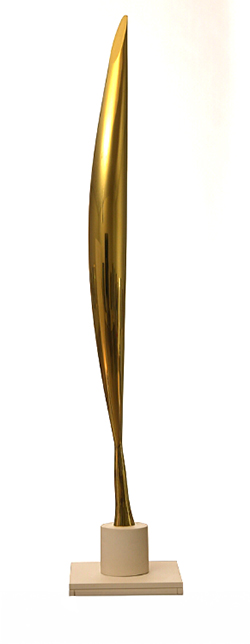 Sculpture by Constantin Brancusi: Bird in Space (L'Oiseau dans l'espace), the first in a series of sculptures. The original work was created in 1923 and made of marble. This sculpture is also known for containing seven marble figures and nine bronze casts. Brancusi created the piece over 14 times and in several mediums over a period of 20 years. It was sold in 2005 for $27.5 million, at the time a record price for a sculpture sold in an auction. In 1931, Yashwant Rao Holkar II — the young Maharaja of Indore acquired a bronze version for his Art Deco palace (Manik Bagh) in Indore. During his visit to Brancusi's studio in 1933, the Maharaja also reserved two other Birds in Space (in black marble and white, today at the National Gallery of Australia). When Brancusi shipped these to India three years later, he enclosed a note explaining, "My birds are a series of different objects based on a central theme that remains the same throughout. The ideal of its realization is to be an amplification that fills the whole vault of heaven."
Sculpture by Constantin Brancusi: Bird in Space (L'Oiseau dans l'espace), the first in a series of sculptures. The original work was created in 1923 and made of marble. This sculpture is also known for containing seven marble figures and nine bronze casts. Brancusi created the piece over 14 times and in several mediums over a period of 20 years. It was sold in 2005 for $27.5 million, at the time a record price for a sculpture sold in an auction. In 1931, Yashwant Rao Holkar II — the young Maharaja of Indore acquired a bronze version for his Art Deco palace (Manik Bagh) in Indore. During his visit to Brancusi's studio in 1933, the Maharaja also reserved two other Birds in Space (in black marble and white, today at the National Gallery of Australia). When Brancusi shipped these to India three years later, he enclosed a note explaining, "My birds are a series of different objects based on a central theme that remains the same throughout. The ideal of its realization is to be an amplification that fills the whole vault of heaven."
1923
Harding dies in office.
 Calvin Coolidge becomes thirtieth president of the United States.
Calvin Coolidge becomes thirtieth president of the United States.
Adolf Hitler's attempted coup d'état (the Beer Hall Putsch) in Munich fails. Hitler is imprisoned for eight months
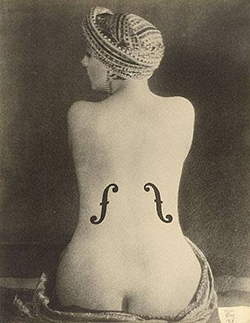 Photograph by Man Ray: Le Violon d'Ingres, a surrealistic photograph inspired by La Baigneuse Valpin on, an 1808 painting by Jean-Auguste-Dominique Ingres. The model is Alice Ernestine Prin (nicknamed Queen of Montparnasse, and often known as Kiki de Montparnasse), a French artist's model, nightclub singer, actress, memoirist, and painter. She flourished in, and helped define, the liberated culture of Paris in the 1920s. As an artist's model and Parisian sophisticate, she appeared often as the subject of paintings and sculpture.
Photograph by Man Ray: Le Violon d'Ingres, a surrealistic photograph inspired by La Baigneuse Valpin on, an 1808 painting by Jean-Auguste-Dominique Ingres. The model is Alice Ernestine Prin (nicknamed Queen of Montparnasse, and often known as Kiki de Montparnasse), a French artist's model, nightclub singer, actress, memoirist, and painter. She flourished in, and helped define, the liberated culture of Paris in the 1920s. As an artist's model and Parisian sophisticate, she appeared often as the subject of paintings and sculpture.
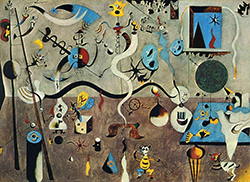 Painting by Joan Mir : The Harlequin's Carnival (Spanish: Carnaval de Arlequ n) is an oil painting rendered by Joan Mir between 1924 and 1925. It is one of the most outstanding surrealist paintings of the artist, and it is preserved in the Albright Knox Art Gallery, Buffalo. Created between 1924 and 1925, Harlequin's Carnival is one of Mir's best-known pieces. Harlequin is the name of an Italian comic theater character, generally identified by his checkered costume. The carnival in the title of the painting may refer to Mardi Gras, the celebration that occurs before the fasting of Lent begins.
Painting by Joan Mir : The Harlequin's Carnival (Spanish: Carnaval de Arlequ n) is an oil painting rendered by Joan Mir between 1924 and 1925. It is one of the most outstanding surrealist paintings of the artist, and it is preserved in the Albright Knox Art Gallery, Buffalo. Created between 1924 and 1925, Harlequin's Carnival is one of Mir's best-known pieces. Harlequin is the name of an Italian comic theater character, generally identified by his checkered costume. The carnival in the title of the painting may refer to Mardi Gras, the celebration that occurs before the fasting of Lent begins.
1924
 Gandhi undertakes his 21-day fast to protest feuds between Hindus and Muslims in India.
Gandhi undertakes his 21-day fast to protest feuds between Hindus and Muslims in India.
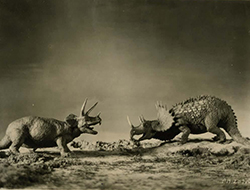 The film adaptation of Sir Arthur Conan Doyle's dinosaurs-and-cavemen fantasy The Lost World premieres.
The film adaptation of Sir Arthur Conan Doyle's dinosaurs-and-cavemen fantasy The Lost World premieres.
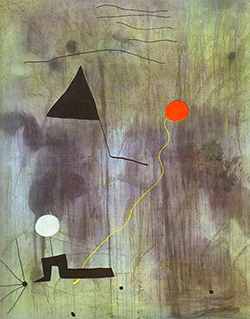 Painting by Joan JMiró: The Birth of the World depicts "a sort of genesis" — the amorphous beginnings of life. To make this work, Miró poured, brushed, and flung paint on an unevenly primed canvas so that the paint soaked in some areas and rested on top in others. Atop this relatively uncontrolled application of paint, he added lines and shapes he had previously planned in studies. The bird or kite, shooting star, balloon, and figure with white head may all seem somehow familiar, yet their association is illogical. Describing his method, Miró said, "Rather than setting out to paint something I began painting and as I paint the picture begins to assert itself, or suggest itself under my brush.... The first stage is free, unconscious." — like other Surrealists, Miró derived much inspiration from psychoanalyst Sigmund Freud's theories on dreams and the workings of the subconscious mind.
Painting by Joan JMiró: The Birth of the World depicts "a sort of genesis" — the amorphous beginnings of life. To make this work, Miró poured, brushed, and flung paint on an unevenly primed canvas so that the paint soaked in some areas and rested on top in others. Atop this relatively uncontrolled application of paint, he added lines and shapes he had previously planned in studies. The bird or kite, shooting star, balloon, and figure with white head may all seem somehow familiar, yet their association is illogical. Describing his method, Miró said, "Rather than setting out to paint something I began painting and as I paint the picture begins to assert itself, or suggest itself under my brush.... The first stage is free, unconscious." — like other Surrealists, Miró derived much inspiration from psychoanalyst Sigmund Freud's theories on dreams and the workings of the subconscious mind.
1925
 On September 9, Ossian Sweet, a Detroit physician, is arrested for murder after he and his family kill a member of a white mob while defending their home. The Sweet family is represented by Clarence Darrow and they are acquitted of the charge.
On September 9, Ossian Sweet, a Detroit physician, is arrested for murder after he and his family kill a member of a white mob while defending their home. The Sweet family is represented by Clarence Darrow and they are acquitted of the charge.
Hitler reorganizes the Nazi party and publishes volume one of Mein Kampf.
Ibn Saud of Najd conquers Hijaz and forms Saudi Arabia.
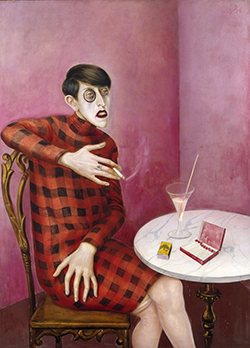 Painting by Otto Dix: "Bildnis der Journalistin Sylvia von Harden" (Portrait of the Journalist Sylvia von Harden, 1926). Sylvia von Harden was a German journalist and poet. During her career as a journalist, she wrote for many newspapers in Germany and England. An ambivalent image of the New Woman, it depicts von Harden with bobbed hair and monocle, seated at a cafe table with a cigarette in her hand and a cocktail in front of her. This painting is recreated in an opening scene of the 1972 film Cabaret. In 1959, von Harden wrote an article, "Erinnerungen an Otto Dix" ("Memories of Otto Dix"), in which she described the genesis of the portrait. Dix had met her on the street, and declared: 'I must paint you! I simply must! ... You are representative of an entire epoch!' 'So, you want to paint my lacklustre eyes, my ornate ears, my long nose, my thin lips; you want to paint my long hands, my short legs, my big feet — things which can only scare people off and delight no-one?' 'You have brilliantly characterized yourself, and all that will lead to a portrait representative of an epoch concerned not with the outward beauty of a woman but rather with her psychological condition.' The painting, an important example of the New Objectivity movement, is now in the Musée National d'Art Moderne, Centre Georges Pompidou, Paris.
Painting by Otto Dix: "Bildnis der Journalistin Sylvia von Harden" (Portrait of the Journalist Sylvia von Harden, 1926). Sylvia von Harden was a German journalist and poet. During her career as a journalist, she wrote for many newspapers in Germany and England. An ambivalent image of the New Woman, it depicts von Harden with bobbed hair and monocle, seated at a cafe table with a cigarette in her hand and a cocktail in front of her. This painting is recreated in an opening scene of the 1972 film Cabaret. In 1959, von Harden wrote an article, "Erinnerungen an Otto Dix" ("Memories of Otto Dix"), in which she described the genesis of the portrait. Dix had met her on the street, and declared: 'I must paint you! I simply must! ... You are representative of an entire epoch!' 'So, you want to paint my lacklustre eyes, my ornate ears, my long nose, my thin lips; you want to paint my long hands, my short legs, my big feet — things which can only scare people off and delight no-one?' 'You have brilliantly characterized yourself, and all that will lead to a portrait representative of an epoch concerned not with the outward beauty of a woman but rather with her psychological condition.' The painting, an important example of the New Objectivity movement, is now in the Musée National d'Art Moderne, Centre Georges Pompidou, Paris.
1926
Hirohito takes over the Japanese throne upon the death of his father, Yoshihito.
 Mussolini takes total control in Italy, banning all opposition.
Mussolini takes total control in Italy, banning all opposition.
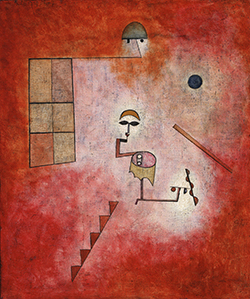 Painting by Paul Klee: Prestidigitator (Conjuring Trick). Klee's highly individual style was influenced by movements in art that included Expressionism, Cubism, and Surrealism. Klee was a natural draftsman who experimented with and eventually deeply explored color theory, writing about it extensively; his lectures Writings on Form and Design Theory (Schriften zur Form und Gestaltungslehre), published in English as the Paul Klee Notebooks, are held to be as important for modern art as Leonardo da Vinci's A Treatise on Painting for the Renaissance.
Painting by Paul Klee: Prestidigitator (Conjuring Trick). Klee's highly individual style was influenced by movements in art that included Expressionism, Cubism, and Surrealism. Klee was a natural draftsman who experimented with and eventually deeply explored color theory, writing about it extensively; his lectures Writings on Form and Design Theory (Schriften zur Form und Gestaltungslehre), published in English as the Paul Klee Notebooks, are held to be as important for modern art as Leonardo da Vinci's A Treatise on Painting for the Renaissance.
1927
(no entry for this year)
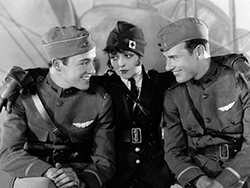 Wings wins Academy Award for best picture. The silent film about World War I soldiers and their girls back home provided intimacy and spectacle, including aviation sequences that are still impressive. For the first six ceremonies, the Academy did not use the calendar year, which is why the dates are a little confusing.
Wings wins Academy Award for best picture. The silent film about World War I soldiers and their girls back home provided intimacy and spectacle, including aviation sequences that are still impressive. For the first six ceremonies, the Academy did not use the calendar year, which is why the dates are a little confusing.
1928
(no entry for this year)
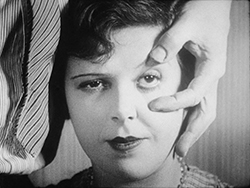 Surrealism goes to the movies, with Un Chien Andalou (An Andalusian Dog), a 1929 silent surrealist short film by the Spanish director Luis Buñuel and artist Salvador Dalí. It was Buñuel's first film and was initially released in 1929 with a limited showing at Studio des Ursulines in Paris, but became popular and ran for eight months. Un Chien Andalou has no plot in the conventional sense of the word. The chronology of the film is disjointed, jumping from the initial "once upon a time" to "eight years later" without the events or characters changing very much. It uses dream logic in narrative flow that can be described in terms of then-popular Freudian free association, presenting a series of tenuously related scenes. The idea for the film began when Buñuel was working as an assistant director for Jean Epstein in France. Buñuel told Dalí at a restaurant one day about a dream in which a cloud sliced the moon in half "like a razor blade slicing through an eye". Dalí responded that he'd dreamed about a hand crawling with ants. Excitedly, Buñuel declared: "There's the film, let's go and make it.'" They were fascinated by what the psyche could create, and decided to write a script based on the concept of suppressed human emotions. In deliberate contrast to the approach taken by Jean Epstein and his peers, which was to never leave anything in their work to chance, with every aesthetic decision having a rational explanation and fitting clearly into the whole, Bu uel made clear throughout his writings that, between Dalí and himself, the only rule for the writing of the script was: "No idea or image that might lend itself to a rational explanation of any kind would be accepted." Buñuel also stated: "Nothing, in the film, symbolizes anything. The only method of investigation of the symbols would be, perhaps, psychoanalysis."
Surrealism goes to the movies, with Un Chien Andalou (An Andalusian Dog), a 1929 silent surrealist short film by the Spanish director Luis Buñuel and artist Salvador Dalí. It was Buñuel's first film and was initially released in 1929 with a limited showing at Studio des Ursulines in Paris, but became popular and ran for eight months. Un Chien Andalou has no plot in the conventional sense of the word. The chronology of the film is disjointed, jumping from the initial "once upon a time" to "eight years later" without the events or characters changing very much. It uses dream logic in narrative flow that can be described in terms of then-popular Freudian free association, presenting a series of tenuously related scenes. The idea for the film began when Buñuel was working as an assistant director for Jean Epstein in France. Buñuel told Dalí at a restaurant one day about a dream in which a cloud sliced the moon in half "like a razor blade slicing through an eye". Dalí responded that he'd dreamed about a hand crawling with ants. Excitedly, Buñuel declared: "There's the film, let's go and make it.'" They were fascinated by what the psyche could create, and decided to write a script based on the concept of suppressed human emotions. In deliberate contrast to the approach taken by Jean Epstein and his peers, which was to never leave anything in their work to chance, with every aesthetic decision having a rational explanation and fitting clearly into the whole, Bu uel made clear throughout his writings that, between Dalí and himself, the only rule for the writing of the script was: "No idea or image that might lend itself to a rational explanation of any kind would be accepted." Buñuel also stated: "Nothing, in the film, symbolizes anything. The only method of investigation of the symbols would be, perhaps, psychoanalysis."
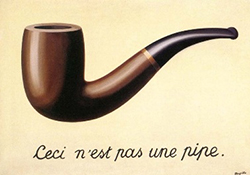 Painting by René Magritte: The Treachery of Images (French: La trahison des images, 1928–29, sometimes translated as The Treason of Images) shows a pipe. Below it, Magritte painted, "Ceci n'est pas une pipe.", French for "This is not a pipe." Magritte's comment: "The famous pipe. How people reproached me for it! And yet, could you stuff my pipe? No, it's just a representation, is it not? So if I had written on my picture 'This is a pipe', I'd have been lying!" The painting is sometimes given as an example of meta message conveyed by paralanguage. Compare with Korzybski's "The word is not the thing" and "The map is not the territory" or Freud's "Sometimes a cigar is just a cigar."
Painting by René Magritte: The Treachery of Images (French: La trahison des images, 1928–29, sometimes translated as The Treason of Images) shows a pipe. Below it, Magritte painted, "Ceci n'est pas une pipe.", French for "This is not a pipe." Magritte's comment: "The famous pipe. How people reproached me for it! And yet, could you stuff my pipe? No, it's just a representation, is it not? So if I had written on my picture 'This is a pipe', I'd have been lying!" The painting is sometimes given as an example of meta message conveyed by paralanguage. Compare with Korzybski's "The word is not the thing" and "The map is not the territory" or Freud's "Sometimes a cigar is just a cigar."
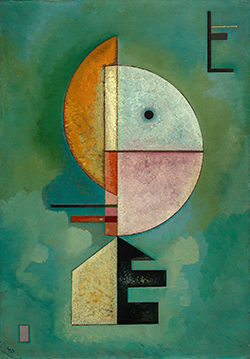 Painting by Wassily Kandinsky: Upward (Empor). Geometric abstraction, oil on cardboard.
Painting by Wassily Kandinsky: Upward (Empor). Geometric abstraction, oil on cardboard.
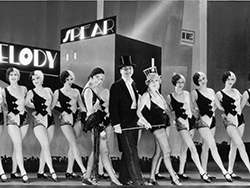 The Broadway Melody wins Academy Award for best picture. It was the first talkie to win an Oscar, with the movie's publicity bragging All talking! All dancing! All singing! That novelty made it a sensation, but the film is pretty creaky in modern times. There were no nominations that year, just an announcement of winners.
The Broadway Melody wins Academy Award for best picture. It was the first talkie to win an Oscar, with the movie's publicity bragging All talking! All dancing! All singing! That novelty made it a sensation, but the film is pretty creaky in modern times. There were no nominations that year, just an announcement of winners.
1929
 Herbert Hoover becomes thirty-first president of the United States.
Herbert Hoover becomes thirty-first president of the United States.
Black Tuesday in New York signals the beginning of a worldwide economic crisis and the beginning of the Great Depression, when the US stock exchange collapses, losing $26 billion in value.
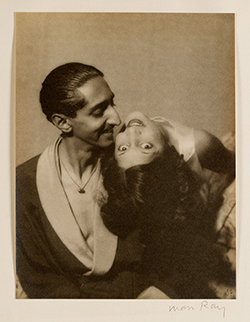 Photograph by Man Ray: Yeshwant Rao Holkar II and Sanyogita Devi of Indore. The Maharaja of Indore spent much time in Europe and the United States (one of his homes was in Santa Ana, California). He became a patron of many important artists and designers of his day. The Paris-based American avant-garde photographer Man Ray photographed Yeshwant Rao Holkar extensively. This informal and intimate image of the Maharaja and his wife were probably taken when they were on holiday in Cannes, in the south of France.
Photograph by Man Ray: Yeshwant Rao Holkar II and Sanyogita Devi of Indore. The Maharaja of Indore spent much time in Europe and the United States (one of his homes was in Santa Ana, California). He became a patron of many important artists and designers of his day. The Paris-based American avant-garde photographer Man Ray photographed Yeshwant Rao Holkar extensively. This informal and intimate image of the Maharaja and his wife were probably taken when they were on holiday in Cannes, in the south of France.
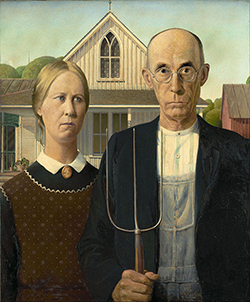 Painting by Grant Wood: American Gothic. Wood's inspiration came from what is now known as the American Gothic House, and his decision to paint the house along with "the kind of people I fancied should live in that house." Created in 1930, it depicts a farmer standing beside a woman that has been interpreted to be either his wife or his daughter. The figures were modeled by Wood's sister, Nan Wood Graham, and a local dentist, Dr. Byron McKeeby. The woman is dressed in a colonial print apron evoking 19th-century Americana, and the man is holding a pitchfork. It is one of the most familiar images in 20th-century American art, and has been widely parodied in American popular culture.
Painting by Grant Wood: American Gothic. Wood's inspiration came from what is now known as the American Gothic House, and his decision to paint the house along with "the kind of people I fancied should live in that house." Created in 1930, it depicts a farmer standing beside a woman that has been interpreted to be either his wife or his daughter. The figures were modeled by Wood's sister, Nan Wood Graham, and a local dentist, Dr. Byron McKeeby. The woman is dressed in a colonial print apron evoking 19th-century Americana, and the man is holding a pitchfork. It is one of the most familiar images in 20th-century American art, and has been widely parodied in American popular culture.
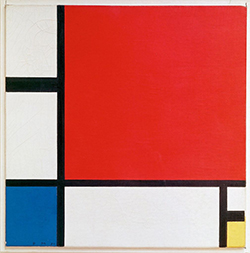 Painting by Piet Mondrian: Composition II in Red, Blue, and Yellow
Painting by Piet Mondrian: Composition II in Red, Blue, and Yellow
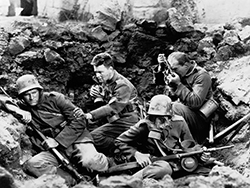 All Quiet on the Western Front wins Academy Award for best picture. This WWI film marked a quantum leap from the winner of the previous year: It's impressive, subtle and moving, an early Hollywood relic that still holds up well in the 21st century.
All Quiet on the Western Front wins Academy Award for best picture. This WWI film marked a quantum leap from the winner of the previous year: It's impressive, subtle and moving, an early Hollywood relic that still holds up well in the 21st century.
1930
(no entry for this year)
Erik Axel Karlfeldt awarded the Nobel Prize in Literature for his poetry.
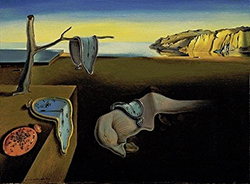 Painting by Salvador Dalí: The Persistence of Memory (Catalan: La persistència de la memòria) is one of his most recognizable works. First shown at the Julien Levy Gallery in 1932, since 1934 the painting has been in the collection of the Museum of Modern Art (MoMA) in New York City, which received it from an anonymous donor. The well-known surrealist piece introduced the image of the soft melting pocket watch. It epitomizes Dalí's theory of "softness" and "hardness", which was central to his thinking at the time. As Dawn Adès wrote, "The soft watches are an unconscious symbol of the relativity of space and time, a Surrealist meditation on the collapse of our notions of a fixed cosmic order". This interpretation suggests that Dalí was incorporating an understanding of the world introduced by Albert Einstein's theory of special relativity. Asked by Ilya Prigogine whether this was in fact the case, Dalí replied that the soft watches were not inspired by the theory of relativity, but by the surrealist perception of a Camembert melting in the sun.
Painting by Salvador Dalí: The Persistence of Memory (Catalan: La persistència de la memòria) is one of his most recognizable works. First shown at the Julien Levy Gallery in 1932, since 1934 the painting has been in the collection of the Museum of Modern Art (MoMA) in New York City, which received it from an anonymous donor. The well-known surrealist piece introduced the image of the soft melting pocket watch. It epitomizes Dalí's theory of "softness" and "hardness", which was central to his thinking at the time. As Dawn Adès wrote, "The soft watches are an unconscious symbol of the relativity of space and time, a Surrealist meditation on the collapse of our notions of a fixed cosmic order". This interpretation suggests that Dalí was incorporating an understanding of the world introduced by Albert Einstein's theory of special relativity. Asked by Ilya Prigogine whether this was in fact the case, Dalí replied that the soft watches were not inspired by the theory of relativity, but by the surrealist perception of a Camembert melting in the sun.
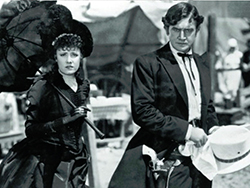 Cimarron wins Academy Award for best picture. This big-scale Hollywood western was based on the novel by Edna Ferber. The land-rush scene is still effective, but the acting is sometimes a reminder that some actors had a hard time making the transition from big theatrical acting to subtler film work.
Cimarron wins Academy Award for best picture. This big-scale Hollywood western was based on the novel by Edna Ferber. The land-rush scene is still effective, but the acting is sometimes a reminder that some actors had a hard time making the transition from big theatrical acting to subtler film work.
1931
(no entry for this year)
 Aldous Huxley publishes Brave New World.
Aldous Huxley publishes Brave New World.
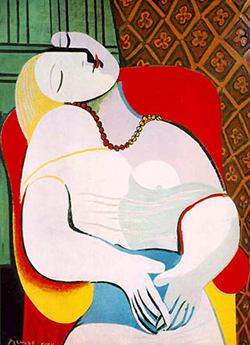 Painting by Pablo Picasso: Le Rêve (French, "The Dream") portrays his 22-year-old mistress Marie-Thérèse Walter. It is said to have been painted in one afternoon, on 24 January 1932. It belongs to Picasso's period of distorted depictions, with its oversimplified outlines and contrasted colors resembling early Fauvism. In 2001, casino magnate Steve Wynn purchased the work for an undisclosed sum, estimated to be about $60 million. In October 2006, Wynn told a group of his friends that he had agreed the day before to sell the painting for $139 million to Steven A. Cohen. At the time, this price would have made Le Rêve the most expensive piece of art ever. While Wynn was showing the painting to his friends, he put his right elbow through the canvas, puncturing the left forearm of the figure and creating a six-inch tear. After a $90,000 repair, the painting was re-valued at $85 million. Wynn filed a claim to recover the $54 million perceived loss from his Lloyd's of London insurers, an amount which would have covered most of the initial cost of buying the painting. When the insurers balked, Wynn sued them in January 2007. The case was eventually settled out of court in March 2007. Cohen bought the painting from Wynn in 2013 for $155 million. The price is estimated to be the highest ever paid, up to that time, for an artwork by a U.S. collector
Painting by Pablo Picasso: Le Rêve (French, "The Dream") portrays his 22-year-old mistress Marie-Thérèse Walter. It is said to have been painted in one afternoon, on 24 January 1932. It belongs to Picasso's period of distorted depictions, with its oversimplified outlines and contrasted colors resembling early Fauvism. In 2001, casino magnate Steve Wynn purchased the work for an undisclosed sum, estimated to be about $60 million. In October 2006, Wynn told a group of his friends that he had agreed the day before to sell the painting for $139 million to Steven A. Cohen. At the time, this price would have made Le Rêve the most expensive piece of art ever. While Wynn was showing the painting to his friends, he put his right elbow through the canvas, puncturing the left forearm of the figure and creating a six-inch tear. After a $90,000 repair, the painting was re-valued at $85 million. Wynn filed a claim to recover the $54 million perceived loss from his Lloyd's of London insurers, an amount which would have covered most of the initial cost of buying the painting. When the insurers balked, Wynn sued them in January 2007. The case was eventually settled out of court in March 2007. Cohen bought the painting from Wynn in 2013 for $155 million. The price is estimated to be the highest ever paid, up to that time, for an artwork by a U.S. collector
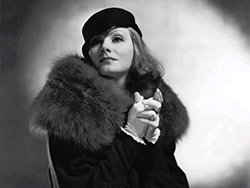 Grand Hotel wins Academy Award for best picture. The multi-story movie was a novelty as MGM gathered multiple big stars for one film. It remains the only best picture winner to take top honors with only one nomination.
Grand Hotel wins Academy Award for best picture. The multi-story movie was a novelty as MGM gathered multiple big stars for one film. It remains the only best picture winner to take top honors with only one nomination.
1932
(no entry for this year)
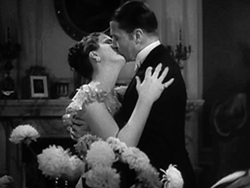 Cavalcade wins Academy Award for best picture. The film was an adaptation of Noel Coward's play chronicling the passage of time as seen through one family. The Titanic figures prominently in one of the episodes, which wasn t the last time that the 1912 disaster was features in an Oscar winner.
Cavalcade wins Academy Award for best picture. The film was an adaptation of Noel Coward's play chronicling the passage of time as seen through one family. The Titanic figures prominently in one of the episodes, which wasn t the last time that the 1912 disaster was features in an Oscar winner.
1933
 Franklin D. Roosevelt becomes thirty-second president of the United States.
Franklin D. Roosevelt becomes thirty-second president of the United States.
Adolf Hitler is appointed German Chancellor; later the same year he is granted dictatorial powers. Events are in motion that will lead to World War II — the greatest military struggle of all time.
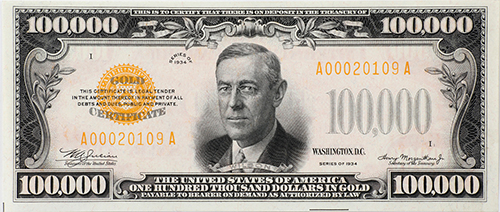 Currency as Art: The United States one-hundred-thousand-dollar bill (US$100,000), created during the Great Depression in response to the hoarding of gold. The bill, which features President Woodrow Wilson, was created as a large denomination note for gold transactions between Federal Reserve Banks; it never circulated publicly and its private possession is illegal. About 42,000 of the $100,000 bills were printed. Many were destroyed in the years following their commission, with the remaining few in possession of the United States federal government. The $100,000 bill, in possession aside from the federal government, is deemed illegal on account of its large denomination and the regulations declared at its signing.
Currency as Art: The United States one-hundred-thousand-dollar bill (US$100,000), created during the Great Depression in response to the hoarding of gold. The bill, which features President Woodrow Wilson, was created as a large denomination note for gold transactions between Federal Reserve Banks; it never circulated publicly and its private possession is illegal. About 42,000 of the $100,000 bills were printed. Many were destroyed in the years following their commission, with the remaining few in possession of the United States federal government. The $100,000 bill, in possession aside from the federal government, is deemed illegal on account of its large denomination and the regulations declared at its signing.
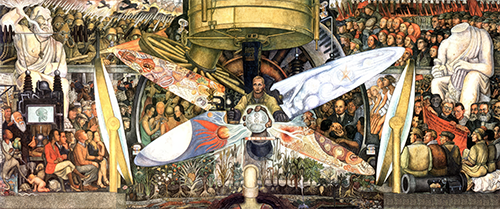 Fresco by Diego Rivera: Man at the Crossroads was intended for New York City's Rockefeller Center. The painting was controversial because it included an image of Lenin and a Soviet Russian May Day parade. Despite protests from artists, Nelson Rockefeller ordered its destruction before it was completed. Only black-and-white photographs exist of the original incomplete mural, taken when Rivera was forced to stop work on it. Using the photographs, Rivera repainted the composition in Mexico under the variant title Man, Controller of the Universe. The creation and destruction of the mural is dramatized in the films Cradle Will Rock (1999) and Frida (2002).
Fresco by Diego Rivera: Man at the Crossroads was intended for New York City's Rockefeller Center. The painting was controversial because it included an image of Lenin and a Soviet Russian May Day parade. Despite protests from artists, Nelson Rockefeller ordered its destruction before it was completed. Only black-and-white photographs exist of the original incomplete mural, taken when Rivera was forced to stop work on it. Using the photographs, Rivera repainted the composition in Mexico under the variant title Man, Controller of the Universe. The creation and destruction of the mural is dramatized in the films Cradle Will Rock (1999) and Frida (2002).
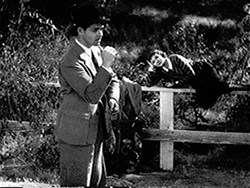 It Happened One Night wins Academy Award for best picture. Frank Capra's film was a surprise winner because nobody predicted the comedy to defeat all the year's serious films. It became the first of only three films to take the top prizes of film, director, screenplay, actor and actress.
It Happened One Night wins Academy Award for best picture. Frank Capra's film was a surprise winner because nobody predicted the comedy to defeat all the year's serious films. It became the first of only three films to take the top prizes of film, director, screenplay, actor and actress.
1934
 In Herndon vs Georgia, the United States Supreme Court sets aside the death sentence of black communist Angelo Herndon, who was convicted under a pre-Civil War slave insurrection statute for passing out leaflets in Atlanta.
In Herndon vs Georgia, the United States Supreme Court sets aside the death sentence of black communist Angelo Herndon, who was convicted under a pre-Civil War slave insurrection statute for passing out leaflets in Atlanta.
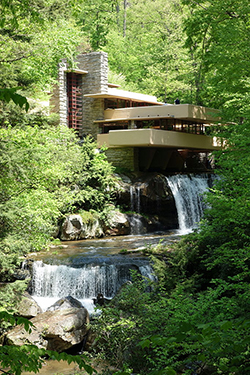 Architecture by Frank Lloyd Wright: Fallingwater or the Kaufmann Residence is a house in rural southwestern Pennsylvania, 43 miles southeast of Pittsburgh. The home was built partly over a waterfall on Bear Run in the Mill Run section of Stewart Township, Fayette County, Pennsylvania, in the Laurel Highlands of the Allegheny Mountains. The house was designed as a weekend home for the family of Liliane Kaufmann and her husband, Edgar J. Kaufmann, owner of Kaufmann's department store. Time cited it after its completion as Wright's "most beautiful job"; it is listed among Smithsonian's Life List of 28 places "to visit before you die". It was designated a National Historic Landmark in 1966. In 1991, members of the American Institute of Architects named the house the "best all-time work of American architecture" and in 2007, it was ranked 29th on the list of America's Favorite Architecture according to the AIA.
Architecture by Frank Lloyd Wright: Fallingwater or the Kaufmann Residence is a house in rural southwestern Pennsylvania, 43 miles southeast of Pittsburgh. The home was built partly over a waterfall on Bear Run in the Mill Run section of Stewart Township, Fayette County, Pennsylvania, in the Laurel Highlands of the Allegheny Mountains. The house was designed as a weekend home for the family of Liliane Kaufmann and her husband, Edgar J. Kaufmann, owner of Kaufmann's department store. Time cited it after its completion as Wright's "most beautiful job"; it is listed among Smithsonian's Life List of 28 places "to visit before you die". It was designated a National Historic Landmark in 1966. In 1991, members of the American Institute of Architects named the house the "best all-time work of American architecture" and in 2007, it was ranked 29th on the list of America's Favorite Architecture according to the AIA.
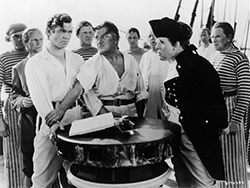 Mutiny on the Bounty wins Academy Award for best picture. The MGM spectacle is the third (and so far, last) film to take top prize with no other wins, after Broadway Melody and Grand Hotel. It is also the only film to have three best actor nominations: Clark Gable, Charles Laughton and Franchot Tone. The overcrowding helped lead to the Academy's creation of the supporting actor and actress categories.
Mutiny on the Bounty wins Academy Award for best picture. The MGM spectacle is the third (and so far, last) film to take top prize with no other wins, after Broadway Melody and Grand Hotel. It is also the only film to have three best actor nominations: Clark Gable, Charles Laughton and Franchot Tone. The overcrowding helped lead to the Academy's creation of the supporting actor and actress categories.
1935
(no entry for this year)
 Photograph by Dorothea Lange: Migrant Mother is one of a series of photographs that Lange made of Florence Owens Thompson and her children in February or March of 1936 in Nipomo, California. Lange was concluding a month's trip photographing migratory farm labor around the state for what was then the Resettlement Administration. The images were made using a Graflex camera. The original negatives are 4x5" film. In 1960, Lange gave this account of the experience: I saw and approached the hungry and desperate mother, as if drawn by a magnet. I do not remember how I explained my presence or my camera to her, but I do remember she asked me no questions. I made five exposures, working closer and closer from the same direction. I did not ask her name or her history. She told me her age, that she was thirty-two. She said that they had been living on frozen vegetables from the surrounding fields, and birds that the children killed. She had just sold the tires from her car to buy food. There she sat in that lean- to tent with her children huddled around her, and seemed to know that my pictures might help her, and so she helped me. There was a sort of equality about it.
Photograph by Dorothea Lange: Migrant Mother is one of a series of photographs that Lange made of Florence Owens Thompson and her children in February or March of 1936 in Nipomo, California. Lange was concluding a month's trip photographing migratory farm labor around the state for what was then the Resettlement Administration. The images were made using a Graflex camera. The original negatives are 4x5" film. In 1960, Lange gave this account of the experience: I saw and approached the hungry and desperate mother, as if drawn by a magnet. I do not remember how I explained my presence or my camera to her, but I do remember she asked me no questions. I made five exposures, working closer and closer from the same direction. I did not ask her name or her history. She told me her age, that she was thirty-two. She said that they had been living on frozen vegetables from the surrounding fields, and birds that the children killed. She had just sold the tires from her car to buy food. There she sat in that lean- to tent with her children huddled around her, and seemed to know that my pictures might help her, and so she helped me. There was a sort of equality about it.
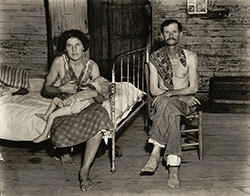 Photograph by Walker Evans: Bud Fields with His Wife Ivy, and His Daughter Ellen, Hale County, Alabama, now in the J. Paul Getty Museum.
Photograph by Walker Evans: Bud Fields with His Wife Ivy, and His Daughter Ellen, Hale County, Alabama, now in the J. Paul Getty Museum.
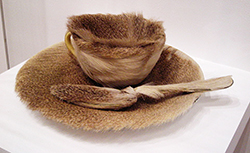 Sculpture by Méret Oppenheim: Object (Le Déjeuner en fourrure) [Object (Breakfast in Fur)]. The sculpture consists of a teacup, saucer and spoon that the artist covered with fur from a Chinese gazelle. The fur suggests an expensively decked-out woman; the cup, hollow yet round, can evoke female genitalia; the spoon with its phallic shape further eroticizes the hairy object. It was purchased by Alfred Barr for the collection of the Museum of Modern Art in New York and included the museum's first surrealist exhibition Fantastic Art: Dada and Surrealism in 1936. Oppenheim was willing to sell the piece for one thousand francs, but Barr only offered her $50 and she accepted. This was the first piece of art that the museum acquired, and Oppenheim became known as the First Lady of MoMA. The enormous success of this early work would later create problems for Oppenheim as an artist. Soon after its creation she drifted away from the Surrealists. Decades later, in 1972, she artistically commented on its dominance of her career by producing a number of "souvenirs" of Le Déjeuner en fourrure.
Sculpture by Méret Oppenheim: Object (Le Déjeuner en fourrure) [Object (Breakfast in Fur)]. The sculpture consists of a teacup, saucer and spoon that the artist covered with fur from a Chinese gazelle. The fur suggests an expensively decked-out woman; the cup, hollow yet round, can evoke female genitalia; the spoon with its phallic shape further eroticizes the hairy object. It was purchased by Alfred Barr for the collection of the Museum of Modern Art in New York and included the museum's first surrealist exhibition Fantastic Art: Dada and Surrealism in 1936. Oppenheim was willing to sell the piece for one thousand francs, but Barr only offered her $50 and she accepted. This was the first piece of art that the museum acquired, and Oppenheim became known as the First Lady of MoMA. The enormous success of this early work would later create problems for Oppenheim as an artist. Soon after its creation she drifted away from the Surrealists. Decades later, in 1972, she artistically commented on its dominance of her career by producing a number of "souvenirs" of Le Déjeuner en fourrure.
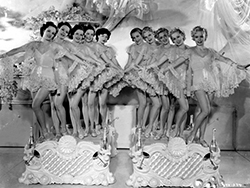 The Great Ziegfeld wins Academy Award for best picture. The film is enlivened by William Powell's performance and by the one sequence for which it's best remembered: A lavish musical number, A Pretty Girl is Like a Melody, that is done in one complex continuous take.
The Great Ziegfeld wins Academy Award for best picture. The film is enlivened by William Powell's performance and by the one sequence for which it's best remembered: A lavish musical number, A Pretty Girl is Like a Melody, that is done in one complex continuous take.
1936
 Track star Jesse Owens wins four gold medals at the Berlin Olympics between August 3 and August 9.
Track star Jesse Owens wins four gold medals at the Berlin Olympics between August 3 and August 9.
German troops occupy the Rhineland in defiance of the treaties of Locarno and Versailles.
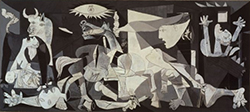 Painting by Pablo Picasso: Guernica is a mural-sized work that Picasso completed in June 1937, at his home on Rue des Grands Augustins, in Paris. The painting, which uses a palette of gray, black, and white, is regarded by many art critics as one of the most moving and powerful anti-war paintings in history. Standing at 3.49 meters (11 ft 5 in) tall and 7.76 meters (25 ft 6 in) wide, the large mural shows the suffering of people wrenched by violence and chaos. Prominent in the composition are a gored horse, a bull, and flames. The painting was created in response to the bombing of Guernica, a Basque Country village in northern Spain, by Nazi German and Fascist Italian warplanes at the request of the Spanish Nationalists. Upon completion, Guernica was exhibited at the Spanish display at the Exposition Internationale des Arts et Techniques dans la Vie Moderne (Paris International Exposition) in the 1937 World's Fair in Paris and then at other venues around the world. The touring exhibition was used to raise funds for Spanish war relief. The painting became famous and widely acclaimed, and it helped bring worldwide attention to the Spanish Civil War.
Painting by Pablo Picasso: Guernica is a mural-sized work that Picasso completed in June 1937, at his home on Rue des Grands Augustins, in Paris. The painting, which uses a palette of gray, black, and white, is regarded by many art critics as one of the most moving and powerful anti-war paintings in history. Standing at 3.49 meters (11 ft 5 in) tall and 7.76 meters (25 ft 6 in) wide, the large mural shows the suffering of people wrenched by violence and chaos. Prominent in the composition are a gored horse, a bull, and flames. The painting was created in response to the bombing of Guernica, a Basque Country village in northern Spain, by Nazi German and Fascist Italian warplanes at the request of the Spanish Nationalists. Upon completion, Guernica was exhibited at the Spanish display at the Exposition Internationale des Arts et Techniques dans la Vie Moderne (Paris International Exposition) in the 1937 World's Fair in Paris and then at other venues around the world. The touring exhibition was used to raise funds for Spanish war relief. The painting became famous and widely acclaimed, and it helped bring worldwide attention to the Spanish Civil War.
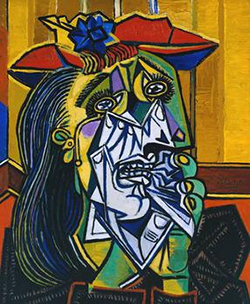 Painting by Pablo Picasso: The Weeping Woman. Picasso was intrigued with the subject, and revisited the theme numerous times that year. This painting was the final and most elaborate of the series. It has been in the collection of the Tate in London since 1987, and is on exhibition at the Tate Modern, London. Dora Maar was Picasso's mistress from 1936 until 1944. In the course of their relationship, Picasso painted her in a number of guises, some realistic, some benign, others tortured or threatening. Picasso explained: For me she's the weeping woman. For years I've painted her in tortured forms, not through sadism, and not with pleasure, either; just obeying a vision that forced itself on me. It was the deep reality, not the superficial one.
Painting by Pablo Picasso: The Weeping Woman. Picasso was intrigued with the subject, and revisited the theme numerous times that year. This painting was the final and most elaborate of the series. It has been in the collection of the Tate in London since 1987, and is on exhibition at the Tate Modern, London. Dora Maar was Picasso's mistress from 1936 until 1944. In the course of their relationship, Picasso painted her in a number of guises, some realistic, some benign, others tortured or threatening. Picasso explained: For me she's the weeping woman. For years I've painted her in tortured forms, not through sadism, and not with pleasure, either; just obeying a vision that forced itself on me. It was the deep reality, not the superficial one.
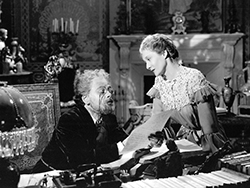 The Life of Emile Zola wins Academy Award for best picture. The bio of French novelist Zola is mostly centered on his passionate defense of Capt. Alfred Dreyfus, who was falsely accused of treason and sentenced to Devil's Island. It's a good old-fashioned Hollywood biopic, with plenty of fictional touches, that is a great showcase for Paul Muni in the title role.
The Life of Emile Zola wins Academy Award for best picture. The bio of French novelist Zola is mostly centered on his passionate defense of Capt. Alfred Dreyfus, who was falsely accused of treason and sentenced to Devil's Island. It's a good old-fashioned Hollywood biopic, with plenty of fictional touches, that is a great showcase for Paul Muni in the title role.
1937
(no entry for this year)
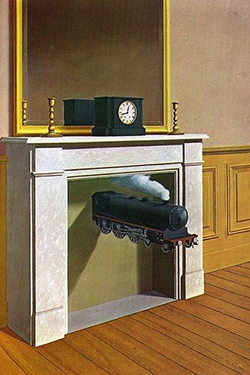 Painting by René Magritte: Time Transfixed (La Durée poignardée) is part of the permanent collection of the Art Institute of Chicago and is usually on display in the museum's new Modern Wing. The painting was one of many done for surrealist patron and Magritte supporter Edward James. The painting depicts a locomotive jutting out of a fireplace, at full steam, in an empty room. Above the mantelpiece is a tall mirror. Only the clock and one candlestick standing on the mantelpiece are reflected in the mirror. The title of the painting translates to English literally as "Ongoing Time Stabbed by a Dagger" and Magritte was reportedly unhappy with the generally accepted translation of "Time Transfixed".
Painting by René Magritte: Time Transfixed (La Durée poignardée) is part of the permanent collection of the Art Institute of Chicago and is usually on display in the museum's new Modern Wing. The painting was one of many done for surrealist patron and Magritte supporter Edward James. The painting depicts a locomotive jutting out of a fireplace, at full steam, in an empty room. Above the mantelpiece is a tall mirror. Only the clock and one candlestick standing on the mantelpiece are reflected in the mirror. The title of the painting translates to English literally as "Ongoing Time Stabbed by a Dagger" and Magritte was reportedly unhappy with the generally accepted translation of "Time Transfixed".
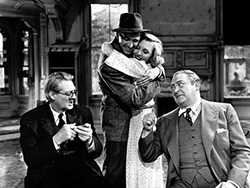 You Can't Take It with You wins Academy Award for best picture. This was the second Frank Capra film to take the top prize. The film is a sweet, zany comedy, but many pundits think that a major factor in its win was Capra's crucial role in keeping the peace between studios and the new guilds; some had predicted a long strike. Others predicted the end of Hollywood.
You Can't Take It with You wins Academy Award for best picture. This was the second Frank Capra film to take the top prize. The film is a sweet, zany comedy, but many pundits think that a major factor in its win was Capra's crucial role in keeping the peace between studios and the new guilds; some had predicted a long strike. Others predicted the end of Hollywood.
1938
(no entry for this year)
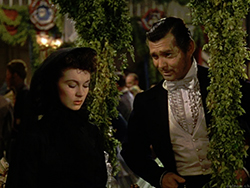 Gone with the Wind wins Academy Award for best picture. Producer David O. Selznick optioned Margaret Mitchell's novel before it became a huge best-seller, and his search for an actress to play Scarlett O Hara was a pinnacle of Hollywood publicity. Anticipation was ridiculously high when the film opened, but fans embraced the movie and star Vivien Leigh, who won an Oscar (one of eight that the film earned). It also happened to be the only color film to take the Best Picture prize in the Academy's first 23 years.
Gone with the Wind wins Academy Award for best picture. Producer David O. Selznick optioned Margaret Mitchell's novel before it became a huge best-seller, and his search for an actress to play Scarlett O Hara was a pinnacle of Hollywood publicity. Anticipation was ridiculously high when the film opened, but fans embraced the movie and star Vivien Leigh, who won an Oscar (one of eight that the film earned). It also happened to be the only color film to take the Best Picture prize in the Academy's first 23 years.
1939
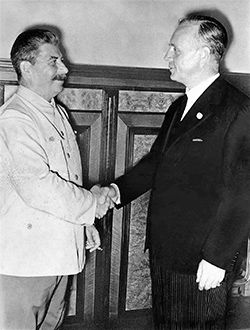 August 23, the Molotov–Ribbentrop Pact, officially the Treaty of Non-Aggression between Germany and the Union of Soviet Socialist Republics, and also known as the Hitler–Stalin Pact and the Nazi–Soviet Pact, was a non-aggression pact between Nazi Germany and the Soviet Union, with a secret protocol establishing Soviet and German spheres of influence across Northern Europe. The pact was signed in Moscow by Soviet Foreign Minister Vyacheslav Molotov and German Foreign Minister Joachim von Ribbentrop. One week after signing the pact, on 1 September 1939, Germany invaded Poland.
August 23, the Molotov–Ribbentrop Pact, officially the Treaty of Non-Aggression between Germany and the Union of Soviet Socialist Republics, and also known as the Hitler–Stalin Pact and the Nazi–Soviet Pact, was a non-aggression pact between Nazi Germany and the Soviet Union, with a secret protocol establishing Soviet and German spheres of influence across Northern Europe. The pact was signed in Moscow by Soviet Foreign Minister Vyacheslav Molotov and German Foreign Minister Joachim von Ribbentrop. One week after signing the pact, on 1 September 1939, Germany invaded Poland.
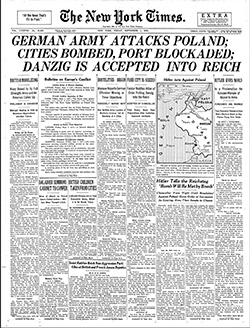 September 1, Germany invades Poland; Britain and France declare war on Germany on September 3. Soviet troops invade Poland. World War II begins.
September 1, Germany invades Poland; Britain and France declare war on Germany on September 3. Soviet troops invade Poland. World War II begins.
 September 1, George C. Marshall is sworn in as Chief of Staff of the US Army. After the war, Churchill refers to Marshall (the only military leader to serve through the entirety of WW II) as the Architect of Victory for his crucial role in ensuring the defeat of the Axis Powers. The very day that Hitler launches all-out war in Europe, the man who will oversee his defeat takes command of the US Military — a military that, at the time, contained only 334,000 total personnel.
September 1, George C. Marshall is sworn in as Chief of Staff of the US Army. After the war, Churchill refers to Marshall (the only military leader to serve through the entirety of WW II) as the Architect of Victory for his crucial role in ensuring the defeat of the Axis Powers. The very day that Hitler launches all-out war in Europe, the man who will oversee his defeat takes command of the US Military — a military that, at the time, contained only 334,000 total personnel.
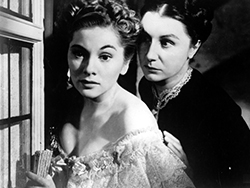 Rebecca wins Academy Award for best picture. The darkest aspects of the Daphne du Maurier novel were cleaned up a little, but the film was popular then and still remains a fan favorite. It's the only Alfred Hitchcock film to take the top Academy Award.
Rebecca wins Academy Award for best picture. The darkest aspects of the Daphne du Maurier novel were cleaned up a little, but the film was popular then and still remains a fan favorite. It's the only Alfred Hitchcock film to take the top Academy Award.
1940
(no entry for this year)
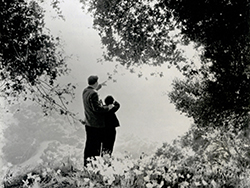 How Green Was My Valley wins Academy Award for best picture. The drama was set in a Welsh mining village, with director John Ford winning one of the film's five Oscars. Even then, many were surprised that the movie beat Orson Welles Citizen Kane, but a Variety reporter at the time attributed that to the 6,000 movie extras who voted on Oscar's top prize: The mob prefers a regular guy to a genius.
How Green Was My Valley wins Academy Award for best picture. The drama was set in a Welsh mining village, with director John Ford winning one of the film's five Oscars. Even then, many were surprised that the movie beat Orson Welles Citizen Kane, but a Variety reporter at the time attributed that to the 6,000 movie extras who voted on Oscar's top prize: The mob prefers a regular guy to a genius.
1941
Between 1941 and 1945, the desperate need for labor in US defense plants and shipyards leads to the migration of 1.2 million African-Americans from the South to the North and West. This migration transforms American politics as blacks increasingly vote in their new homes and put pressure on Congress to protect civil rights throughout the nation. Their activism lays much of the foundation for the national civil rights movement a decade later.
On June 25, Pres. Franklin Roosevelt issues Executive Order 8802, which desegregates US defense plants and shipyards and creates the Fair Employment Practices Committee.
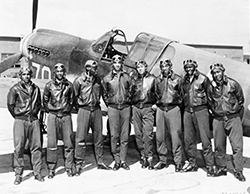 The US Army creates the Tuskegee Air Squadron (the 99th Pursuit Squadron) — an all African-American flying unit.
The US Army creates the Tuskegee Air Squadron (the 99th Pursuit Squadron) — an all African-American flying unit.
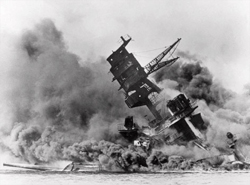 07 DEC 1941: Pearl Harbor bombed by Japanese The US immediately declares war on Japan. Germany quickly declares war on the United States. The US is now a full participant in World War II.
07 DEC 1941: Pearl Harbor bombed by Japanese The US immediately declares war on Japan. Germany quickly declares war on the United States. The US is now a full participant in World War II.
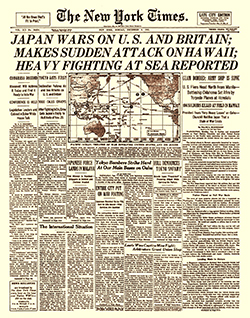 08 DEC 1941: The US responds to Pearl Harbor. President to address joint session of Congress. Declaration of War expected.
08 DEC 1941: The US responds to Pearl Harbor. President to address joint session of Congress. Declaration of War expected.
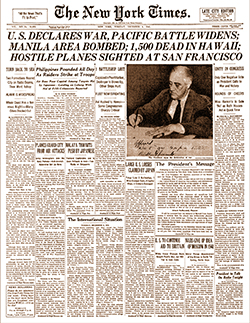 09 DEC 1941: The United States formally declares War on Japan.
09 DEC 1941: The United States formally declares War on Japan.
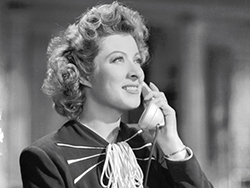 Mrs. Miniver wins Academy Award for best picture. The film, about a British family during the early days of World War II, came at just the right time, reassuring Americans that their newish war effort was the right decision.
Mrs. Miniver wins Academy Award for best picture. The film, about a British family during the early days of World War II, came at just the right time, reassuring Americans that their newish war effort was the right decision.
1942
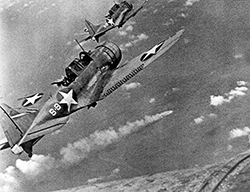 4-7 JUN 1942: The Battle of Midway occurs. Less than six months after Pearl Harbor the Japanese navy attempts to lure the remnants of the US Navy into a decisive battle at Midway Island. The Japanese plan backfires, as the battle proves to be a huge victory for US forces and the turning point in the war in the Pacific.
4-7 JUN 1942: The Battle of Midway occurs. Less than six months after Pearl Harbor the Japanese navy attempts to lure the remnants of the US Navy into a decisive battle at Midway Island. The Japanese plan backfires, as the battle proves to be a huge victory for US forces and the turning point in the war in the Pacific.
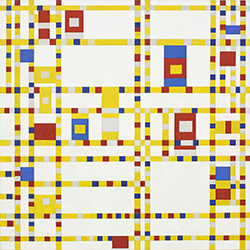 Painting by Piet Mondrian: Broadway Boogie Woogie was completed in 1943, shortly after Mondrian moved to New York in 1940. Compared to his earlier work, the canvas is divided into a much larger number of squares. Although he spent most of his career creating abstract work, this painting is inspired by clear real-world examples: the city grid of Manhattan, and the Broadway boogie woogie, a type of music Mondrian loved. The painting was bought by the Brazilian sculptor Maria Martins for the price of $800 at the Valentine Gallery in New York City, after Martins and Mondrian both exhibited there in 1943. Martins later donated the painting to the Museum of Modern Art in New York City.
Painting by Piet Mondrian: Broadway Boogie Woogie was completed in 1943, shortly after Mondrian moved to New York in 1940. Compared to his earlier work, the canvas is divided into a much larger number of squares. Although he spent most of his career creating abstract work, this painting is inspired by clear real-world examples: the city grid of Manhattan, and the Broadway boogie woogie, a type of music Mondrian loved. The painting was bought by the Brazilian sculptor Maria Martins for the price of $800 at the Valentine Gallery in New York City, after Martins and Mondrian both exhibited there in 1943. Martins later donated the painting to the Museum of Modern Art in New York City.
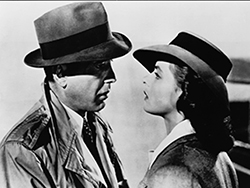 Casablanca wins Academy Award for best picture. The WWII drama represents the studio system at its best, where all the talent (behind and in front of the camera) worked at their peak. Humphrey Bogart and Ingrid Bergman were not the studio's first choices for their roles, but they remain one of the screen's all-time great romantic pairings.
Casablanca wins Academy Award for best picture. The WWII drama represents the studio system at its best, where all the talent (behind and in front of the camera) worked at their peak. Humphrey Bogart and Ingrid Bergman were not the studio's first choices for their roles, but they remain one of the screen's all-time great romantic pairings.
1943
(no entry for this year)
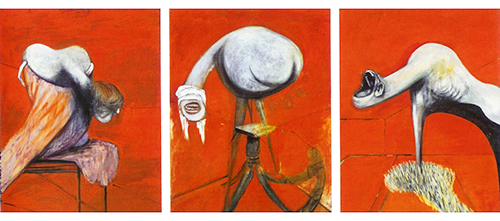 Triptych by Francis Bacon: Three Studies for Figures at the Base of a Crucifixion comprises three canvasses that are based on the Eumenides — or Furies — of Aeschylus's Oresteia, and that depict three writhing anthropomorphic creatures set against a flat burnt orange background. It was executed in oil paint and pastel on Sundeala fibre board and completed within two weeks. The triptych summarises themes explored in Bacon's previous work, including his examination of Picasso's biomorphs and his interpretations of the Crucifixion and the Greek Furies. The Three Studies are generally considered Bacon's first mature piece. When the painting was first exhibited in 1945 it caused a sensation and established him as one of the foremost post-war painters. Remarking on the cultural significance of Three Studies, the critic John Russell observed in 1971 that "there was painting in England before the Three Studies, and painting after them, and no one ... can confuse the two".
Triptych by Francis Bacon: Three Studies for Figures at the Base of a Crucifixion comprises three canvasses that are based on the Eumenides — or Furies — of Aeschylus's Oresteia, and that depict three writhing anthropomorphic creatures set against a flat burnt orange background. It was executed in oil paint and pastel on Sundeala fibre board and completed within two weeks. The triptych summarises themes explored in Bacon's previous work, including his examination of Picasso's biomorphs and his interpretations of the Crucifixion and the Greek Furies. The Three Studies are generally considered Bacon's first mature piece. When the painting was first exhibited in 1945 it caused a sensation and established him as one of the foremost post-war painters. Remarking on the cultural significance of Three Studies, the critic John Russell observed in 1971 that "there was painting in England before the Three Studies, and painting after them, and no one ... can confuse the two".
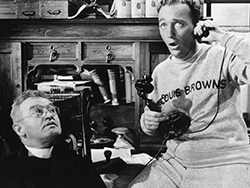 Going My Way wins Academy Award for best picture. Writer-director Leo McCarey once again proved his ability to balance tears and laughs, in this tale of a rule-breaking priest (Oscar winner Bing Crosby) taking over a New York parish from a retiring priest. In the latter role, Barry Fitzgerald was oddly nominated as both lead and supporting actor, winning in the latter category.
Going My Way wins Academy Award for best picture. Writer-director Leo McCarey once again proved his ability to balance tears and laughs, in this tale of a rule-breaking priest (Oscar winner Bing Crosby) taking over a New York parish from a retiring priest. In the latter role, Barry Fitzgerald was oddly nominated as both lead and supporting actor, winning in the latter category.
1944
On April 3, the United States Supreme Court in Smith vs. Allright declares white-only political primaries unconstitutional.
 D-Day landing On June 6th, the largest amphibious force ever assembled, led by General Dwight D. Eisenhower, successfully attacks and establishes a landing on the coast of France at Normandy.
D-Day landing On June 6th, the largest amphibious force ever assembled, led by General Dwight D. Eisenhower, successfully attacks and establishes a landing on the coast of France at Normandy.
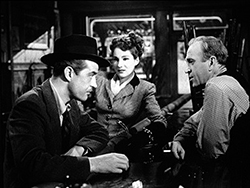 The Lost Weekend wins Academy Award for best picture. The film, directed by Billy Wilder, was widely admired even though it was controversial: Though movies had featured drunks since the silent days, it was considered daring to address the subject head-on.
The Lost Weekend wins Academy Award for best picture. The film, directed by Billy Wilder, was widely admired even though it was controversial: Though movies had featured drunks since the silent days, it was considered daring to address the subject head-on.
1945
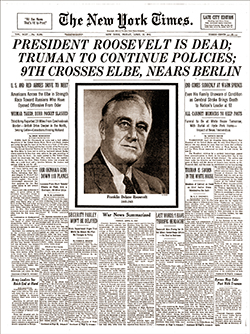 13 APR 1945: President Roosevelt dies in office.
13 APR 1945: President Roosevelt dies in office.
 Harry S. Truman becomes thirty-third president of the United States.
Harry S. Truman becomes thirty-third president of the United States.
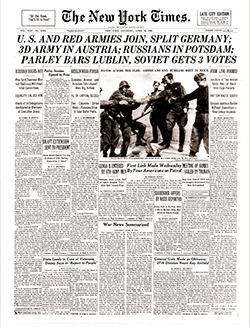 28 APR 1945: US and Russian troops meet. Germany split in two.
28 APR 1945: US and Russian troops meet. Germany split in two.
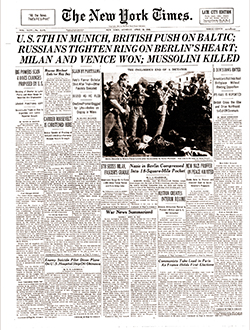 30 APR 1945: Press reports Mussolini killed by Italian partisans, his body abused. Hitler commits suicide by gunshot while hiding in his Führerbunker, but news of his death will not surface for a few days.
30 APR 1945: Press reports Mussolini killed by Italian partisans, his body abused. Hitler commits suicide by gunshot while hiding in his Führerbunker, but news of his death will not surface for a few days.
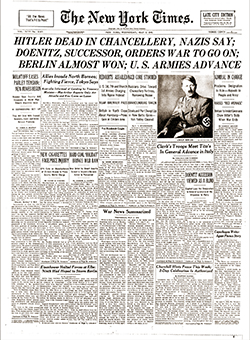 02 MAY 1945: Hitler reported dead..
02 MAY 1945: Hitler reported dead..
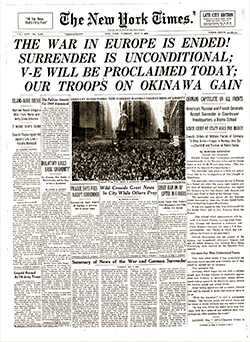 08 MAY 1945: Germany surrenders unconditionally. The war in Europe is over.
08 MAY 1945: Germany surrenders unconditionally. The war in Europe is over.
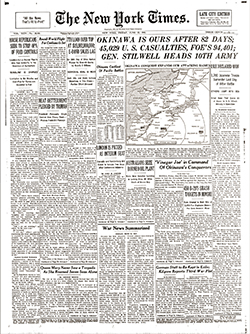 22 JUN 1945: Okinawa falls after 82 days of fierce fighting.
22 JUN 1945: Okinawa falls after 82 days of fierce fighting.
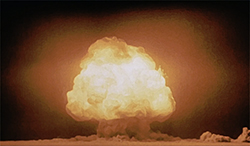 16 JUL 1945: The Manhattan Project yields results — the world's first atomic bomb is secretly tested in New Mexico.
16 JUL 1945: The Manhattan Project yields results — the world's first atomic bomb is secretly tested in New Mexico.
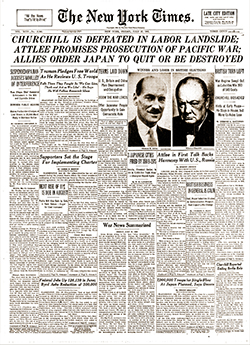 27 JUL 1945: Churchill is defeated in British elections. Potsdam Declaration is reported, calling for Japan to surrender unconditionally or face "prompt and utter destruction."
27 JUL 1945: Churchill is defeated in British elections. Potsdam Declaration is reported, calling for Japan to surrender unconditionally or face "prompt and utter destruction."
 06 AUG 1945: the first atomic bomb used in combat is dropped on Hiroshima, Japan.
06 AUG 1945: the first atomic bomb used in combat is dropped on Hiroshima, Japan.
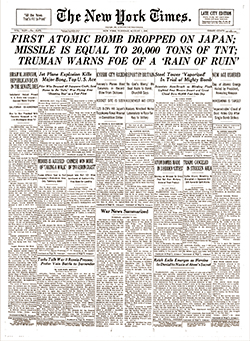 07 AUG 1945: The world learns about the atomic bomb. President Truman announces "The force from which the sun draws its power has been loosed against those who brought war to the Far East" and he calls upon Japan to immediately accept the terms of the Potsdam Declaration or expect a rain of ruin from the air, the like of which has never been seen on this earth."
07 AUG 1945: The world learns about the atomic bomb. President Truman announces "The force from which the sun draws its power has been loosed against those who brought war to the Far East" and he calls upon Japan to immediately accept the terms of the Potsdam Declaration or expect a rain of ruin from the air, the like of which has never been seen on this earth."
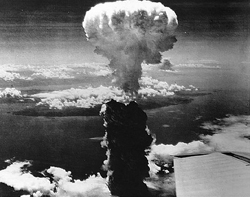 09 AUG 1945: The second atomic bomb used in combat is dropped on Nagasaki, Japan. The primary target for this mission was actually the city of Kokura, but the bomber crew moved on to the secondary target of Nagasaki when Kokura proved to be too obscured by smoke to get a clear view for the bombsight. Russia declares war on japan.
09 AUG 1945: The second atomic bomb used in combat is dropped on Nagasaki, Japan. The primary target for this mission was actually the city of Kokura, but the bomber crew moved on to the secondary target of Nagasaki when Kokura proved to be too obscured by smoke to get a clear view for the bombsight. Russia declares war on japan.
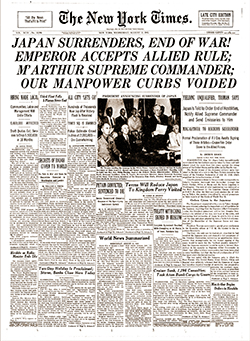 15 AUG 1945: In the afternoon of August 15th (Japanese time), Japan announces its unconditional surrender. World War II is finally over. More than 60 million people have died as a result of the conflict.
15 AUG 1945: In the afternoon of August 15th (Japanese time), Japan announces its unconditional surrender. World War II is finally over. More than 60 million people have died as a result of the conflict.
 Col. Benjamin O. Davis, Jr, is named commander of Godman Field, Kentucky. He is the first African-American to command a United States military base.
Col. Benjamin O. Davis, Jr, is named commander of Godman Field, Kentucky. He is the first African-American to command a United States military base.
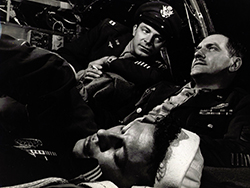 The Best Years of Our Lives wins Academy Award for best picture. The world population was just adjusting to life after World War II and some film executives feared that audiences wanted escapism, not a movie reflecting their lives. But it was a huge hit, and its honesty in dealing with civilian changes and vulnerabilities are still powerful. It was produced by Samuel Goldwyn, directed by William Wyler.
The Best Years of Our Lives wins Academy Award for best picture. The world population was just adjusting to life after World War II and some film executives feared that audiences wanted escapism, not a movie reflecting their lives. But it was a huge hit, and its honesty in dealing with civilian changes and vulnerabilities are still powerful. It was produced by Samuel Goldwyn, directed by William Wyler.
1946
The United States Supreme Court, in Morgan vs Virginia, rules that segregation in interstate bus travel is unconstitutional.
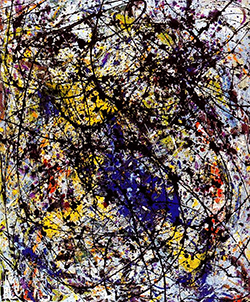 Painting by Jackson Pollock: Reflections of the Big Dipper, consisting of built up layers of paint with dripped enamel as the final touch, concluding the composition. It was around 1947 that Jackson Pollock traded in his brushes for sticks, trowels and knives and began adding foreign matter, such as sand, broken glass, nails, coins, paint-tube tops and bottle caps to his canvases. Reflection of the Big Dipper was exhibited at the Betty Parsons Gallery in 1948, along with sixteen other paintings by Jackson Pollock. The show received positive reviews. Pollock's works from this time are a transitional step between a more traditional handling of paint and his revolutionary technique of dripping paint on canvases off a large scale.
Painting by Jackson Pollock: Reflections of the Big Dipper, consisting of built up layers of paint with dripped enamel as the final touch, concluding the composition. It was around 1947 that Jackson Pollock traded in his brushes for sticks, trowels and knives and began adding foreign matter, such as sand, broken glass, nails, coins, paint-tube tops and bottle caps to his canvases. Reflection of the Big Dipper was exhibited at the Betty Parsons Gallery in 1948, along with sixteen other paintings by Jackson Pollock. The show received positive reviews. Pollock's works from this time are a transitional step between a more traditional handling of paint and his revolutionary technique of dripping paint on canvases off a large scale.
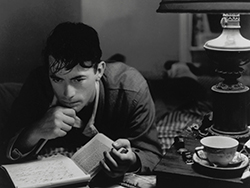 Gentleman's Agreement wins Academy Award for best picture. The Elia Kazan-directed drama, starring Gregory Peck, was another hot-button winner, as it addressed the topic of anti-Semitism.
Gentleman's Agreement wins Academy Award for best picture. The Elia Kazan-directed drama, starring Gregory Peck, was another hot-button winner, as it addressed the topic of anti-Semitism.
1947
 On April 10, Jackie Robinson of the Brooklyn Dodgers becomes the first African-American to play major league baseball in the 20th century.
On April 10, Jackie Robinson of the Brooklyn Dodgers becomes the first African-American to play major league baseball in the 20th century.
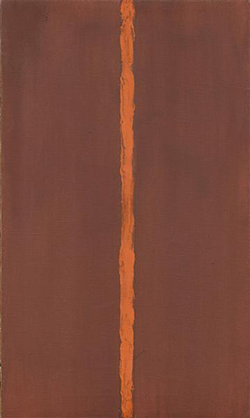 Painting by Barnett Newman: Onement I features the first full incarnation of what Newman later called a 'zip', a vertical band of color. This motif would play a central role in many of his subsequent paintings. The painting's title is an archaic derivation of the word 'atonement', meaning, "the state of being made into one."
Painting by Barnett Newman: Onement I features the first full incarnation of what Newman later called a 'zip', a vertical band of color. This motif would play a central role in many of his subsequent paintings. The painting's title is an archaic derivation of the word 'atonement', meaning, "the state of being made into one."
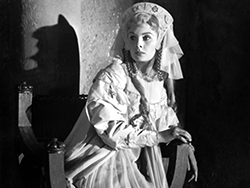 Hamlet wins Academy Award for best picture. The black and white Shakespeare adaptation, from U.K.'s J. Arthur Rank-Two Cities, was the first non-Hollywood film to take the top award. And Laurence Olivier became the first person to direct himself to a best-actor win.
Hamlet wins Academy Award for best picture. The black and white Shakespeare adaptation, from U.K.'s J. Arthur Rank-Two Cities, was the first non-Hollywood film to take the top award. And Laurence Olivier became the first person to direct himself to a best-actor win.
1948
On July 26, Pres. Harry Truman issues Executive Order 9981, directing the desegregation of the armed forces.
The United States Supreme Court, in Shelley vs Kraemer, rules that racially restrictive covenants are legally unenforceable.
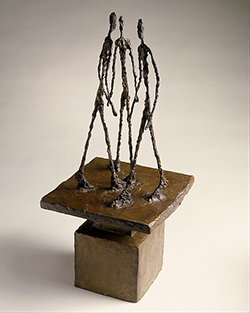 Alberto Giacometti completes Three Men Walking II
Alberto Giacometti completes Three Men Walking II
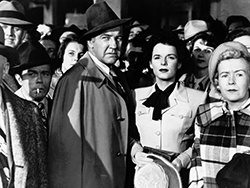 All the King's Men wins Academy Award for best picture. The movie, written and directed by Robert Rossen (nominated in both categories), was based on the novel by Robert Penn Warren. It was a thinly disguised version of Louisiana's Huey Long, and the film's observations about politics still hold up surprisingly well.
All the King's Men wins Academy Award for best picture. The movie, written and directed by Robert Rossen (nominated in both categories), was based on the novel by Robert Penn Warren. It was a thinly disguised version of Louisiana's Huey Long, and the film's observations about politics still hold up surprisingly well.
1949
(no entry for this year)
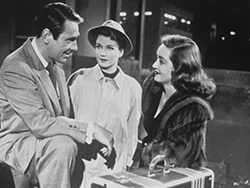 All about Eve wins Academy Award for best picture. Three of the year's five best picture nominees were dominated by great female performances: Born Yesterday, Sunset Blvd. and All About Eve. But Joseph Mankiewicz's witty tale about Broadway competition was the one that ended up in the winner's circle.
All about Eve wins Academy Award for best picture. Three of the year's five best picture nominees were dominated by great female performances: Born Yesterday, Sunset Blvd. and All About Eve. But Joseph Mankiewicz's witty tale about Broadway competition was the one that ended up in the winner's circle.
1950
(no entry for this year)
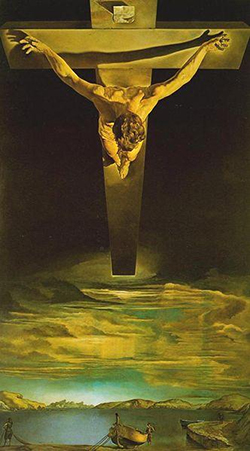 Painting by Salvador Dalí: Christ of Saint John of the Cross depicts Jesus Christ on the cross in a darkened sky floating over a body of water complete with a boat and fishermen. Although it is a depiction of the crucifixion, it is devoid of nails, blood, and a crown of thorns, because, according to Dalí, he was convinced by a dream that these features would mar his depiction of Christ. Also in a dream, the importance of depicting Christ in the extreme angle evident in the painting was revealed to him.
Painting by Salvador Dalí: Christ of Saint John of the Cross depicts Jesus Christ on the cross in a darkened sky floating over a body of water complete with a boat and fishermen. Although it is a depiction of the crucifixion, it is devoid of nails, blood, and a crown of thorns, because, according to Dalí, he was convinced by a dream that these features would mar his depiction of Christ. Also in a dream, the importance of depicting Christ in the extreme angle evident in the painting was revealed to him.
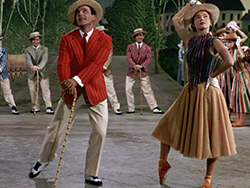 An American in Paris wins Academy Award for best picture. This Vincent Minnelli musical starring Gene Kelly, was a surprise winner. Producer Arthur Freed took home the Oscar, starting the Academy's new policy of giving the award to an individual producer, rather than the studio. After Gone with the Wind, this was the second best-pic winner in color.
An American in Paris wins Academy Award for best picture. This Vincent Minnelli musical starring Gene Kelly, was a surprise winner. Producer Arthur Freed took home the Oscar, starting the Academy's new policy of giving the award to an individual producer, rather than the studio. After Gone with the Wind, this was the second best-pic winner in color.
1951
 On May 24, a mob of 3500 whites attempt to prevent a black family from moving into an apartment in Cicero, Illinois. Illinois Gov. Adlai Stevenson calls out the Illinois National Guard to protect the family and restore order.
On May 24, a mob of 3500 whites attempt to prevent a black family from moving into an apartment in Cicero, Illinois. Illinois Gov. Adlai Stevenson calls out the Illinois National Guard to protect the family and restore order.
On May 24, the United States Supreme Court rules that racial segregation in District of Columbia restaurants is unconstitutional.
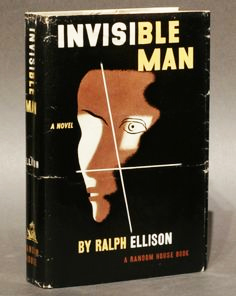 Ralph Ellison publishes Invisible Man.
Ralph Ellison publishes Invisible Man.
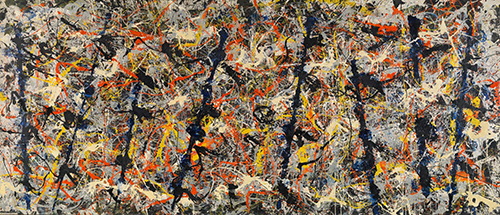 Painting by Jackson Pollock: Number 11, 1952, also known as Blue Poles, is one of the most famous works by American artist Jackson Pollock. It was purchased amid controversy by the National Gallery of Australia in 1973 and today remains one of the gallery's major paintings. At the time of the painting's creation, Pollock preferred not to assign names to his works, but rather numbers; hence, the original title of the painting was simply "Number 11"' or "No. 11" for the year 1952. In 1954, the new title Blue Poles was first seen at an exhibition at the Sidney Janis Gallery and reportedly originated from Pollock himself. According to art historian Dennis Phillips, the specific rather than ambiguous title "limits our field of comprehension and does the painting a singular disservice. Because we look for the poles and miss much of the rest, the name is simply too distracting."
Painting by Jackson Pollock: Number 11, 1952, also known as Blue Poles, is one of the most famous works by American artist Jackson Pollock. It was purchased amid controversy by the National Gallery of Australia in 1973 and today remains one of the gallery's major paintings. At the time of the painting's creation, Pollock preferred not to assign names to his works, but rather numbers; hence, the original title of the painting was simply "Number 11"' or "No. 11" for the year 1952. In 1954, the new title Blue Poles was first seen at an exhibition at the Sidney Janis Gallery and reportedly originated from Pollock himself. According to art historian Dennis Phillips, the specific rather than ambiguous title "limits our field of comprehension and does the painting a singular disservice. Because we look for the poles and miss much of the rest, the name is simply too distracting."
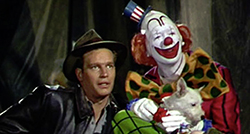 The Greatest Show on Earth wins Academy Award for best picture. Director Cecil B. DeMille was a showman since the silent days of movies, but this was his first to take the Best Picture Academy Award, with his colorful and gaudy spectacle about life in the circus.
The Greatest Show on Earth wins Academy Award for best picture. Director Cecil B. DeMille was a showman since the silent days of movies, but this was his first to take the Best Picture Academy Award, with his colorful and gaudy spectacle about life in the circus.
1952
(no entry for this year)
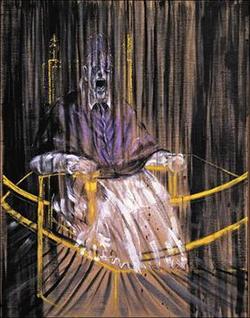 Painting by Francis Bacon: Study after Velázquez's Portrait of Pope Innocent X shows a distorted version of the Portrait of Innocent X painted by Spanish artist Diego Velázquez in 1650. The work is one of a series of over 45 variants of the Velázquez painting which Bacon executed throughout the 1950s and early 1960s. The picture was described by Gilles Deleuze as an example of creative re-interpretation of the classical. When asked why he was compelled to revisit the subject so often, Bacon replied that he had nothing against the Popes, that he merely sought "an excuse to use these colours, and you can't give ordinary clothes that purple colour without getting into a sort of false fauve manner".
Painting by Francis Bacon: Study after Velázquez's Portrait of Pope Innocent X shows a distorted version of the Portrait of Innocent X painted by Spanish artist Diego Velázquez in 1650. The work is one of a series of over 45 variants of the Velázquez painting which Bacon executed throughout the 1950s and early 1960s. The picture was described by Gilles Deleuze as an example of creative re-interpretation of the classical. When asked why he was compelled to revisit the subject so often, Bacon replied that he had nothing against the Popes, that he merely sought "an excuse to use these colours, and you can't give ordinary clothes that purple colour without getting into a sort of false fauve manner".
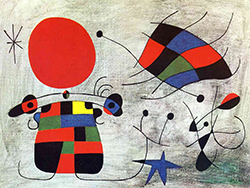 Painting by Joan Miró: The Smile of the Flamboyant Wings — the first in a series of similarly impulsive paintings. Some even feature Miro's handprints — a pleading gesture for which he derived his inspiration from pre-historic cave drawings. The use of materials and gestures became increasingly important factors in Miro's works. For a while he devoted himself exclusively to ceramics and developed some new techniques together with Artigas. It was with great energy that Miro subsequently took up painting again in 1960. With his new large-format paintings he picked up the thread of his series of pictures of 1953/54, while at the same time developing them further in the direction of poetic sensitivity.
Painting by Joan Miró: The Smile of the Flamboyant Wings — the first in a series of similarly impulsive paintings. Some even feature Miro's handprints — a pleading gesture for which he derived his inspiration from pre-historic cave drawings. The use of materials and gestures became increasingly important factors in Miro's works. For a while he devoted himself exclusively to ceramics and developed some new techniques together with Artigas. It was with great energy that Miro subsequently took up painting again in 1960. With his new large-format paintings he picked up the thread of his series of pictures of 1953/54, while at the same time developing them further in the direction of poetic sensitivity.
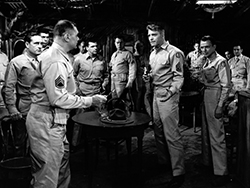 From Here to Eternity wins Academy Award for best picture. Daniel Taradash adapted James Jones novel into a great screenplay, augmented by Fred Zinnemann's smart direction. Burt Lancaster topped a strong cast in the tale of military lives in Hawaii just before the bombing of Pearl Harbor.
From Here to Eternity wins Academy Award for best picture. Daniel Taradash adapted James Jones novel into a great screenplay, augmented by Fred Zinnemann's smart direction. Burt Lancaster topped a strong cast in the tale of military lives in Hawaii just before the bombing of Pearl Harbor.
1953
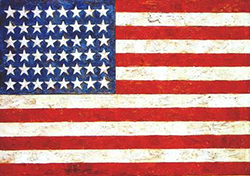 Painting by Jasper Johns: Flag is an encaustic painting created when Johns was 24 (1954-55), two years after he was discharged from the US Army. This painting was the first of many works that Johns has said were inspired by a dream of the U.S. flag in 1954. It is arguably the painting for which Johns is best known. The US flag was in the news repeatedly in 1954. The McCarthy hearings came to a close on 17 June 1954, only three days after Flag Day. On Flag Day, U.S. President Dwight D. Eisenhower signed an amendment to the pledge of allegiance to add the words "under God." The New York Times ran article on facts and myths associated with the flag on the day before Flag Day, and then an article on the "discipline" of the flag on Flag Day itself, saying, with reference to a national air-raid drill "we are all soldiers now". Francis Scott Key, composer of "The Star Spangled Banner", was born in 1779, 175 years before 1954. The Iwo Jima Marine Memorial at Arlington National Cemetery, with its large US flag, was dedicated on 11 November 1954. Johns and his father were both named after Sergeant William Jasper, who saved the fallen flag of the Americans at Fort Moultrie in the American Revolutionary War. The work measures 42.2 inches by 60.6 inches. It is made using encaustic, oil paint, and newsprint collage on three separate canvases, mounted on a plywood board. The painting reflects the three colors of the US flag: red, white and blue; the flag is depicted in the form it took between 1912 and 1959, with 48 white stars on a blue canton representing the then-US states (excluding Alaska and Hawaii), and with thirteen red and white stripes. Newsprint is visible under the stripes. Reading the texts, it is clear that the newsprint was not selected at random: Johns steered clear of headlines, or national or political news, and used inconsequential articles or adverts. The painting has a rough-textured surface, and the 48 stars are not identical. It is dated 1954 on its reverse.
Painting by Jasper Johns: Flag is an encaustic painting created when Johns was 24 (1954-55), two years after he was discharged from the US Army. This painting was the first of many works that Johns has said were inspired by a dream of the U.S. flag in 1954. It is arguably the painting for which Johns is best known. The US flag was in the news repeatedly in 1954. The McCarthy hearings came to a close on 17 June 1954, only three days after Flag Day. On Flag Day, U.S. President Dwight D. Eisenhower signed an amendment to the pledge of allegiance to add the words "under God." The New York Times ran article on facts and myths associated with the flag on the day before Flag Day, and then an article on the "discipline" of the flag on Flag Day itself, saying, with reference to a national air-raid drill "we are all soldiers now". Francis Scott Key, composer of "The Star Spangled Banner", was born in 1779, 175 years before 1954. The Iwo Jima Marine Memorial at Arlington National Cemetery, with its large US flag, was dedicated on 11 November 1954. Johns and his father were both named after Sergeant William Jasper, who saved the fallen flag of the Americans at Fort Moultrie in the American Revolutionary War. The work measures 42.2 inches by 60.6 inches. It is made using encaustic, oil paint, and newsprint collage on three separate canvases, mounted on a plywood board. The painting reflects the three colors of the US flag: red, white and blue; the flag is depicted in the form it took between 1912 and 1959, with 48 white stars on a blue canton representing the then-US states (excluding Alaska and Hawaii), and with thirteen red and white stripes. Newsprint is visible under the stripes. Reading the texts, it is clear that the newsprint was not selected at random: Johns steered clear of headlines, or national or political news, and used inconsequential articles or adverts. The painting has a rough-textured surface, and the 48 stars are not identical. It is dated 1954 on its reverse.
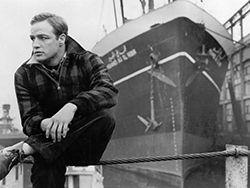 On the Waterfront wins Academy Award for best picture. Marlon Brando won his first Oscar as Terry Malloy, a New York dock worker. Elia Kazan directed from a script by Budd Schulberg, both of whom were targeted by the Hollywood blacklist; some have seen this film as a metaphor for their experiences and an explanation of their actions.
On the Waterfront wins Academy Award for best picture. Marlon Brando won his first Oscar as Terry Malloy, a New York dock worker. Elia Kazan directed from a script by Budd Schulberg, both of whom were targeted by the Hollywood blacklist; some have seen this film as a metaphor for their experiences and an explanation of their actions.
1954
On May 17, the United States Supreme Court, in Brown vs the Board of Education, declares segregation in all public schools in the United States unconstitutional, nullifying the earlier judicial doctrine of "separate but equal."
 Chuck Berry records Maybellene.
Chuck Berry records Maybellene.
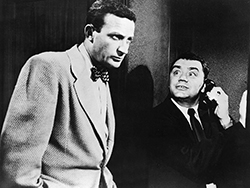 Marty wins Academy Award for best picture. The intimate character study made Oscar history because it was an adaptation of a TV drama and because it was the first film whose awards campaign costs ($400,000) surpassed its production budget ($340,000).
Marty wins Academy Award for best picture. The intimate character study made Oscar history because it was an adaptation of a TV drama and because it was the first film whose awards campaign costs ($400,000) surpassed its production budget ($340,000).
1955
 Rosa Parks refuses to relinquish her bus seat to a white man on December 1, initiating the Montgomery bus boycott. Soon afterward, Martin Luther King, Jr., becomes the leader of the boycott.
Rosa Parks refuses to relinquish her bus seat to a white man on December 1, initiating the Montgomery bus boycott. Soon afterward, Martin Luther King, Jr., becomes the leader of the boycott.
 Fourteen-year-old Chicago resident Emmett Till is lynched in Money, Mississippi, on August 28.
Fourteen-year-old Chicago resident Emmett Till is lynched in Money, Mississippi, on August 28.
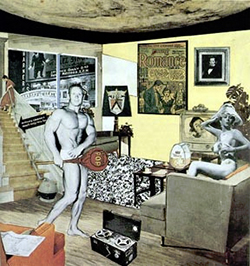 Collage by Richard Hamilton: Just what is it that makes today's homes so different, so appealing? measures 10.25 in (260 mm) × 9.75 in (248 mm). The work is now in the collection of the Kunsthalle Tübingen, Tübingen, Germany. It was the first work of pop art to achieve iconic status. Just what is it that makes today's homes so different, so appealing? was created in 1956 for the catalogue of the exhibition This Is Tomorrow in London, England in which it was reproduced in black and white. In addition, the piece was used in posters for the exhibit. Hamilton and his friends John McHale and John Voelcker had collaborated to create the room that became the best-known part of the exhibition.
Collage by Richard Hamilton: Just what is it that makes today's homes so different, so appealing? measures 10.25 in (260 mm) × 9.75 in (248 mm). The work is now in the collection of the Kunsthalle Tübingen, Tübingen, Germany. It was the first work of pop art to achieve iconic status. Just what is it that makes today's homes so different, so appealing? was created in 1956 for the catalogue of the exhibition This Is Tomorrow in London, England in which it was reproduced in black and white. In addition, the piece was used in posters for the exhibit. Hamilton and his friends John McHale and John Voelcker had collaborated to create the room that became the best-known part of the exhibition.
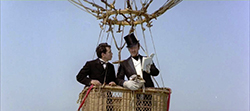 Around the World in 80 Days wins Academy Award for best picture. Producer Michael Todd coined the term cameo to describe the multiple stars appearing briefly in small roles. This film, adapted from Jules Verne's novel, starred David Niven, Cantinflas and Shirley MacLaine, and featured dozens of stars like Frank Sinatra, Buster Keaton and Marlene Dietrich in brief (and sometimes wordless) appearances.
Around the World in 80 Days wins Academy Award for best picture. Producer Michael Todd coined the term cameo to describe the multiple stars appearing briefly in small roles. This film, adapted from Jules Verne's novel, starred David Niven, Cantinflas and Shirley MacLaine, and featured dozens of stars like Frank Sinatra, Buster Keaton and Marlene Dietrich in brief (and sometimes wordless) appearances.
1956
(no entry for this year)
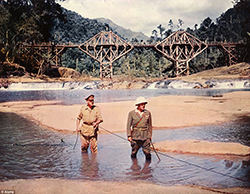 The Bridge on the River Kwai wins Academy Award for best picture. The big-scale drama, about the insanity of war, was directed by David Lean. The screenplay was credited to Pierre Boule, who wrote the novel. But in 1984, the Academy updated their records to acknowledge that the script was written by Michael Wilson and Carl Foreman, who had been blacklisted at the time.
The Bridge on the River Kwai wins Academy Award for best picture. The big-scale drama, about the insanity of war, was directed by David Lean. The screenplay was credited to Pierre Boule, who wrote the novel. But in 1984, the Academy updated their records to acknowledge that the script was written by Michael Wilson and Carl Foreman, who had been blacklisted at the time.
1957
Congress passes the Civil Rights Act of 1957, the first legislation protecting black rights since Reconstruction.
In September, Pres. Dwight D. Eisenhower sends federal troops to Little Rock, Arkansas, to ensure the enforcement of a federal court order to desegregate Central High School and to protect nine African-American students enrolled as part of the order.
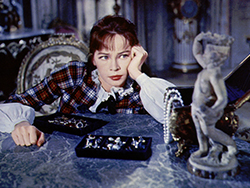 Gigi wins Academy Award for best picture. Alan Jay Lerner and Frederick Loewe, fresh off the success of Broadway's My Fair Lady, wrote a score for this musical version of Colette's tale about a young girl being groomed to become a courtesan in Paris. The film made Oscar history by winning every award it was nominated for: nine for nine.
Gigi wins Academy Award for best picture. Alan Jay Lerner and Frederick Loewe, fresh off the success of Broadway's My Fair Lady, wrote a score for this musical version of Colette's tale about a young girl being groomed to become a courtesan in Paris. The film made Oscar history by winning every award it was nominated for: nine for nine.
1958
(no entry for this year)
 On January 12, Berry Gordy, Jr., Founds Motown Records in Detroit.
On January 12, Berry Gordy, Jr., Founds Motown Records in Detroit.
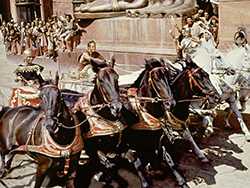 Ben-Hur wins Academy Award for best picture. The production was wildly over budget, and some worried that Hollywood's early-1950s craze for biblical epics had already peaked. But the film, which is still famous for its chariot-race sequence, won 11 Oscars a record it held for 38 years, until Titanic also received 11.
Ben-Hur wins Academy Award for best picture. The production was wildly over budget, and some worried that Hollywood's early-1950s craze for biblical epics had already peaked. But the film, which is still famous for its chariot-race sequence, won 11 Oscars a record it held for 38 years, until Titanic also received 11.
1959
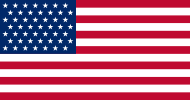 The US flag is modified to have forty-nine stars, reflecting the addition of one new state: Alaska.
The US flag is modified to have forty-nine stars, reflecting the addition of one new state: Alaska.
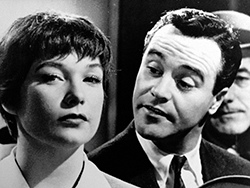 The Apartment wins Academy Award for best picture. After Lost Weekend, Billy Wilder again found himself in the winner's circle, taking home Oscars as producer, director, and co-writer (with I.A.L. Diamond) for this wry look at corporate America.
The Apartment wins Academy Award for best picture. After Lost Weekend, Billy Wilder again found himself in the winner's circle, taking home Oscars as producer, director, and co-writer (with I.A.L. Diamond) for this wry look at corporate America.
1960
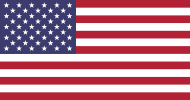 The US flag is modified to have fifty stars, reflecting the addition of one new state: Hawaii.
The US flag is modified to have fifty stars, reflecting the addition of one new state: Hawaii.
The Civil Rights Act of 1960 is signed into law by Pres. Dwight D. Eisenhower on May 6. The act establishes federal inspection of local voter registration rolls and introduces penalties for anyone who obstructs a citizens attempt to register to vote or to cast a ballot.
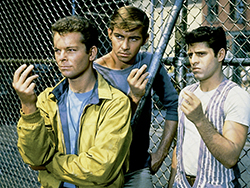 West Side Story wins Academy Award for best picture. The musical was co-directed by Jerome Robbins (who had staged the Broadway musical) and Robert Wise, the first time a team directed a best picture winner. The film won 10 Oscars, remaining in the record books as the sole runner-up to the trio of movies that won 11.
West Side Story wins Academy Award for best picture. The musical was co-directed by Jerome Robbins (who had staged the Broadway musical) and Robert Wise, the first time a team directed a best picture winner. The film won 10 Oscars, remaining in the record books as the sole runner-up to the trio of movies that won 11.
1961
The Congress of Racial Equality organizes Freedom Rides through the Deep South.
 John F. Kennedy becomes thirty-fifth president of the United States.
John F. Kennedy becomes thirty-fifth president of the United States.
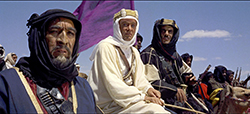 Lawrence of Arabia wins Academy Award for best picture. At three hours and 48 minutes, it's the longest-running best picture winner (one minute longer than Gone With the Wind ). The tale of T.E. Lawrence marked the second best picture win for David Lean in five years.
Lawrence of Arabia wins Academy Award for best picture. At three hours and 48 minutes, it's the longest-running best picture winner (one minute longer than Gone With the Wind ). The tale of T.E. Lawrence marked the second best picture win for David Lean in five years.
1962
 On October 1, James Meredith becomes the first black student to enroll at the University of Mississippi.
On October 1, James Meredith becomes the first black student to enroll at the University of Mississippi.
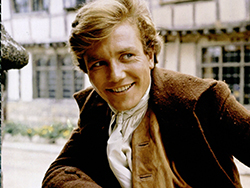 Tom Jones wins Academy Award for best picture. For decades, Hollywood's Hays Code dictated what couldn t be depicted onscreen. This comedy, directed by Tony Richardson and written by John Osborne adapting Henry Fielding, helped break that code by depicting the radical idea that sex could be fun.
Tom Jones wins Academy Award for best picture. For decades, Hollywood's Hays Code dictated what couldn t be depicted onscreen. This comedy, directed by Tony Richardson and written by John Osborne adapting Henry Fielding, helped break that code by depicting the radical idea that sex could be fun.
1963
Martin Luther King Jr. writes his "Letter from Birmingham Jail" on April 16.
Kennedy assassinated.
Lyndon Johnson becomes thirty-sixth president of the United States.
 Martin Luther King Jr. is named Time magazine's Man of the Year.
Martin Luther King Jr. is named Time magazine's Man of the Year.
 On June 12, Mississippi NAACP field secretary Medgar Evers is assassinated outside his home in Jackson.
On June 12, Mississippi NAACP field secretary Medgar Evers is assassinated outside his home in Jackson.
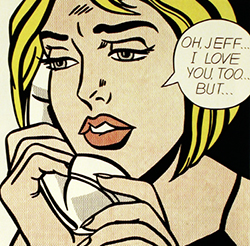 painting by Roy Lichtenstein: Oh, Jeff...I Love You, Too...But... (sometimes Oh, Jeff). Like many of Lichtenstein's works its title comes from the speech balloon in the painting. Although many sources, such as the Encyclopedia of Art, describe Whaam! and Drowning Girl as Lichtenstein's most famous works, artist Vian Shamounki Borchert believes it is this piece, calling it his Mona Lisa. The Daily Mail listed it along with Whaam! and Drowning Girl as one of his most famous at the time of its 2013 Retrospective at the Tate Modern. Borchert notes that this painting captures "the magic" of its "anguished and yes [sic] beautiful blue eyed, blond hair, full lips" female subject while presenting "sad eyes that seem to give in to what seems to be a doomed love affair". Lichtenstein in 1967 Measuring 48 in × 48 inches, Oh, Jeff...I Love You, Too...But... is among the most famous of his early romance comic derivative works from the period when he was adapting cartoons and advertisements into his style via Ben-Day dots.
painting by Roy Lichtenstein: Oh, Jeff...I Love You, Too...But... (sometimes Oh, Jeff). Like many of Lichtenstein's works its title comes from the speech balloon in the painting. Although many sources, such as the Encyclopedia of Art, describe Whaam! and Drowning Girl as Lichtenstein's most famous works, artist Vian Shamounki Borchert believes it is this piece, calling it his Mona Lisa. The Daily Mail listed it along with Whaam! and Drowning Girl as one of his most famous at the time of its 2013 Retrospective at the Tate Modern. Borchert notes that this painting captures "the magic" of its "anguished and yes [sic] beautiful blue eyed, blond hair, full lips" female subject while presenting "sad eyes that seem to give in to what seems to be a doomed love affair". Lichtenstein in 1967 Measuring 48 in × 48 inches, Oh, Jeff...I Love You, Too...But... is among the most famous of his early romance comic derivative works from the period when he was adapting cartoons and advertisements into his style via Ben-Day dots.
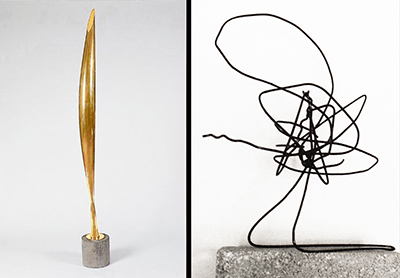 An art exhibit is held at Stanford University, featuring Brancusi's Bird in Space (loaned by student Richard Holkar) as its major piece. Another work entitled Soul in Flight — a "sculpture" consisting of two bent coat hangers — is surreptitiously added to the exhibit by D. Heskett and R. Robbins (student colleagues of Holkar), without the bother of going through the submission process. The coat-hanger piece remains as part of the exhibit for several days, until it is accidentally bumped and comes apart during an evening cleaning of the displays.
An art exhibit is held at Stanford University, featuring Brancusi's Bird in Space (loaned by student Richard Holkar) as its major piece. Another work entitled Soul in Flight — a "sculpture" consisting of two bent coat hangers — is surreptitiously added to the exhibit by D. Heskett and R. Robbins (student colleagues of Holkar), without the bother of going through the submission process. The coat-hanger piece remains as part of the exhibit for several days, until it is accidentally bumped and comes apart during an evening cleaning of the displays.
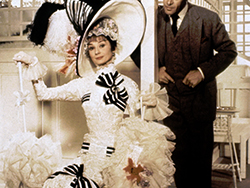 My Fair Lady wins Academy Award for best picture. It was one of the most-anticipated films in years, since it was based on the Broadway mega-hit. The winner of eight Academy Awards, it's also notable as the last best pic winner to be filmed entirely on Hollywood soundstages.
My Fair Lady wins Academy Award for best picture. It was one of the most-anticipated films in years, since it was based on the Broadway mega-hit. The winner of eight Academy Awards, it's also notable as the last best pic winner to be filmed entirely on Hollywood soundstages.
1964
Congress passes the Civil Rights Act of 1964. The act and this discrimination in all public accommodations and by employers. It also establishes the Equal Opportunity Employment Commission (EEOC) to monitor compliance with the law.


 On June 21, civil rights workers James Chaney, Andrew Goodman, and Michael Schwerner are abducted and killed by terrorists in Mississippi.
On June 21, civil rights workers James Chaney, Andrew Goodman, and Michael Schwerner are abducted and killed by terrorists in Mississippi.
The 24th amendment to the Constitution, which abolishes the poll tax, is ratified.
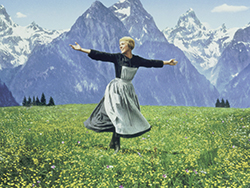 The Sound of Music wins Academy Award for best picture. A few years after the urban grittiness of West Side Story, Robert Wise directed this wholesome Rodgers & Hammerstein musical. It won five Oscars and was an enormous hit; it also rescued the financially strapped 20th Century Fox, which was recovering from the mega-expensive Cleopatra.
The Sound of Music wins Academy Award for best picture. A few years after the urban grittiness of West Side Story, Robert Wise directed this wholesome Rodgers & Hammerstein musical. It won five Oscars and was an enormous hit; it also rescued the financially strapped 20th Century Fox, which was recovering from the mega-expensive Cleopatra.
1965
 Malcolm X is assassinated at the Audubon Ballroom in Harlem on February 21.
Malcolm X is assassinated at the Audubon Ballroom in Harlem on February 21.
The Watts Uprising occurs on August 11-16th. Thirty-four people are killed and 1000 are injured in the five-day confrontation.
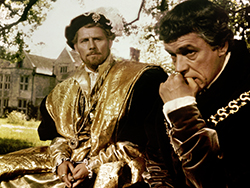 A Man for All Seasons wins Academy Award for best picture. Robert Bolt's thoughtful play, about Sir Thomas More's battles with King Henry VIII, concerned religion, principles, and morality. Bolt adapted his play, which was directed by Fred Zinnemann ( From Here to Eternity ).
A Man for All Seasons wins Academy Award for best picture. Robert Bolt's thoughtful play, about Sir Thomas More's battles with King Henry VIII, concerned religion, principles, and morality. Bolt adapted his play, which was directed by Fred Zinnemann ( From Here to Eternity ).
1966
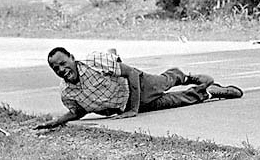 On June 5, James Meredith begins a solitary March Against Fear for 220 miles from Memphis, Tennessee, to Jackson, Mississippi, to protest racial discrimination. Meredith is shot by a sniper soon after crossing into Mississippi.
On June 5, James Meredith begins a solitary March Against Fear for 220 miles from Memphis, Tennessee, to Jackson, Mississippi, to protest racial discrimination. Meredith is shot by a sniper soon after crossing into Mississippi.
 On November 8, Edward Brooke of Massachusetts becomes the first African-American to be elected to the United States Senate since Reconstruction.
On November 8, Edward Brooke of Massachusetts becomes the first African-American to be elected to the United States Senate since Reconstruction.

 On September 15, the Black Panther Party is formed in Oakland, California, by Bobby Seale and Huey P. Newton.
On September 15, the Black Panther Party is formed in Oakland, California, by Bobby Seale and Huey P. Newton.
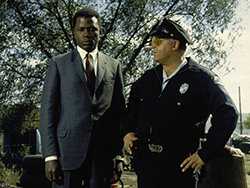 In the Heat of the Night wins Academy Award for best picture. The competition was intense in 1967, including The Graduate and Bonnie & Clyde. But only three years after passage of the Civil Rights Act, this mystery was a look at race relations, exploding prejudices, and offering smart insights. Sidney Poitier and Rod Steiger (best actor winner) led a strong cast.
In the Heat of the Night wins Academy Award for best picture. The competition was intense in 1967, including The Graduate and Bonnie & Clyde. But only three years after passage of the Civil Rights Act, this mystery was a look at race relations, exploding prejudices, and offering smart insights. Sidney Poitier and Rod Steiger (best actor winner) led a strong cast.
1967
 On July 13, Thurgood Marshall takes his seat as the first African-American justice on the United States Supreme Court.
On July 13, Thurgood Marshall takes his seat as the first African-American justice on the United States Supreme Court.
On June 12, the United States Supreme Court, in Loving vs Virginia, strikes down state interracial marriage bans.
The six-day Newark Riot begins on July 12.
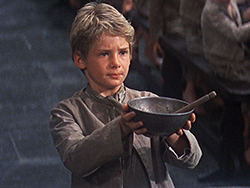 Oliver! wins Academy Award for best picture. The 1960s were NOT the heyday of Hollywood musicals, but you wouldn t know it by looking at Oscar: Oliver! became the fourth musical in eight years to take the best-picture win.
Oliver! wins Academy Award for best picture. The 1960s were NOT the heyday of Hollywood musicals, but you wouldn t know it by looking at Oscar: Oliver! became the fourth musical in eight years to take the best-picture win.
1968
 On April 4, Martin Luther King, Jr., is assassinated in Memphis, Tennessee. In the wake of the assassination, 125 cities in 29 states experience uprisings.
On April 4, Martin Luther King, Jr., is assassinated in Memphis, Tennessee. In the wake of the assassination, 125 cities in 29 states experience uprisings.
 On June 5, New York Senator and presidential candidate Robert F. Kennedy is assassinated in Los Angeles.
On June 5, New York Senator and presidential candidate Robert F. Kennedy is assassinated in Los Angeles.
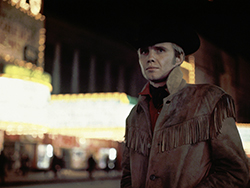 Midnight Cowboy wins Academy Award for best picture. The film, directed by John Schlesinger and starring Jon Voight and Dustin Hoffman, became the first X-rated movie to win the Oscar. When it was re-released two years later, it was re-rated as an R, without any cuts. The script was by Waldo Salt, based on the novel by James Leo Herlihy.
Midnight Cowboy wins Academy Award for best picture. The film, directed by John Schlesinger and starring Jon Voight and Dustin Hoffman, became the first X-rated movie to win the Oscar. When it was re-released two years later, it was re-rated as an R, without any cuts. The script was by Waldo Salt, based on the novel by James Leo Herlihy.
1969
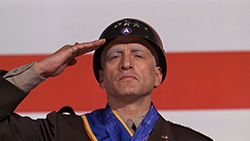 Patton wins Academy Award for best picture. The film, written by Francis Coppola and Edmund H. North, was directed by Franklin J. Schaffner. Arriving in the heat of the Vietnam war, some people claimed Patton was hawkish, while others said it was anti-war. George C. Scott gave a powerhouse performance and won as best actor, even after announcing he wouldn t accept it because he didn t believe actors should be in competition.
Patton wins Academy Award for best picture. The film, written by Francis Coppola and Edmund H. North, was directed by Franklin J. Schaffner. Arriving in the heat of the Vietnam war, some people claimed Patton was hawkish, while others said it was anti-war. George C. Scott gave a powerhouse performance and won as best actor, even after announcing he wouldn t accept it because he didn t believe actors should be in competition.
1970
 Dr. Clifton Wharton Junior is named president of Michigan State University on January 2. He is the first African-American to lead a major, predominantly white university in the 20th century.
Dr. Clifton Wharton Junior is named president of Michigan State University on January 2. He is the first African-American to lead a major, predominantly white university in the 20th century.
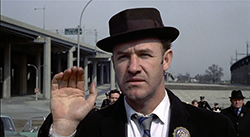 The French Connection wins Academy Award for best picture. This action-drama was one of Oscar's many fact-based wins, based on the actions of N.Y. drug cop Popeye Doyle (played by winner Gene Hackman). The film (directed by William Friedkin and edited by Gerald B. Greenberg) featured a chase sequence that is still held up as an example of great filmmaking.
The French Connection wins Academy Award for best picture. This action-drama was one of Oscar's many fact-based wins, based on the actions of N.Y. drug cop Popeye Doyle (played by winner Gene Hackman). The film (directed by William Friedkin and edited by Gerald B. Greenberg) featured a chase sequence that is still held up as an example of great filmmaking.
1971
On January 12, the Congressional Black Caucus is formed in Washington DC.
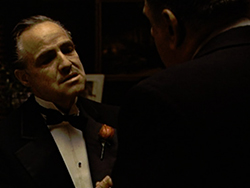 The Godfather wins Academy Award for best picture. Mario Puzo's novel was a big hit, and the Francis Coppola-directed film was too. It hit a milestone by passing $100 million at the U.S. box office. And Oscar history was made when the best-picture winner's tally (three Oscars) was outnumbered by another film ( Cabaret, with eight wins).
The Godfather wins Academy Award for best picture. Mario Puzo's novel was a big hit, and the Francis Coppola-directed film was too. It hit a milestone by passing $100 million at the U.S. box office. And Oscar history was made when the best-picture winner's tally (three Oscars) was outnumbered by another film ( Cabaret, with eight wins).
1972

 In November, Barbara Jordan of Houston and Andrew Young of Atlanta become the first black Congressional representatives elected from the US South since 1898.
In November, Barbara Jordan of Houston and Andrew Young of Atlanta become the first black Congressional representatives elected from the US South since 1898.
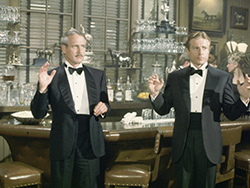 The Sting wins Academy Award for best picture. The caper movie, starring Paul Newman and Robert Redford, marked the first time a woman won a best picture Oscar: the film's producers were Tony Bill, Michael Phillips, and Julia Phillips.
The Sting wins Academy Award for best picture. The caper movie, starring Paul Newman and Robert Redford, marked the first time a woman won a best picture Oscar: the film's producers were Tony Bill, Michael Phillips, and Julia Phillips.
1973
 In the late summer of 1973, Republican Vice President Spiro Agnew was under investigation by the United States Attorney's office in Baltimore, Maryland, on charges of extortion, tax fraud, bribery and conspiracy. In October, he was formally charged with having accepted bribes totaling more than $100,000, while holding office as Baltimore County Executive, Governor of Maryland, and as Vice President of the United States. On October 10, 1973, Agnew was allowed to plead no contest to a single charge that he had failed to report $29,500 of income received in 1967, with the condition that he resign the office of Vice President. Agnew is the only Vice President in U.S. history to resign because of criminal charges.
In the late summer of 1973, Republican Vice President Spiro Agnew was under investigation by the United States Attorney's office in Baltimore, Maryland, on charges of extortion, tax fraud, bribery and conspiracy. In October, he was formally charged with having accepted bribes totaling more than $100,000, while holding office as Baltimore County Executive, Governor of Maryland, and as Vice President of the United States. On October 10, 1973, Agnew was allowed to plead no contest to a single charge that he had failed to report $29,500 of income received in 1967, with the condition that he resign the office of Vice President. Agnew is the only Vice President in U.S. history to resign because of criminal charges.
 Thomas Bradley is elected the first black mayor of Los Angeles in the modern era. He is reelected four times and thus holds the mayor's office for 20 years.
Thomas Bradley is elected the first black mayor of Los Angeles in the modern era. He is reelected four times and thus holds the mayor's office for 20 years.
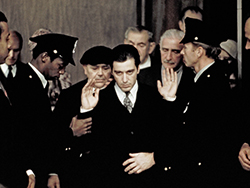 The Godfather Part II wins Academy Award for best picture. The Francis Coppola movie was the first time a sequel won the top prize. It started decades of Part 2 movies, though the tale of the Corleones had a unique structure: It was both a continuation of the first film and an origins story, flashing back to before the original's start.
The Godfather Part II wins Academy Award for best picture. The Francis Coppola movie was the first time a sequel won the top prize. It started decades of Part 2 movies, though the tale of the Corleones had a unique structure: It was both a continuation of the first film and an origins story, flashing back to before the original's start.
1974
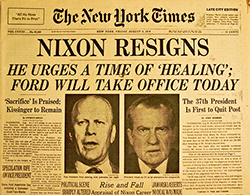 Under mounting impeachment pressure resulting from the Watergate break-in, Nixon becomes the first president ever to resign from presidency.
Under mounting impeachment pressure resulting from the Watergate break-in, Nixon becomes the first president ever to resign from presidency.
 Gerald Ford becomes thirty-eighth president of the United States.
Gerald Ford becomes thirty-eighth president of the United States.
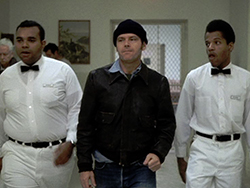 One Flew over the Cuckoo's Nest wins Academy Award for best picture. This was only the second film to take the top five prizes: Best picture, director, screenplay, actor and actress.
One Flew over the Cuckoo's Nest wins Academy Award for best picture. This was only the second film to take the top five prizes: Best picture, director, screenplay, actor and actress.
1975
(no entry for this year)
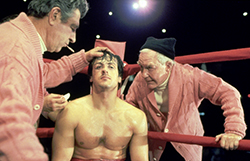 Rocky wins Academy Award for best picture. There were plenty of great films that year, including All the President's Men and Network, but the Academy voters fell in love with this tale of a likable loser who works hard for his big chance. It started a slew of Rocky sequels.
Rocky wins Academy Award for best picture. There were plenty of great films that year, including All the President's Men and Network, but the Academy voters fell in love with this tale of a likable loser who works hard for his big chance. It started a slew of Rocky sequels.
1976
(no entry for this year)
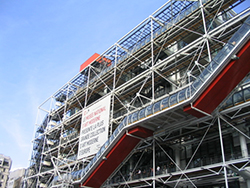 Centre Georges Pompidou, commonly shortened to Centre Pompidou and also known as the Pompidou Centre in English, opens in 1977. It is a complex building in the Beaubourg area of the 4th arrondissement of Paris, near Les Halles, rue Montorgueil, and the Marais. It was designed in the style of high-tech architecture by the architectural team of Richard Rogers and Renzo Piano, along with Gianfranco Franchini. It houses the Bibliothèque publique d'information (Public Information Library), a vast public library; the Musée National d'Art Moderne, which is the largest museum for modern art in Europe; and IRCAM, a centre for music and acoustic research. It is named after Georges Pompidou, the President of France from 1969 to 1974 who commissioned the building.
Centre Georges Pompidou, commonly shortened to Centre Pompidou and also known as the Pompidou Centre in English, opens in 1977. It is a complex building in the Beaubourg area of the 4th arrondissement of Paris, near Les Halles, rue Montorgueil, and the Marais. It was designed in the style of high-tech architecture by the architectural team of Richard Rogers and Renzo Piano, along with Gianfranco Franchini. It houses the Bibliothèque publique d'information (Public Information Library), a vast public library; the Musée National d'Art Moderne, which is the largest museum for modern art in Europe; and IRCAM, a centre for music and acoustic research. It is named after Georges Pompidou, the President of France from 1969 to 1974 who commissioned the building.
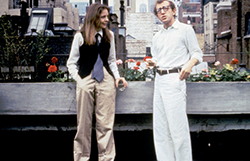 Annie Hall wins Academy Award for best picture. The year's biggest box office hit, Star Wars, was nominated as best pic, but lost out to Woody Allen's comedy-romance, which also earned trophies for screenplay, director, and actress.
Annie Hall wins Academy Award for best picture. The year's biggest box office hit, Star Wars, was nominated as best pic, but lost out to Woody Allen's comedy-romance, which also earned trophies for screenplay, director, and actress.
1977
 The eighth and final night for the televised miniseries based on Alex Haley's Roots is shown on February 3. This final episode achieves the highest ratings to that point for a single television program.
The eighth and final night for the televised miniseries based on Alex Haley's Roots is shown on February 3. This final episode achieves the highest ratings to that point for a single television program.
Jimmy Carter becomes thirty-ninth president of the United States.
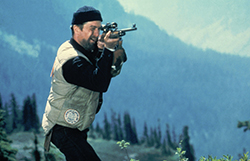 The Deer Hunter wins Academy Award for best picture. During the Vietnam war, Hollywood avoided movies about the conflict, but Michael Cimino's epic was one of the first major-studio releases to tackle the subject. It remains a controversial movie, but Cimino's directing skills are unquestionable.
The Deer Hunter wins Academy Award for best picture. During the Vietnam war, Hollywood avoided movies about the conflict, but Michael Cimino's epic was one of the first major-studio releases to tackle the subject. It remains a controversial movie, but Cimino's directing skills are unquestionable.
1978
(no entry for this year)
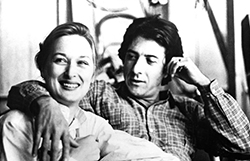 Kramer vs. Kramer wins Academy Award for best picture. The intimate drama about the ravages of divorce and child custody earned honors for adapted screenplay, director (both Robert Benton), actor (Dustin Hoffman), and supporting actress (Meryl Streep).
Kramer vs. Kramer wins Academy Award for best picture. The intimate drama about the ravages of divorce and child custody earned honors for adapted screenplay, director (both Robert Benton), actor (Dustin Hoffman), and supporting actress (Meryl Streep).
1979
 On March 28, a partial core meltdown occurred in Unit 2 of the Three Mile Island Nuclear Generating Station in Dauphin County, Pennsylvania near Harrisburg.
On March 28, a partial core meltdown occurred in Unit 2 of the Three Mile Island Nuclear Generating Station in Dauphin County, Pennsylvania near Harrisburg.
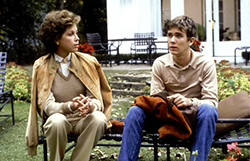 Ordinary People wins Academy Award for best picture. Robert Redford's directing debut won at the National Board of Review, the N.Y. Film Critics Circle, Golden Globes, the Writers and Directors guilds, and then four Oscars, out of six nominations.
Ordinary People wins Academy Award for best picture. Robert Redford's directing debut won at the National Board of Review, the N.Y. Film Critics Circle, Golden Globes, the Writers and Directors guilds, and then four Oscars, out of six nominations.
1980
(no entry for this year)
 Chariots of Fire wins Academy Award for best picture. The tale of the 1924 Olympics proved one of the biggest surprises in Oscar history, though a popular choice; most pundits had predicted it would be a showdown between Warren Beatty's epic Reds and the small-scale family drama On Golden Pond.
Chariots of Fire wins Academy Award for best picture. The tale of the 1924 Olympics proved one of the biggest surprises in Oscar history, though a popular choice; most pundits had predicted it would be a showdown between Warren Beatty's epic Reds and the small-scale family drama On Golden Pond.
1981
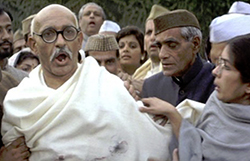 Gandhi wins Academy Award for best picture. There was a lot of competition that year, including E.T. the ExtraTerrestrial and Tootsie. But the grand-scale biopic from director Richard Attenborough was the evening's big winner, with eight trophies.
Gandhi wins Academy Award for best picture. There was a lot of competition that year, including E.T. the ExtraTerrestrial and Tootsie. But the grand-scale biopic from director Richard Attenborough was the evening's big winner, with eight trophies.
1982
(no entry for this year)
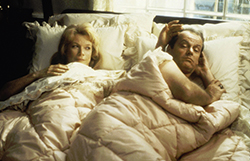 Terms of Endearment wins Academy Award for best picture. TV's James L. Brooks made a splashy film debut, winning three personal awards that night (as writer, director, and producer), while Shirley MacLaine and Jack Nicholson also took home acting prizes.
Terms of Endearment wins Academy Award for best picture. TV's James L. Brooks made a splashy film debut, winning three personal awards that night (as writer, director, and producer), while Shirley MacLaine and Jack Nicholson also took home acting prizes.
1983
On November 2, Pres. Ronald Reagan signs into law a bill making the third Monday in January a federal holiday honoring the life of Martin Luther King Jr.
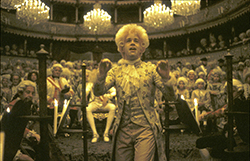 Amadeus wins Academy Award for best picture. Milos Forman's sumptuous version of Peter Shaffer's stage play scored eight wins out of 11 nominations.
Amadeus wins Academy Award for best picture. Milos Forman's sumptuous version of Peter Shaffer's stage play scored eight wins out of 11 nominations.
1984
(no entry for this year)
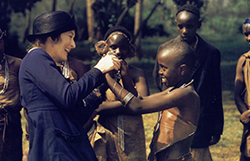 Out of Africa wins Academy Award for best picture. The epic romance benefited from Meryl Streep's performance, Sydney Pollack's direction and Kurt Luedtke's adaptation of Isak Dinesen's book. In all, the film won seven Oscars (though Streep was an also-ran).
Out of Africa wins Academy Award for best picture. The epic romance benefited from Meryl Streep's performance, Sydney Pollack's direction and Kurt Luedtke's adaptation of Isak Dinesen's book. In all, the film won seven Oscars (though Streep was an also-ran).
1985
United States Rep. William H. Gray III (Pennsylvania), becomes the first African-American congressmen to chair the House Budget Committee.
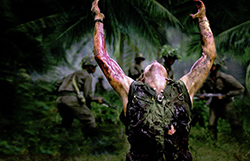 Platoon wins Academy Award for best picture. Oliver Stone's autobiographical film, a vivid account of his Vietnam experiences, won four Oscars, including Stone as director.
Platoon wins Academy Award for best picture. Oliver Stone's autobiographical film, a vivid account of his Vietnam experiences, won four Oscars, including Stone as director.
1986
On September 8, The Oprah Winfrey Show from Chicago becomes nationally syndicated.
 On April 26, the Chernobyl Nuclear Disaster occurred in the Soviet Union, when reactor 4 of the Chernobyl Nuclear Power Plant suffered a catastrophic power increase, leading to explosions in the core. This dispersed large quantities of radioactive fuel and core materials into the atmosphere and ignited the combustible graphite moderator. The burning graphite moderator increased the emission of radioactive particles, carried by the smoke, as the reactor had not been contained by any kind of hard containment vessel (unlike all Western plants). The accident occurred during an experiment scheduled to test a potential safety emergency core cooling feature. Large areas in Ukraine, Belarus, and Russia had to be evacuated, with over 336,000 people resettled.
On April 26, the Chernobyl Nuclear Disaster occurred in the Soviet Union, when reactor 4 of the Chernobyl Nuclear Power Plant suffered a catastrophic power increase, leading to explosions in the core. This dispersed large quantities of radioactive fuel and core materials into the atmosphere and ignited the combustible graphite moderator. The burning graphite moderator increased the emission of radioactive particles, carried by the smoke, as the reactor had not been contained by any kind of hard containment vessel (unlike all Western plants). The accident occurred during an experiment scheduled to test a potential safety emergency core cooling feature. Large areas in Ukraine, Belarus, and Russia had to be evacuated, with over 336,000 people resettled.
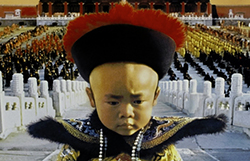 The Last Emperor wins Academy Award for best picture. The Bernardo Bertolucci-directed biopic scored a clean sweep: Nine wins out of nine nominations, the first time that happened since Gigi. The winners included Vittorio Storaro for his beautiful cinematography.
The Last Emperor wins Academy Award for best picture. The Bernardo Bertolucci-directed biopic scored a clean sweep: Nine wins out of nine nominations, the first time that happened since Gigi. The winners included Vittorio Storaro for his beautiful cinematography.
1987
 Dr. Clifton R. Wharton Jr. is appointed chairman and CEO of TIAA-CREF, the 19th largest US Fortune 500 company. He becomes the first black chairman and CEO of a major US corporation.
Dr. Clifton R. Wharton Jr. is appointed chairman and CEO of TIAA-CREF, the 19th largest US Fortune 500 company. He becomes the first black chairman and CEO of a major US corporation.
 Kurt Schmoke becomes the first African-American elected mayor of Baltimore.
Kurt Schmoke becomes the first African-American elected mayor of Baltimore.
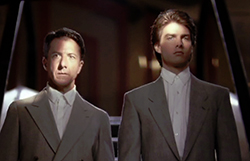 Rain Man wins Academy Award for best picture. The film, produced by Mark Johnson and directed by Barry Levinson, was basically a two-character study, with Dustin Hoffman winning as best actor; while Tom Cruise's performance was widely admired, he was surprisingly not nominated.
Rain Man wins Academy Award for best picture. The film, produced by Mark Johnson and directed by Barry Levinson, was basically a two-character study, with Dustin Hoffman winning as best actor; while Tom Cruise's performance was widely admired, he was surprisingly not nominated.
1988
(no entry for this year)
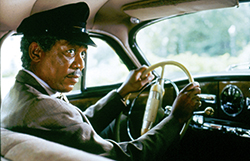 Driving Miss Daisy wins Academy Award for best picture. The film was a rarity, winning the top prize though its director (Bruce Beresford) wasn t even nominated. Among the wins were actress Jessica Tandy and scripter Alfred Uhry, adapting his own play.
Driving Miss Daisy wins Academy Award for best picture. The film was a rarity, winning the top prize though its director (Bruce Beresford) wasn t even nominated. Among the wins were actress Jessica Tandy and scripter Alfred Uhry, adapting his own play.
1989
 Douglas Wilder wins the governorship of Virginia, make him the first African-American to be popularly elected to that office.
Douglas Wilder wins the governorship of Virginia, make him the first African-American to be popularly elected to that office.
 Gen. Colin L. Powell is named chief of the United States Joint Chiefs of Staff, the first African-American in the youngest person (52) to hold the post.
Gen. Colin L. Powell is named chief of the United States Joint Chiefs of Staff, the first African-American in the youngest person (52) to hold the post.
 In March, Frederick Andrew Gregory becomes the first African-American to command a space shuttle when he leads the crew of the Discovery.
In March, Frederick Andrew Gregory becomes the first African-American to command a space shuttle when he leads the crew of the Discovery.
George Bush becomes forty-first president of the United States.
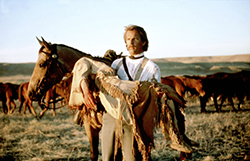 Dances With Wolves wins Academy Award for best picture. No major studio wanted to make the film, but the Kevin Costner-directed Western proved a huge hit with audiences and earned 12 Oscar nominations, winning seven.
Dances With Wolves wins Academy Award for best picture. No major studio wanted to make the film, but the Kevin Costner-directed Western proved a huge hit with audiences and earned 12 Oscar nominations, winning seven.
1990
 Nelson Mandela, South African black nationalist, is freed after 27 years in prison.
Nelson Mandela, South African black nationalist, is freed after 27 years in prison.
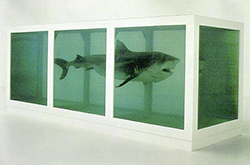 Scultpure by Damien Hirst: The Physical Impossibility of Death in the Mind of Someone Living consists of a large (14 foot) tiger shark preserved in formaldehyde in a vitrine. It is considered the iconic work of British art in the 1990s, and has become a symbol of Britart worldwide. The work was funded by Charles Saatchi, who in 1991 had offered to pay for whatever artwork Hirst wanted to create. Saatchi sold the work in 2004 to Steven A. Cohen for an estimated $8 million. When the original shark showed signs of deterioration (it rotted from the inside out and a fin fell off), it was replaced with a new specimen in 2006, thereby raising a Ship of Theseus problem: Does a work of art remain the same work if its components are replaced with new components?
Scultpure by Damien Hirst: The Physical Impossibility of Death in the Mind of Someone Living consists of a large (14 foot) tiger shark preserved in formaldehyde in a vitrine. It is considered the iconic work of British art in the 1990s, and has become a symbol of Britart worldwide. The work was funded by Charles Saatchi, who in 1991 had offered to pay for whatever artwork Hirst wanted to create. Saatchi sold the work in 2004 to Steven A. Cohen for an estimated $8 million. When the original shark showed signs of deterioration (it rotted from the inside out and a fin fell off), it was replaced with a new specimen in 2006, thereby raising a Ship of Theseus problem: Does a work of art remain the same work if its components are replaced with new components?
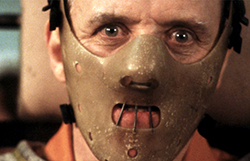 The Silence of the Lambs wins Academy Award for best picture. It became the third and final film to win Oscar's top five prizes (film, director, script, actor, and actress). It was a surprise win because suspense thrillers were not considered Academy favorites, and Silence had opened in February; but the film maintained its enthusiastic buzz for more than a year.
The Silence of the Lambs wins Academy Award for best picture. It became the third and final film to win Oscar's top five prizes (film, director, script, actor, and actress). It was a surprise win because suspense thrillers were not considered Academy favorites, and Silence had opened in February; but the film maintained its enthusiastic buzz for more than a year.
1991
The Soviet Union ends, and so does the Cold War.
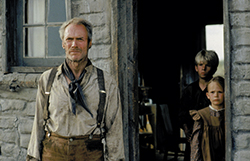 Unforgiven wins Academy Award for best picture. Clint Eastwood had directed 15 films in the past 20 years, earning industry respect and affection, but few awards. However, the thoughtful, well-crafted Unforgiven proved irresistible to audiences and to Academy voters. Since it was the second western to win in three years, some predicted a major big-screen revival of the genre, but that didn t happen.
Unforgiven wins Academy Award for best picture. Clint Eastwood had directed 15 films in the past 20 years, earning industry respect and affection, but few awards. However, the thoughtful, well-crafted Unforgiven proved irresistible to audiences and to Academy voters. Since it was the second western to win in three years, some predicted a major big-screen revival of the genre, but that didn t happen.
1992
(no entry for this year)
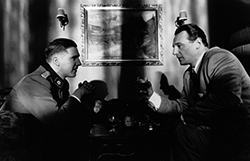 Schindler's List wins Academy Award for best picture. The Steven Spielberg film defied conventional wisdom, by being a long, black and white movie about a depressing topic. But it was a hugely popular win.
Schindler's List wins Academy Award for best picture. The Steven Spielberg film defied conventional wisdom, by being a long, black and white movie about a depressing topic. But it was a hugely popular win.
1993
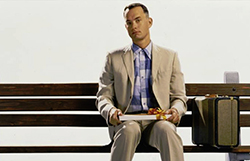 Forrest Gump wins Academy Award for best picture. The Robert Zemeckis-directed film, starring Tom Hanks, utilized many technical innovations, but Oscar voters responded more to the tale and to the title character than to the decade-spanning effects.
Forrest Gump wins Academy Award for best picture. The Robert Zemeckis-directed film, starring Tom Hanks, utilized many technical innovations, but Oscar voters responded more to the tale and to the title character than to the decade-spanning effects.
1994
 On April 27, Nelson Mandela is elected President of South Africa in that nation's first election giving black voters full enfranchisement. The land of apartheid is now led by a black activist.
On April 27, Nelson Mandela is elected President of South Africa in that nation's first election giving black voters full enfranchisement. The land of apartheid is now led by a black activist.
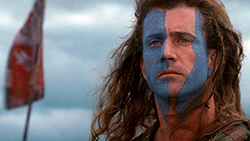 Braveheart wins Academy Award for best picture. The biopic, directed by Mel Gibson, was a popular winner in a tight year. It's also one of the few films to win Oscar's top prize without a single acting nomination, alongside Last Emperor, Slumdog Millionaire, and a few others.
Braveheart wins Academy Award for best picture. The biopic, directed by Mel Gibson, was a popular winner in a tight year. It's also one of the few films to win Oscar's top prize without a single acting nomination, alongside Last Emperor, Slumdog Millionaire, and a few others.
1995
(no entry for this year)
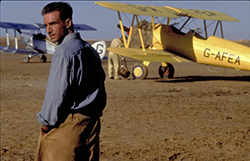 The English Patient wins Academy Award for best picture. The film almost wasn t made, when the studio withdrew funding at the last minute. But Harvey Weinstein stepped in, and the film (directed by Anthony Minghella) earned an impressive $232 million worldwide, and scored nine Oscars meaning it's one of the top seven winners of all time.
The English Patient wins Academy Award for best picture. The film almost wasn t made, when the studio withdrew funding at the last minute. But Harvey Weinstein stepped in, and the film (directed by Anthony Minghella) earned an impressive $232 million worldwide, and scored nine Oscars meaning it's one of the top seven winners of all time.
1996
(no entry for this year)
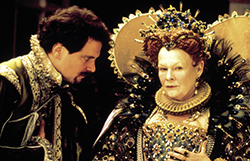 Shakespeare in Love wins Academy Award for best picture. It was a battle between Steven Spielberg's Saving Private Ryan and Shakespeare in Love, and many were stunned when the comedy won. But it shouldn t have been a surprise: The film is a love letter to theater and acting, and the largest branch of the Academy is actors.
Shakespeare in Love wins Academy Award for best picture. It was a battle between Steven Spielberg's Saving Private Ryan and Shakespeare in Love, and many were stunned when the comedy won. But it shouldn t have been a surprise: The film is a love letter to theater and acting, and the largest branch of the Academy is actors.
1998
(no entry for this year)
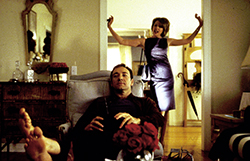 American Beauty wins Academy Award for best picture. The dramedy looked at all the dark longings beneath the sunny facade of U.S. suburbia.
American Beauty wins Academy Award for best picture. The dramedy looked at all the dark longings beneath the sunny facade of U.S. suburbia.
1999
(no entry for this year)
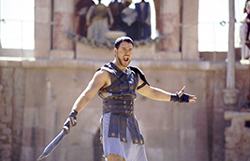 Gladiator wins Academy Award for best picture. When the Ridley Scott-directed epic opened in May, audiences loved it, but few predicted it would be a best picture winner. But as the months wore on, Academy members clearly maintained their admiration for the film, the kind of intelligent spectacle that Hollywood does best.
Gladiator wins Academy Award for best picture. When the Ridley Scott-directed epic opened in May, audiences loved it, but few predicted it would be a best picture winner. But as the months wore on, Academy members clearly maintained their admiration for the film, the kind of intelligent spectacle that Hollywood does best.
2000
(no entry for this year)
 A Beautiful Mind wins Academy Award for best picture. It doesn t sound like a surefire project: A biopic about a delusional math genius. But Russell Crowe turned in another great performance, and Oscars went to director Ron Howard, supporting actress Jennifer Connelly, and writer Akiva Goldsman, adapting Sylvia Nasar's book about John Nash.
A Beautiful Mind wins Academy Award for best picture. It doesn t sound like a surefire project: A biopic about a delusional math genius. But Russell Crowe turned in another great performance, and Oscars went to director Ron Howard, supporting actress Jennifer Connelly, and writer Akiva Goldsman, adapting Sylvia Nasar's book about John Nash.
2001
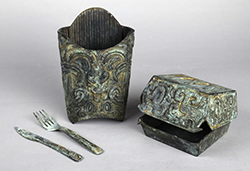 Sculpture by Zhang Hongtu: Mai Dang Lao (McDonald's), a set of readily identifiable McDonald's hamburger box, french-fry container, fork, and knife are cast in bronze and adorned with traditional Chinese designs. The artist has transformed ubiquitous consumer items into what at first glance appear to be Shang dynasty artifacts. Hilarious.
Sculpture by Zhang Hongtu: Mai Dang Lao (McDonald's), a set of readily identifiable McDonald's hamburger box, french-fry container, fork, and knife are cast in bronze and adorned with traditional Chinese designs. The artist has transformed ubiquitous consumer items into what at first glance appear to be Shang dynasty artifacts. Hilarious.
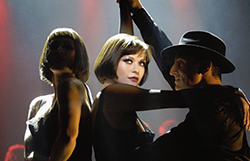 Chicago wins Academy Award for best picture. Hollywood had circled around a movie adaptation of the stage musical since the 1970s, but director Rob Marshall and writer Bill Condon figured out how to make it work. They delivered a razzle-dazzle musical with wry observations about contemporary obsessions with scandal and celebrity.
Chicago wins Academy Award for best picture. Hollywood had circled around a movie adaptation of the stage musical since the 1970s, but director Rob Marshall and writer Bill Condon figured out how to make it work. They delivered a razzle-dazzle musical with wry observations about contemporary obsessions with scandal and celebrity.
2002
(no entry for this year)
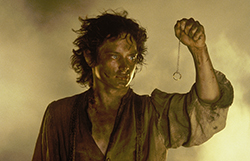 The Lord of the Rings: The Return of the King wins Academy Award for best picture. Peter Jackson's film trilogy, adapted from the J.R.R. Tolkien novels, earned billions at the B.O., the intense loyalty of fans, and industry admiration for the new technology introduced in the fantasy epic. It also became the third film to win 11 Oscars, after Ben-Hur and Titanic and LOTR became the only one to sweep all its categories.
The Lord of the Rings: The Return of the King wins Academy Award for best picture. Peter Jackson's film trilogy, adapted from the J.R.R. Tolkien novels, earned billions at the B.O., the intense loyalty of fans, and industry admiration for the new technology introduced in the fantasy epic. It also became the third film to win 11 Oscars, after Ben-Hur and Titanic and LOTR became the only one to sweep all its categories.
2003
(no entry for this year)
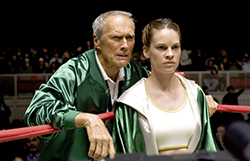 Million Dollar Baby wins Academy Award for best picture. This was Clint Eastwood's second big night at the Academy Awards, following Unforgiven. The tale of a woman boxer holds another distinction: In Oscar's 77th ceremony, this became the first best picture winner set in Southern California.
Million Dollar Baby wins Academy Award for best picture. This was Clint Eastwood's second big night at the Academy Awards, following Unforgiven. The tale of a woman boxer holds another distinction: In Oscar's 77th ceremony, this became the first best picture winner set in Southern California.
2004
Barack Obama is elected to the United States Senate from Illinois. He becomes the second African-American elected to the Senate from that state, and only the fifth black US senator in history.
 Crash wins Academy Award for best picture. In the build-up to the Oscars, the gay western Brokeback Mountain had dominated the awards scene. But the Paul Haggis-directed Crash came out the big winner.
Crash wins Academy Award for best picture. In the build-up to the Oscars, the gay western Brokeback Mountain had dominated the awards scene. But the Paul Haggis-directed Crash came out the big winner.
2005
(no entry for this year)
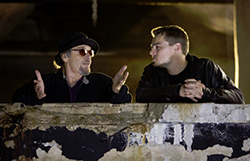 The Departed wins Academy Award for best picture. After five nominations as director, Martin Scorsese hit the jackpot with No. 6, winning one of the film's four awards. It's an Oscar rarity since it's a remake, based on the 2002 Hong Kong crime thriller Infernal Affairs.
The Departed wins Academy Award for best picture. After five nominations as director, Martin Scorsese hit the jackpot with No. 6, winning one of the film's four awards. It's an Oscar rarity since it's a remake, based on the 2002 Hong Kong crime thriller Infernal Affairs.
2006
(no entry for this year)
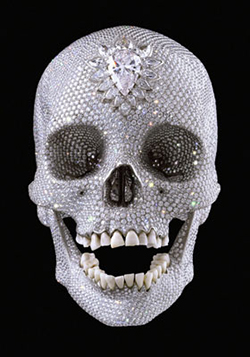 Sculpture by Damien Hirst: For the Love of God consists of a platinum cast of an 18th-century human skull encrusted with 8,601 flawless diamonds, including a pear-shaped pink diamond located in the forehead that is known as the Skull Star Diamond. The skull's teeth are actual human teeth, and were purchased by Hirst in London. The artwork is a Memento mori, or reminder of the mortality of the viewer. In 2007, art historian Rudi Fuchs, observed: 'The skull is out of this world, celestial almost. It proclaims victory over decay. At the same time it represents death as something infinitely more relentless. Compared to the tearful sadness of a vanitas scene, the diamond skull is glory itself.' Costing 14 million to produce, the work was placed on its inaugural display at the White Cube gallery in London in an exhibition Beyond belief with an asking price of 50 million. This would have been the highest price ever paid for a single work by a living artist. The base for the work is a human skull bought in a shop in Islington. It is thought to be that of a 35-year-old European who lived between 1720 and 1810. The work's title was supposedly inspired by Hirst's mother, who once asked, "For the love of God, what are you going to do next? Hirst said that the work was sold on 30 August 2007, for 50 million, to an anonymous consortium. Christina Ruiz, editor of The Art Newspaper, claims that Hirst had failed to find a buyer and had been trying to offload the skull for 38 million. Immediately after these allegations were made, Hirst claimed he had sold it for the full asking price, in cash, leaving no paper trail. The consortium that bought the piece included Hirst himself.
Sculpture by Damien Hirst: For the Love of God consists of a platinum cast of an 18th-century human skull encrusted with 8,601 flawless diamonds, including a pear-shaped pink diamond located in the forehead that is known as the Skull Star Diamond. The skull's teeth are actual human teeth, and were purchased by Hirst in London. The artwork is a Memento mori, or reminder of the mortality of the viewer. In 2007, art historian Rudi Fuchs, observed: 'The skull is out of this world, celestial almost. It proclaims victory over decay. At the same time it represents death as something infinitely more relentless. Compared to the tearful sadness of a vanitas scene, the diamond skull is glory itself.' Costing 14 million to produce, the work was placed on its inaugural display at the White Cube gallery in London in an exhibition Beyond belief with an asking price of 50 million. This would have been the highest price ever paid for a single work by a living artist. The base for the work is a human skull bought in a shop in Islington. It is thought to be that of a 35-year-old European who lived between 1720 and 1810. The work's title was supposedly inspired by Hirst's mother, who once asked, "For the love of God, what are you going to do next? Hirst said that the work was sold on 30 August 2007, for 50 million, to an anonymous consortium. Christina Ruiz, editor of The Art Newspaper, claims that Hirst had failed to find a buyer and had been trying to offload the skull for 38 million. Immediately after these allegations were made, Hirst claimed he had sold it for the full asking price, in cash, leaving no paper trail. The consortium that bought the piece included Hirst himself.
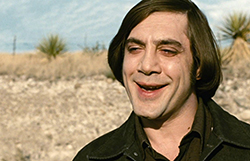 No Country for Old Men wins Academy Award for best picture. The film, based on Cormac McCarthy's novel, became the second consecutive bloody actioner to take the big prize. And it was the second winner in Oscar history directed by a duo: Joel and Ethan Coen (after the team from West Side Story ).
No Country for Old Men wins Academy Award for best picture. The film, based on Cormac McCarthy's novel, became the second consecutive bloody actioner to take the big prize. And it was the second winner in Oscar history directed by a duo: Joel and Ethan Coen (after the team from West Side Story ).
2007
(no entry for this year)
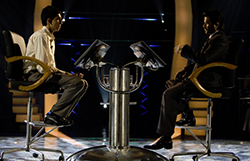 Slumdog Millionaire wins Academy Award for best picture. No foreign-language film has won best picture, but Slumdog Millionaire comes closest, since one-third of the dialogue is in Hindi. It's also a rarity, since it centers around a TV show: India's version of Who Wants to Be a Millionaire.
Slumdog Millionaire wins Academy Award for best picture. No foreign-language film has won best picture, but Slumdog Millionaire comes closest, since one-third of the dialogue is in Hindi. It's also a rarity, since it centers around a TV show: India's version of Who Wants to Be a Millionaire.
2008
On August 27, Illinois Sen. Barack Obama becomes the first African-American to attain the Democratic Party nomination for president of the United States when he is chosen at the party's national convention in Denver.
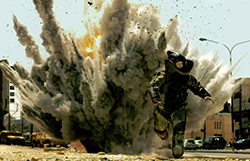 The Hurt Locker wins Academy Award for best picture. The film, directed by Kathryn Bigelow and written by Mark Boal, beat out some tough competition, including the record-breaking Avatar Hurt Locker earned $49 million at the global box office, the lowest-grossing film in Oscar history. But it has gained many fans and admirers over the years, and Bigelow so far is the only woman to win a directing Oscar.
The Hurt Locker wins Academy Award for best picture. The film, directed by Kathryn Bigelow and written by Mark Boal, beat out some tough competition, including the record-breaking Avatar Hurt Locker earned $49 million at the global box office, the lowest-grossing film in Oscar history. But it has gained many fans and admirers over the years, and Bigelow so far is the only woman to win a directing Oscar.
2009
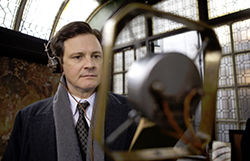 The King's Speech wins Academy Award for best picture. The 2010 film was another unlikely subject matter: The king of England needs to eliminate his stutter. But it became a touching film about a man overcoming personal obstacles, family love, and friendship. Colin Firth's acting, Tom Hooper's direction, and David Seidler's script all won Oscars and got huge ovations from the Oscar audience.
The King's Speech wins Academy Award for best picture. The 2010 film was another unlikely subject matter: The king of England needs to eliminate his stutter. But it became a touching film about a man overcoming personal obstacles, family love, and friendship. Colin Firth's acting, Tom Hooper's direction, and David Seidler's script all won Oscars and got huge ovations from the Oscar audience.
2010
(no entry for this year)
 The Artist wins Academy Award for best picture. This was yet another unlikely winner: a black-and-white film without dialogue, set in 1920s Hollywood, and made by French filmmakers. It was the first best picture Oscar winner to be set in the movie industry and only the second silent film, after original winner Wings.
The Artist wins Academy Award for best picture. This was yet another unlikely winner: a black-and-white film without dialogue, set in 1920s Hollywood, and made by French filmmakers. It was the first best picture Oscar winner to be set in the movie industry and only the second silent film, after original winner Wings.
2011
(no entry for this year)
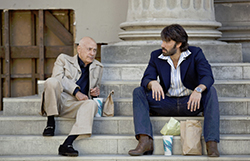 Argo wins Academy Award for best picture. The film about the true-life rescue of hostages in Tehran, was directed by Ben Affleck; it became the first movie in 23 years to take top prize without a director nomination. It was also the fourth film in a decade with key scenes shot in Los Angeles. And it has one other major distinction: Variety plays an important role in a plot twist.
Argo wins Academy Award for best picture. The film about the true-life rescue of hostages in Tehran, was directed by Ben Affleck; it became the first movie in 23 years to take top prize without a director nomination. It was also the fourth film in a decade with key scenes shot in Los Angeles. And it has one other major distinction: Variety plays an important role in a plot twist.
2012
(no entry for this year)
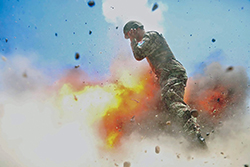 Photograph by Hilda Clayton: Photographer records her own death. On 2 July 2013, Spec. Hilda Clayton, a combat photographer in the U.S. Army, was documenting a live-fire exercise in Afghanistan when a mortar tube accidentally exploded in front of her. This picture records the explosion that killed her, the soldier in the image, and three others,
Photograph by Hilda Clayton: Photographer records her own death. On 2 July 2013, Spec. Hilda Clayton, a combat photographer in the U.S. Army, was documenting a live-fire exercise in Afghanistan when a mortar tube accidentally exploded in front of her. This picture records the explosion that killed her, the soldier in the image, and three others,
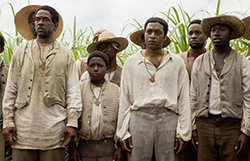 12 Years a Slave wins Academy Award for best picture. The film about U.S. slavery was directed by Steve McQueen and written by John Ridley, based on the memoirs of Solomon Northup, a free man who was kidnapped and sold into slavery. The film earned an impressive $188 million worldwide, with 70% of that from outside the U.S. It earned three Oscars out of nine nominations and Brad Pitt was among the producers.
12 Years a Slave wins Academy Award for best picture. The film about U.S. slavery was directed by Steve McQueen and written by John Ridley, based on the memoirs of Solomon Northup, a free man who was kidnapped and sold into slavery. The film earned an impressive $188 million worldwide, with 70% of that from outside the U.S. It earned three Oscars out of nine nominations and Brad Pitt was among the producers.
2013
(no entry for this year)
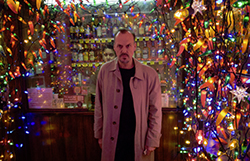 Birdman or (The Unexpected Virtue of Ignorance) wins Academy Award for best picture. The film, about a faded star attempting a stage comeback, was technically dazzling, appearing to have been shot in one continuous take. Not everyone loved the Alejandro Inarritu-directed comedy-drama and some were mystified by the ending. But the people who liked it REALLY liked it.
Birdman or (The Unexpected Virtue of Ignorance) wins Academy Award for best picture. The film, about a faded star attempting a stage comeback, was technically dazzling, appearing to have been shot in one continuous take. Not everyone loved the Alejandro Inarritu-directed comedy-drama and some were mystified by the ending. But the people who liked it REALLY liked it.
2014
(no entry for this year)
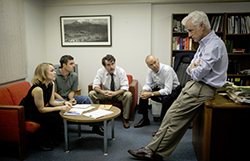 Spotlight wins Academy Award for best picture. The fact-based story, about a Boston newspaper team, won two Oscars, for film and screenplay (by Josh Singer and director Tom McCarthy). It marked the second consecutive win for a film starring Michael Keaton.
Spotlight wins Academy Award for best picture. The fact-based story, about a Boston newspaper team, won two Oscars, for film and screenplay (by Josh Singer and director Tom McCarthy). It marked the second consecutive win for a film starring Michael Keaton.
2015
(no entry for this year)
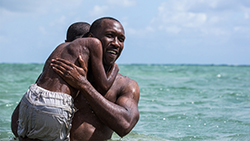 Moonlight wins Academy Award for best picture. The Moonlight win was a record-breaker in Academy history: It was the first film with an all-black cast, with many black artists behind the camera, and was the first gay-themed film to take the top prize. It was also at the center of Oscar's biggest snafu: Due to a mix-up in envelopes, Faye Dunaway announced La La Land as the winner, and it took a few minutes before the real Moonlight victory was announced.
Moonlight wins Academy Award for best picture. The Moonlight win was a record-breaker in Academy history: It was the first film with an all-black cast, with many black artists behind the camera, and was the first gay-themed film to take the top prize. It was also at the center of Oscar's biggest snafu: Due to a mix-up in envelopes, Faye Dunaway announced La La Land as the winner, and it took a few minutes before the real Moonlight victory was announced.
2016
(no entry for this year)
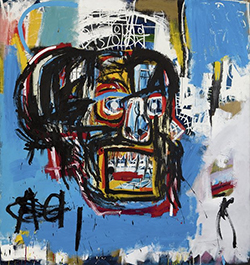 Painting by Jean-Michel Basquiat: Untitled, sells for a record-breaking $110.5 million at auction — the highest sum ever paid at auction for a U.S.-produced artwork. The work was created in 1982 when the artist was 21 years old. Until shortly before Thursday's auction, it hadn't been shown in public since a private collector bought it for $19,000 in 1984.
Painting by Jean-Michel Basquiat: Untitled, sells for a record-breaking $110.5 million at auction — the highest sum ever paid at auction for a U.S.-produced artwork. The work was created in 1982 when the artist was 21 years old. Until shortly before Thursday's auction, it hadn't been shown in public since a private collector bought it for $19,000 in 1984.
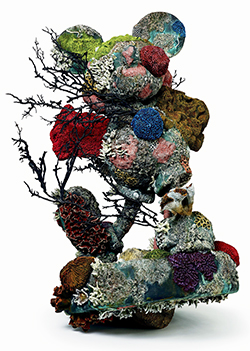 Sculptures by Damien Hirst: Treasures From the Wreck of the Unbelievable — his first major show of new work since the financial collapse of 2009. The collection is being shown at Palazzo Grassi and Punta della Dogana, the two Venetian venues of the Pinault Collection. The conceit behind the show is that the works were originally a stash of ancient treasures, lost in a shipwreck nearly 2000 years ago, and recently recovered. The long-lost treasures include giant sculptures of sea monsters encrusted with coral and semiprecious stones; golden monkeys, unicorns and tortoises; as well as a goddess whose face looks oddly like Kate Moss, a marble pharaoh that resembles Pharrell Williams and a bronze statue of Mickey Mouse (pictured), covered with centuries of marine growth.
Sculptures by Damien Hirst: Treasures From the Wreck of the Unbelievable — his first major show of new work since the financial collapse of 2009. The collection is being shown at Palazzo Grassi and Punta della Dogana, the two Venetian venues of the Pinault Collection. The conceit behind the show is that the works were originally a stash of ancient treasures, lost in a shipwreck nearly 2000 years ago, and recently recovered. The long-lost treasures include giant sculptures of sea monsters encrusted with coral and semiprecious stones; golden monkeys, unicorns and tortoises; as well as a goddess whose face looks oddly like Kate Moss, a marble pharaoh that resembles Pharrell Williams and a bronze statue of Mickey Mouse (pictured), covered with centuries of marine growth.
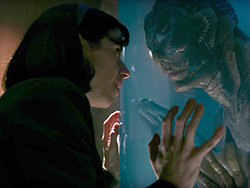 The Shape of Water wins Academy Award for best picture. Fox Searchlight's The Shape of Water centers on the 1962 romance between a mute janitor and an Amazonian fish-man. It's an eccentric premise, but voters were swept away by the dreamlike visuals, the heart-on-your-sleeve emotions, and the subtle social commentary of the film. It was a tight Oscar race, but voters seemed happy to salute Guillermo del Toro, one of the best-liked and most respected artists working in film.
The Shape of Water wins Academy Award for best picture. Fox Searchlight's The Shape of Water centers on the 1962 romance between a mute janitor and an Amazonian fish-man. It's an eccentric premise, but voters were swept away by the dreamlike visuals, the heart-on-your-sleeve emotions, and the subtle social commentary of the film. It was a tight Oscar race, but voters seemed happy to salute Guillermo del Toro, one of the best-liked and most respected artists working in film.
2017
 Donald Trump becomes forty-fifth president of the United States. A Berlusconi-like event visits America.
Donald Trump becomes forty-fifth president of the United States. A Berlusconi-like event visits America.
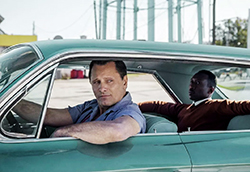 Green Book wins Academy Award for best picture. Green Book is a 2018 American biographical drama film directed by Peter Farrelly. Set in 1962, the film is inspired by the true story of a tour of the Deep South by African-American classical and jazz pianist Don Shirley (Mahershala Ali) and Italian-American bouncer Tony Vallelonga (Viggo Mortensen) who served as Shirley's driver and bodyguard. The film was written by Farrelly, Brian Hayes Currie and Vallelonga's son, Nick Vallelonga, based on interviews with his father and Shirley, as well as letters his father wrote to his mother. The film is named after The Negro Motorist Green Book, a mid-20th century guidebook for African-American travelers written by Victor Hugo Green, to help them find motels and restaurants that would accept them.
Green Book wins Academy Award for best picture. Green Book is a 2018 American biographical drama film directed by Peter Farrelly. Set in 1962, the film is inspired by the true story of a tour of the Deep South by African-American classical and jazz pianist Don Shirley (Mahershala Ali) and Italian-American bouncer Tony Vallelonga (Viggo Mortensen) who served as Shirley's driver and bodyguard. The film was written by Farrelly, Brian Hayes Currie and Vallelonga's son, Nick Vallelonga, based on interviews with his father and Shirley, as well as letters his father wrote to his mother. The film is named after The Negro Motorist Green Book, a mid-20th century guidebook for African-American travelers written by Victor Hugo Green, to help them find motels and restaurants that would accept them.
2018
(no entry for this year)
 Parasite wins Academy Award for best picture. Parasite is a 2019 South Korean black comedy thriller film directed by Bong Joon-ho. It follows the members of a poor family who scheme to become employed by a wealthy family by infiltrating their household and posing as unrelated, highly qualified individuals. Parasite premiered at the 2019 Cannes Film Festival on 21 May 2019, where it became the first South Korean film to win the Palme d'Or. Among its numerous accolades, Parasite won a leading four awards at the 92nd Academy Awards: Best Picture, Best Director, Best Original Screenplay, and Best International Feature Film. It became the first South Korean film to receive Academy Award recognition, as well as the first film not in English to win Best Picture. It also won the Golden Globe Award for Best Foreign Language Film and the BAFTA Award for Best Film Not in the English Language, and became the first film not in English to win the Screen Actors Guild Award for Outstanding Performance by a Cast in a Motion Picture.
Parasite wins Academy Award for best picture. Parasite is a 2019 South Korean black comedy thriller film directed by Bong Joon-ho. It follows the members of a poor family who scheme to become employed by a wealthy family by infiltrating their household and posing as unrelated, highly qualified individuals. Parasite premiered at the 2019 Cannes Film Festival on 21 May 2019, where it became the first South Korean film to win the Palme d'Or. Among its numerous accolades, Parasite won a leading four awards at the 92nd Academy Awards: Best Picture, Best Director, Best Original Screenplay, and Best International Feature Film. It became the first South Korean film to receive Academy Award recognition, as well as the first film not in English to win Best Picture. It also won the Golden Globe Award for Best Foreign Language Film and the BAFTA Award for Best Film Not in the English Language, and became the first film not in English to win the Screen Actors Guild Award for Outstanding Performance by a Cast in a Motion Picture.
2019
(no entry for this year)
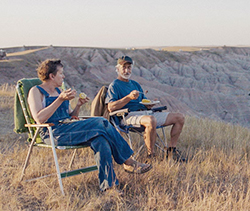 Nomadland wins Academy Award for best picture. Nomadland is a 2020 American drama film written, produced, edited and directed by Chloé Zhao. Based on the 2017 nonfiction book Nomadland: Surviving America in the Twenty-First Century by Jessica Bruder, it stars Frances McDormand as a widow who leaves her life in Nevada to travel around the United States in her van as a nomad. A number of real-life nomads appear as fictionalized versions of themselves, including Linda May, Swankie, and Bob Wells. David Strathairn also stars in a supporting role. Nomadland premiered on September 11, 2020, at the Venice Film Festival, where it won the Golden Lion. It also won the People's Choice Award at the Toronto International Film Festival. It had a one-week streaming limited release on December 4, 2020, and was distributed by Searchlight Pictures in selected IMAX theaters in the United States on January 29, 2021, and simultaneously in theaters, and streaming digitally on Hulu, on February 19, 2021. The film received widespread critical acclaim and was a box office success, grossing $39 million worldwide against its $5 million budget. At the 93rd Academy Awards, the film won Best Picture, Best Director, and Best Actress for McDormand, from a total of six nominations. Zhao became the first Asian woman and the second woman ever to win Best Director; McDormand became the first woman and fourth person to win Academy Awards for both acting and producing, and the first person ever to win Academy Awards as producer and performer for the same film.
Nomadland wins Academy Award for best picture. Nomadland is a 2020 American drama film written, produced, edited and directed by Chloé Zhao. Based on the 2017 nonfiction book Nomadland: Surviving America in the Twenty-First Century by Jessica Bruder, it stars Frances McDormand as a widow who leaves her life in Nevada to travel around the United States in her van as a nomad. A number of real-life nomads appear as fictionalized versions of themselves, including Linda May, Swankie, and Bob Wells. David Strathairn also stars in a supporting role. Nomadland premiered on September 11, 2020, at the Venice Film Festival, where it won the Golden Lion. It also won the People's Choice Award at the Toronto International Film Festival. It had a one-week streaming limited release on December 4, 2020, and was distributed by Searchlight Pictures in selected IMAX theaters in the United States on January 29, 2021, and simultaneously in theaters, and streaming digitally on Hulu, on February 19, 2021. The film received widespread critical acclaim and was a box office success, grossing $39 million worldwide against its $5 million budget. At the 93rd Academy Awards, the film won Best Picture, Best Director, and Best Actress for McDormand, from a total of six nominations. Zhao became the first Asian woman and the second woman ever to win Best Director; McDormand became the first woman and fourth person to win Academy Awards for both acting and producing, and the first person ever to win Academy Awards as producer and performer for the same film.
2020
(no entry for this year)
 CODA wins Academy Award for best picture. CODA is a 2021 coming-of-age comedy-drama film written and directed by Sian Heder. An English-language remake of the 2014 French-Belgian film La Famille Bélier, it stars Emilia Jones as Ruby Rossi, the child of deaf adults (CODA) and only hearing member of her family, who attempts to help her family's struggling fishing business while pursuing her aspirations to become a singer. The movie uses deaf actors to play the deaf characters, who, along with Jones, communicate using American Sign Language. Eugenio Derbez, Troy Kotsur, Ferdia Walsh-Peelo, Daniel Durant (in his feature film debut), and Marlee Matlin are featured in supporting roles. An international co-production between the United States and France, with Philippe Rousselet of La Famille Bélier reprising his role as producer, it was filmed on location in Gloucester, Massachusetts, in the United States. CODA had its world premiere on January 28, 2021, at the 2021 Sundance Film Festival, where Apple acquired its distribution rights for a festival-record $25 million. The film was released through the Apple TV+ streaming service on August 13, 2021. It received largely positive reviews from critics, who praised Heder's screenplay and Kotsur's performance, although feedback from deaf viewers was polarized. It was named one of the top 10 films of 2021 by the American Film Institute and has since been cited as among the best films of the 2020s. CODA won numerous awards, including all three nominations at the 94th Academy Awards — Best Picture, Best Supporting Actor for Kotsur, and Best Adapted Screenplay, becoming the seventh Best Picture winner to win every award for which it was nominated.
CODA wins Academy Award for best picture. CODA is a 2021 coming-of-age comedy-drama film written and directed by Sian Heder. An English-language remake of the 2014 French-Belgian film La Famille Bélier, it stars Emilia Jones as Ruby Rossi, the child of deaf adults (CODA) and only hearing member of her family, who attempts to help her family's struggling fishing business while pursuing her aspirations to become a singer. The movie uses deaf actors to play the deaf characters, who, along with Jones, communicate using American Sign Language. Eugenio Derbez, Troy Kotsur, Ferdia Walsh-Peelo, Daniel Durant (in his feature film debut), and Marlee Matlin are featured in supporting roles. An international co-production between the United States and France, with Philippe Rousselet of La Famille Bélier reprising his role as producer, it was filmed on location in Gloucester, Massachusetts, in the United States. CODA had its world premiere on January 28, 2021, at the 2021 Sundance Film Festival, where Apple acquired its distribution rights for a festival-record $25 million. The film was released through the Apple TV+ streaming service on August 13, 2021. It received largely positive reviews from critics, who praised Heder's screenplay and Kotsur's performance, although feedback from deaf viewers was polarized. It was named one of the top 10 films of 2021 by the American Film Institute and has since been cited as among the best films of the 2020s. CODA won numerous awards, including all three nominations at the 94th Academy Awards — Best Picture, Best Supporting Actor for Kotsur, and Best Adapted Screenplay, becoming the seventh Best Picture winner to win every award for which it was nominated.
2021
 Joe Biden becomes the 46th President of the United States.
Joe Biden becomes the 46th President of the United States.
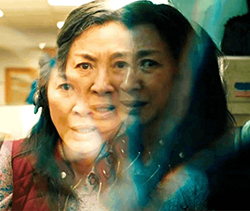 Everything Everywhere All at Once wins Academy Award for best picture. Everything Everywhere All at Once is a 2022 American absurdist comedy-drama film written and directed by Daniel Kwan and Daniel Scheinert, who produced it with Anthony and Joe Russo and Jonathan Wang. The film incorporates elements from several genres and film media, including surreal comedy, science fiction, fantasy, martial arts films, immigrant narrative, and animation. Michelle Yeoh stars as Evelyn Quan Wang, a Chinese-American immigrant who, while audited by the IRS, discovers that she must connect with parallel universe versions of herself to prevent a powerful being from destroying the multiverse. The film also stars Stephanie Hsu, Ke Huy Quan, Jamie Lee Curtis, and James Hong. Everything Everywhere All at Once premiered at South by Southwest on March 11, 2022, and began a limited theatrical release in the United States on March 25, before a wide release by A24 on April 8. Grossing $143.4 million worldwide on a $14.3–25 million production budget, it became A24's highest-grossing film and garnered universal acclaim. At the 95th Academy Awards, it won seven out of the eleven awards it was nominated for: Best Picture, Best Actress (Yeoh), Best Supporting Actor (Quan), Best Supporting Actress (Curtis), Best Director and Best Original Screenplay for Kwan and Scheinert, and Best Editing.
Everything Everywhere All at Once wins Academy Award for best picture. Everything Everywhere All at Once is a 2022 American absurdist comedy-drama film written and directed by Daniel Kwan and Daniel Scheinert, who produced it with Anthony and Joe Russo and Jonathan Wang. The film incorporates elements from several genres and film media, including surreal comedy, science fiction, fantasy, martial arts films, immigrant narrative, and animation. Michelle Yeoh stars as Evelyn Quan Wang, a Chinese-American immigrant who, while audited by the IRS, discovers that she must connect with parallel universe versions of herself to prevent a powerful being from destroying the multiverse. The film also stars Stephanie Hsu, Ke Huy Quan, Jamie Lee Curtis, and James Hong. Everything Everywhere All at Once premiered at South by Southwest on March 11, 2022, and began a limited theatrical release in the United States on March 25, before a wide release by A24 on April 8. Grossing $143.4 million worldwide on a $14.3–25 million production budget, it became A24's highest-grossing film and garnered universal acclaim. At the 95th Academy Awards, it won seven out of the eleven awards it was nominated for: Best Picture, Best Actress (Yeoh), Best Supporting Actor (Quan), Best Supporting Actress (Curtis), Best Director and Best Original Screenplay for Kwan and Scheinert, and Best Editing.
2022
(no entry for this year)
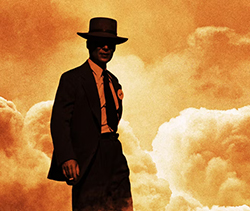 Oppenheimer wins Academy Award for best picture. Oppenheimer is a 2023 epic biographical thriller drama film written, directed, and produced by Christopher Nolan. It follows the life of J. Robert Oppenheimer, the American theoretical physicist who helped develop the first nuclear weapons during World War II. Based on the 2005 biography American Prometheus by Kai Bird and Martin J. Sherwin, the film chronicles Oppenheimer's studies, his direction of the Los Alamos Laboratory and his 1954 security hearing. Cillian Murphy stars as Oppenheimer, alongside Robert Downey Jr. as the United States Atomic Energy Commission member Lewis Strauss. The ensemble supporting cast includes Emily Blunt, Matt Damon, Florence Pugh, Josh Hartnett, Casey Affleck, Rami Malek, and Kenneth Branagh. Oppenheimer premiered at Le Grand Rex in Paris on July 11, 2023, and was theatrically released in the United States and the United Kingdom on July 21 by Universal Pictures. Its concurrent release with Warner Bros.'s Barbie was the catalyst of the "Barbenheimer" phenomenon, encouraging audiences to see both films as a double feature. Oppenheimer grossed over $977 million worldwide, becoming the third-highest-grossing film of 2023, the highest-grossing World War II-related film, the highest-grossing biographical film and the third-highest-grossing R-rated film. The recipient of many accolades, Oppenheimer won seven Academy Awards, including Best Picture, Best Director for Nolan, Best Actor for Murphy and Best Supporting Actor for Downey. It also won five Golden Globe Awards (including Best Motion Picture – Drama) and seven British Academy Film Awards (including Best Film), and was named one of the top ten films of 2023 by the National Board of Review and the American Film Institute.
Oppenheimer wins Academy Award for best picture. Oppenheimer is a 2023 epic biographical thriller drama film written, directed, and produced by Christopher Nolan. It follows the life of J. Robert Oppenheimer, the American theoretical physicist who helped develop the first nuclear weapons during World War II. Based on the 2005 biography American Prometheus by Kai Bird and Martin J. Sherwin, the film chronicles Oppenheimer's studies, his direction of the Los Alamos Laboratory and his 1954 security hearing. Cillian Murphy stars as Oppenheimer, alongside Robert Downey Jr. as the United States Atomic Energy Commission member Lewis Strauss. The ensemble supporting cast includes Emily Blunt, Matt Damon, Florence Pugh, Josh Hartnett, Casey Affleck, Rami Malek, and Kenneth Branagh. Oppenheimer premiered at Le Grand Rex in Paris on July 11, 2023, and was theatrically released in the United States and the United Kingdom on July 21 by Universal Pictures. Its concurrent release with Warner Bros.'s Barbie was the catalyst of the "Barbenheimer" phenomenon, encouraging audiences to see both films as a double feature. Oppenheimer grossed over $977 million worldwide, becoming the third-highest-grossing film of 2023, the highest-grossing World War II-related film, the highest-grossing biographical film and the third-highest-grossing R-rated film. The recipient of many accolades, Oppenheimer won seven Academy Awards, including Best Picture, Best Director for Nolan, Best Actor for Murphy and Best Supporting Actor for Downey. It also won five Golden Globe Awards (including Best Motion Picture – Drama) and seven British Academy Film Awards (including Best Film), and was named one of the top ten films of 2023 by the National Board of Review and the American Film Institute.
2023
(no entry for this year)
(no entry for this year)
2024
(no entry for this year)
(no entry for this year)
2025
(no entry for this year)
2026
(no entry for this year)
(no entry for this year)
2027
(no entry for this year)
(no entry for this year)
2028
(no entry for this year)
(no entry for this year)
2029
(no entry for this year)
ESP Quick Facts
ESP Origins
In the early 1990's, Robert Robbins was a faculty member at Johns Hopkins, where he directed the informatics core of GDB — the human gene-mapping database of the international human genome project. To share papers with colleagues around the world, he set up a small paper-sharing section on his personal web page. This small project evolved into The Electronic Scholarly Publishing Project.
ESP Support
In 1995, Robbins became the VP/IT of the Fred Hutchinson Cancer Research Center in Seattle, WA. Soon after arriving in Seattle, Robbins secured funding, through the ELSI component of the US Human Genome Project, to create the original ESP.ORG web site, with the formal goal of providing free, world-wide access to the literature of classical genetics.
ESP Rationale
Although the methods of molecular biology can seem almost magical to the uninitiated, the original techniques of classical genetics are readily appreciated by one and all: cross individuals that differ in some inherited trait, collect all of the progeny, score their attributes, and propose mechanisms to explain the patterns of inheritance observed.
ESP Goal
In reading the early works of classical genetics, one is drawn, almost inexorably, into ever more complex models, until molecular explanations begin to seem both necessary and natural. At that point, the tools for understanding genome research are at hand. Assisting readers reach this point was the original goal of The Electronic Scholarly Publishing Project.
ESP Usage
Usage of the site grew rapidly and has remained high. Faculty began to use the site for their assigned readings. Other on-line publishers, ranging from The New York Times to Nature referenced ESP materials in their own publications. Nobel laureates (e.g., Joshua Lederberg) regularly used the site and even wrote to suggest changes and improvements.
ESP Content
When the site began, no journals were making their early content available in digital format. As a result, ESP was obliged to digitize classic literature before it could be made available. For many important papers — such as Mendel's original paper or the first genetic map — ESP had to produce entirely new typeset versions of the works, if they were to be available in a high-quality format.
ESP Help
Early support from the DOE component of the Human Genome Project was critically important for getting the ESP project on a firm foundation. Since that funding ended (nearly 20 years ago), the project has been operated as a purely volunteer effort. Anyone wishing to assist in these efforts should send an email to Robbins.
ESP Plans
With the development of methods for adding typeset side notes to PDF files, the ESP project now plans to add annotated versions of some classical papers to its holdings. We also plan to add new reference and pedagogical material. We have already started providing regularly updated, comprehensive bibliographies to the ESP.ORG site.
ESP Picks from Around the Web (updated 06 MAR 2017 )
Old Science

Weird Science

Treating Disease with Fecal Transplantation
Fossils of miniature humans (hobbits) discovered in Indonesia

Dinosaur tail, complete with feathers, found preserved in amber.
Astronomy

Mysterious fast radio burst (FRB) detected in the distant universe.